ARRIS NVG589 VDSL Gateway User Manual NVG589 Administrator s Handbook V9 1 0
ARRIS Group, Inc. VDSL Gateway NVG589 Administrator s Handbook V9 1 0
ARRIS >
User Manual.pdf
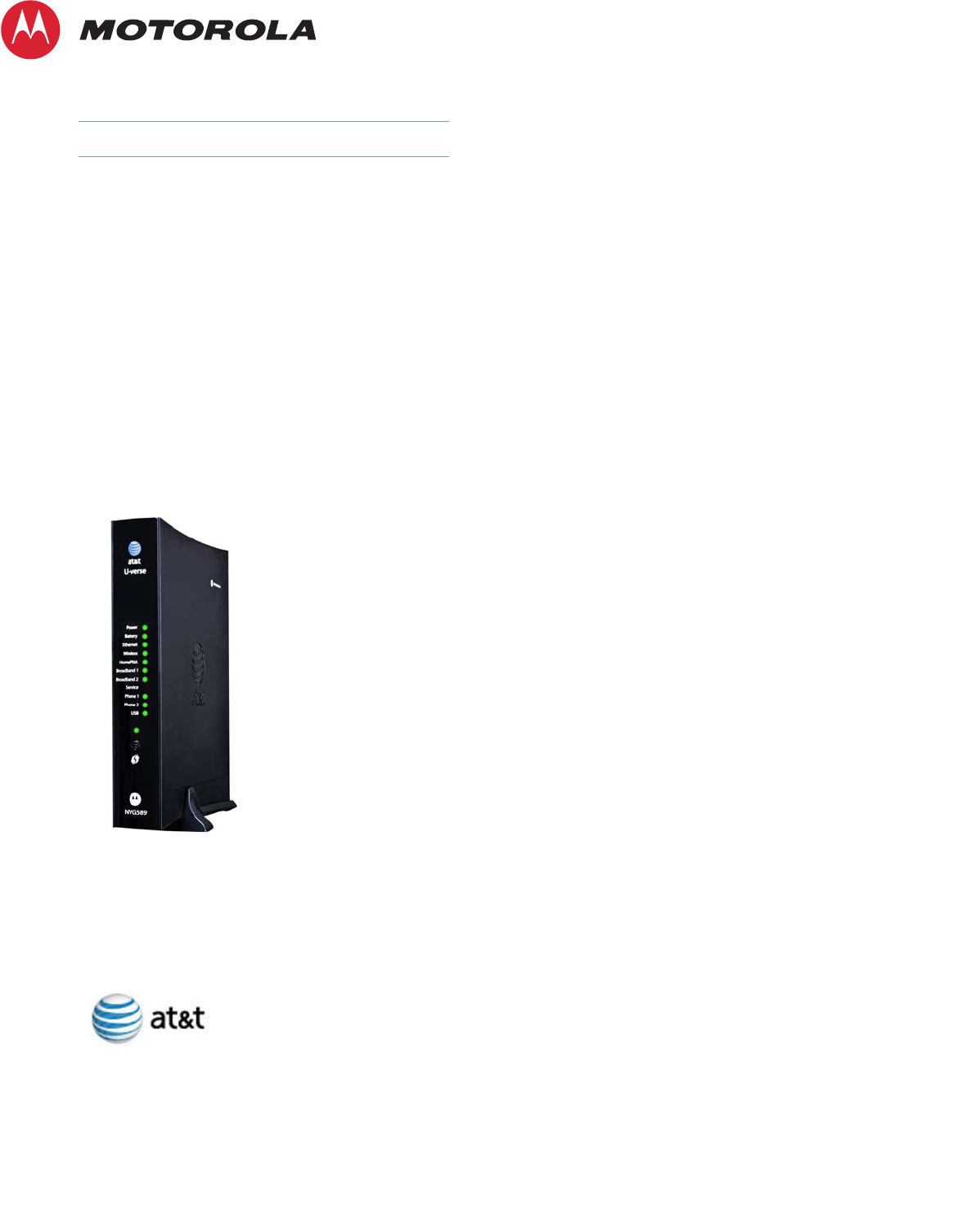
b
Motorola
®
NVG589 VDSL2 Gateway
Motorola
®
Embedded Software Version 9.1.0
Administrator’s Handbook

Administrator’s Handbook
Copyright
©2012 Motorola Mobility LLC All rights reserved. MOTOROLA, and the Stylized M logo are trademarks or registered trademarks of Motorola Trademark Holdings, LLC. All
other product or service names are the property of their respective owners. No part of this publication may be reproduced in any form or by any means or used to make
any derivative work (such as translation, transformation, or adaptation) without written permission from Motorola Mobility LLC Motorola reserves the right to revise this
publication and to make changes in content from time to time without obligation on the part of Motorola to provide notification of such revision or change. Motorola pro-
vides this guide without warranty of any kind, implied or expressed, including, but not limited to, the implied warranties of merchantability and fitness for a particular pur-
pose. Motorola may make improvements or changes in the product(s) described in this manual at any time.
©2010 Motorola Mobility LLC All rights reserved. MOTOROLA, and the Stylized M logo are trademarks or registered trademarks of Motorola Trademark Holdings, LLC. All
other product or service names are the property of their respective owners. No part of this publication may be reproduced in any form or by any means or used to make
any derivative work (such as translation, transformation, or adaptation) without written permission from Motorola Mobility LLC Motorola reserves the right to revise this
publication and to make changes in content from time to time without obligation on the part of Motorola to provide notification of such revision or change. Motorola pro-
vides this guide without warranty of any kind, implied or expressed, including, but not limited to, the implied warranties of merchantability and fitness for a particular pur-
pose. Motorola may make improvements or changes in the product(s) described in this manual at any time.
EXCEPT AS INDICATED IN THE APPLICABLE SYSTEM PURCHASE AGREEMENT, THE SYSTEM, DOCUMENTATION AND SERVICES ARE PROVIDED “AS IS”, AS AVAIL-
ABLE, WITHOUT WARRANTY OF ANY KIND. MOTOROLA MOBILITY LLC. DOES NOT WARRANT THAT THE SYSTEM WILL MEET CUSTOMER'S REQUIREMENTS, OR THAT
THEIR OPERATION WILL BE UNINTERRUPTED OR ERROR-FREE, OR THAT ANY ERRORS CAN OR WILL BE FIXED. MOTOROLA MOBILITY LLC. HEREBY DISCLAIMS ALL
OTHER WARRANTIES, EXPRESS OR IMPLIED, ORAL OR WRITTEN, WITH RESPECT TO THE SYSTEM AND SERVICES INCLUDING, WITHOUT LIMITATION, ALL IMPLIED
WARRANTIES OF TITLE, NON-INFRINGEMENT, INTEGRATION, MERCHANTABILITY OR FITNESS FOR ANY PARTICULAR PURPOSE AND ALL WARRANTIES ARISING
FROM ANY COURSE OF DEALING OR PERFORMANCE OR USAGE OF TRADE.
EXCEPT AS INDICATED IN THE APPLICABLE SYSTEM PURCHASE AGREEMENT, MOTOROLA MOBILITY LLC. SHALL NOT BE LIABLE CONCERNING THE SYSTEM OR SUB-
JECT MATTER OF THIS DOCUMENTATION, REGARDLESS OF THE FORM OF ANY CLAIM OR ACTION (WHETHER IN CONTRACT, NEGLIGENCE, STRICT LIABILITY OR OTH-
ERWISE), FOR ANY (A) MATTER BEYOND ITS REASONABLE CONTROL, (B) LOSS OR INACCURACY OF DATA, LOSS OR INTERRUPTION OF USE, OR COST OF PROCURING
SUBSTITUTE TECHNOLOGY, GOODS OR SERVICES, (C) INDIRECT, PUNITIVE, INCIDENTAL, RELIANCE, SPECIAL, EXEMPLARY OR CONSEQUENTIAL DAMAGES INCLUD-
ING, BUT NOT LIMITED TO, LOSS OF BUSINESS, REVENUES, PROFITS OR GOODWILL, OR (D) DIRECT DAMAGES, IN THE AGGREGATE, IN EXCESS OF THE FEES PAID TO
IT HEREUNDER FOR THE SYSTEM OR SERVICE GIVING RISE TO SUCH DAMAGES DURING THE 12-MONTH PERIOD PRIOR TO THE DATE THE CAUSE OF ACTION AROSE,
EVEN IF COMPANY HAS BEEN ADVISED OF THE POSSIBILITY OF SUCH DAMAGES. THESE LIMITATIONS ARE INDEPENDENT FROM ALL OTHER PROVISIONS OF THIS
AGREEMENT AND SHALL APPLY NOTWITHSTANDING THE FAILURE OF ANY REMEDY PROVIDED HEREIN.
All Motorola Mobility LLC products are furnished under a license agreement included with the product. If you are unable to locate a copy of the license agreement,
please contact Motorola Mobility LLC
NOTE: THIS IS DRAFT DOCUMENTATION INTENDED FOR TESTING AND EVALUATIVE REVIEW. IT MAY CON-
TAIN ERRORS. IT SHOULD NOT BE CONSIDERED SUITABLE FOR USE IN A PRODUCTION ENVIRONMENT.
Motorola Mobility LLC
600 North U.S. Highway 45
Libertyville, Illinois 60048 USA
Telephone: +1 847 523 5000
Part Number
58XXXX-001-00r2 rev a
V9.1.0-sku 70
TT
TTaa
aabb
bbllllee
ee 11
11::
:: DD
DDoo
oocc
ccuu
uumm
mmee
eenn
nntt
tt CC
CChh
hhaa
aann
nngg
ggee
ee LL
LLo
o
oogg
gg
Draft version Firmware version Changes this draft
a1
nbxvu9.1.0h2d2_1.1.bin
first draft
r1 include ATT 6/16 feedback; add battery door instructions
r2
nbxvu9.1.0h0d23_1.1.bin
add battery safety instructions; revved GUI per ERS-
NVG589_1.0_UI.doc rev 13

Table of Contents
Table of Contents
CHAPTER 1
Introduction
. . . . . . . . . . . . . . . . . . . . . . . . . . . . . . . . . . . . . . . . . . . . . . . . 7
About Motorola
®
Documentation
. . . . . . . . . . . . . . . . . . . . . . . . 7
Documentation Conventions
. . . . . . . . . . . . . . . . . . . . . . . . . . . 8
General. . . . . . . . . . . . . . . . . . . . . . . . . . . . . . . . . . . . . . . . . . . . . . . . . . 8
Internal Web Interface . . . . . . . . . . . . . . . . . . . . . . . . . . . . . . . . . . . . . . 8
Command Line Interface . . . . . . . . . . . . . . . . . . . . . . . . . . . . . . . . . . . . 8
Organization
. . . . . . . . . . . . . . . . . . . . . . . . . . . . . . . . . . . . . . . 9
A Word About Example Screens
. . . . . . . . . . . . . . . . . . . . . . . . 9
CHAPTER 2
Device Configuration
. . . . . . . . . . . . . . . . . . . . . . . . . . . . . . . . . . . . .11
Important Safety Instructions
. . . . . . . . . . . . . . . . . . . . . . . . . . 12
POWER SUPPLY INSTALLATION. . . . . . . . . . . . . . . . . . . . . . . . . . . . 12
TELECOMMUNICATION INSTALLATION . . . . . . . . . . . . . . . . . . . . . . 12
COAX INSTALLATION . . . . . . . . . . . . . . . . . . . . . . . . . . . . . . . . . . . . . 12
PRODUCT VENTILATION . . . . . . . . . . . . . . . . . . . . . . . . . . . . . . . . . . 12
Motorola
®
Gateway Status Indicator Lights
. . . . . . . . . . . . . . . 13
Battery Installation (optional)
. . . . . . . . . . . . . . . . . . . . . . . . . . 16
Battery Door Installation Instructions
. . . . . . . . . . . . . . . . . . . . 17
Battery Door Removal Instructions
. . . . . . . . . . . . . . . . . . . . . 18
Cradle Installation Instructions
. . . . . . . . . . . . . . . . . . . . . . . . . 19
Set up the Motorola Gateway
. . . . . . . . . . . . . . . . . . . . . . . . . 20
Accessing the Web Management Interface
. . . . . . . . . . . . . . . 23
Broadband Network Redirect Pages . . . . . . . . . . . . . . . . . . . . . . . . . . 25
IP Diagnostics Page Redirect. . . . . . . . . . . . . . . . . . . . . . . . . . . . . . . . 26
Offline Troubleshooting . . . . . . . . . . . . . . . . . . . . . . . . . . . . . . . . . . . . 26
Device Status page
. . . . . . . . . . . . . . . . . . . . . . . . . . . . . . . . . 27
Device Access Code . . . . . . . . . . . . . . . . . . . . . . . . . . . . . . . . . . . . . . 27
Tab Bar
. . . . . . . . . . . . . . . . . . . . . . . . . . . . . . . . . . . . . . . . . . 31
Help
. . . . . . . . . . . . . . . . . . . . . . . . . . . . . . . . . . . . . . . . . . . . . 31
Links Bar
. . . . . . . . . . . . . . . . . . . . . . . . . . . . . . . . . . . . . . . . . 32
Device List . . . . . . . . . . . . . . . . . . . . . . . . . . . . . . . . . . . . . . 32
System Information . . . . . . . . . . . . . . . . . . . . . . . . . . . . . . . 34
Access Code . . . . . . . . . . . . . . . . . . . . . . . . . . . . . . . . . . . . 35
Restart Device . . . . . . . . . . . . . . . . . . . . . . . . . . . . . . . . . . . 36
Broadband
. . . . . . . . . . . . . . . . . . . . . . . . . . . . . . . . . . . . . . . . 37
Configure . . . . . . . . . . . . . . . . . . . . . . . . . . . . . . . . . . . . . . . 39
IGMP Stats . . . . . . . . . . . . . . . . . . . . . . . . . . . . . . . . . . . . . 40
Home Network
. . . . . . . . . . . . . . . . . . . . . . . . . . . . . . . . . . . . . 41
Configure . . . . . . . . . . . . . . . . . . . . . . . . . . . . . . . . . . . . . . . 44
HPNA Configure . . . . . . . . . . . . . . . . . . . . . . . . . . . . . . . . . . 45
Wireless . . . . . . . . . . . . . . . . . . . . . . . . . . . . . . . . . . . . . . . 46
Wireless Security . . . . . . . . . . . . . . . . . . . . . . . . . . . . . . . . . . . . . . . . . 48
MAC Filtering . . . . . . . . . . . . . . . . . . . . . . . . . . . . . . . . . . . . 50

Administrator’s Handbook
Wireless Scan . . . . . . . . . . . . . . . . . . . . . . . . . . . . . . . . . . . 51
Subnets & DHCP . . . . . . . . . . . . . . . . . . . . . . . . . . . . . . . . . 52
HPNA . . . . . . . . . . . . . . . . . . . . . . . . . . . . . . . . . . . . . . . . . . 54
Voice
. . . . . . . . . . . . . . . . . . . . . . . . . . . . . . . . . . . . . . . . . . . . 56
Line Details . . . . . . . . . . . . . . . . . . . . . . . . . . . . . . . . . . . . . 57
Call Statistics . . . . . . . . . . . . . . . . . . . . . . . . . . . . . . . . . . . . 58
Firewall
. . . . . . . . . . . . . . . . . . . . . . . . . . . . . . . . . . . . . . . . . . 62
Packet Filter . . . . . . . . . . . . . . . . . . . . . . . . . . . . . . . . . . . . . 63
Working with Packet Filters. . . . . . . . . . . . . . . . . . . . . . . . . . . . . . . . . .65
NAT/Gaming . . . . . . . . . . . . . . . . . . . . . . . . . . . . . . . . . . . . 69
Custom Services . . . . . . . . . . . . . . . . . . . . . . . . . . . . . . . . . . . . . . . . . .71
IP Passthrough . . . . . . . . . . . . . . . . . . . . . . . . . . . . . . . . . . . 75
Firewall Advanced . . . . . . . . . . . . . . . . . . . . . . . . . . . . . . . . . 78
Diagnostics
. . . . . . . . . . . . . . . . . . . . . . . . . . . . . . . . . . . . . . . 80
Logs . . . . . . . . . . . . . . . . . . . . . . . . . . . . . . . . . . . . . . . . . . 83
Update . . . . . . . . . . . . . . . . . . . . . . . . . . . . . . . . . . . . . . . . 85
Resets . . . . . . . . . . . . . . . . . . . . . . . . . . . . . . . . . . . . . . . . . 86
Event Notifications . . . . . . . . . . . . . . . . . . . . . . . . . . . . . . . . 87
NAT Table . . . . . . . . . . . . . . . . . . . . . . . . . . . . . . . . . . . . . . 88
CHAPTER 3
Basic Troubleshooting
. . . . . . . . . . . . . . . . . . . . . . . . . . . . . . . . . . .89
Status Indicator Lights
. . . . . . . . . . . . . . . . . . . . . . . . . . . . . . . 90
LED Function Summary Matrix . . . . . . . . . . . . . . . . . . . . . . . . . . . . . . .93
Factory Reset Switch
. . . . . . . . . . . . . . . . . . . . . . . . . . . . . . . . 96
Log Event Messages
. . . . . . . . . . . . . . . . . . . . . . . . . . . . . . . . 97
CHAPTER 4
Command Line Interface
. . . . . . . . . . . . . . . . . . . . . . . . . . . . . . . .103
Overview
. . . . . . . . . . . . . . . . . . . . . . . . . . . . . . . . . . . . . . . . 105
Starting and Ending a CLI Session
. . . . . . . . . . . . . . . . . . . . 107
Logging In . . . . . . . . . . . . . . . . . . . . . . . . . . . . . . . . . . . . . . . . . . . . . .107
Ending a CLI Session . . . . . . . . . . . . . . . . . . . . . . . . . . . . . . . . . . . . .107
Using the CLI Help Facility
. . . . . . . . . . . . . . . . . . . . . . . . . . 107
About SHELL Commands
. . . . . . . . . . . . . . . . . . . . . . . . . . . 108
SHELL Prompt . . . . . . . . . . . . . . . . . . . . . . . . . . . . . . . . . . . . . . . . . .108
SHELL Command Shortcuts . . . . . . . . . . . . . . . . . . . . . . . . . . . . . . . .108
SHELL Commands
. . . . . . . . . . . . . . . . . . . . . . . . . . . . . . . . 109
Common Commands . . . . . . . . . . . . . . . . . . . . . . . . . . . . . . . . . . . . .109
WAN Commands. . . . . . . . . . . . . . . . . . . . . . . . . . . . . . . . . . . . . . . . .116
About CONFIG Commands
. . . . . . . . . . . . . . . . . . . . . . . . . . .118
CONFIG Mode Prompt . . . . . . . . . . . . . . . . . . . . . . . . . . . . . . . . . . . .118
Navigating the CONFIG Hierarchy . . . . . . . . . . . . . . . . . . . . . . . . . . .118
Entering Commands in CONFIG Mode. . . . . . . . . . . . . . . . . . . . . . . .118
Guidelines: CONFIG Commands . . . . . . . . . . . . . . . . . . . . . . . . . . . .119
Displaying Current Gateway Settings . . . . . . . . . . . . . . . . . . . . . . . . .119
Step Mode: A CLI Configuration Technique. . . . . . . . . . . . . . . . . . . . .119
Validating Your Configuration . . . . . . . . . . . . . . . . . . . . . . . . . . . . . . .120
CONFIG Commands
. . . . . . . . . . . . . . . . . . . . . . . . . . . . . . . 121
Connection commands . . . . . . . . . . . . . . . . . . . . . . . . . . . . . . . . . . . .121

Table of Contents
Filterset commands . . . . . . . . . . . . . . . . . . . . . . . . . . . . . . . . . . . . . . 124
Queue commands . . . . . . . . . . . . . . . . . . . . . . . . . . . . . . . . . . . . . . . 128
IP Gateway commands . . . . . . . . . . . . . . . . . . . . . . . . . . . . . . . . . . . 130
IPv6 Commands. . . . . . . . . . . . . . . . . . . . . . . . . . . . . . . . . . . . . . . . . 130
IP DNS commands. . . . . . . . . . . . . . . . . . . . . . . . . . . . . . . . . . . . . . . 138
IP IGMP commands . . . . . . . . . . . . . . . . . . . . . . . . . . . . . . . . . . . . . . 139
NTP commands . . . . . . . . . . . . . . . . . . . . . . . . . . . . . . . . . . . . . . . . . 141
Application Layer Gateway (ALG) commands . . . . . . . . . . . . . . . . . . 142
Dynamic DNS Commands . . . . . . . . . . . . . . . . . . . . . . . . . . . . . . . . . 142
Link commands . . . . . . . . . . . . . . . . . . . . . . . . . . . . . . . . . . . . . . . . . 143
Management commands . . . . . . . . . . . . . . . . . . . . . . . . . . . . . . . . . . 146
Remote access commands . . . . . . . . . . . . . . . . . . . . . . . . . . . . . . . . 148
Physical interfaces commands. . . . . . . . . . . . . . . . . . . . . . . . . . . . . . 150
PPPoE relay commands . . . . . . . . . . . . . . . . . . . . . . . . . . . . . . . . . . 156
NAT Pinhole commands. . . . . . . . . . . . . . . . . . . . . . . . . . . . . . . . . . . 157
Security Stateful Packet Inspection (SPI) commands . . . . . . . . . . . . 157
VoIP commands . . . . . . . . . . . . . . . . . . . . . . . . . . . . . . . . . . . . . . . . . 159
System commands. . . . . . . . . . . . . . . . . . . . . . . . . . . . . . . . . . . . . . . 167
Debug Commands
. . . . . . . . . . . . . . . . . . . . . . . . . . . . . . . . . 171
Disclaimer & Warning Text . . . . . . . . . . . . . . . . . . . . . . . . . . . . . . . . . 171
Commands. . . . . . . . . . . . . . . . . . . . . . . . . . . . . . . . . . . . . . . . . . . . . 171
CHAPTER 5
Technical Specifications and Safety Information
. . . 173
Description
. . . . . . . . . . . . . . . . . . . . . . . . . . . . . . . . . . . . . . . 173
Power Supply . . . . . . . . . . . . . . . . . . . . . . . . . . . . . . . . . . . . . . . . . . . 173
Environment . . . . . . . . . . . . . . . . . . . . . . . . . . . . . . . . . . . . . . . . . . . . 173
Software and protocols. . . . . . . . . . . . . . . . . . . . . . . . . . . . . . . . . . . . 173
Agency approvals
. . . . . . . . . . . . . . . . . . . . . . . . . . . . . . . . . 174
Manufacturer’s Declaration of Conformance
. . . . . . . . . . . . . 175
Important Safety Instructions
. . . . . . . . . . . . . . . . . . . . . . . . . 177
47 CFR Part 68 Information
. . . . . . . . . . . . . . . . . . . . . . . . . . 178
FCC Requirements. . . . . . . . . . . . . . . . . . . . . . . . . . . . . . . . . . . . . . . 178
FCC Statements. . . . . . . . . . . . . . . . . . . . . . . . . . . . . . . . . . . . . . . . . 178
Electrical Safety Advisory
. . . . . . . . . . . . . . . . . . . . . . . . . . . 179
Caring for the Environment by Recycling
. . . . . . . . . . . . . . . 180
Beskyttelse af miljøet med genbrug . . . . . . . . . . . . . . . . . . . . . . . . . . 180
Umweltschutz durch Recycling . . . . . . . . . . . . . . . . . . . . . . . . . . . . . 180
Cuidar el medio ambiente mediante el reciclaje . . . . . . . . . . . . . . . . 180
Recyclage pour le respect de l'environnement . . . . . . . . . . . . . . . . . 180
Milieubewust recycleren. . . . . . . . . . . . . . . . . . . . . . . . . . . . . . . . . . . 181
Dba∏oÊç o Êrodowisko - recykling . . . . . . . . . . . . . . . . . . . . . . . . . . 181
Cuidando do meio ambiente através da reciclagem . . . . . . . . . . . . . 181
Var rädd om miljön genom återvinning. . . . . . . . . . . . . . . . . . . . . . . . 181
Copyright Acknowledgments
. . . . . . . . . . . . . . . . . . . . . . . . . 183
Appendix A
Motorola
®
Gateway Captive Portal Implementation 203
Overview
. . . . . . . . . . . . . . . . . . . . . . . . . . . . . . . . . . . . . . . . 203
Captive Portal RPC
. . . . . . . . . . . . . . . . . . . . . . . . . . . . . . . . 204
X_00D09E_GetCaptivePortalParams RPC: . . . . . . . . . . . . . . . . . . . 204

Administrator’s Handbook
X_00D09E_SetCaptivePortalParams RPC: . . . . . . . . . . . . . . . . . . . .205
Appendix B
Quality of Service (QoS) Examples . . . . . . . . . . . . . .207
Overview
. . . . . . . . . . . . . . . . . . . . . . . . . . . . . . . . . . . . . . . . 207
Upstream QoS: Priority and shaping
. . . . . . . . . . . . . . . . . . . 209
Downstream QoS: Ethernet Switch
. . . . . . . . . . . . . . . . . . . . 210
Downstream QoS: Egress queues
. . . . . . . . . . . . . . . . . . . . 210
Index . . . . . . . . . . . . . . . . . . . . . . . . . . . . . . . . . . . . . . . . . . . . .211

7
CHAPTER 1 Introduction
About Motorola
®
Documentation
☛
NOTE:
This guide describes the wide variety of features and functionality of the Motorola
®
Gateway, when
used in Router mode. The Motorola
®
Gateway may also be delivered in Bridge mode. In Bridge
mode, the Gateway acts as a pass-through device and allows the workstations on your LAN to have
public addresses directly on the Internet.
Motorola, Inc. provides a suite of technical information for its family of intelligent enterprise and consumer Gate-
ways. It consists of:
◆
Administrator’s Handbook
◆
Dedicated User Manuals
◆
Specific White Papers
The documents are available in electronic form as Portable Document Format (PDF) files. They are viewed (and
printed) from Adobe Acrobat Reader, Exchange, or any other application that supports PDF files.
They are downloadable from the Motorola’s website:
http://www.motorola.com/support
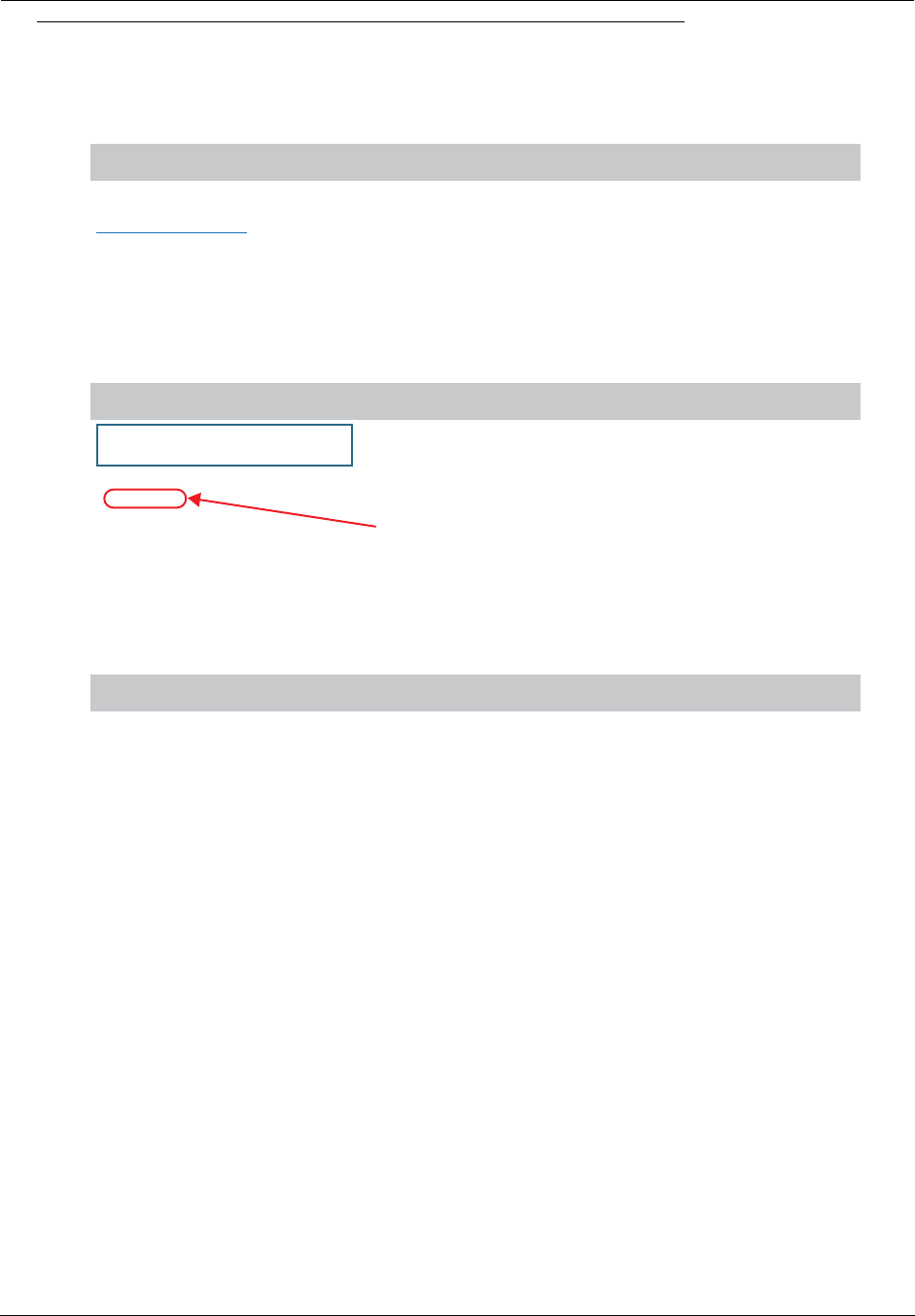
Administrator’s Handbook
8
Documentation Conventions
General
This manual uses the following conventions to present information:
Internal Web Interface
Command Line Interface
Syntax conventions for the Motorola Gateway command line interface are as follows:
Convention (Typeface) Description
bold
Menu commands
bold sans serif
Web GUI page links and button names
terminal Computer display text
bold terminal User-entered text
Italic Italic type indicates the complete titles of manuals.
Convention (Graphics) Description
Denotes an “excerpt” from a Web page or the visual truncation
of a Web page
Denotes an area of emphasis on a Web page
Convention Description
straight ([ ]) brackets in cmd line Optional command arguments
curly ({ }) brackets, with values
separated with vertical bars (|).
Alternative values for an argument are presented in curly ({ })
brackets, with values separated with vertical bars (|).
bold terminal type face User-entered text
italic terminal type face Variables for which you supply your own values
blue rectangle or line
solid rounded rectangle
with an arrow

9
Organization
This guide consists of five chapters, two appendices, and an index. It is organized as follows:
◆Chapter 1, Introduction — Describes the Motorola® document suite, the purpose of, the audience for, and
structure of this guide. It gives a table of conventions.
◆Chapter 2, “Device Configuration” — Describes how to get up and running with your Motorola® Gateway.
◆Chapter 3, “Basic Troubleshooting” — Gives some simple suggestions for troubleshooting problems with
your Gateway’s initial configuration.
◆Chapter 4, “Command Line Interface” — Describes all the current text-based commands for both the
SHELL and CONFIG modes. A summary table and individual command examples for each mode is provided.
◆Chapter 5, “Technical Specifications and Safety Information”
◆“Appendix A Motorola® Gateway Captive Portal Implementation” — Describes the Motorola® Gateway
Captive Portal Implementation
◆“Appendix B Quality of Service (QoS) Examples” — Describes the Motorola® Gateway Quality of Service
(QoS) Implementation
◆Index
A Word About Example Screens
This manual contains many example screen illustrations. Since Motorola® Gateways offer a wide variety of fea-
tures and functionality, the example screens shown may not appear exactly the same for your particular Gateway
or setup as they appear in this manual. The example screens are for illustrative and explanatory purposes, and
should not be construed to represent your own unique environment.

Administrator’s Handbook
10

11
CHAPTER 2 Device Configuration
Most users will find that the basic Quick Start configuration is all that they ever need to use. The Quick Start sec-
tion may be all that you ever need to configure and use your Motorola® Gateway. For more advanced users, a rich
feature set is available. The following instructions cover installation in Router Mode.
This chapter covers:
◆“Important Safety Instructions” on page 12
◆“Motorola® Gateway Status Indicator Lights” on page 13
◆“Battery Installation (optional)” on page 16
◆“Battery Door Installation Instructions” on page 17
◆“Battery Door Removal Instructions” on page 18
◆“Cradle Installation Instructions” on page 19
◆“Set up the Motorola Gateway” on page 20
◆“Accessing the Web Management Interface” on page 23
◆“Device Status page” on page 27
◆“Tab Bar” on page 31
◆“Broadband” on page 37
◆“Home Network” on page 41
◆“Wireless” on page 46
◆“Voice” on page 56
◆“Firewall” on page 62
◆“Diagnostics” on page 80

Administrator’s Handbook
12
Important Safety Instructions
POWER SUPPLY INSTALLATION
Connect the power supply cord to the power jack on the Motorola® Gateway. Plug the power supply into an appro-
priate electrical outlet. There is no power (on / off) switch to power off the device.
☛ WARNING:
The power supply must be connected to a mains outlet with a protective earth connection.
Do not defeat the protective earth connection.
CAUTION:
Depending on the power supply provided with the product, either the direct plug-in power supply
blades, power supply cord plug or the appliance coupler serves as the mains power disconnect. It is
important that the direct plug-in power supply, socket-outlet or appliance coupler be located so it is
readily accessible.
TELECOMMUNICATION INSTALLATION
When using your telephone equipment, basic safety precautions should always be followed to reduce the risk of
fire, electric shock and injury to persons, including the following:
◆Do not use this product near water, for example, near a bathtub, wash bowl, kitchen sink or laundry tub, in a
wet basement or near a swimming pool.
◆Avoid using a telephone (other than a cordless type) during an electrical storm. There may be a remote risk of
electrical shock from lightning.
◆Do not use the telephone to report a gas leak in the vicinity of the leak.
◆CAUTION: The external phone should be UL Listed and the connections should be made in accordance with
Article 800 of the NEC.
COAX INSTALLATION
Be sure that the outside cable system is grounded, so as to provide some protection against voltage surges and
built-up static charges. Article 820-20 of the NEC (Section 54, Part I of the Canadian Electrical Code) provides
guidelines for proper grounding and, in particular, specifies the CATV cable ground shall be connected to the
grounding system of the building, as close to the point of cable entry as practical.
PRODUCT VENTILATION
The Motorola® Gateway is intended for use in a consumer's home. Ambient temperatures around this product
should not exceed 104°F (40°C). It should not be used in locations exposed to outside heat radiation or trapping
of its own heat. The product should have at least one inch of clearance on all sides except the bottom when prop-
erly installed and should not be placed inside tightly enclosed spaces unless proper ventilation is provided.
☛ CAUTION –
The battery used in this device may present a risk of fire or chemical burn if mis-
treated. Do not disassemble, heat above manufacturer’s maximum temperature
limit, or incinerate. Replace battery with Motorola P/N 586185-001-00 only. Use of
another battery may present a risk of fire or explosion.
Dispose of used battery promptly. Keep away from children. Do not disassemble
and do not dispose of in fire.
SAVE THESE INSTRUCTIONS
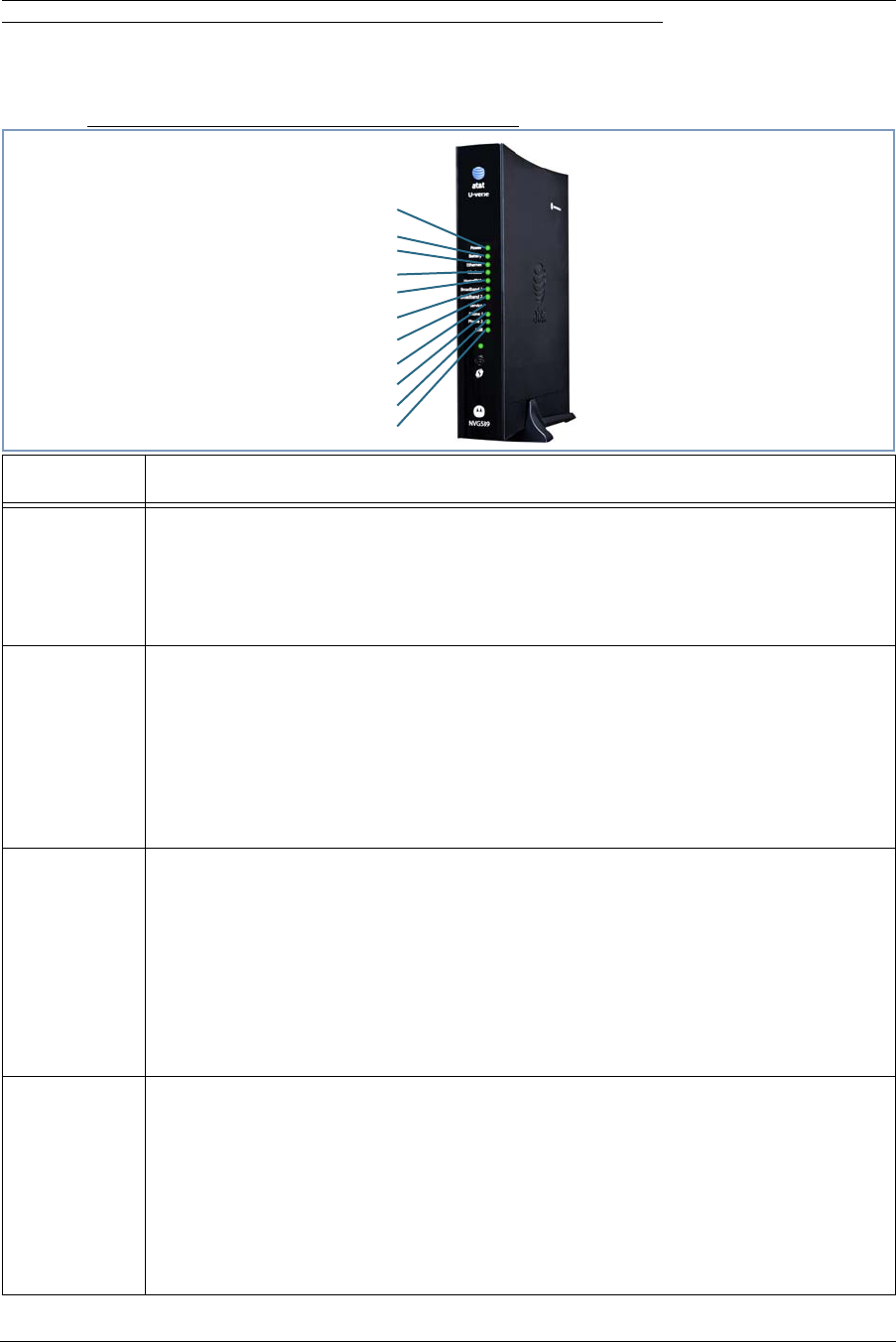
13
Motorola® Gateway Status Indicator Lights
Colored LEDs on your Motorola® Gateway indicate the status of various port activity.
Motorola® Gateway NVG589 status indicator lights
LED Action
Power*
Solid Green = The device is powered.
Flashing Green = A Power-On Self-Test (POST) is in progress
Flashing Red = A POST failure (not bootable) or device malfunction occurred.
Orange/Amber = during firmware upgrade (see below)
Off = The unit has no AC power.
*During
Firmware
Upgrade
During the software installation, you will lose internet and phone service. The LEDs will func-
tion as follows:
1. As firmware is being loaded into flash, the LEDs will operate normally as described.
2. The installation will take a few minutes –
During this phase, the Power LED willl flash Orange/Amber during firmware upgrade
(flash writing to memory) and all other LEDs will be off.
3. The Gateway will restart automatically.
As the device reboots, the POWER ON LED behavior will happen.
During
Boot
process
• Power LED = GREEN/FLASH
• All other LED = OFF
If the device does not boot, and fails its self test or fails to perform initial load of the boot-
loader:
• Power LED = RED/FLASH
• ALL other LED = OFF
If the device boots and then detects a failure:
Power LED = GREEN/FLASH starting POST and then all LEDs will FLASH RED, including
Power LED.
Battery
Solid Green = Battery in place but not being used.
Flashing Green = Battery charging.
Solid Red = Battery backup mechanism has a fault.
Flashing Red = Battery needs to be replaced.
Solid Amber = Battery in use.
Flashing Amber = Low battery.
Off = No battery or battery has no charge.
Cycle between all colors = Battery conducting self-test.
Side View
Power
Battery
Ethernet
Wireless
HomePNA
USB
Broadband 1
Broadband 2
Service
Phone 1
Phone 2

Administrator’s Handbook
14
Ethernet
Solid Green = Powered device connected to the associated port (includes devices with
wake-on-LAN capability where a slight voltage is supplied to the Ethernet connection).
Flickering Green = Activity seen from devices associated with the port. The flickering of the
light is synchronized to actual data traffic.
Off = The device is not powered, no cable or no powered devices connected to the associ-
ated ports.
Wireless
Solid Green = Wi-Fi is powered.
Flickering Green = Activity seen from devices connected via Wi-Fi. The flickering of the
light is synchronized to actual data traffic.
Off = The device is not powered or no powered devices connected to the associated ports.
HomePNA
Solid Green = Powered device connected to the associated port (includes devices with
wake-on-LAN capability where a slight voltage is supplied to the Ethernet connection).
Flickering Green = Activity seen from devices associated with the port. The flickering of the
light is synchronized to actual data traffic.
Off = The device is not powered, no cable or no powered devices connected to the associ-
ated ports.
Broadband
1**, 2
Solid Green = Good broadband connection (i.e., good DSL Sync or Gigabit Ethernet ).
Flashing Green = Attempting broadband connection (i.e., DSL attempting sync).
Flashing Green & Red = If the broadband connection fails to be established for more than
three consecutive minutes the LED switches to Flashing Green when attempting or waiting
to establish a broadband connection alternating with a five second steady Red. This pattern
continues until the broadband connection is successfully established.
Flashing Red = No DSL signal on the line. This is only used when there is no signal, not dur-
ing times of temporary ‘no tone’ during the training sequence.
Off = The device is not powered.
** Broadband 1 LED is also the Gigabit ethernet WAN LED when that is in play (and DSL is
not)
Service
Solid Green = IP connected (The device has a WAN IP address from DHCP or 802.1x
authentication and the broadband connection is
up).
Flashing Green = Attempting PPP connection. Attempting IEEE 802.1X authentication or
attempting to obtain DHCP information.
Red = Device attempted to become IP connected and failed (no DHCP response, 802.1x
authentication failed, no IP address from IPCP, etc.). The Red state times out after two min-
utes and the Service indicator light returns to the Off state.
Off = The device is not powered or the broadband connection is not present.
Phone 1, 2
Solid Green = The associated VoIP line has been registered with a SIP proxy server.
Flashing Green = Indicates a telephone is off-hook on the associated VoIP line.
Off = VoIP not in use, line not registered or Gateway power off.
USB
Solid Green = Powered device connected to the associated port (includes devices with
wake-on-LAN capability where a slight voltage is supplied to the Ethernet connection).
Flickering Green = Activity seen from devices associated with the port. The flickering of the
light is synchronized to actual data traffic.
Off = The device is not powered, no cable or no powered devices connected to the associ-
ated ports.
LED Action
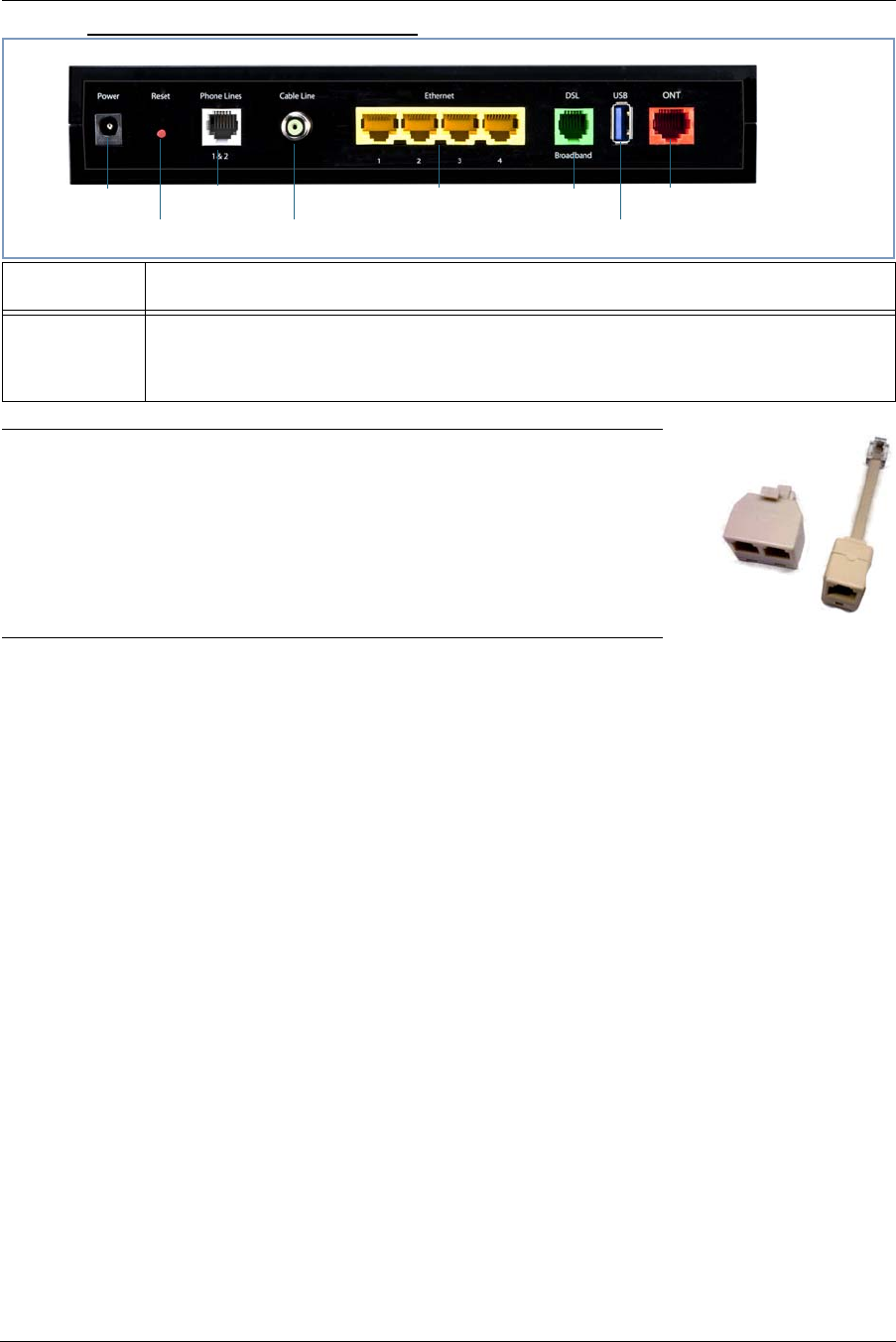
15
Motorola® Gateway NVG589 Rear View
☛ NOTE:
The NVG589 supports two VoIP lines over one RJ11 VoIP port. In order to
connect two phone lines the supplied inner/outer pair splitter adapters
must be attached to the RJ11 VoIP port in order to terminate both lines.
This is a special-purpose splitter. You must only use the inner/outer pair
splitter adapters supplied by AT&T.
LED Action
Ethernet
1,2 3,4
Orange/Amber when a Gigabit Ethernet device is connected to each port.
Green when 10/100 Ethernet device is connected.
Flash for Ethernet traffic passing.
Gigabit Ethernet (WAN)
USB
DSL (WAN)Ethernet (LAN)
F-Connector (HPNA)
RJ14 (FXS)
Reset button
Power Jack
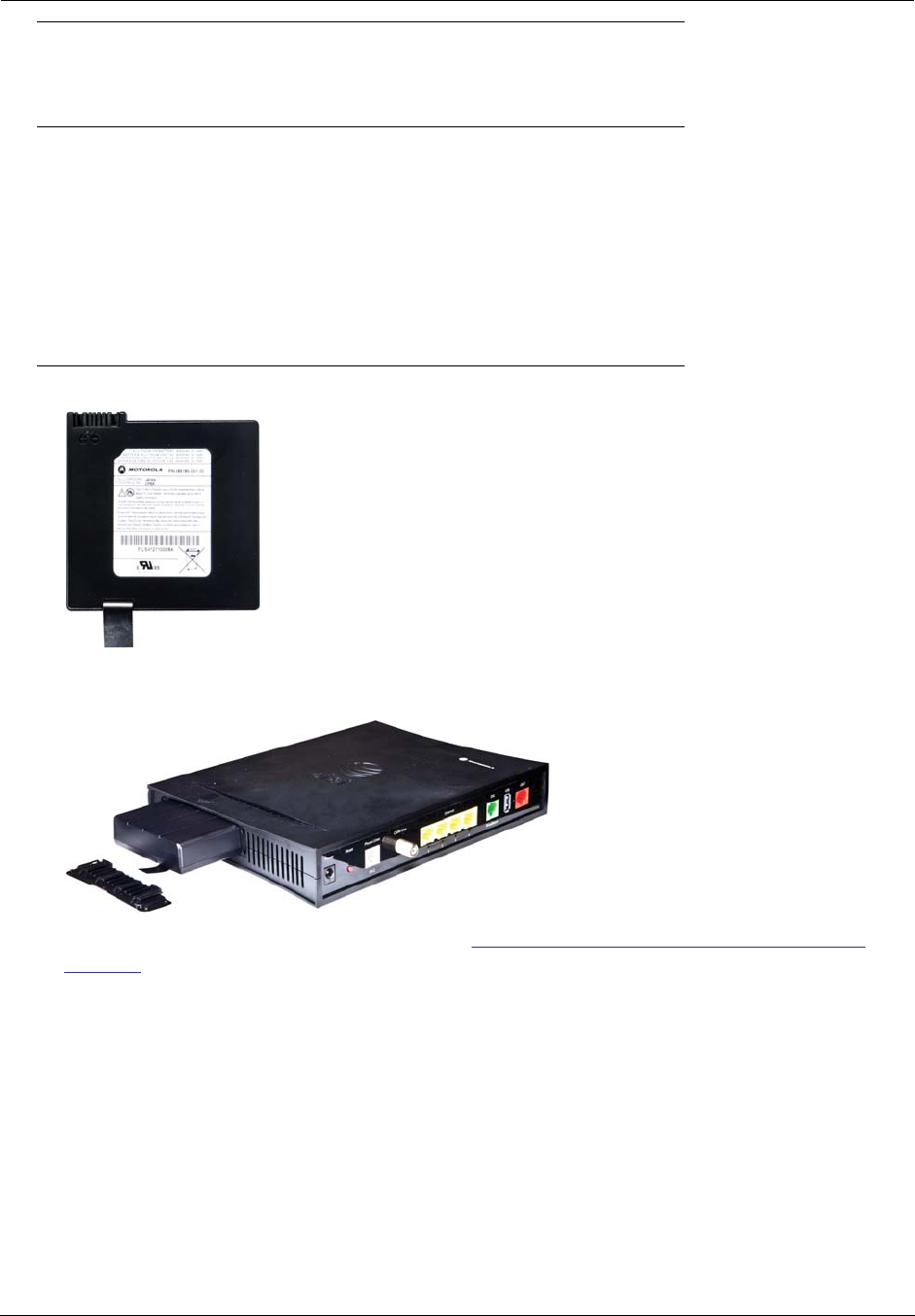
Administrator’s Handbook
16
Battery Installation (optional)
The optional backup battery is located in a compartment on the bottom of the unit. Installing the battery door
requires some care.
☛ CAUTION –
The battery used in this device may present a risk of fire or chemical burn if mis-
treated. Do not disassemble, heat above manufacturer’s maximum temperature
limit, or incinerate. Replace battery with Motorola P/N 586185-001-00 only. Use of
another battery may present a risk of fire or explosion.
Dispose of used battery promptly. Keep away from children. Do not disassemble
and do not dispose of in fire.
1. Note the tab on the bottom of the battery.
2. Insert the battery into the compartment on the bottom of the unit, as shown, and
press into place so that the battery contacts seat securely in the unit.
3. Then attach the compartment door. See “Battery Door Installation Instructions” on
page 17.
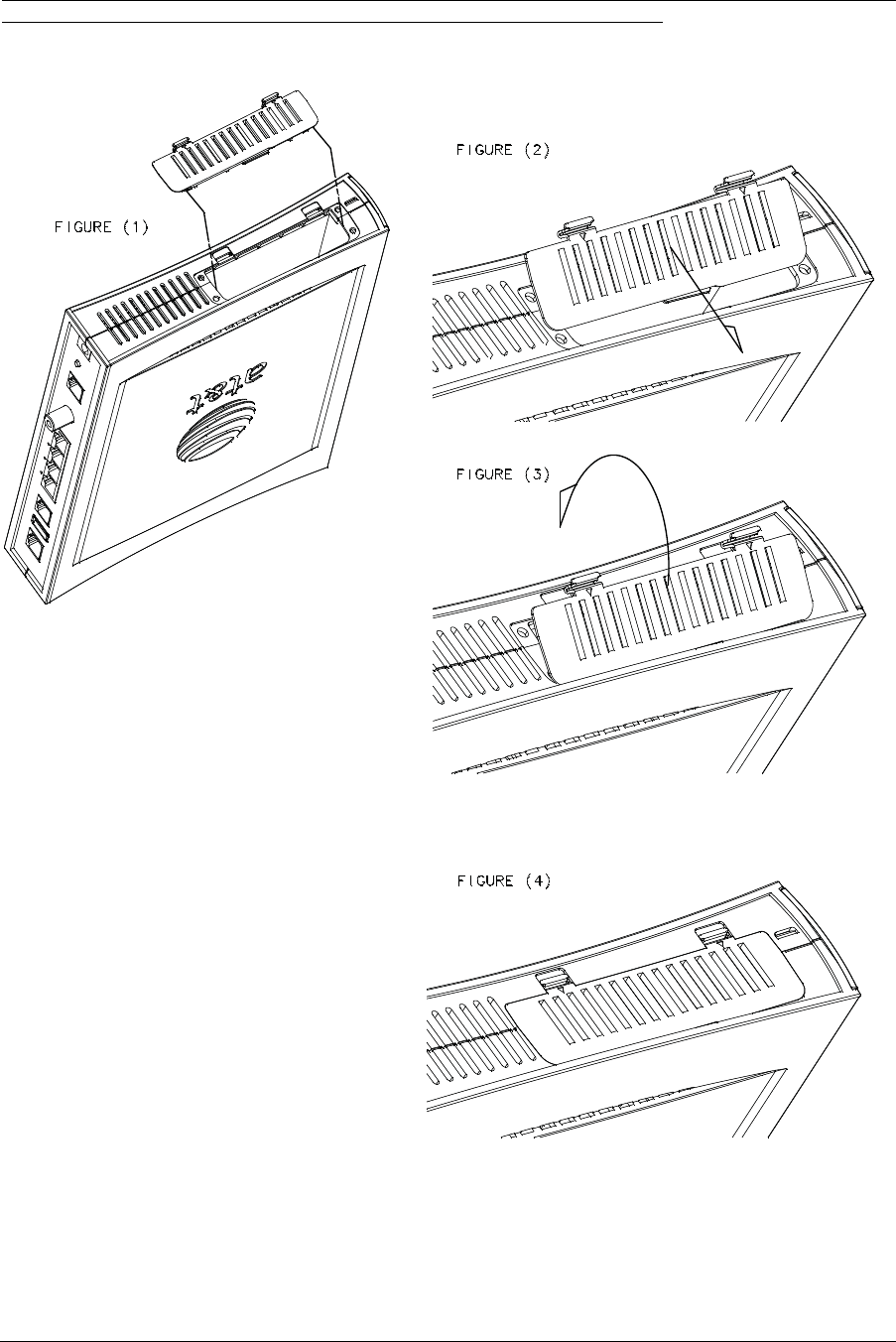
17
Battery Door Installation Instructions
1. Place NVG589 Unit on a table top as shown in FIGURE (1).
2. Place battery door at an angle, as shown, and slide toward edge of unit.
See FIGURE (2).
3. Rotate door in direction shown, see FIGURE (3), and snap closed.
4. Battery door installed. See FIGURE (4).
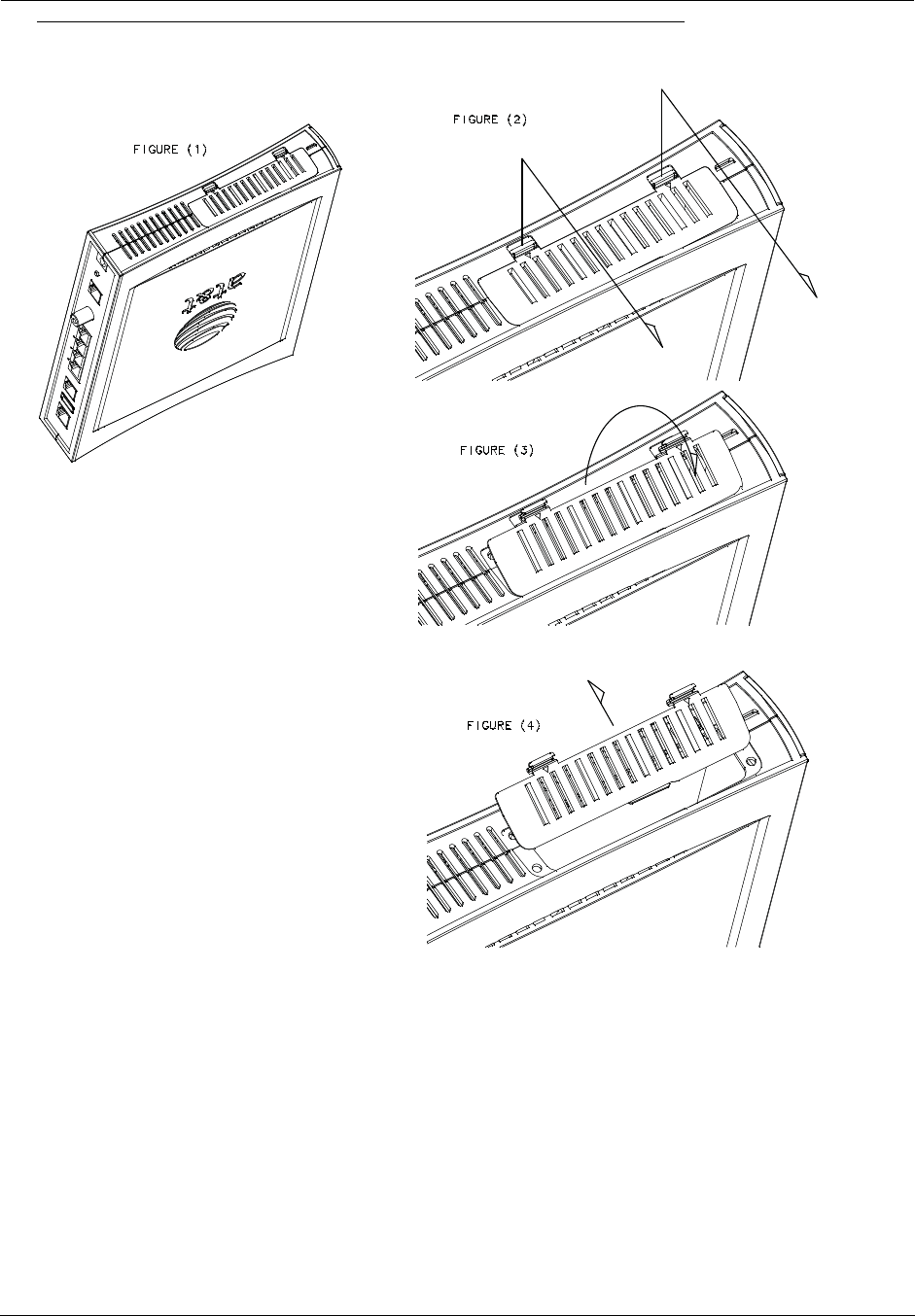
Administrator’s Handbook
18
Battery Door Removal Instructions
1. Place unit on table top as shown in FIGURE (1).
2. Using both hands, pull tabs in directions shown in FIGURE (2).
3. While still pulling the tabs, pull the battery door in the direction shown.
See FIGURE (3).
4. Remove battery door. See FIGURE (4).
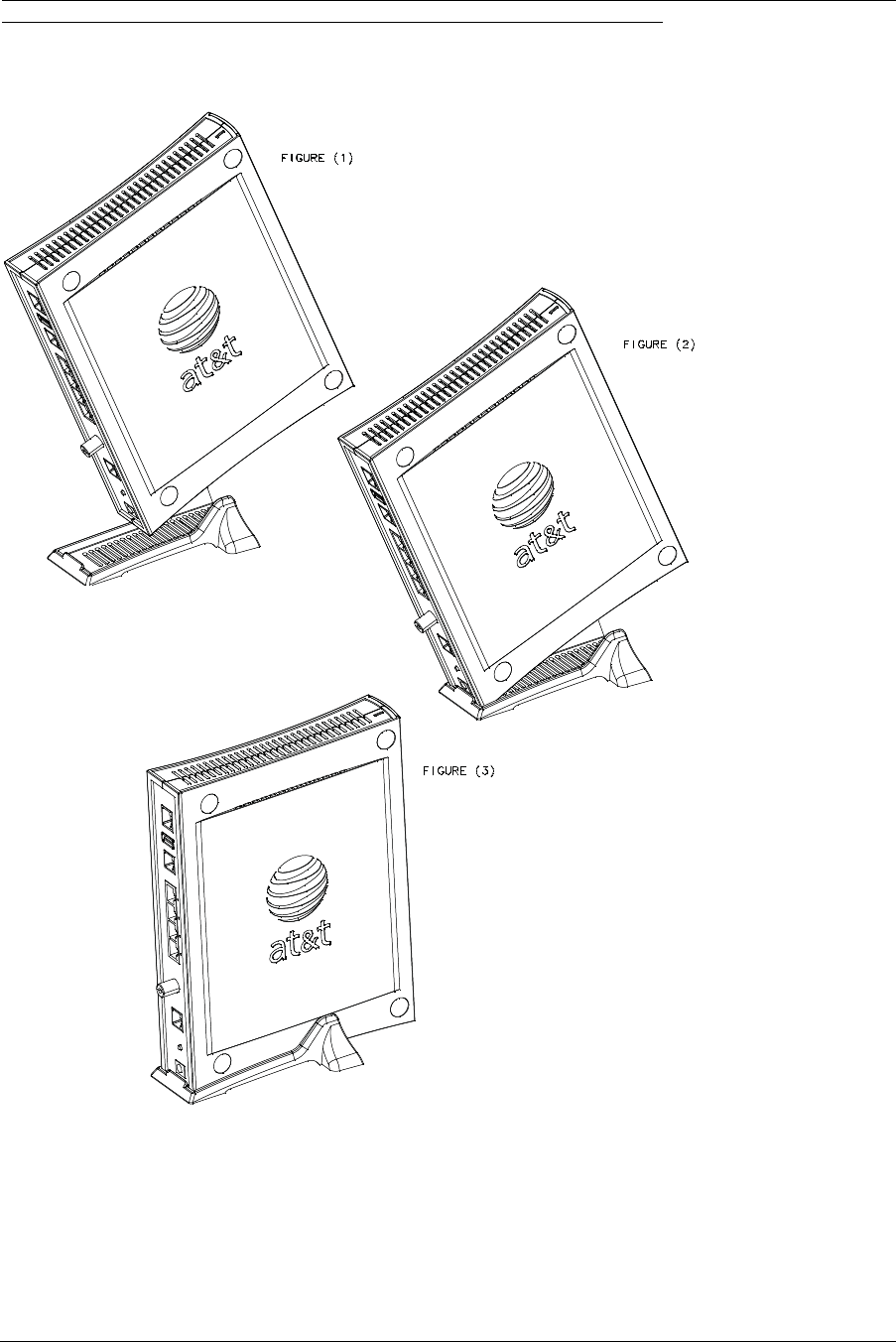
19
Cradle Installation Instructions
1. Angle the NVG589 unit onto the rear of the cradle. See FIGURE (1).
2. Ensure that the NVG589 unit is latched to the rear of the cradle as shown in
FIGURE (2).
3. Once the rear is latched, rotate the NVG589 unit down into the cradle and press until
the snap is engaged. You should hear a “click” for positive engagement.
See FIGURE (3).
4. Reverse sequence, by first pulling on the cradle, for removal.
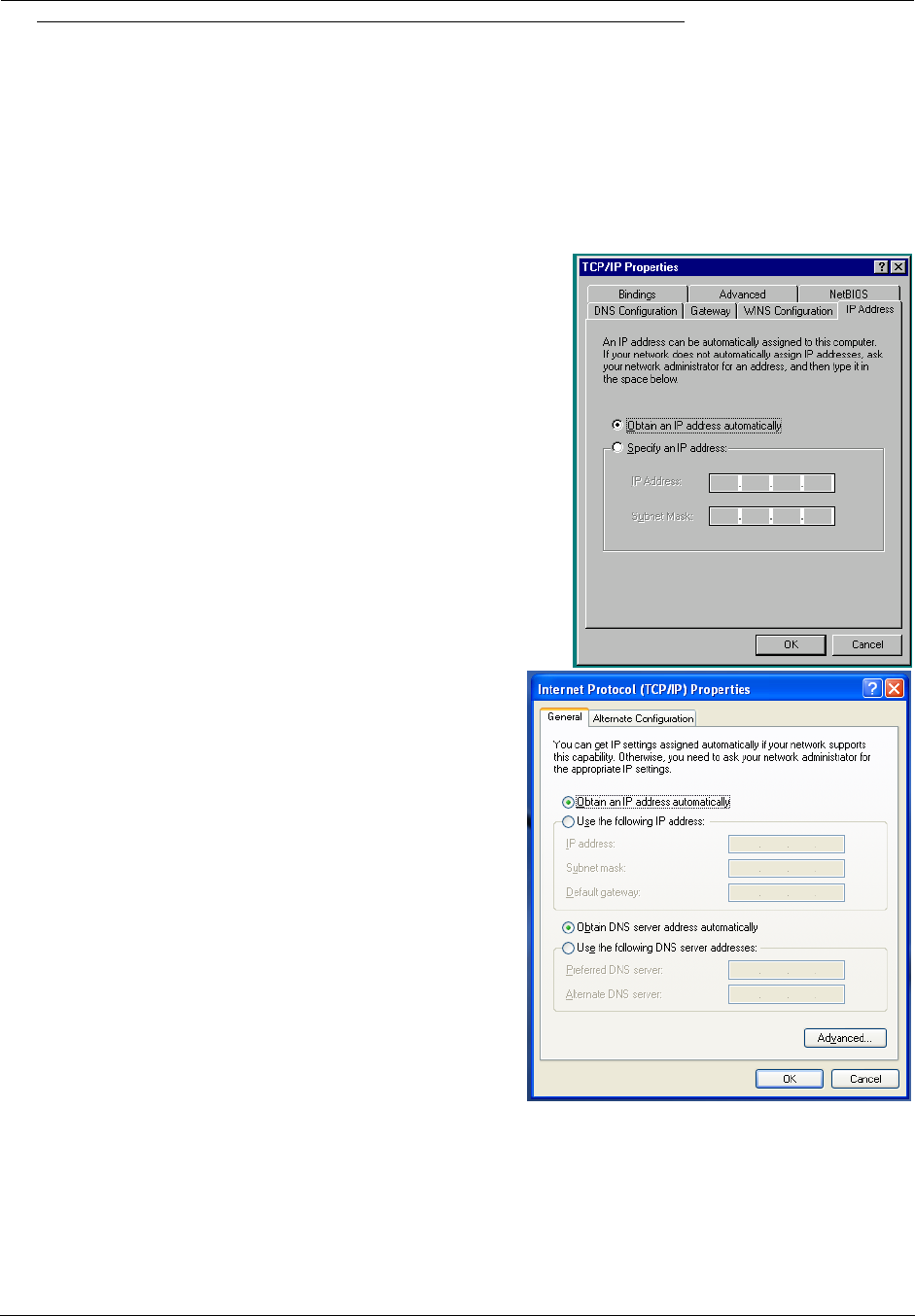
Administrator’s Handbook
20
Set up the Motorola Gateway
Refer to your Quickstart Guide for instructions on how to connect your Motorola® gateway to your power source,
PC or local area network, and your Internet access point, whether it is a dedicated DSL outlet or a DSL or cable
modem. Different Motorola® Gateway models are supplied for any of these connections. Be sure to enable
Dynamic Addressing on your PC. Perform the following:
Microsoft Windows:
Step 1. Navigate to the TCP/IP Properties Control Panel.
a. Some Windows versions follow a path like this:
Start menu -> Settings -> Control Panel -> Network (or Network
and Dial-up Connections -> Local Area Connection -> Proper-
ties) -> TCP/IP [your_network_card] or Internet Protocol
[TCP/IP] -> Properties
b. Some Windows versions follow a path like this:
Start menu -> Control Panel -> Network and Internet
Connections -> Network Connections -> Local Area
Connection -> Properties -> Internet Protocol [TCP/IP]
-> Properties
Then go to Step 2.
Step 2. Select Obtain an IP address automatically.
Step 3. Select Obtain DNS server address automatically, if available.
Step 4. Remove any previously configured Gateways, if available.
Step 5. OK the settings. Restart if prompted.
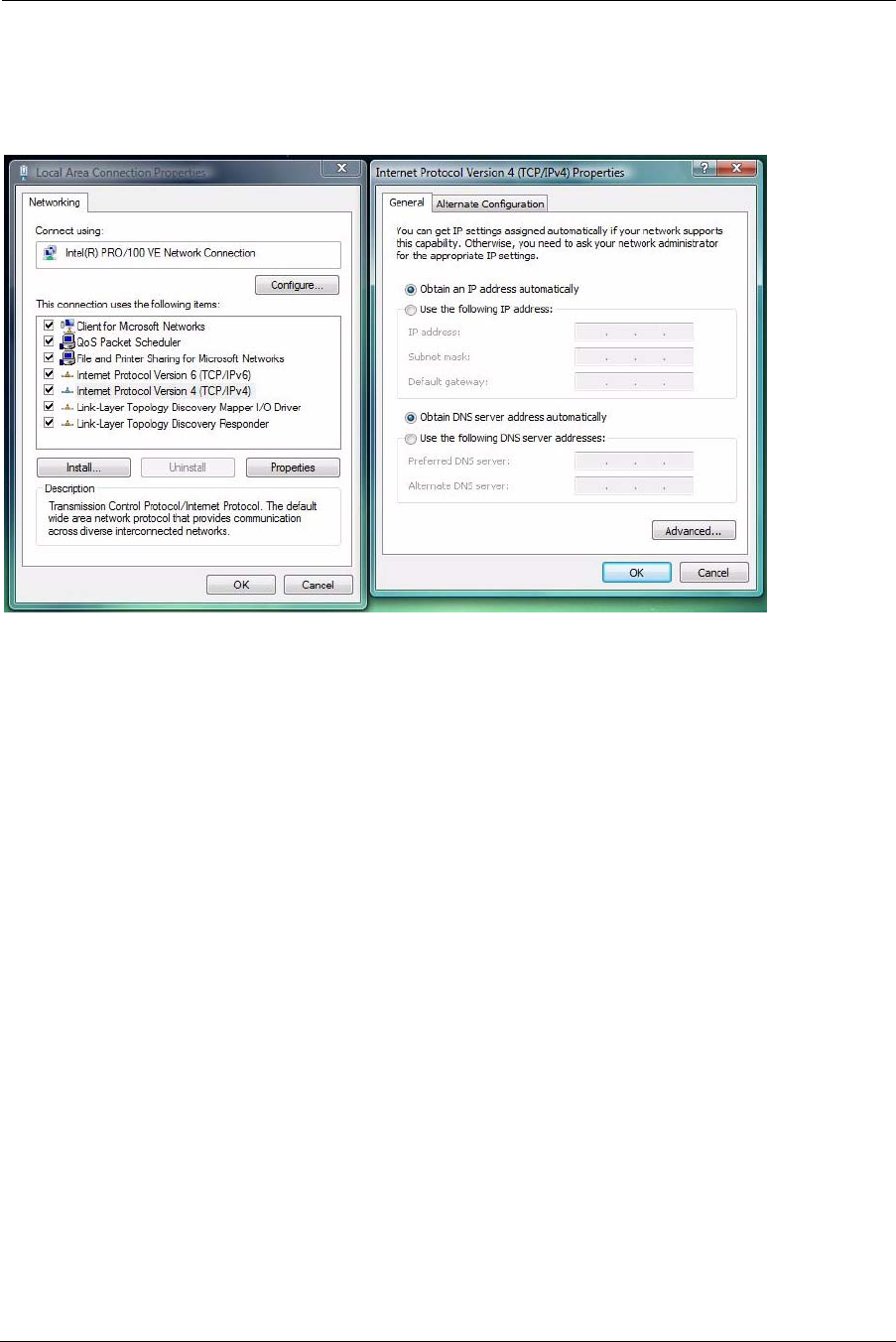
21
c. Windows Vista and Windows 7 obtain an IP address automatically by default. You may not need to configure it
at all.
To check, open the Networking Control Panel and select Internet Protocol Version 4 (TCP/IPv4). Click the
Properties button.
The Internet Protocol Version 4 (TCP/IPv4) Properties window should appear as shown.
If not, select the radio buttons shown above, and click the OK button.
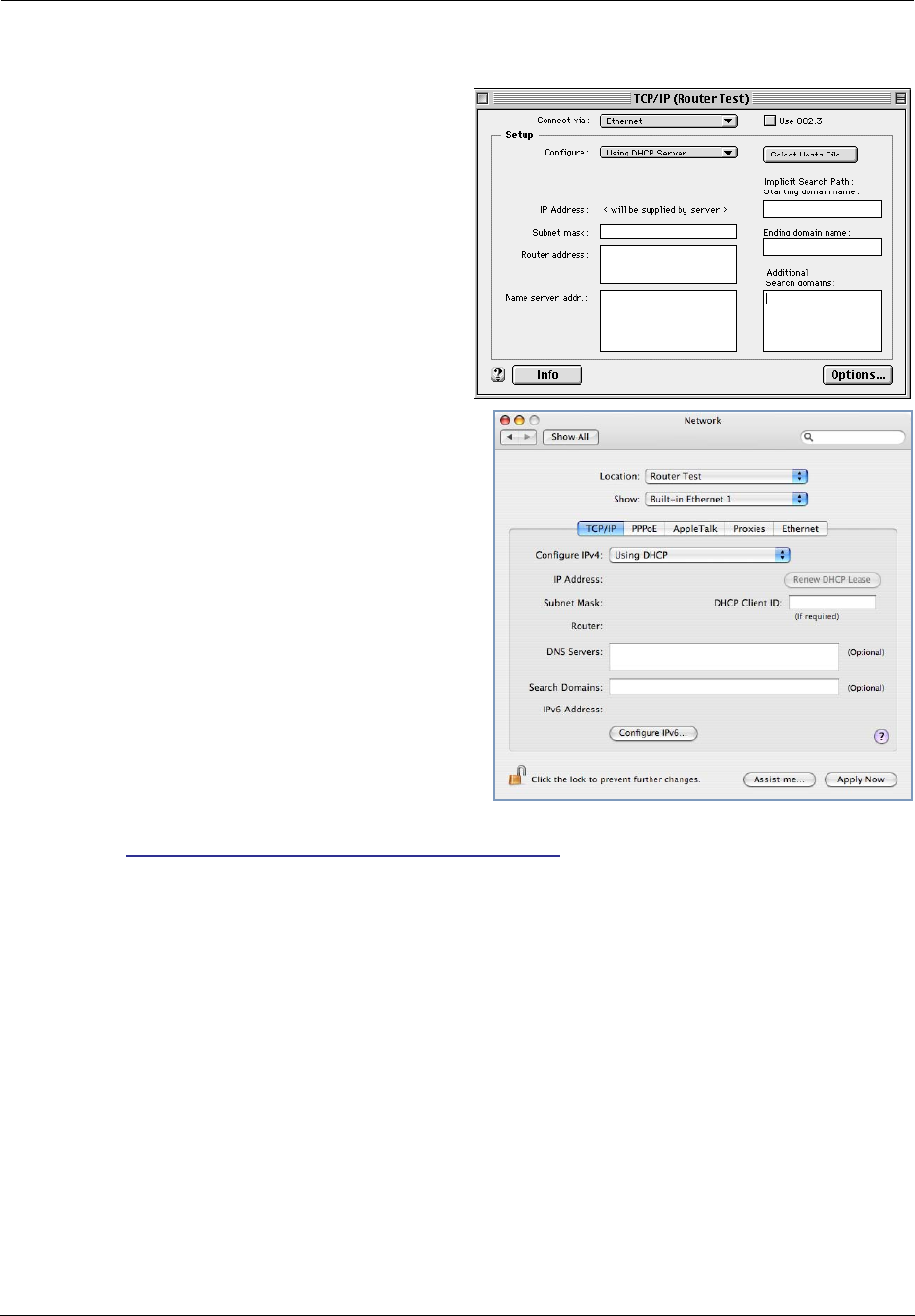
Administrator’s Handbook
22
Macintosh MacOS 8 or higher or Mac OS X:
Step 1. Access the TCP/IP or Network control panel.
a. MacOS follows a path like this:
Apple Menu -> Control Panels -> TCP/IP Control
Panel
b. Mac OS X follows a path like this:
Apple Menu -> System Preferences -> Network
Then go to Step 2.
Step 2. Select Built-in Ethernet
Step 3. Select Configure Using DHCP
Step 4. Close and Save, if prompted.
Proceed to “Accessing the Web Management Interface” on page 23.
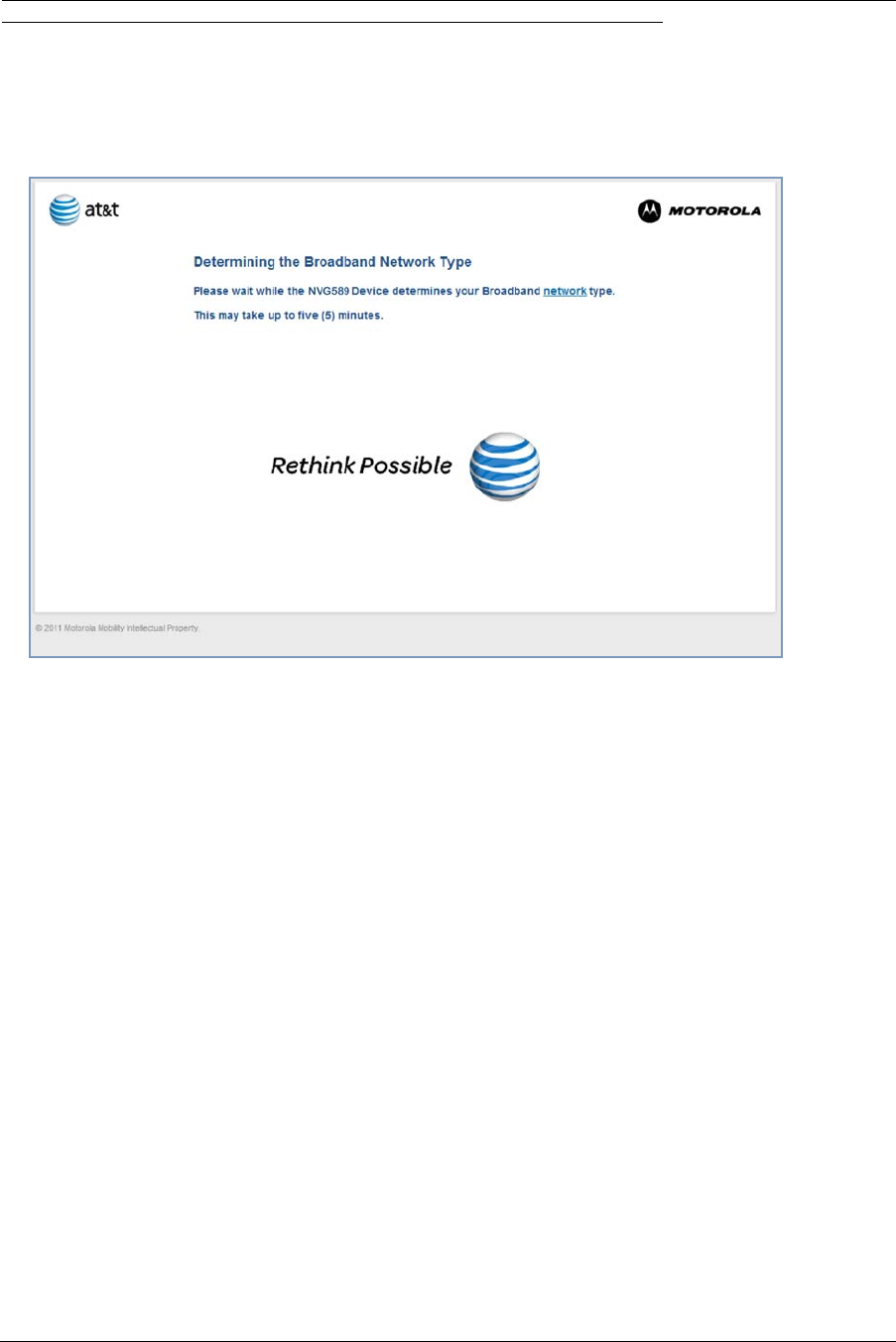
23
Accessing the Web Management Interface
1. Run your Web browser application, such as Firefox or Microsoft Internet Explorer,
from the computer connected to the Motorola® Gateway.
2. Enter http://192.168.1.254 in the Location text box.
While the Gateway is determining the Broadband network type, the following screen appears.
The Device Status Page appears.
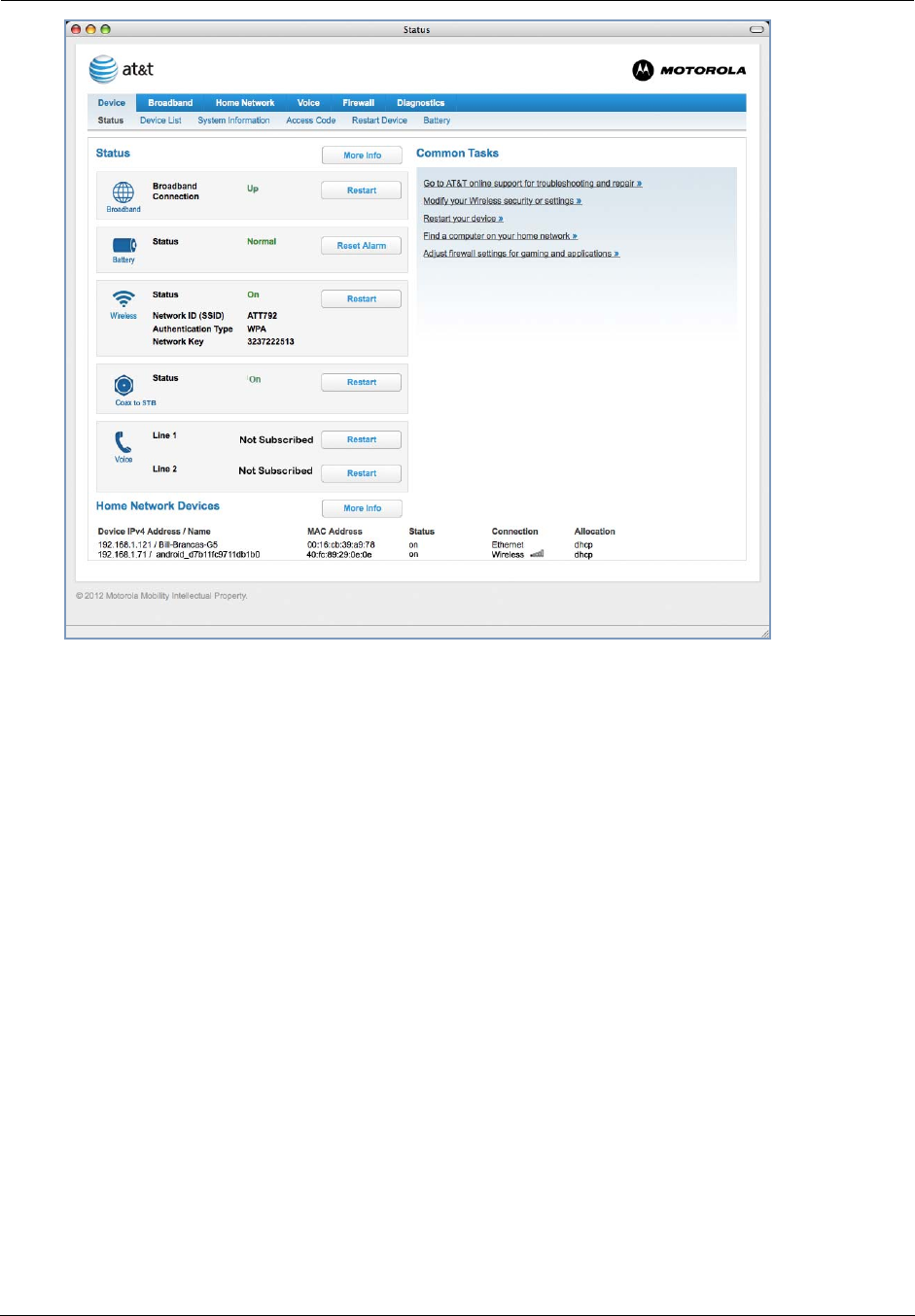
Administrator’s Handbook
24
3. Check to make sure the Broadband and Service LEDs are lit GREEN to verify that
the connection to the Internet is active.
Congratulations! Your installation is complete.
You can now surf to your favorite Web sites by typing an URL in your browser’s location box or by selecting one of
your favorite Internet bookmarks.
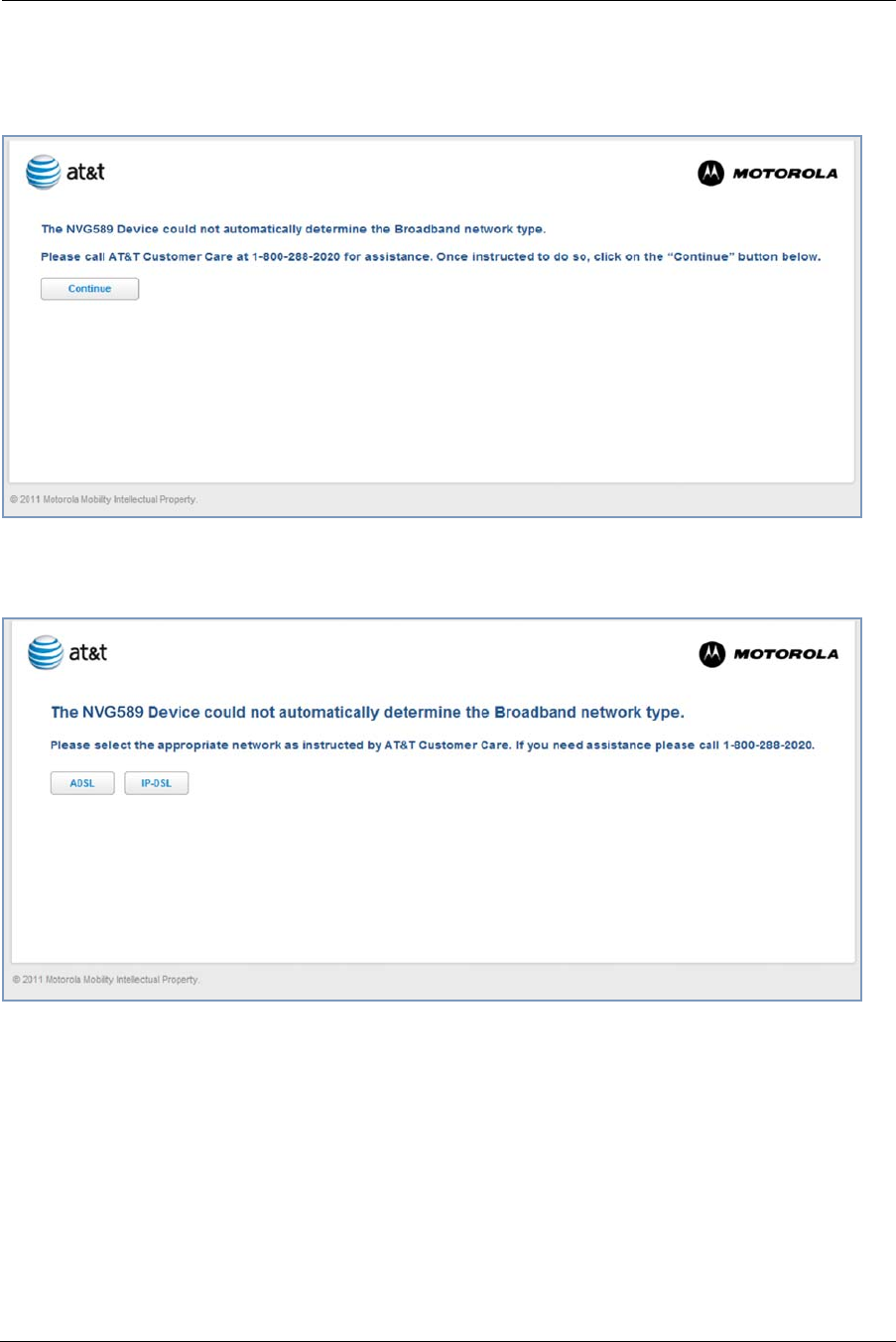
25
Broadband Network Redirect Pages
After a few minutes if the Broadband network cannot be determined, the following screen appears. Contact AT&T
Customer care at the number shown for assistance.
If you click the Continue button, the following screen appears. Here you can manually select the Broadband net-
work type, if you know it.
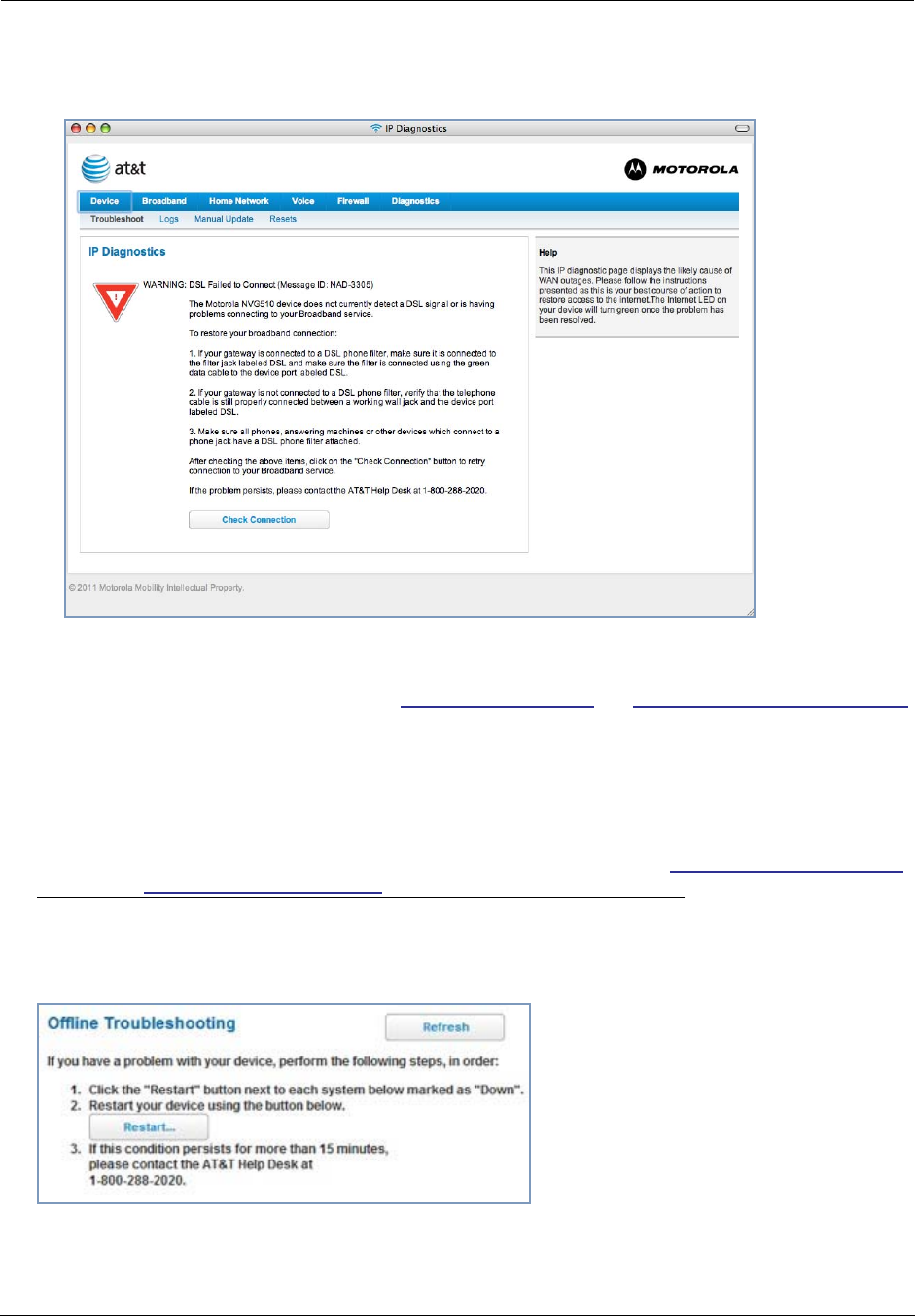
Administrator’s Handbook
26
IP Diagnostics Page Redirect
In the event that your connection to the Internet fails, the Broadband LED will flash RED and you are redirected
to the IP Diagnostics page.
Follow the on-screen troubleshooting suggestions.
For additional troubleshooting information, see “Diagnostics” on page 80 and “Basic Troubleshooting” on page 89.
When your connection is restored or the problem is resolved, the Broadband LED will turn GREEN.
☛ Note:
For AT&T this function is enabled by default. See the CLI command “set management lan-redirect
enable [ off | on ]” on page 149.
Offline Troubleshooting
If the WAN is down, the following will be displayed at the top of the page.
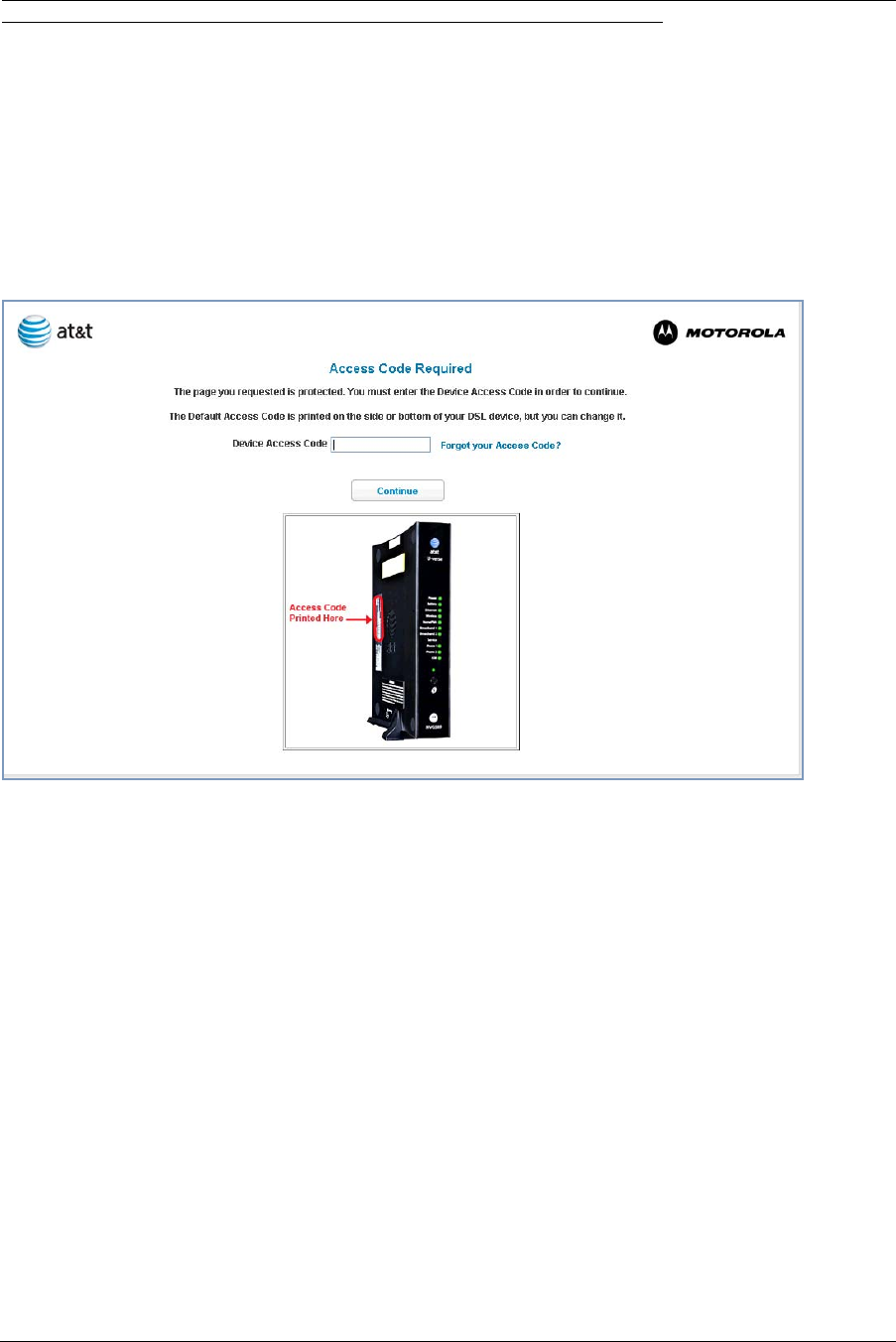
27
Device Status page
After you have performed the basic Easy Login configuration, any time you log in to your Motorola® Gateway you
will access the Motorola® Gateway Home Page.
You access the Home Page by typing http://192.168.1.254 in your Web browser’s location box.
Device Access Code
You may be required to provide your Device Access Code in order to access the web management configuration
pages. The Device Access Code is unique to your device. It is printed on a label on the side of the Gateway.
Enter your Device Access Code and click the Continue button.
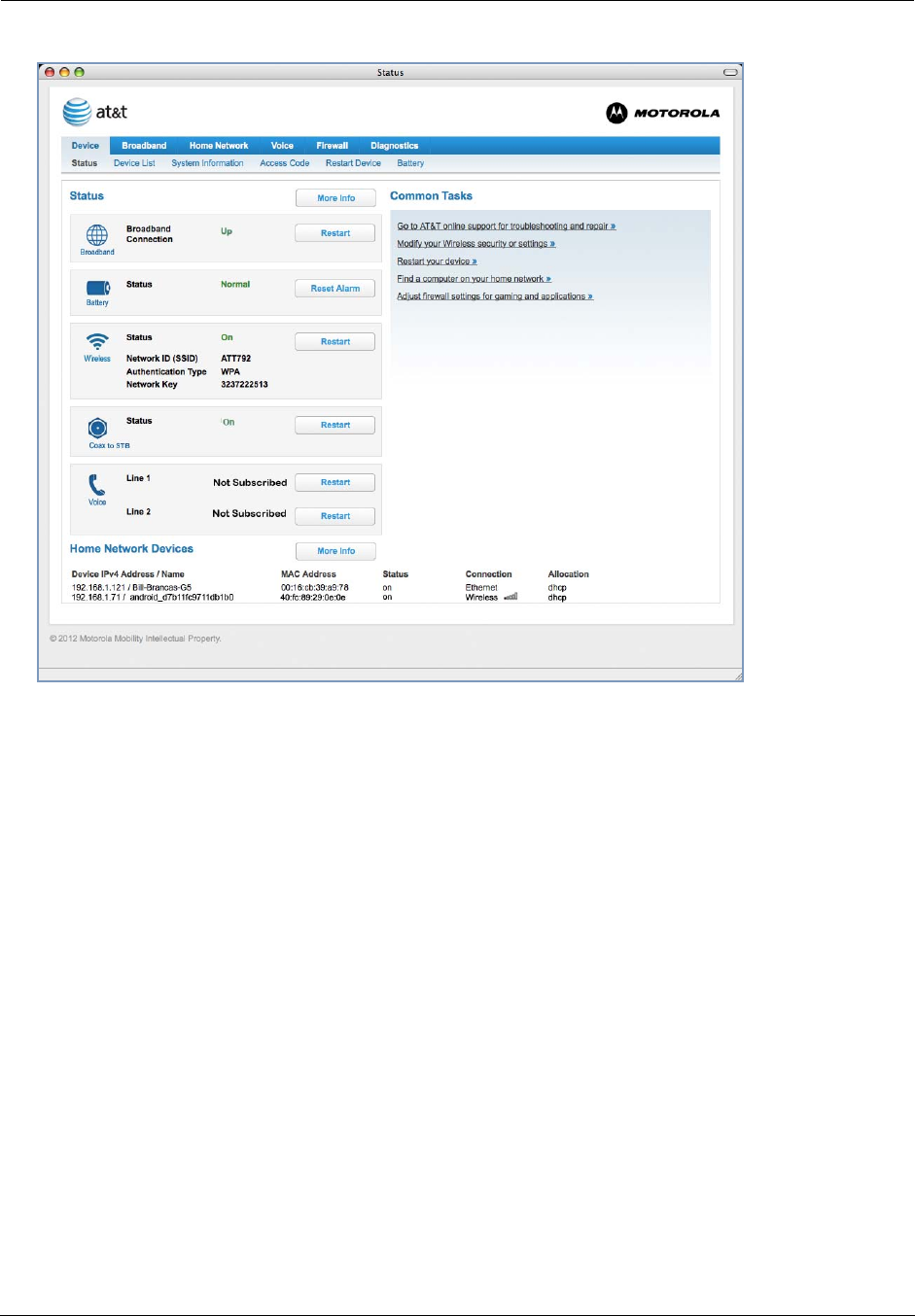
Administrator’s Handbook
28
The Device Status Page appears.
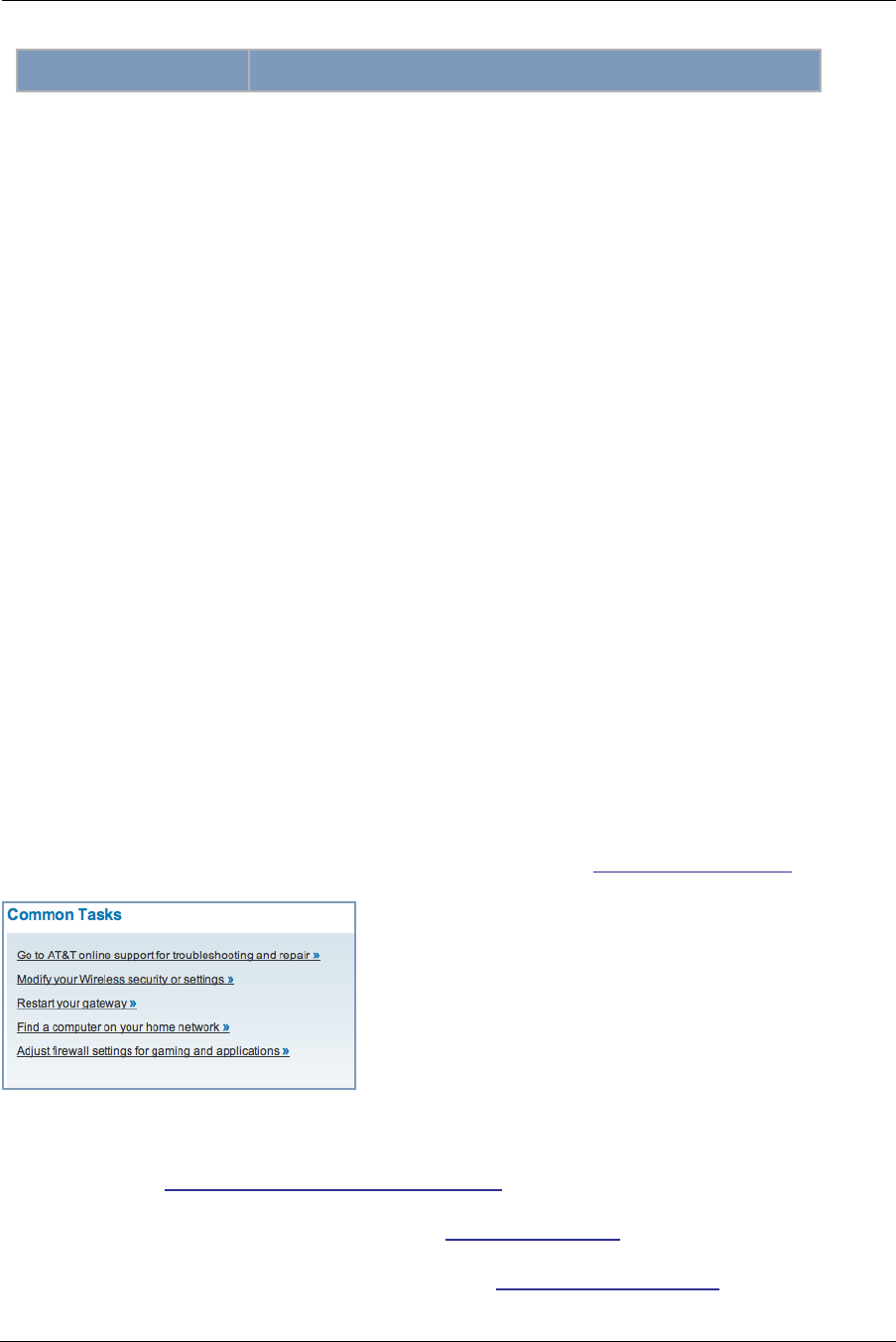
29
The Device Status displays the following information in the center section:
Some fields may or may not display, depending on your particular setup.
The Diagnostics button will connect you to the Troubleshoot page. See “Diagnostics” on page 80.
The right-hand frame displays some links to commonly performed
tasks for easy access.
◆Go to AT&T online support for troubleshooting and repair »
This link will connect you to the IP Diagnostics page with help for troubleshooting and the AT&T Help Desk
information. See “IP Diagnostics Page Redirect” on page 26.
◆Modify your Wireless security or settings »
This link will connect you to the Wireless page. See “Wireless” on page 46.
◆Restart your device »
This link will connect you to the Restart Device page. See “Restart Device” on page 36.
Field Description
Broadband
Broadband Connection ‘Waiting for DSL’ is displayed while the Gateway is training. This
should change to ‘Up’ within two minutes.
‘Up’ is displayed when the ADSL line is synched and the session is
established.
‘Down’ indicates inability to establish a connection; possible line fail-
ure.
Battery
Status Normal or Low Battery or Charging or Warning - No battery or bat-
tery has no charge or Warning: Battery backup mechanism has a
fault.
Wireless
Status Your wireless signal may be ‘On’ or ‘Off’.
Network ID (SSID) This is the name or ID that is displayed to a client scan. The default
SSID for the Gateway is attxxx where xxx is the last 3 digits of the
serial number located on the side of the Gateway.
Authentication Type The type of wireless encryption security in use. May be Disabled,
WPA or WEP, Default Key or Manual.
Network Key Wireless network encryption key in use.
Coax to STB
Status Off or On.
Voice
Line 1 Indication of VoIP or other phone connection.
Line 2 Indication of VoIP or other phone connection.
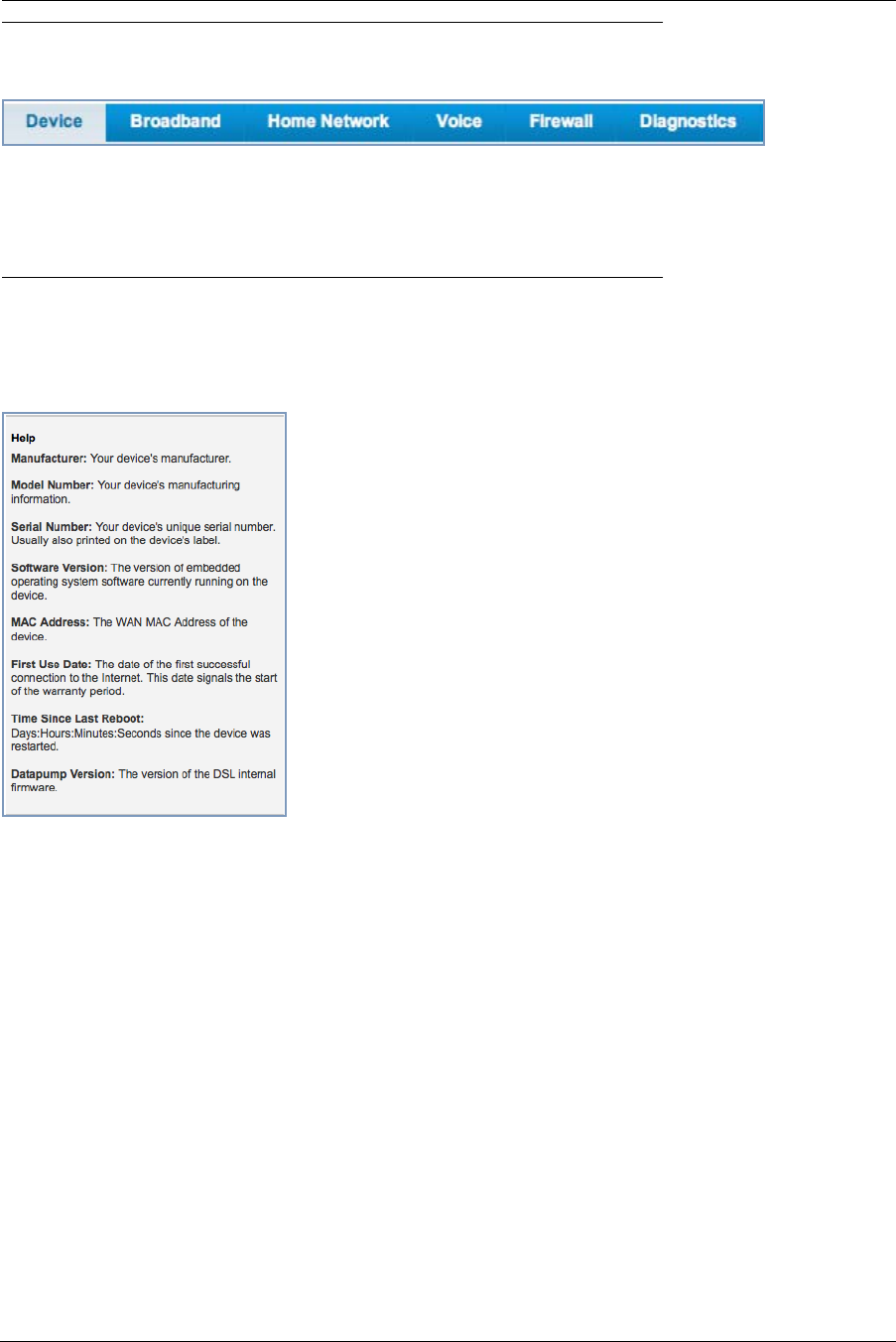
31
Tab Bar
The tab bar is located at the top of every page, allowing you to move freely about the site.
The tabs reveal a succession of pages that allow you to manage or configure several features of your Gateway.
Each tab is described in its own section.
Help
Help is provided in your Gateway. Help is available in the right hand frame on every page in the Web interface.
Here is an example:
The page shown here is displayed when you are on the
System Information page.
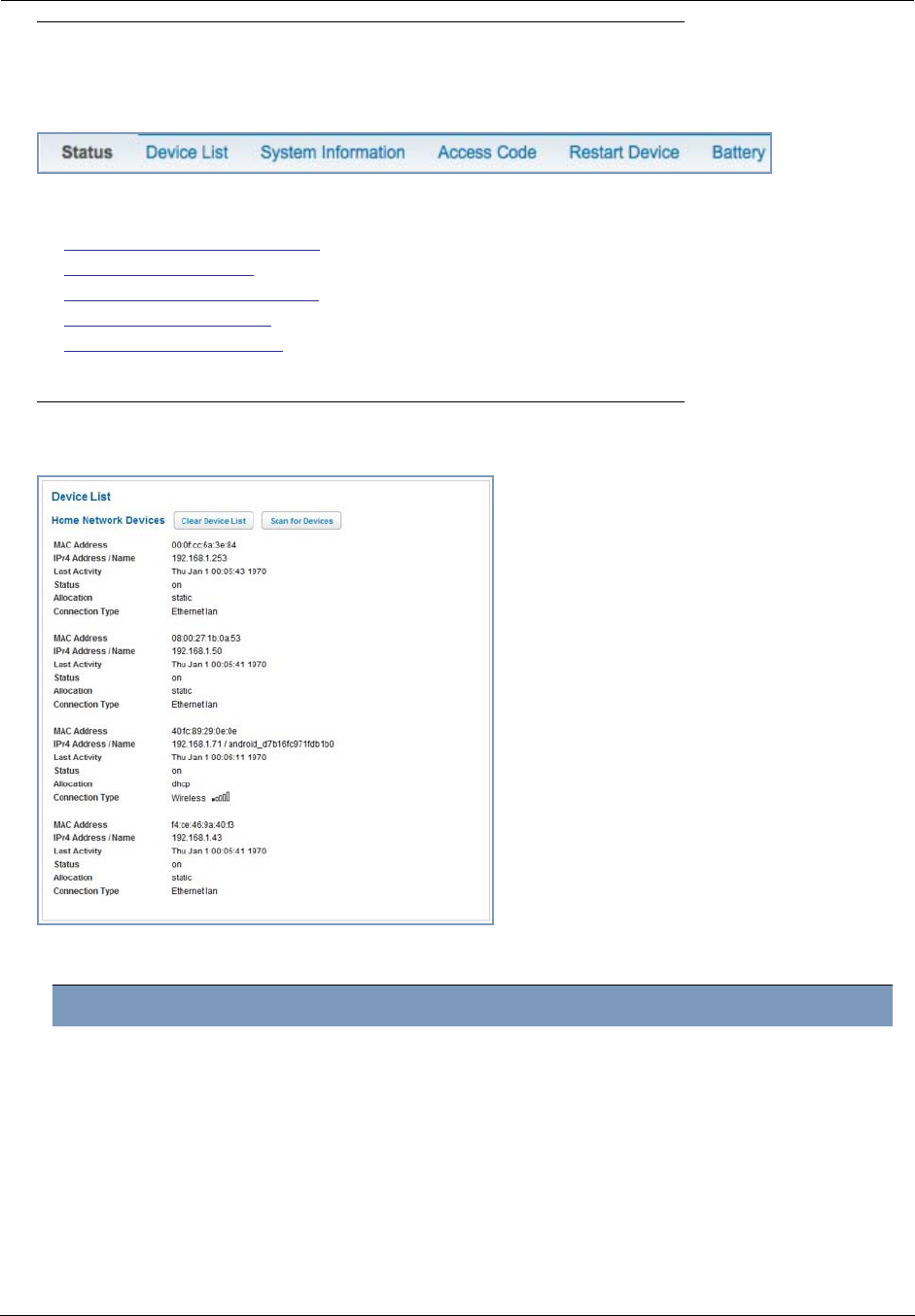
Administrator’s Handbook
32
Links Bar
The links bar at the top of each page allows you to configure different aspects of the features displayed on the
page. For example, on the Home Summary page, the button bar is shown below:
Click the links below to be taken to each section.
◆“Device Status page” on page 27
◆“Device List” on page 32
◆“System Information” on page 34
◆“Access Code” on page 35
◆“Restart Device” on page 36
Link: Device List
When you click the Device List link, the Device List page appears.
The page displays the following information:
Home Network Devices
Home Network Devices Displays the IPv4 Address, Network Name, and MAC Address of
devices connected to this device on your local area network.
MAC Address Client device’s unique hardware address.
IPv4 Address / Name Client device’s IP address or device network name.
Last Activity Date and time of last traffic for this client device
Status May be off or on.
Allocation Type of IP address assignment, for example, Static or DHCP.
Connection Type Type of connection, for example, Ethernet or Wireless
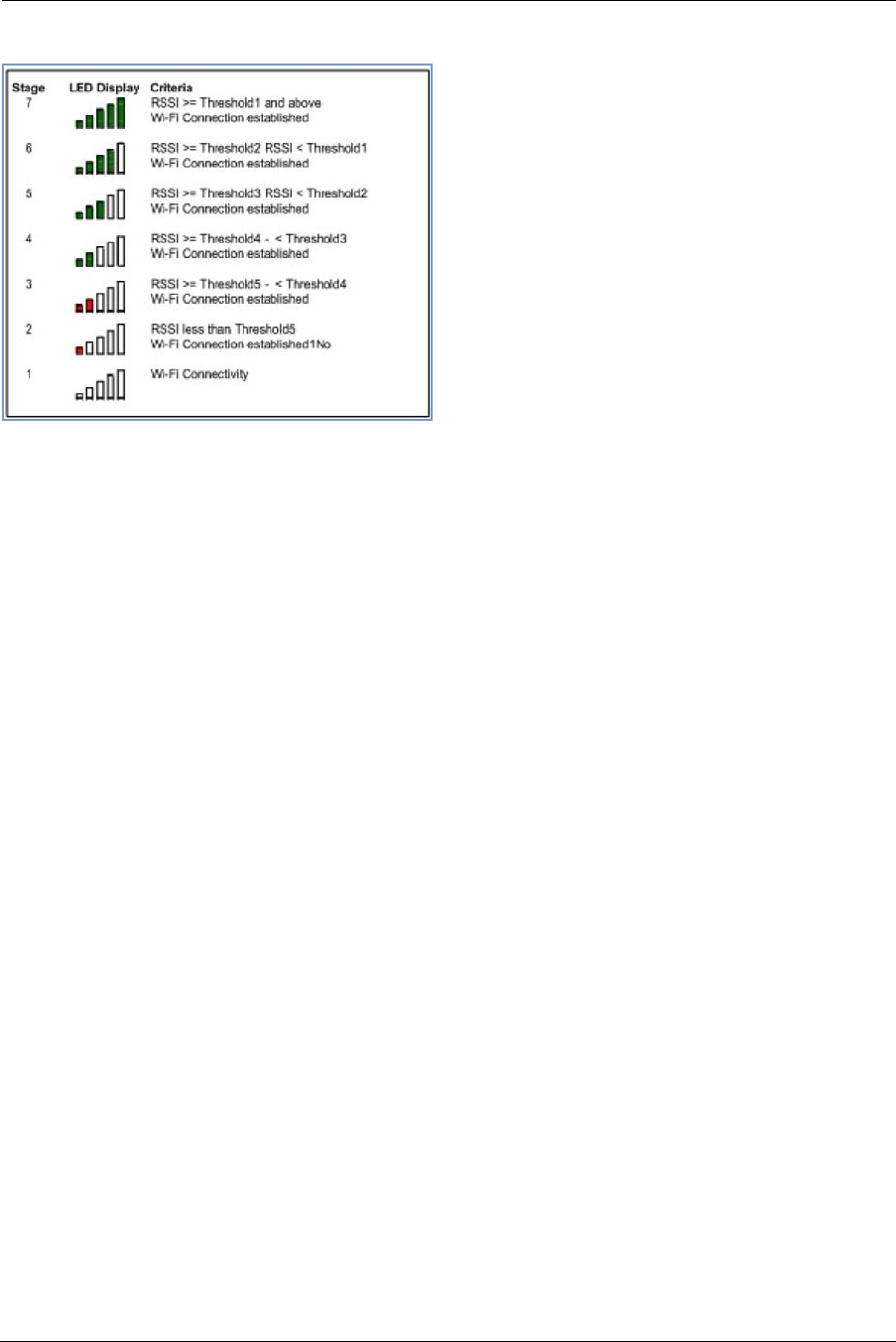
33
For Wireless client connections, the Device List displays the familiar bars indicating signal strength, as follows:
◆Click the Clear Device List button to update the Home Network summary.
◆Click the Scan for Devices button to seek out other devices that have been connected since the last Home
Network summary update.
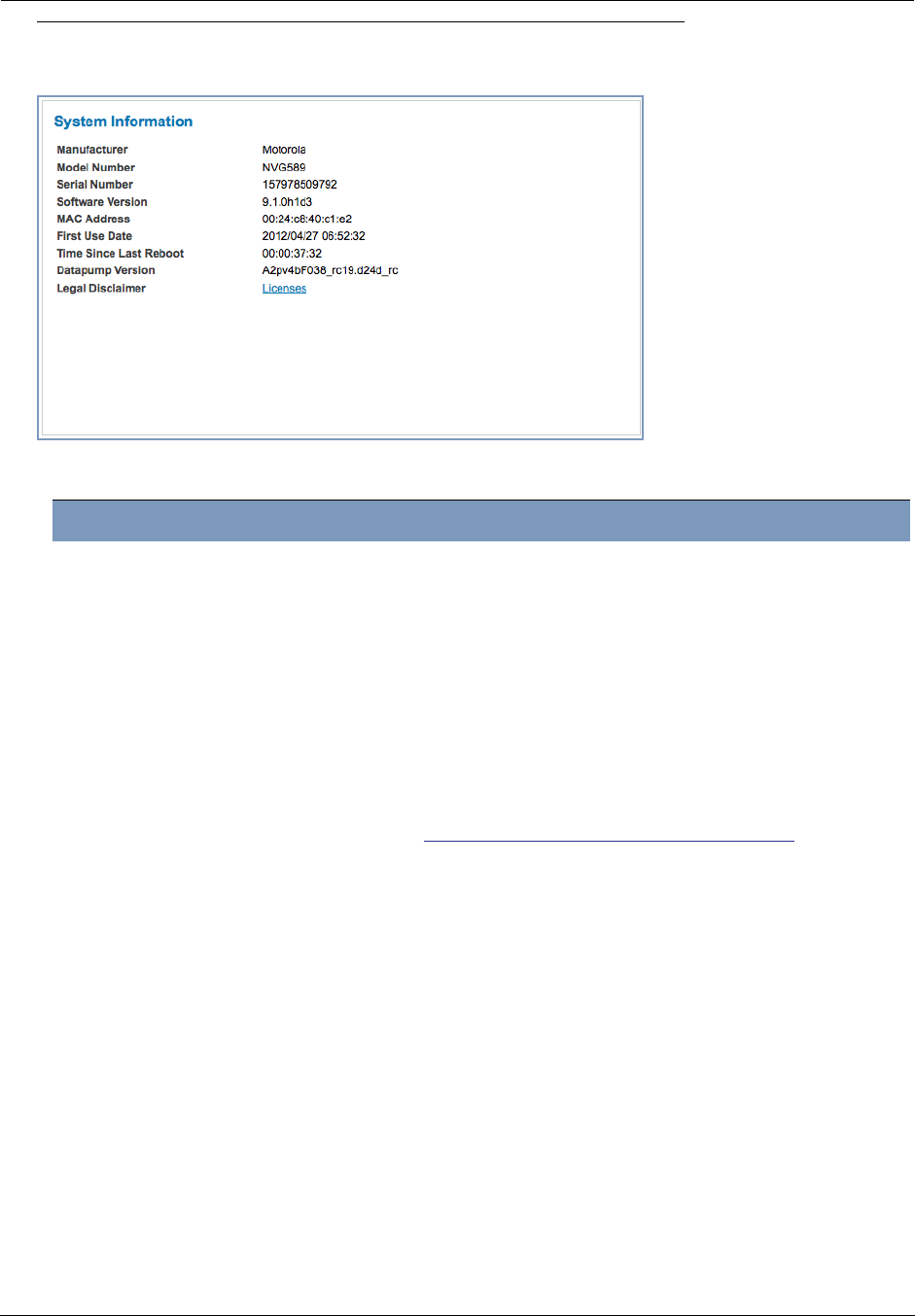
Administrator’s Handbook
34
Link: System Information
When you click the System Information link, the System Information page appears.
The page displays the following information:
System Information
Manufacturer This is the manufacturer’s identifier name.
Model Number This is the manufacturer’s model number.
Serial Number This is the unique serial number of your Gateway.
Software Version This is the version number of the current embedded software in your Gateway.
MAC Address Unique hardware address of this Gateway unit.
First Use Date Date and Time when the Gateway is first used. This field changes to the cur-
rent date and time after a reset to factory defaults.
Time Since Last Reboot Elapsed time since last reboot of the Gateway in days:hr:min:sec.
Datapump Version Underlying operating system software datapump version
Legal Disclaimer Clicking the Licenses link displays a listing of software copyright attributions
also shown here:“Copyright Acknowledgments” on page 183.
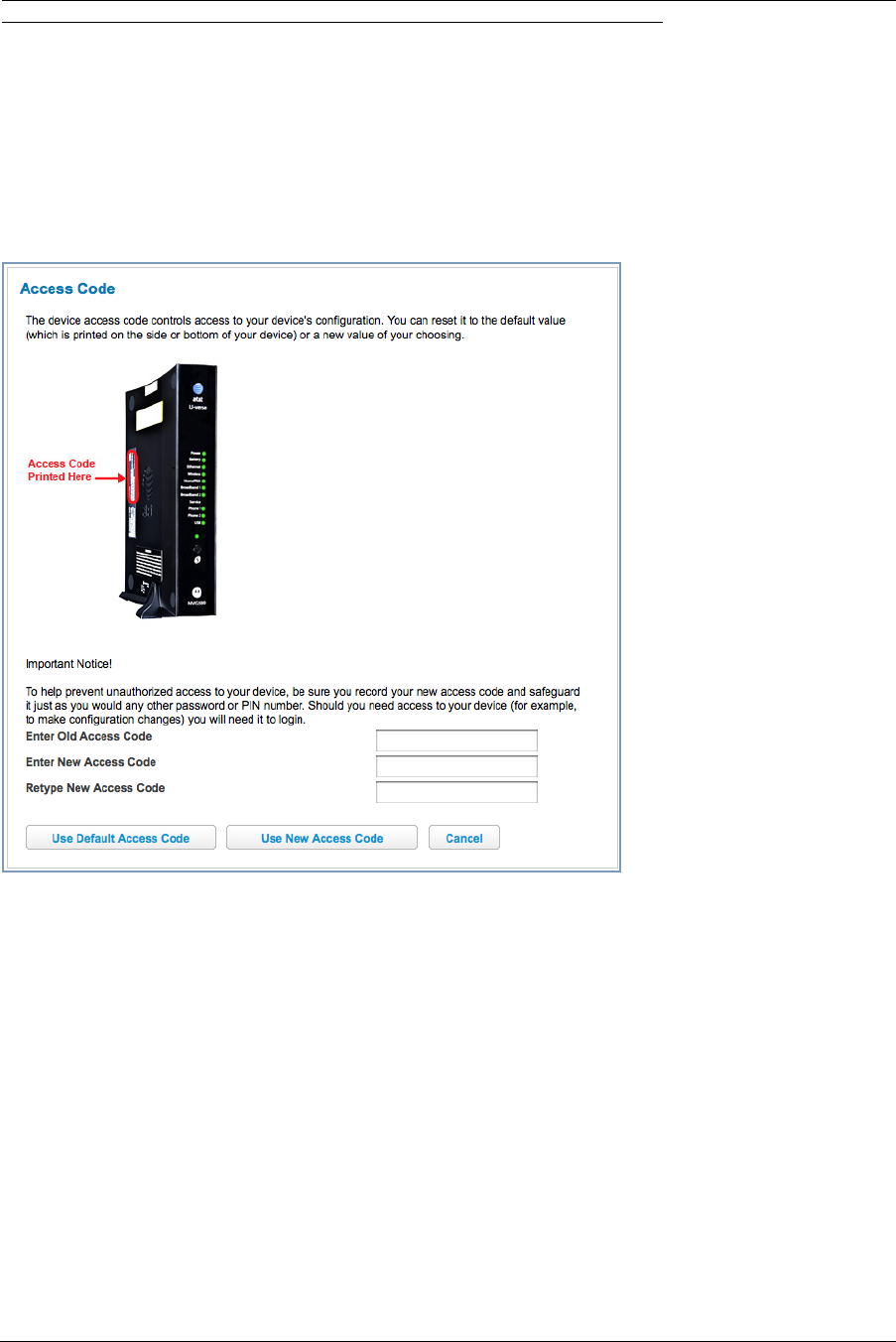
35
Link: Access Code
Access to your Gateway is controlled through an account named Admin. The default Admin password for your
Gateway is the unique Access Code printed on the label on the side of your Gateway.
As the Admin, you can change this password to a different one of your own choosing between 8 and 20 characters
long. The new password must also include two characters from any these categories: alpha, number, and special
characters.
Example: “fru1tfl13s_likeabanana”
Enter your Old Access Code, your New Access Code, and click the Use New Access Code button. The new
Access Code takes effect immediately.
You can always return to the original default password by clicking the Use Default Access Code button.
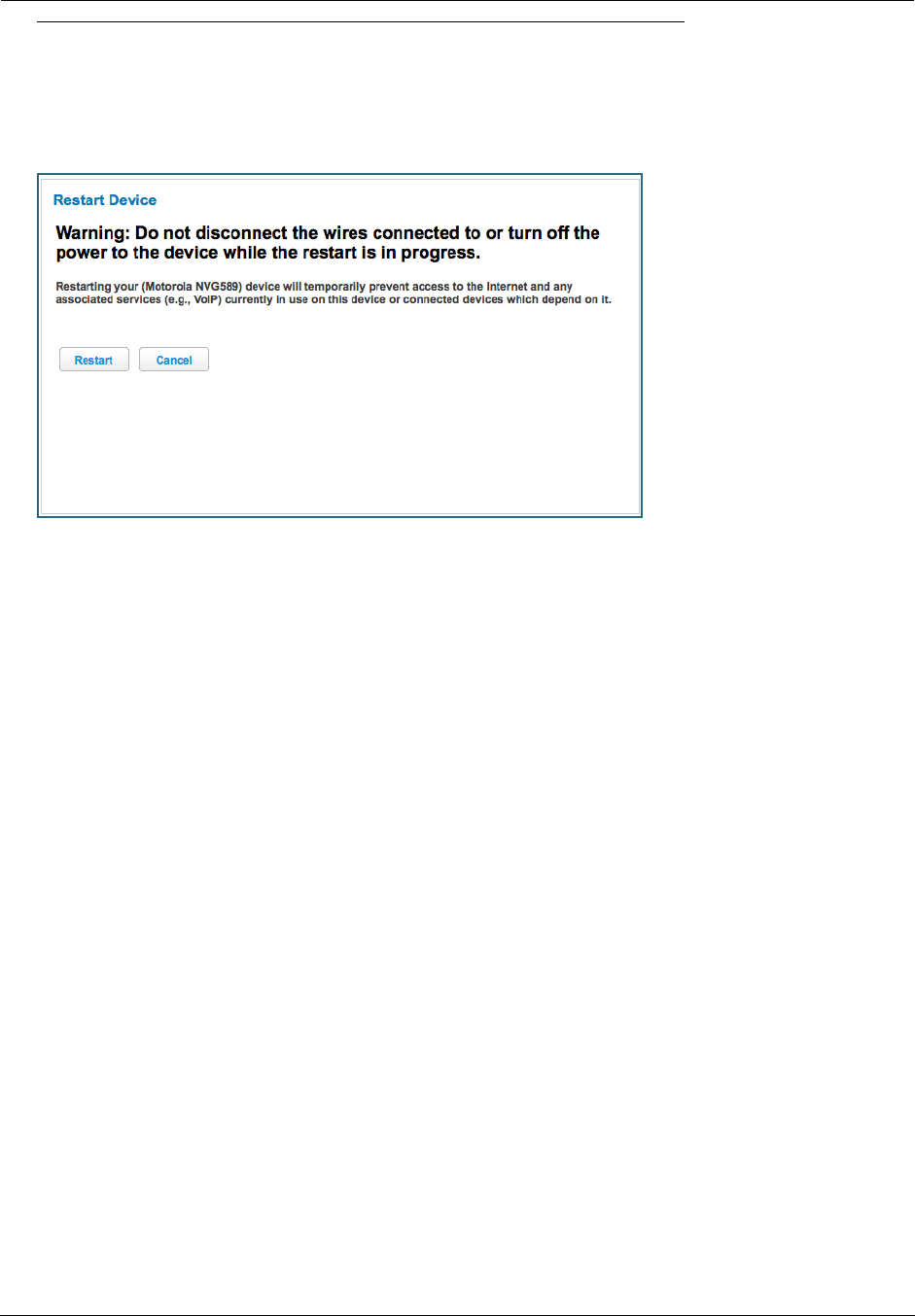
Administrator’s Handbook
36
Link: Restart Device
When the Gateway is restarted, it will disconnect all users, initialize all its interfaces, and load the Operating Sys-
tem Software.
When you make configuration changes, you may be required restart for the changes to take effect.
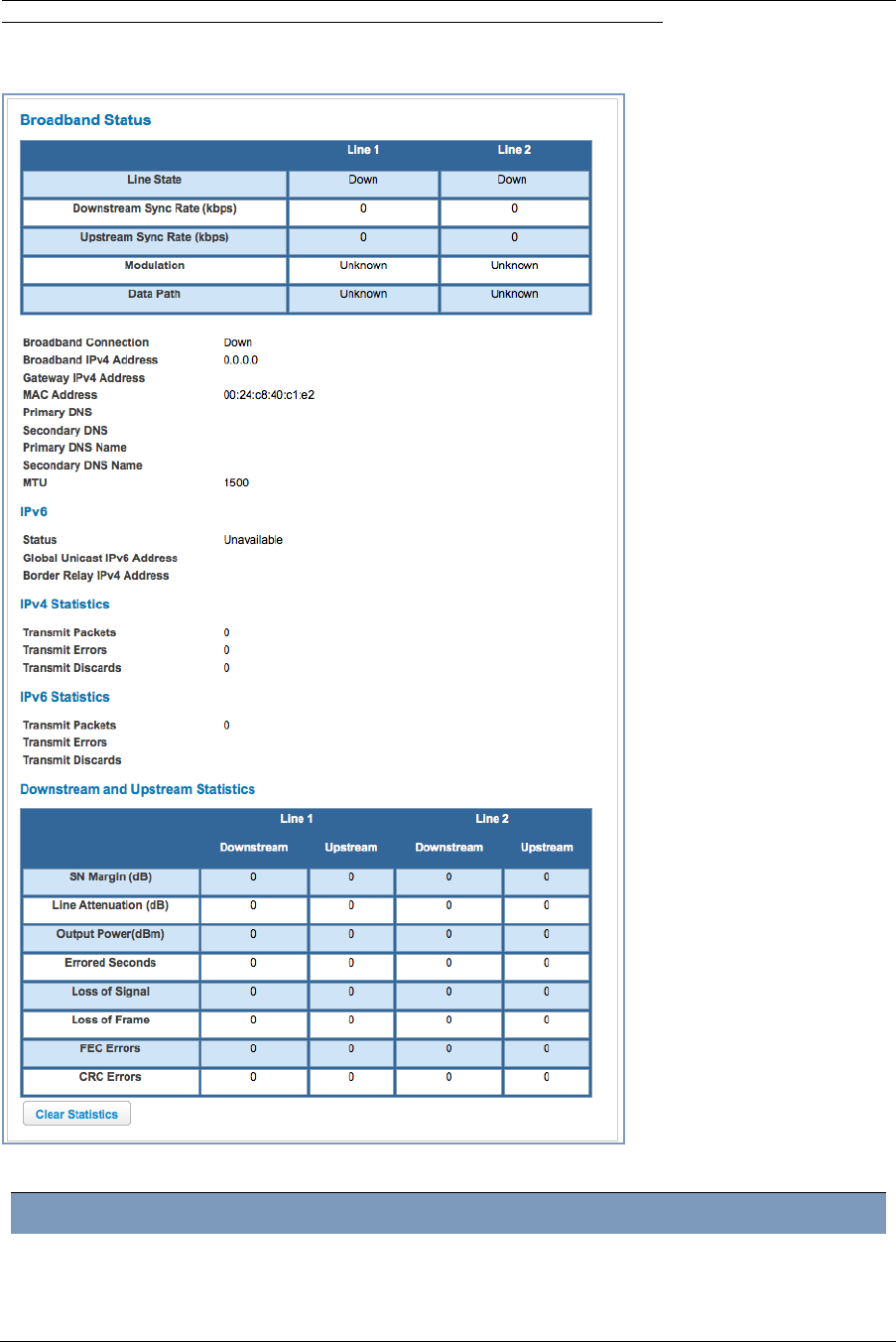
37
Broadband
When you click the Broadband tab, the Broadband Status page appears.
The Broadband Status page displays information about the Gateway’s WAN connection(s) to the Internet.
Broadband Status
Line State May be Up (connected) or Down (disconnected).
Broadband Connection May be Up (connected) or Down (disconnected).

Administrator’s Handbook
38
Downstream Sync Rate This is the rate at which your connection can download (receive) data on your
DSL line, in kilobits per second.
Upstream Sync Rate This is the rate at which your connection can upload (send) data on your DSL
line, in kilobits per second.
Modulation Method of regulating the DSL signal. DMT (Discrete MultiTone) allows connec-
tions to work better when certain radio transmitters are present.
Data Path Type of path used by the device's processor.
Broadband IPv4 Address The public IP address of your device, whether dynamically or statically
assigned.
Gateway IPv4 Address Your ISP's gateway router IP address.
MAC Address Your Gateway’s unique hardware address identifier.
Primary DNS The IP Address of the Primary Domain Name Server.
Secondary DNS The IP Address of the backup Domain Name Server, if available.
Primary DNS Name The name of the Primary Domain Name Server.
Secondary DNS Name The name of the backup Domain Name Server, if available.
MTU Maximum Transmittable Unit before packets are broken into multiple packets.
IPv6
Status May be Enabled or Unavailable.
Global Unicast IPv6
Address
The public IPv6 address of your device, whether dynamically or statically
assigned.
Border Relay IPv4
Address
The public IPv4 address of your device.
IPv4 Statistics
Transmit Packets IPv4 packets transmitted.
Transmit Errors Errors on IPv4 packets transmitted.
Transmit Discards IPv4 packets dropped.
IPv6 Statistics
Transmit Packets IPv6 packets transmitted.
Transmit Errors Errors on IPv6 packets transmitted.
Transmit Discards IPv6 packets dropped.
Downstream and Upstream Statistics
SN Margin (db) Signal to noise margin, in decibels. Reflects the amount of unwanted “noise”
on the DSL line.
Line Attenuation Amount of reduction in signal strength on the DSL line, in decibels.
Output Power (dBm) Measure of power output in decibels (dB) referenced to one milliwatt (mW).
Errored Seconds The number of uncorrected seconds after being down for seven consecutive
seconds.
Loss of Signal The absence of any signal for any reason, such as a disconnected cable or
loss of power.
Loss of Frame A signal is detected but cannot sync with signal caused by mismatched proto-
cols, wrong ISP connection configuration, or faulty cable.
FEC Errors (Forwarded Error Correction errors) Count of received errored packets that
were fixed successfully with out a retry.
CRC Errors Number of times data packets have had to be resent due to errors in transmis-
sion or reception.
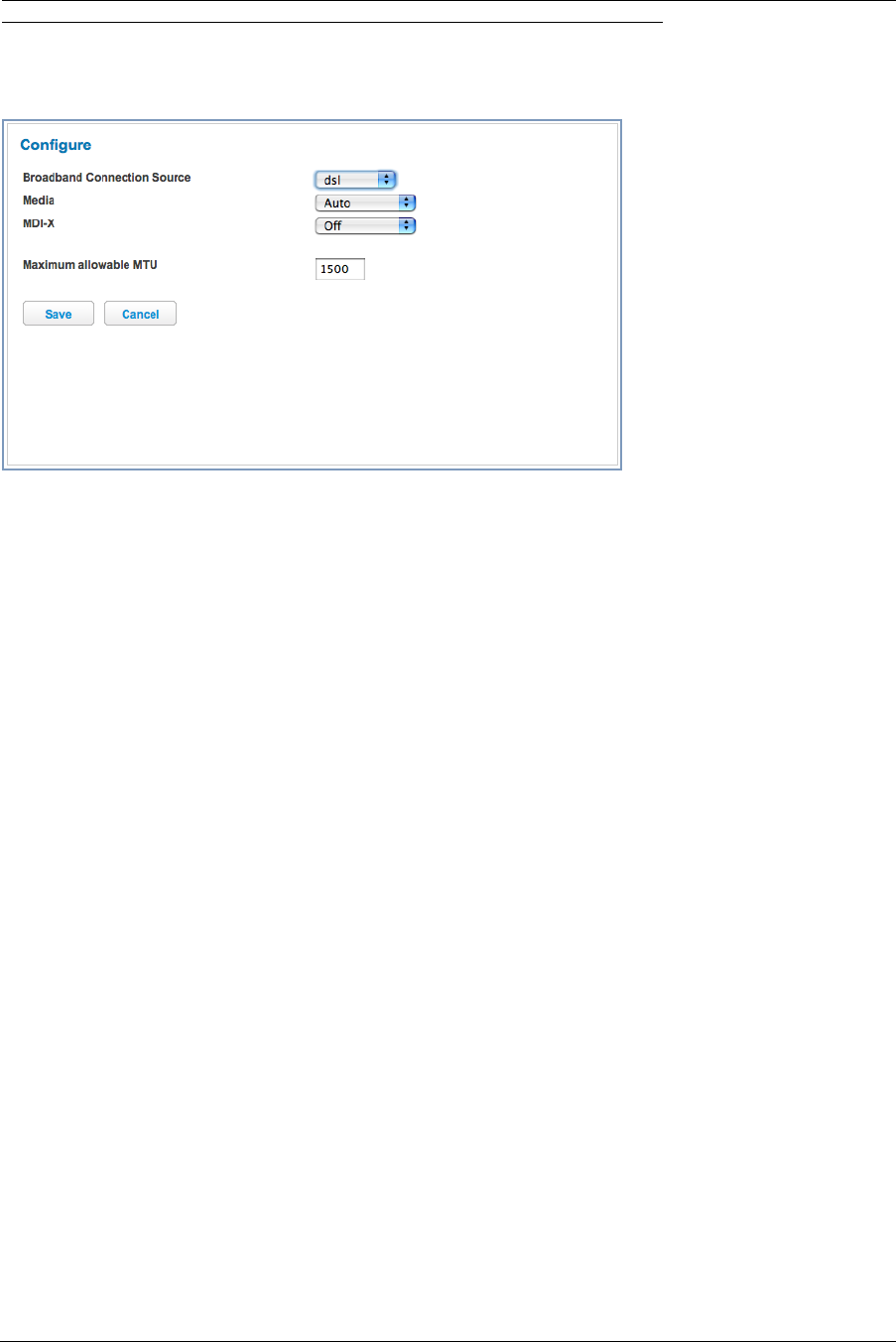
39
Link: Configure
When you click the Configure link, the Broadband Configure screen appears. Here you can reconfigure your
type of broaband connection should it change in the future.
◆Broadband Connection Source - dsl, ethernet, or auto (automatically detected).
◆Media – Auto (the default self-sensing rate), 10M full- or half-duplex, 100M full- or half-duplex, or 1G full- or
half-duplex.
◆MDI-X – Auto (the default self-sensing crossover setting), Off, or On.
◆The WAN connection is automatically configured. However, you can adjust the Maximum allowable MTU
(Maximum Transmittable Unit) value, if your service provider suggests it. The default 1500 is the maximum
value, but some services require other values. 1492 is common.
If you make any change here, click the Save button.
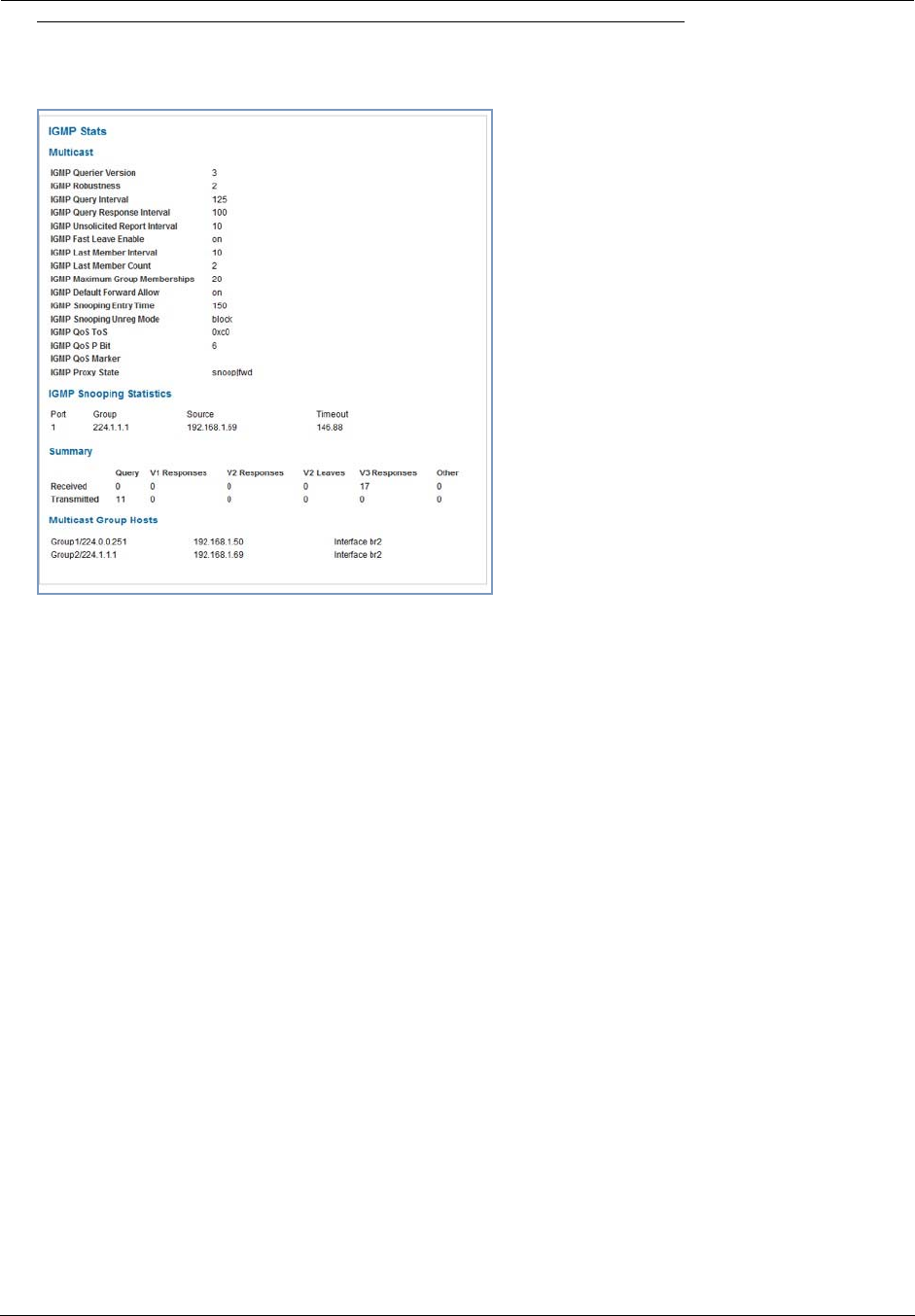
Administrator’s Handbook
40
Link: IGMP Stats
When you click the IGMP Stats link, the IGMP Stats screen appears.
The IGMP Statistics screen reports IGMP Proxy Groups and Multicast Forwarding information. It also displays a
packet counter.
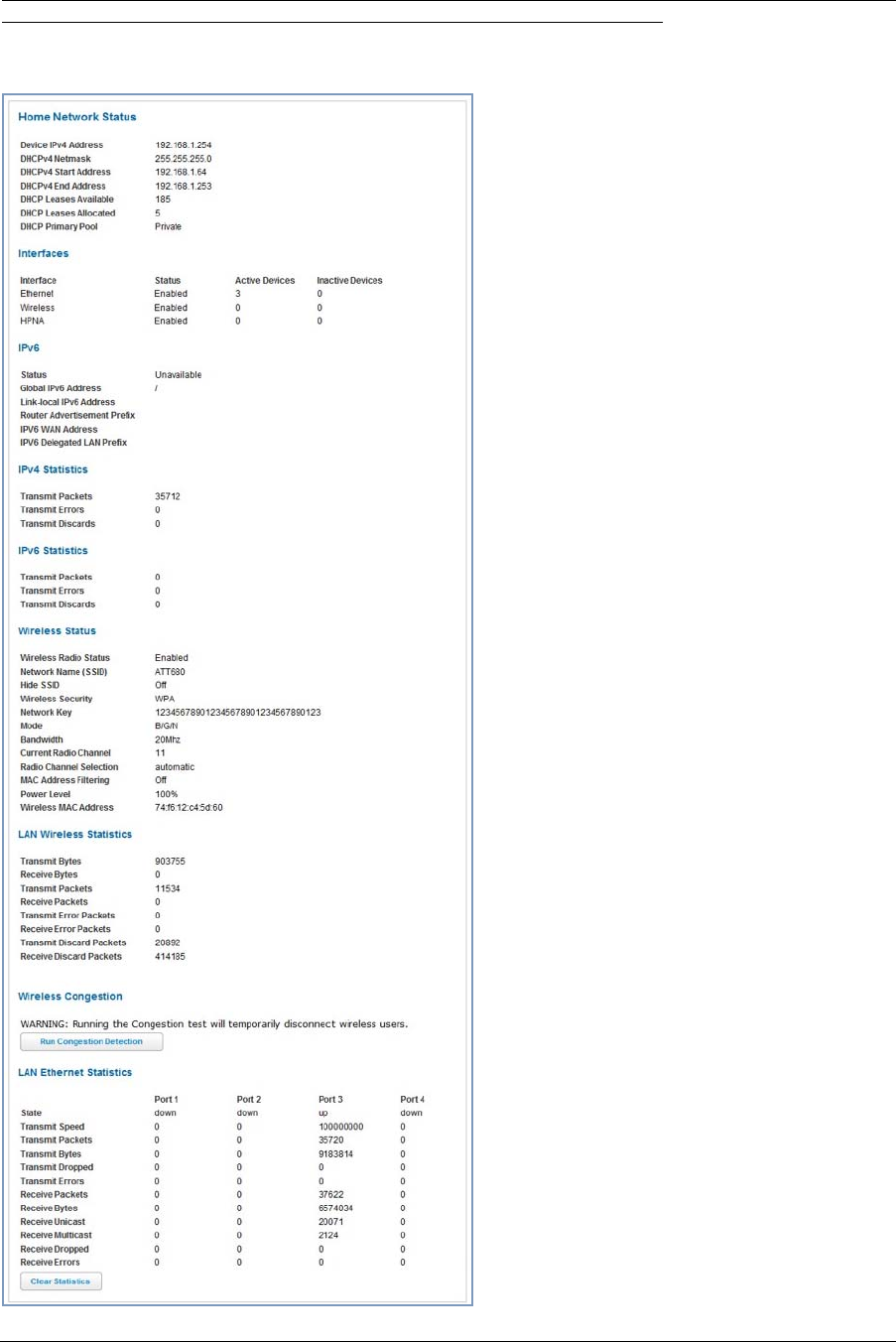
41
Home Network
When you click the Home Network tab, the Home Network Status page appears.
The Home Network Status page displays informa-
tion about the Gateway’s local area network.
If you click the Run Congestion Detection but-
ton, the device will generate statistics for each of the
11 channels available, displaying:
◆Channel number
◆AP Count
◆Congestion Score (1 - 10)
You can clear the current statistics information by
clicking the Clear Statistics button.

Administrator’s Handbook
42
Home Network Status
Device IPv4 Address The Gateway’s own IP address on the network.
DHCP Netmask The Gateway’s own netmask on the network.
DHCPv4 Start Address The starting IP address of the DHCP range served by the Gateway.
DHCPv4 End Address The ending IP address of the DHCP range served by the Gateway.
DHCP Leases Available The number of IP addresses of the DHCP range available to be served by the
Gateway.
DHCP Leases Allocated The number of IP addresses of the DHCP range currently being served by the
Gateway.
DHCP Primary Pool Source pool of the IP addresses served by the Gateway, Public or Private.
IPv6
Status May be Enabled or Unavailable.
Global IPv6 Address The public IPv6 address of your device, whether dynamically or statically
assigned.
Link-local IPv6 Address The private IPv6 address of your device, whether dynamically or statically
assigned.
Router Advertisement
Prefix
The IPv6 prefix to include in router advertisements.
IPv4 Statistics
Transmit Packets IPv4 packets transmitted.
Transmit Errors Errors on IPv4 packets transmitted.
Transmit Discards IPv4 packets dropped.
IPv6 Statistics
Transmit Packets IPv6 packets transmitted.
Transmit Errors Errors on IPv6 packets transmitted.
Transmit Discards IPv6 packets dropped.
Wireless Status
Wireless Radio Status Indicates whether the Wi-Fi radio is Enabled or Disabled.
Network Name (SSID) This is the name or ID that is displayed to a client scan. The default SSID for
the Gateway is attxxx where xxx is the last 3 digits of the serial number
located on the side of the Gateway.
Hide SSID May be either On or Off. If On, your SSID will not appear in a client scan.
Wireless Security The type of wireless encryption security in use. May be Disabled, WPA or
WEP, Default Key or Manual.
Network Key Shows the information of the security encryption key in use.
Mode May be 802.11B only, 802.11G only, 802.11N, or 802.11 B/G/N.
Bandwidth The capacity of the wireless LAN to carry traffic in megahertz.
Current Radio Channel The radio channel that your Wi-Fi network is broadcasting on.
Radio Channel Selection May be set to automatic or manually selected.
MAC Address Filtering May be either On or Off. If On, you can accept or block client devices from
your WLAN based on their MAC address.
Power Level May be adjusted up to 100%, lower if multiple wireless access points are in
use, and might interfere with each other.
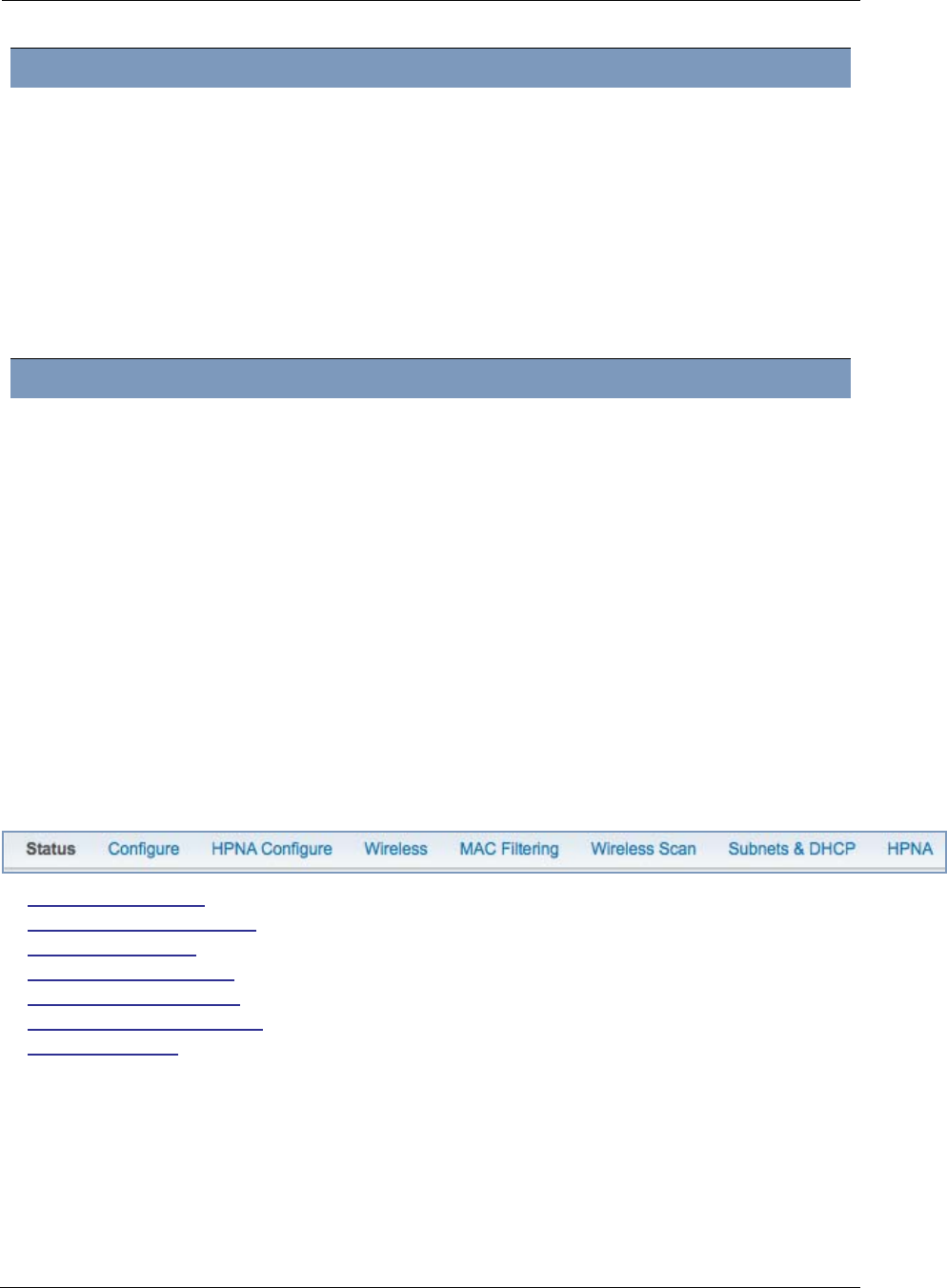
43
The links at the top of the Home Network page access a series of pages to allow you to configure and
monitor features of your device. The following sections give brief descriptions of these pages.
◆“Configure” on page 44
◆“HPNA Configure” on page 45
◆“Wireless” on page 46
◆“MAC Filtering” on page 50
◆“Wireless Scan” on page 51
◆“Subnets & DHCP” on page 52
◆“HPNA” on page 54
Wireless MAC Address Shows the information of the MAC address of the wireless subsystem.
LAN Wireless Statistics
Transmit Bytes Number of bytes transmitted on the Wi-Fi network.
Receive Bytes Number of bytes received on the Wi-Fi network.
Transmit Packets Number of packets transmitted on the Wi-Fi network.
Receive Packets Number of packets received on the Wi-Fi network.
Transmit Error Packets This is the number of errors on packets transmitted on the Wi-Fi network.
Receive Error Packets This is the number of errors on packets received on the Wi-Fi network.
Transmit Discard Packets This is the number of packets transmitted on the Wi-Fi network that were
dropped.
Receive Discard Packets This is the number of packets received on the Wi-Fi network that were
dropped.
LAN Ethernet Statistics
State up or down
Transmit Speed This is the maximum speed of which the port is capable.
Transmit Packets This is the number of packets sent out from the port.
Transmit Bytes This is the number of bytes sent out from the port.
Transmit Dropped This is the number of packets sent out from the port that were dropped.
Transmit Errors This is the number of errors on packets sent out from the port.
Receive Packets This is the number of packets received on the port.
Receive Bytes This is the number of bytes received on the port.
Receive Unicast This is the number of unicast packets received on the port.
Receive Multicast This is the number of multicast packets received on the port.
Receive Dropped This is the number of packets received on the port that were dropped.
Receive Errors This is the number of errors on packets received on the port.
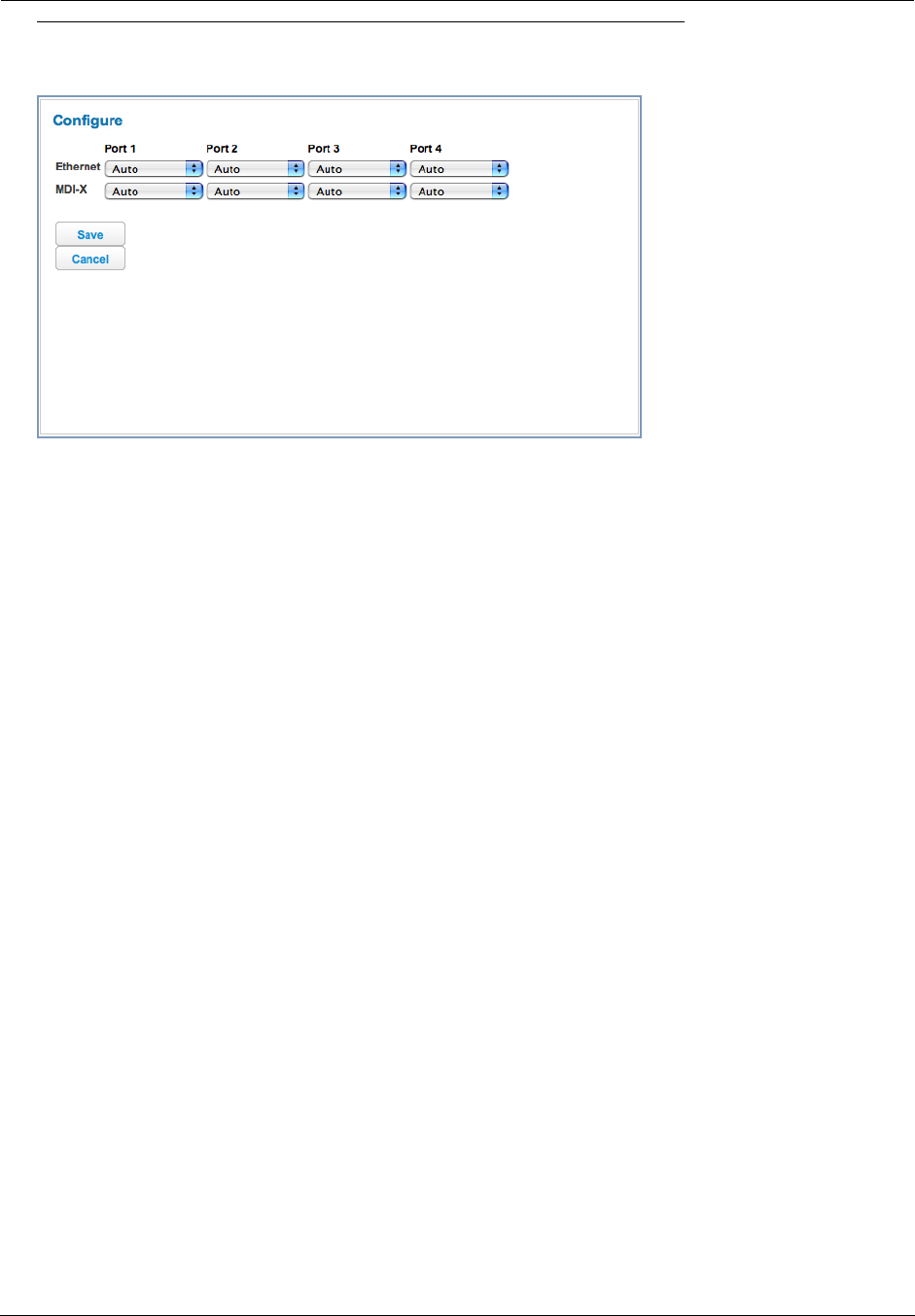
Administrator’s Handbook
44
Link: Configure
When you click the Configure link, the Configure page for the Ethernet LAN appears.
For each Ethernet Port, 1 through 4, you can select:
◆Ethernet – Auto (the default self-sensing rate), 10M full- or half-duplex, 100M full- or half-duplex, or 1G full- or
half-duplex.
◆MDI-X – Auto (the default self-sensing crossover setting), off, or on.
Click the Save button.
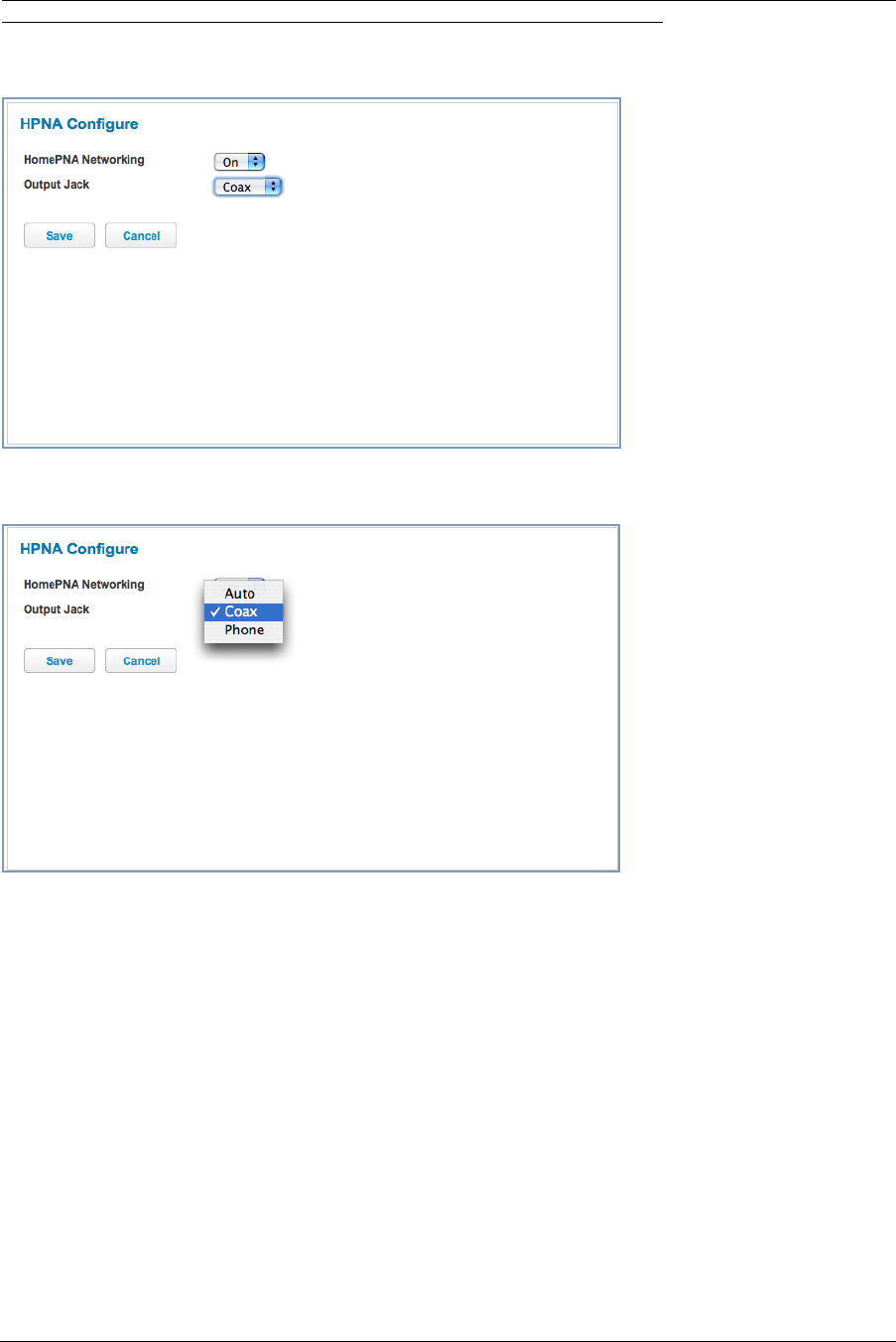
45
Link: HPNA Configure
When you click the HPNA Configure link, the HPNA Configure page for the HomePNA network appears.
Here you can turn HomePNA Networking On or Off.
If desired, you can choose the Output Jack, either the Coax jack or the Phone jack, or let the device Auto sense
it automatically.
Click the Save button.
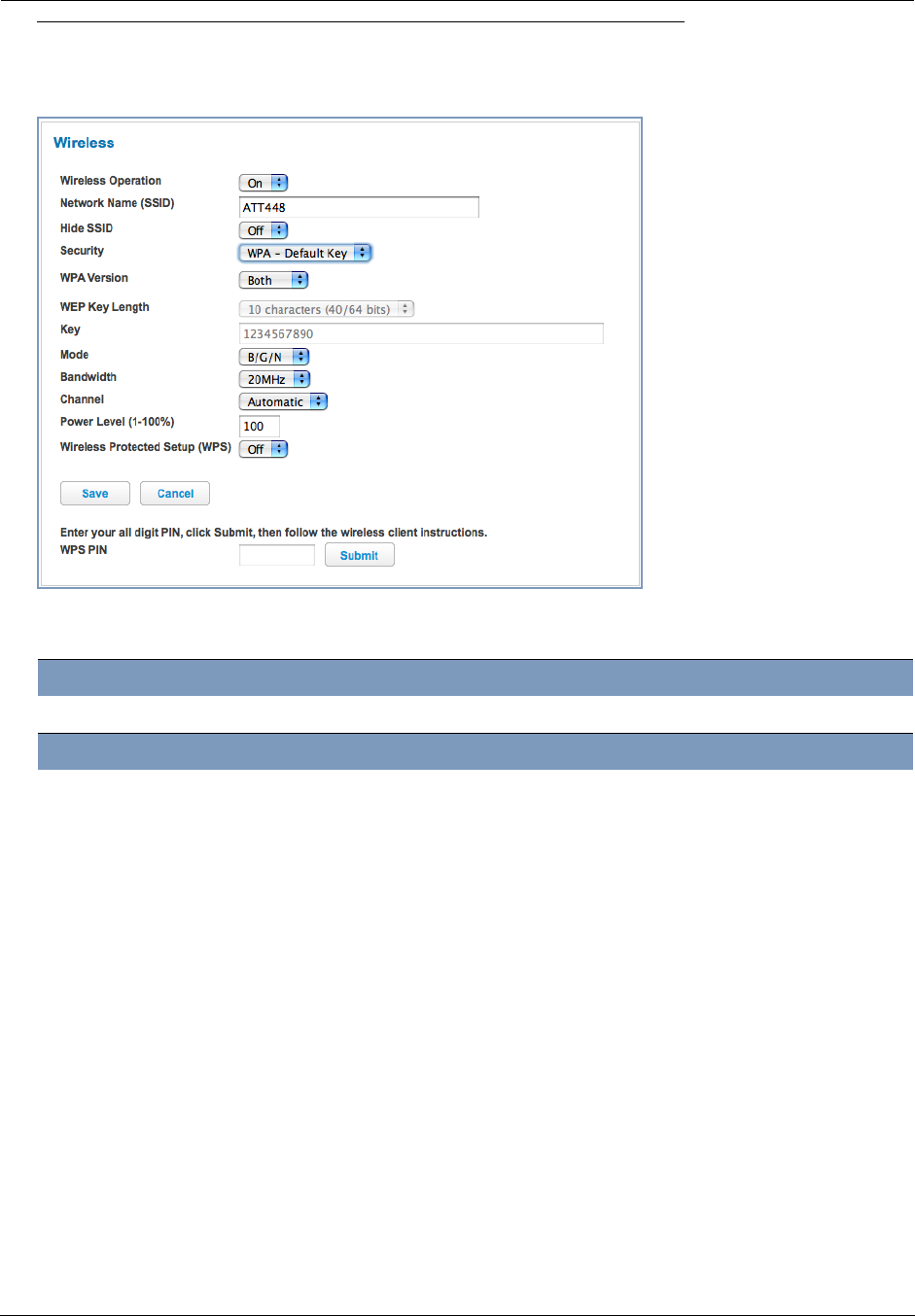
Administrator’s Handbook
46
Link: Wireless
When you click the Wireless link the Wireless page appears. The Wireless page displays the status of your
Wireless LAN elements.
The Wireless page’s center section contains a summary of the Wireless Access Point’s configuration
settings and operational status.
◆The Wireless Operation function is automatically enabled by default. If you uncheck the checkbox, the Wire-
less Options are disabled, and the Wireless Access Point will not provide or broadcast its wireless LAN ser-
vices.
Summary Information
Field Status and/or Description
General Information
Wireless Operation May be either
On
or
Off.
Network Name (SSID) This is the name or ID that is displayed to a client scan. The default SSID for the
Gateway is
attxxx
where
xxx
is the last 3 digits of the serial number located on
the side of the gateway.
Hide SSID May be either
Off
or
On
. If On, your SSID will not appear in a client scan.
Security The type of wireless encryption security in use. May be
OFF-No Privacy
,
WPA-
PSK
or
WEP
,
Default
Key
or
Manual
.
WPA Version If WPA is selected, may be Both, WPA-1, or WPA-2,.
WEP Key Length May be 10 characters for 40/64-bit, or 26 characters for 128-bit WP encryption.
Key Here you can enter a manual encryption key.
Mode May be 802.11B only, 802.11G only, 802.11N, or 802.11 B/G/N.
Bandwidth The capacity of the wireless LAN to carry traffic in megahertz, 20 or 40.
Channel The radio channel that your Wi-Fi network is broadcasting on.
Power Level May be adjusted up to 100%, lower if multiple wireless access points are in use,
and might interfere with each other.
Wireless Protected Setup
(WPS)
May be either
On
or
Off.

47
◆Network Name (SSID) – preset to a number unique to your unit. You can either leave it as is, or change it by
entering a freeform name of up to 32 characters, for example “Hercule’s Wireless LAN”. On client PCs’ soft-
ware, this might also be called the Network Name. The Wireless ID is used to identify this particular wireless
LAN. Depending on their operating system or client wireless card, users must either:
• select from a list of available wireless LANs that appear in a scanned list on their client
• or enter this name on their clients in order to join this wireless LAN.
◆Hide SSID – If enabled, this mode hides the wireless network from the scanning features of wireless client
computers. Unless both the wireless clients and the Gateway share the same Network Name (SSID) in hidden
mode, the Gateway’s wireless LAN will not appear as an available network when scanned for by wireless-
enabled computers. Members of the hidden WLAN must log onto the Gateway’s wireless network with the
identical SSID as that configured in the Gateway.
Closed System mode is an ideal way to increase wireless security and to prevent casual detection by
unwanted neighbors, office users, or malicious users such as hackers. If you do not enable Hide SSID, it is
more convenient, but potentially less secure, for clients to access your WLAN by scanning available
access points. You must decide based on your own network requirements.
◆Security, WPA Version, WEP Key Length, Key – see “Wireless Security” on page 48.
◆Mode – The pull-down menu allows you to select and lock the Gateway into the wireless transmission mode
you want: B/G/N, B-only, B/G, G-only, or N-only.
For compatibility with clients using 802.11b (up to 11 Mbps transmission), 802.11g (up to 20+ Mbps), 802.11a
(up to 54 Mbit/s using the 5 GHz band), or 802.11n (from 54 Mbit/s to 600 Mbit/s with the use of four spatial
streams at a channel width of 40 MHz), select B/G/N. To limit your wireless LAN to one mode or the other,
select G-only, N-only, or B-only, or some combination that applies to your setup.
☛ NOTE:
If you choose to limit the operating mode to 802.11b or 802.11g only, clients using the mode you
excluded will not be able to connect.
◆Bandwidth – May only be selected if mode is some combination of 802.11n (from 54 Mbit/s to 600 Mbit/s
with the use of four spatial streams at a channel width of 40 MHz). Measure of the width of a range of frequen-
cies, in megahertz.
◆Channel (1 through 11, for North America) on which the network will broadcast. This is a frequency range
within the 2.4Ghz band. Channel selection depends on government regulated radio frequencies that vary from
region to region. Channel selection can have a significant impact on performance, depending on other wireless
activity close to this Wireless Access Point. You need not select a channel at any of the computers on your
wireless network. They will automatically scan available channels seeking a Gateway broadcasting on the
SSID for which they are configured.
The Automatic setting allows the Wireless Access Point to determine the best channel to broadcast automati-
cally.
◆Power Level – Sets the wireless transmit power, scaling down the Wireless Access Point’s wireless transmit
coverage by lowering its radio power output. Default is 100% power. Transmit power settings are useful in
large venues with multiple wireless routers where you want to reuse channels. Since there are only three non-
overlapping channels in the 802.11 spectrum, it helps to size the Wireless Access Point’s cell to match the
location. This allows you to install a router to cover a small “hole” without conflicting with other routers nearby.
◆Wireless Protected Setup (WPS) is a not a new security protocol. It is simply an easier way to use existing
protocols to provide greater security for your wireless network connections.
By default, Privacy is set to Wireless Protected Access (WPA-PSK). WPS allows you to automatically
generate a new strong WPA key for your Gateway and any client devices on your wireless network.
Not all client wireless devices support WPS. Refer to their documentation.
Enter your all digit WPS PIN and click the Submit button.
Follow the instructions that came with your wireless client.
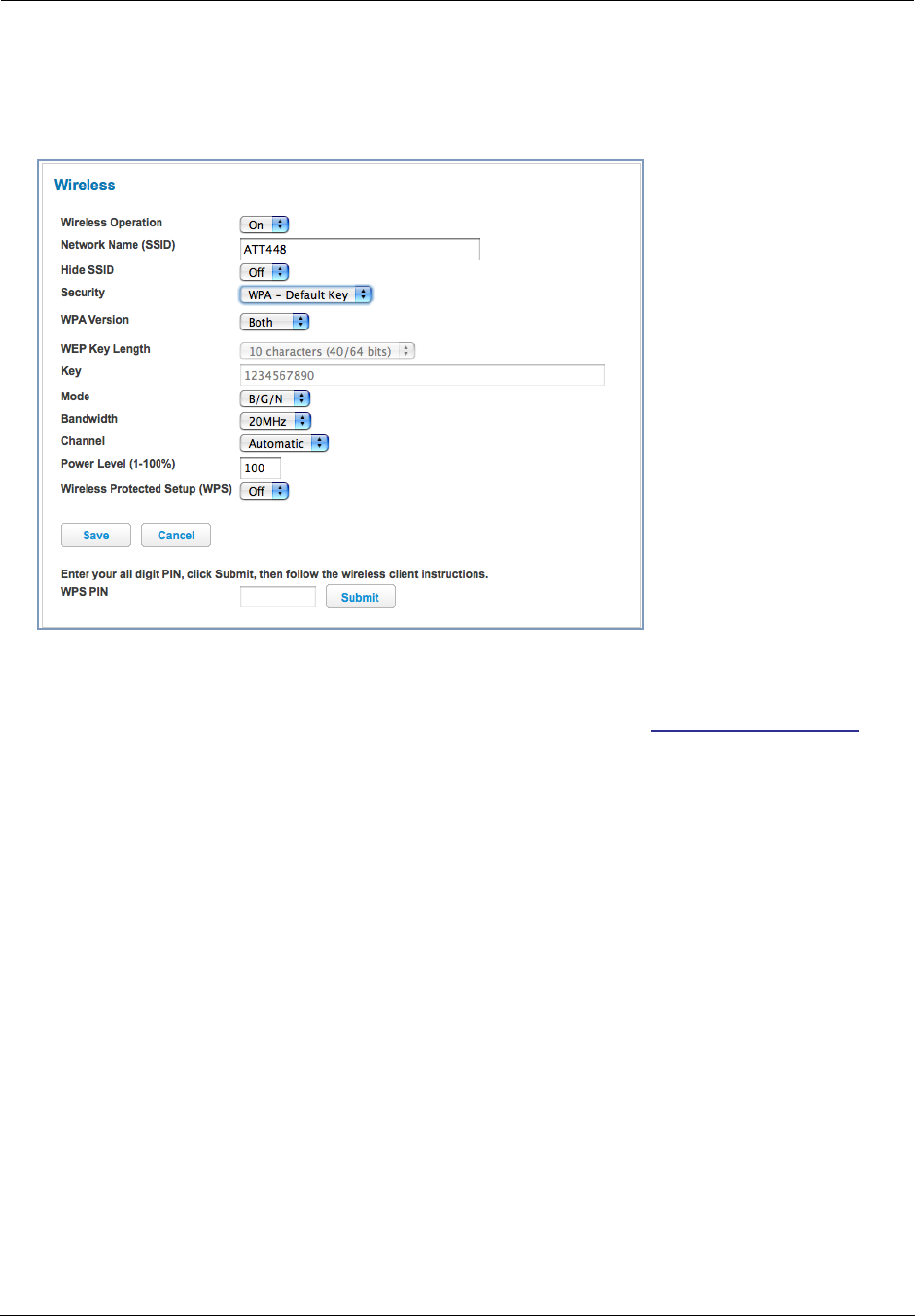
Administrator’s Handbook
48
Wireless Security
By default, Wireless Security is set to
WPA-PSK
with a pre-defined WPA-Default Key (Wireless Protected Access
Pre-Shared Key).
Other options are available from the Security pull-down menu:
◆WEP - Manual: WEP Security is a Privacy option that is based on encryption between the Router and any PCs
(“clients”) you have with wireless cards. If you are not using WPA-PSK Privacy, you can use WEP encryption
instead. For this encryption to work, both your Wireless Access Point and each client must share the same
Wireless ID (SSID), and both must be using the same encryption keys. See “WEP-Manual” on page 48.
◆WPA-PSK: allows you to enter your own key, the most secure option for your wireless network. The key can
be between 8 and 63 characters, but for best security it should be at least 20 characters.
If you select WPA-PSK as your privacy setting, the WPA Version pull-down menu allows you to select the WPA
version(s) that will be required for client connections. Choices are:
Both, for maximum interoperability,
WPA-1, for backward compatibility,
WPA-2, for maximum security.
All clients must support the version(s) selected in order to successfully connect.
Be sure that your Wi-Fi client adapter supports this option. Not all Wi-Fi clients support WPA-PSK.
◆OFF - No Privacy: This mode disables privacy on your network, allowing any wireless users to connect to your
wireless LAN. Use this option if you are using alternative security measures such as VPN tunnels, or if your
network is for public use.
Click the Save button.
WEP-Manual
You can provide a level of data security by enabling WEP (Wired Equivalent Privacy) for encryption of net-
work data. You can enable 40- or 128-bit WEP Encr yption (depending on the capability of your client
wireless card) for IP traffic on your LAN.
WEP - Manual allows you to enter your own encryption keys manually. This is a difficult process, but
only needs to be done once. Avoid the temptation to enter all the same characters.

49
Key Length: The pull-down menu selects the length of each encryption key. The longer the key, the
stronger the encryption and the more difficult it is to break the encryption.
Key: You enter a key using hexadecimal digits. For 40/64-bit encryption, you need ten digits; 26 digits
for 128-bit WEP. Hexadecimal characters are 0 – 9, and a – f.
Examples:
◆ 40 bits: 02468ACE02
◆ 128 bits: 0123456789ABCDEF0123456789
Any WEP-enabled client must have an identical key of the same length as the Router, in order to suc-
cessfully receive and decrypt the traffic. Similarly, the client also has a ‘default’ key that it uses to
encrypt its transmissions. In order for the Router to receive the client’s data, it must likewise have the
identical key of the same length.
Click the click Save button.
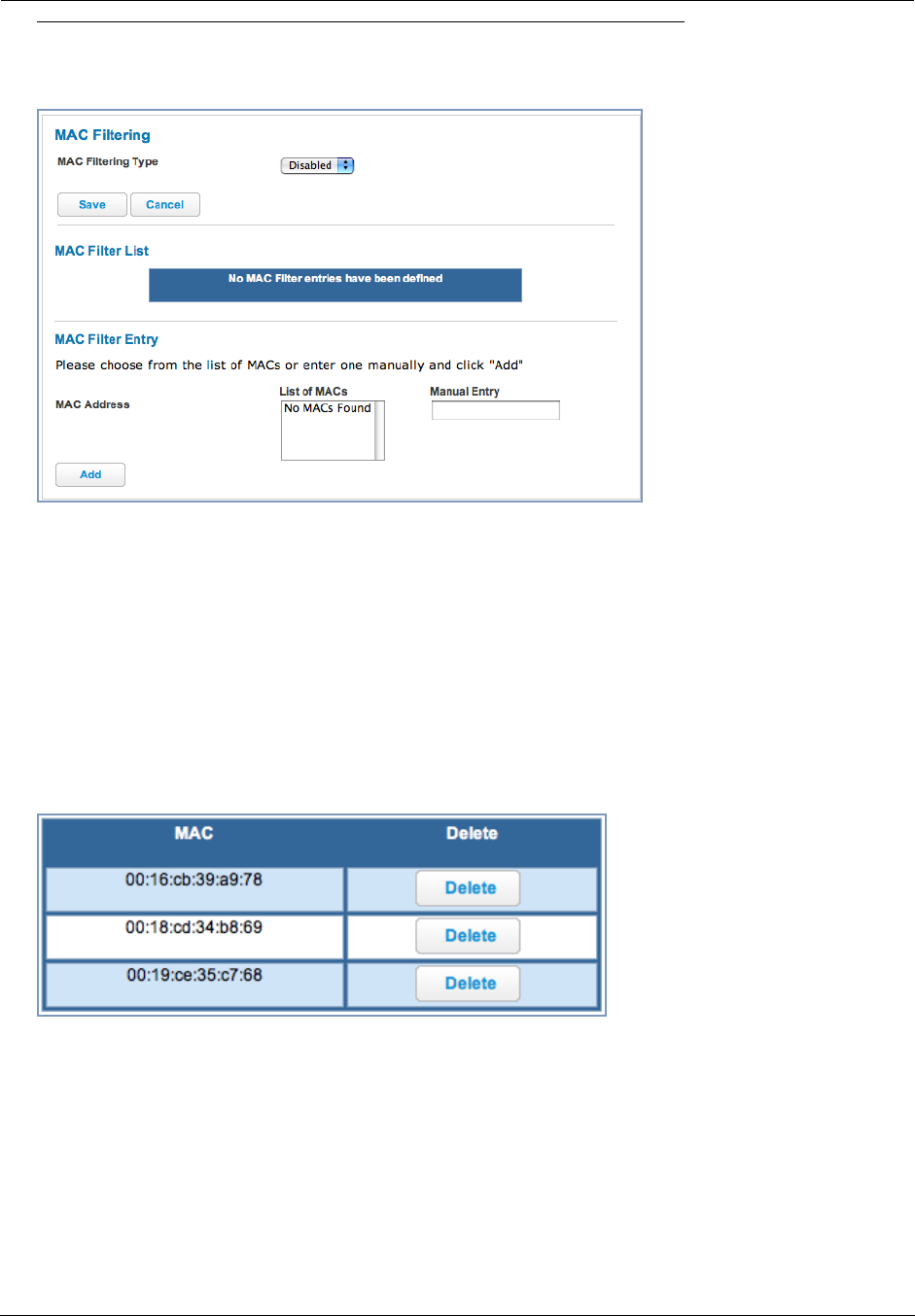
Administrator’s Handbook
50
Link: MAC Filtering
When you click the MAC Filtering link the MAC Filtering page appears.
MAC Filtering allows you to specify which client PCs are allowed to join the wireless LAN by unique hardware
(MAC) address.
◆To enable this feature, select Blacklist or Whitelist from the MAC Filtering Type menu. Blacklist means that
only MAC addresses you specify will be denied access; Whitelist means that only MAC addresses you specify
will be allowed access.
◆You add wireless clients that you want to Whitelist or Blacklist for your wireless LAN by selecting them from the
List of MACs or by entering the MAC addresses in the Manual Entry field provided.
◆Click the Add button.
Your entries will be added to a list of clients that will be either authorized (Whitelisted) or disallowed
(Blacklisted) depending on your selection.
◆Click the Save button.
You can Add or Delete any of your entries later by returning to this page.
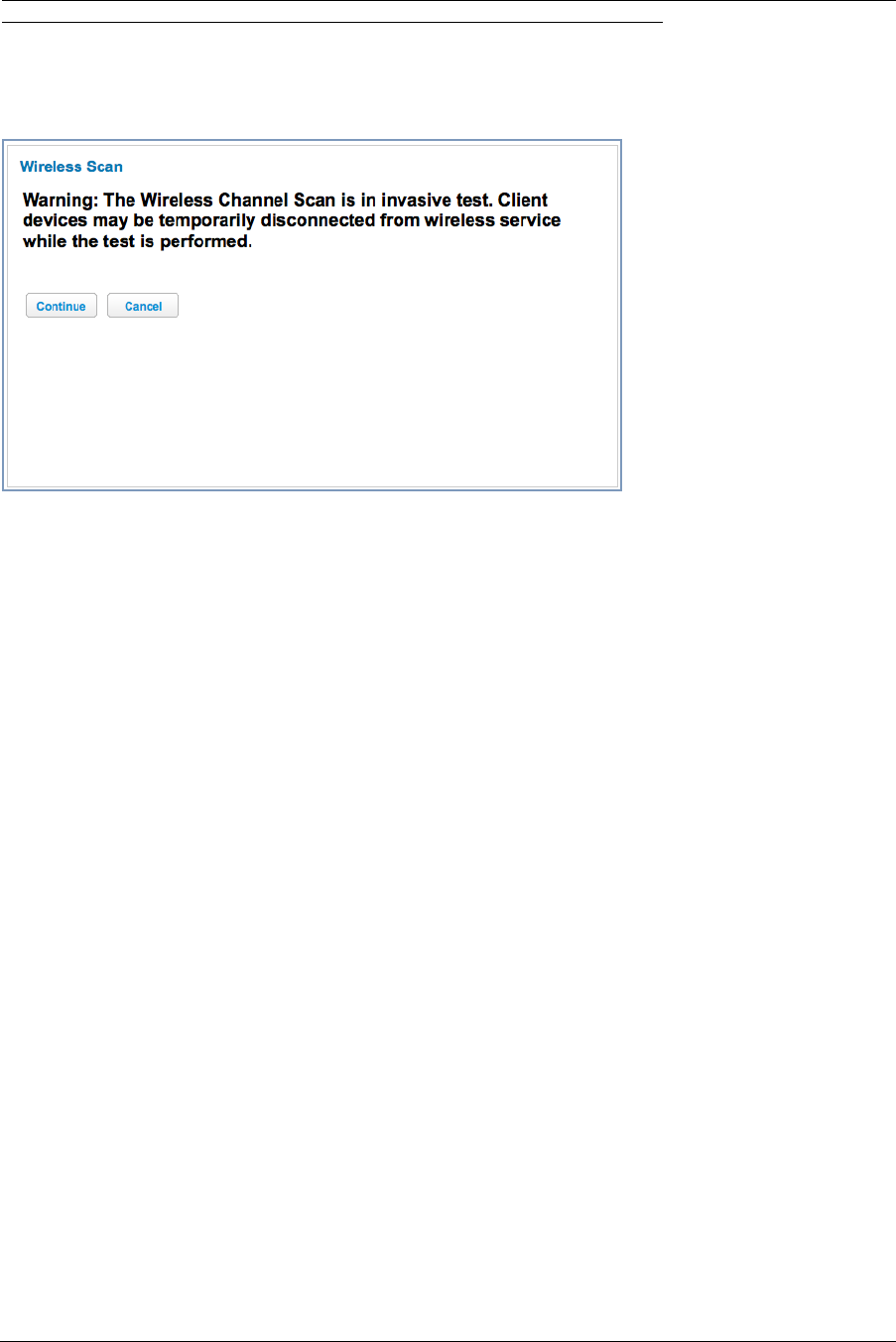
51
Link: Wireless Scan
Your device automatically checks for the best channel to broadcast wireless services. However, in some cases it
may be useful to switch to a different channel (1 through 11, for North America) on which the network will broad-
cast.
This is a frequency range within the 2.4Ghz band. Channel selection depends on government regulated radio fre-
quencies that vary from region to region. Channel selection can have a significant impact on performance,
depending on other wireless activity close to this device. You need not select a channel at any of the computers on
your wireless network. They will automatically scan available channels seeking a wireless device broadcasting on
the SSID for which they are configured.
This scan will disconnect any wireless client devices from the wireless network.
If you want to scan for a different channel on which the device will broadcast, click the Continue button.
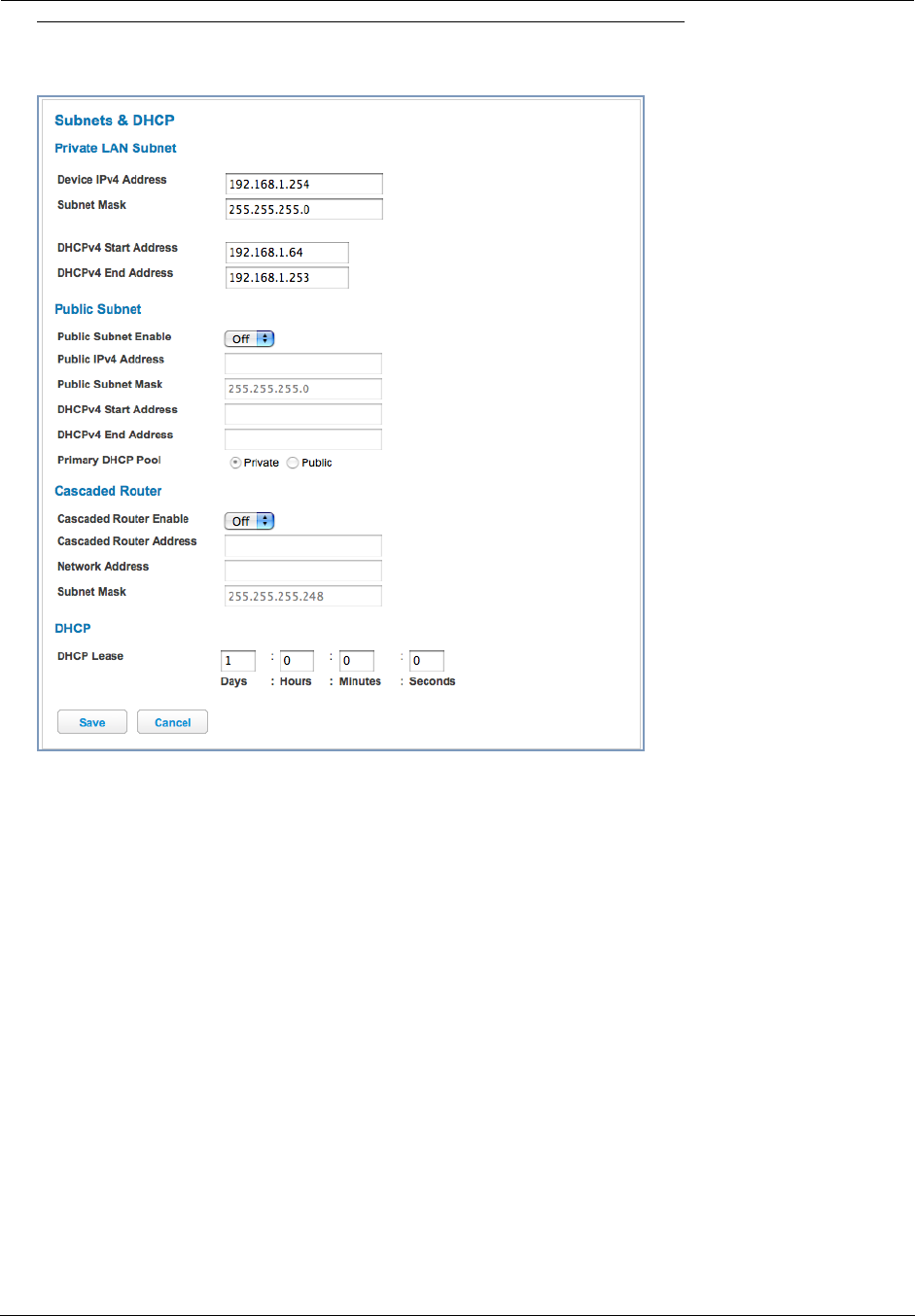
Administrator’s Handbook
52
Link: Subnets & DHCP
When you click the Subnets & DHCP link, the Subnets & DHCP page appears.
The Server configuration determines the functionality of your DHCP Settings. This functionality enables the Gate-
way to assign your LAN computer(s) a “private” IP address and other parameters that allow network communica-
tion. This feature simplifies network administration because the Gateway maintains a list of IP address
assignments. Additional computers can be added to your LAN without the hassle of configuring an IP address.
This is the default mode for your Gateway.
Private LAN Subnet
◆Device IPv4 Address: The IP address of your Gateway as seen from the LAN
◆Subnet Mask: Subnet mask of your LAN
◆DHCPv4 Start Address: First IP address in the range being served to your LAN by the Gateway's DHCP
server
◆DHCPv4 End Address: Last IP address in the range being served to your LAN by the Gateway's DHCP
server
Public Subnet
◆Public Subnet Enable: If you select On from the pull-down menu, you can enable a second subnet to distrib-
ute public addresses to DHCP clients; this means that IP addresses assigned to LAN clients will be public
addresses
◆Public IPv4 Address: The IP address of your Gateway as seen from the WAN
◆Public Subnet Mask: Public subnet mask
◆DHCPv4 Start Address: First IP address in the range being served from a DHCP public pool.
◆DHCPv4 End Address: Last IP address in the range being served from a DHCP public pool.

53
◆Primary DHCP Pool: Choose the source of the DHCP pool IP address assignment by selecting either the Pri-
vate (local to your LAN) or Public (assigned remotely) radio button.
Cascaded Router
◆Cascaded Router Enable: If you have another router behind this Gateway, choose On from the pull-down
menu.
◆Cascaded Router Address: If you chose On from the pull-down menu, enter the IP address of the router you
are using behind this Gateway in the LAN Private IP subnet range.
◆Network Address: If you chose On from the pull-down menu, enter the Network Address that defines the
range of IP addresses available to clients of the router you are using behind this Gateway.
◆Subnet Mask: If you chose On from the pull-down menu, enter the subnet mask for the Network Address that
defines the range of IP addresses available to clients of the router you are using behind this Gateway.
DHCP
◆DHCP Lease: Specifies the default length for DHCP leases issued by the Router. Enter lease time in
dd:hh:mm:ss (days/hours/minutes/seconds) format.
If you make any changes here, click the Save button, and if prompted, restart the Gateway.
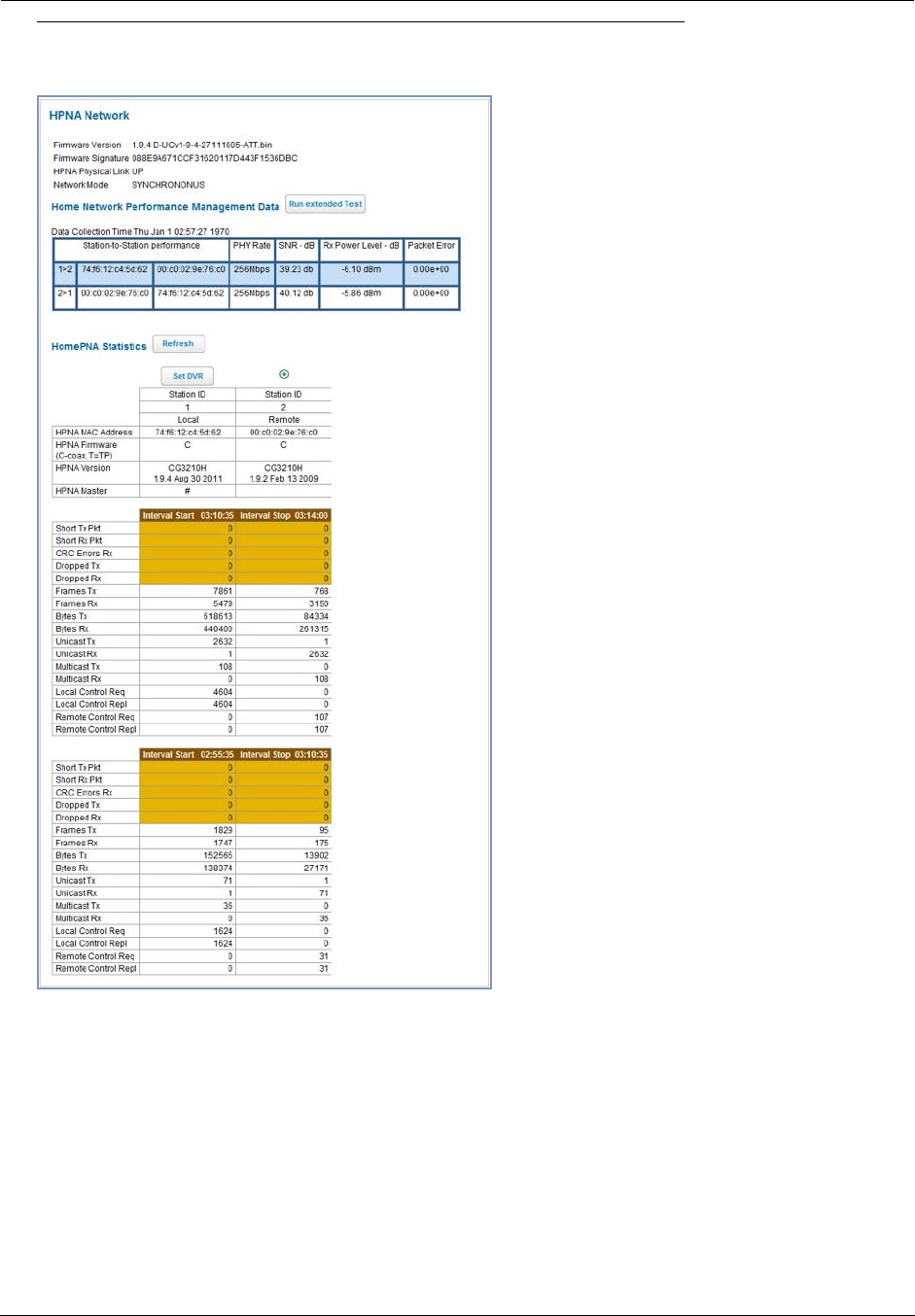
Administrator’s Handbook
54
Link: HPNA
When you click the HPNA link, the HPNA Network page appears.
The HPNA Network page displays information about the Gateway’s HPNA-connected devices in 15 minute inter-
vals.
◆If you have two or more stations, you can select the radio button and click the Set DVR button to store the
MAC address of the station as the “master DVR.” If the station order subsequently changes, the radio button
will appear on the correct station.
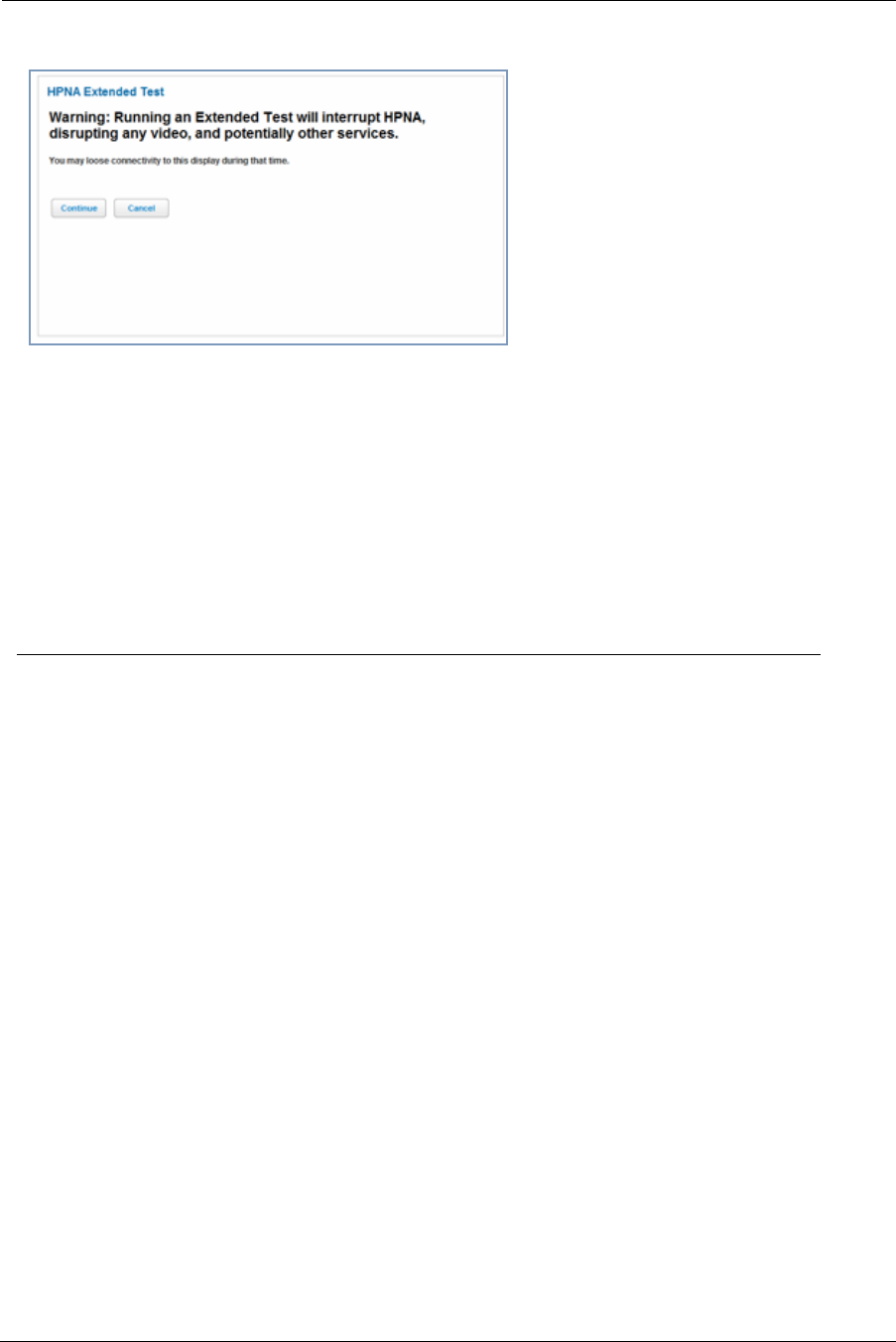
55
◆You can test the performance of each station to station pair by clicking the Run extended Test button. When
you click the Run extended Test button, the following page appears as a warning about this invasive test.
If you do not run the Extended Test, the station-to-station performance section is not displayed.
◆You can generate updated statistics by clicking the Refresh button.
Furnished statistics of the current and previous intervals are displayed as follows:
◆Station ID
◆HPNA MAC Address
◆HPNA Firmware (C-coax, T=TP)
◆HPNA Version
◆HPNA Master
Interval Start Interval Stop
Short Tx Pkt This is the number of Transmitted Packets
Short Rx Pkt This is the number of Received Packets
CRC Errors Rx This is the number of Receipt errors
Dropped Tx This is the number of Transmit packets dropped
Dropped Rx This is the number of Receipt packets dropped
Tx Error % This is the percentage of transmitted errors
Rx Error % This is the percentage of receipt errors
Frames Tx This is the number of frames transmitted
Frames Rx This is the number of frames received
Bytes Tx This is the number of bytes transmitted
Bytes Rx This is the number of bytes received
Unicast Tx This is the number of unicast packets transmitted
Unicast Rx This is the number of unicast packets received
Multicast Tx This is the number of multicast packets transmitted
Multicast Rx This is the number of multicast packets received
Local Control Req This is the number of requests made to the device by local control
Local Control Repl This is the number of replies made by the device to local control
Remote Control Req This is the number of requests made to the device by remote control
Remote Control Repl This is the number of replies made by the device to remote control
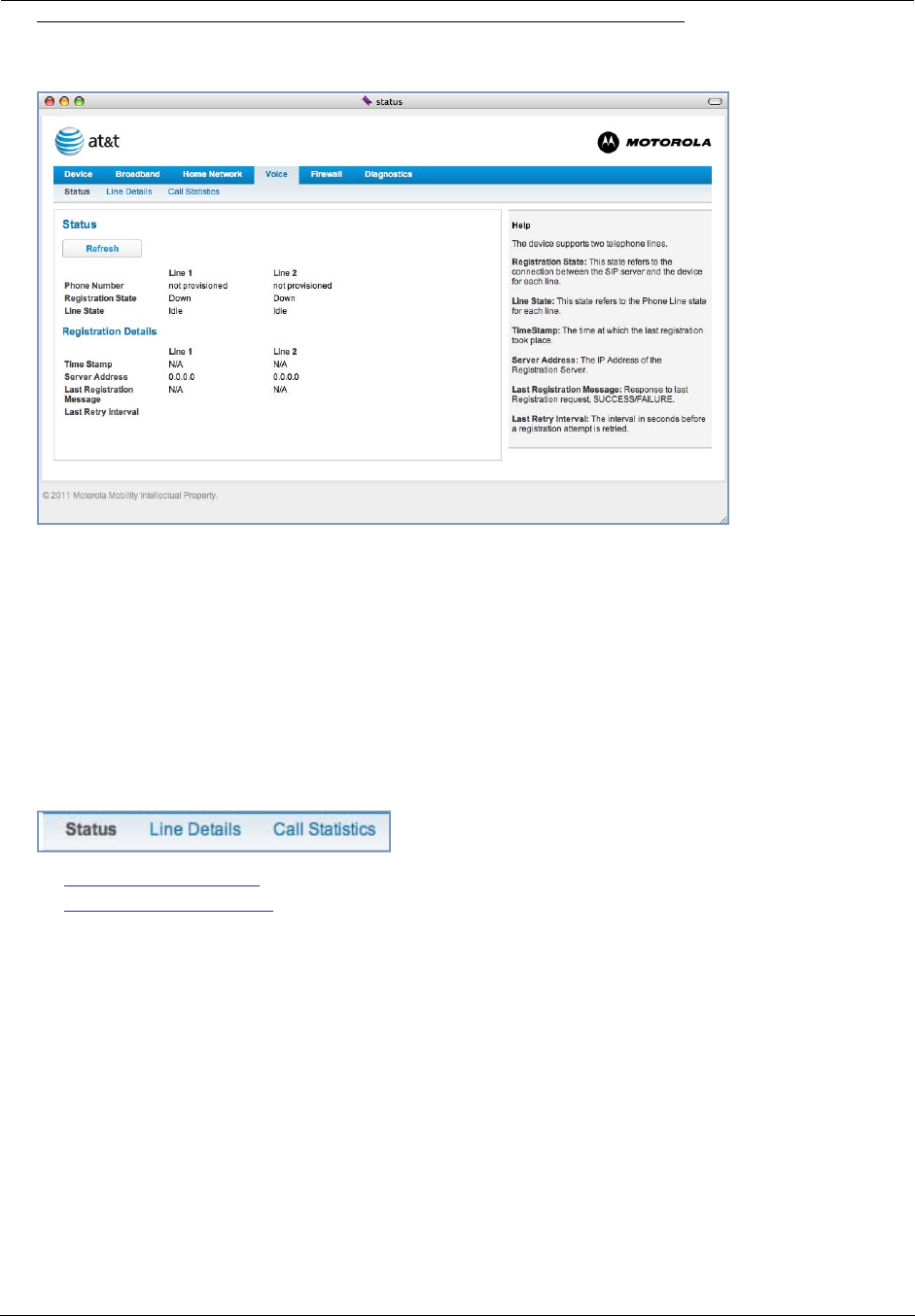
Administrator’s Handbook
56
Voice
If you click the Voice ink, the Voice page appears.
Voice-over-IP (VoIP) refers to the ability to make voice telephone calls over the Internet. This differs from tradi-
tional phone calls that use the Public Switched Telephone Network (PSTN). VoIP calls use an Internet protocol,
Session Initiation Protocol (SIP), to transmit sound over a network or the Internet in the form of data packets.
◆The Voice page displays information about your VoIP phone lines, if configured. Your Gateway supports two
phones, Line 1 and Line 2.
◆If either one or both are registered with a SIP server by your service provider or not registered, the Voice page
will display their Registration Details.
The links at the top of the Voice page access a series of pages to allow you to configure and monitor
features of your device. The following sections give brief descriptions of these pages.
◆“Line Details” on page 57
◆“Call Statistics” on page 58
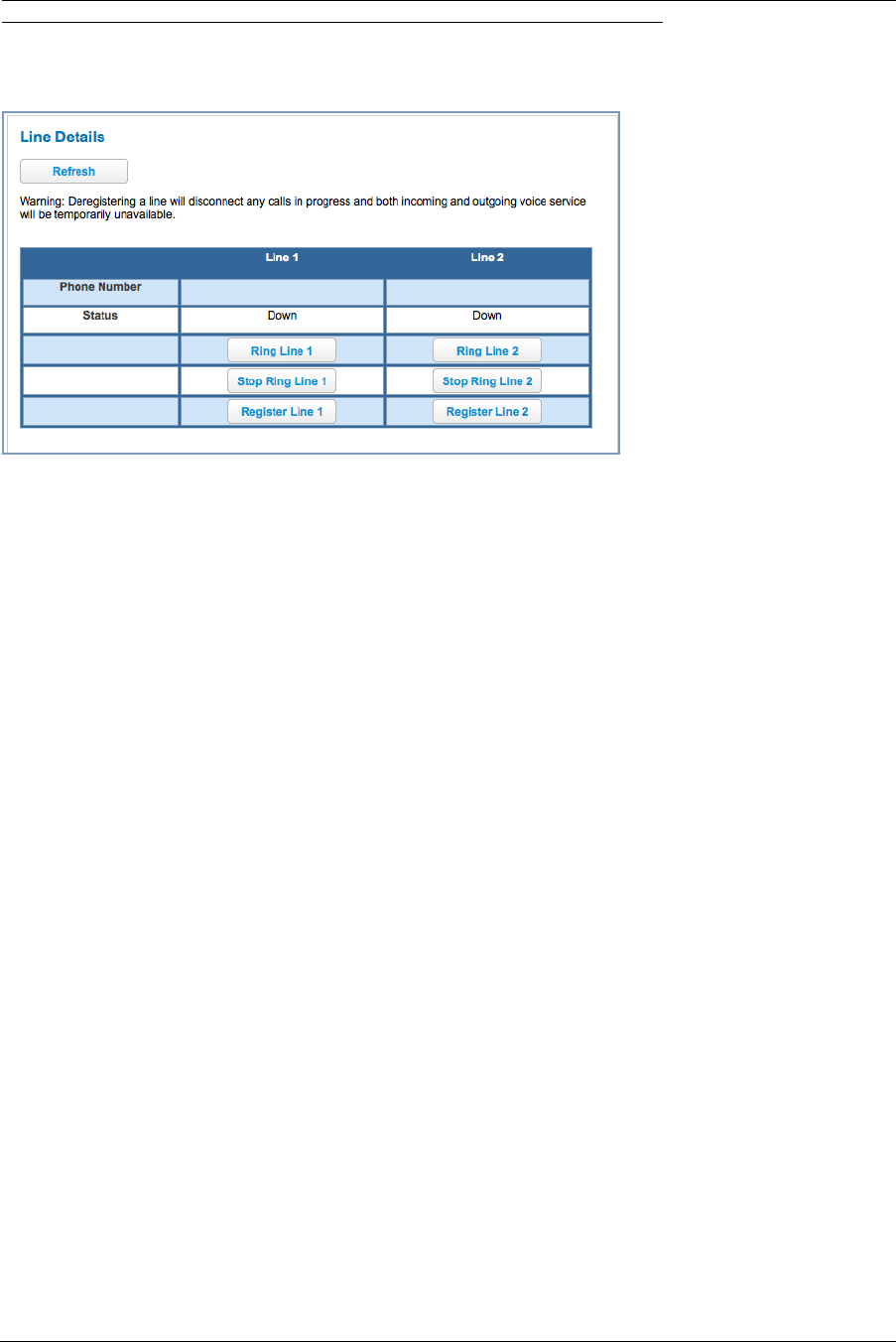
57
Link: Line Details
When you click the Line Details link, the Line Details page appears.
◆If your service provider has enabled your VoIP phone lines, you can register them by clicking the Register
Line 1 or Register Line 2 button(s).
◆To test if the lines are enabled, click the Ring Line 1 or Ring Line 2 button(s). If enabled and registered, the
respective phone will ring until you click the Stop Ring Line 1 or Stop Ring Line 2 buttons.
◆To clear the current state of each phone line, click the Reset Line 1 or Reset Line 2 button(s). This will dis-
connect any calls currently in progress as well.
◆To update the display, click the Refresh button.
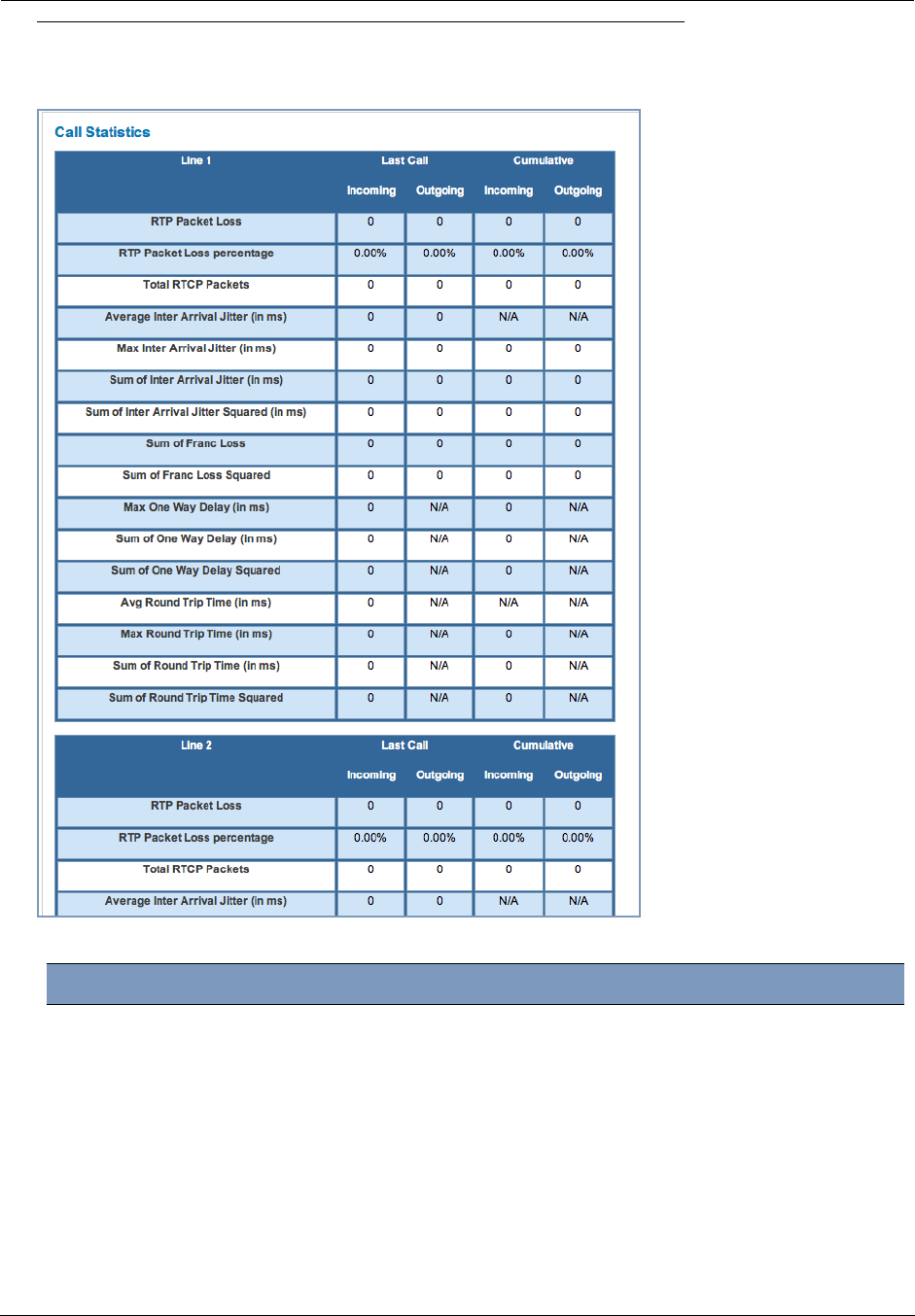
Administrator’s Handbook
58
Link: Call Statistics
When you click Call Statistics, the Call Statistics page appears.
For Line 1 and Line 2:, the two available phone lines, the Call Statistics page displays the following information:
Call Statistics - Line 1 and Line 2
Last Call/Cumulative – Incoming/Outgoing
RTP Packet Loss Real-time Transport Protocol packets dropped
RTP Packet Loss percent-
age
Percent of Real-time Transport Protocol packets dropped
Total RTCP Packets Total Real-time Transport Control Protocol packets
Average Inter Arrival Jitter This is calculated continuously in milliseconds as each data packet is received
and averaged.
Max Inter Arrival Jitter This is the maximum value in milliseconds recorded as each data packet is
received.

59
Sum of Inter Arrival Jitter This is calculated continuously in milliseconds as each data packet is received
and totalled.
Sum of Inter Arrival Jitter
Squared
This is calculated continuously in milliseconds as each data packet is received
and the total is squared.
Sum of Franc Loss Fraction Lost: The fraction of RTP data packets lost since the previous SR or
RR packet was sent. This fraction is defined to be the number of packets lost
divided by the number of packets expected. This will be calculated on every
RTCP SR packet. Sum of the fraction lost is calculated with all the RTCP pack-
ets.
Sum of Franc Loss
Squared
Fraction lost is squared with every RTCP SR or RR packet. Sum of all this will
give the Sum of Franc Loss Squared.
Max One Way Delay One Way Delay will be calculated in milliseconds on every RTCP SR or RR
packet. This value is (systime - lsr - dslr) / 2
lsr means last SR timestamp
dslr means delay since last SR.
Sum of One Way Delay The sum of all the one way delays calculated in milliseconds on every RTCP
packet is displayed as Sum of One Way Delay.
Sum of One Way Delay
Squared
One Way Delay is squared with every RTCP SR or RR packet. Sum of all this
will give the Sum of One Way Delay Squared.
Avg Round Trip Time Average time in milliseconds from this local source to destination address and
back again for all logged calls
Max Round Trip Time Maximum amount of time in milliseconds from this local source to destination
address and back again for all logged calls
Sum of Round Trip Time Sum of time in milliseconds from this local source to destination address and
back again for all logged calls
Sum of Round Trip Time
Squared
Sum squared of time from this local source to destination address and back
again for all logged calls
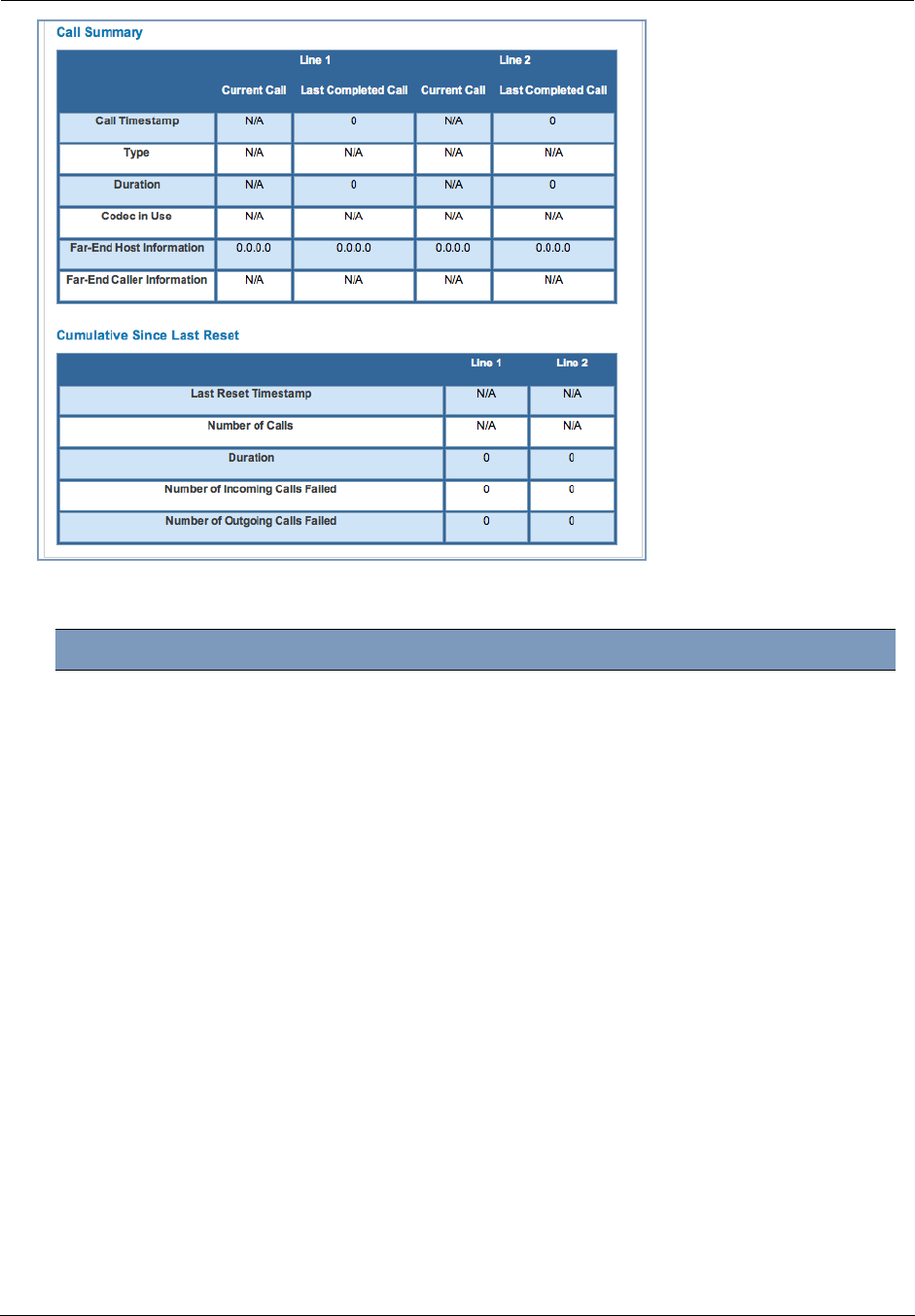
Administrator’s Handbook
60
For Line 1 and Line 2:, the two available phone lines, the Call Summary section displays the following informa-
tion:
Call Summary - Line 1 and Line 2
Current Call/Last Completed Call
Call Timestamp Date and Time of the current call
Type May be Incoming or Outgoing
Duration Length of time in seconds of call connection
Codec in Use Audio codec used for decoding the call packet traffic.
Far-End Host Information SIP server IP information: IP address and port number
Far-End Caller Information Caller ID information, if available
Cumulative Since Last Reset
Last Reset Timestamp Date and Time of the last call
Number of Calls Total number of calls for each VoIP line
Duration Time in seconds since the last call
Number of Incoming Calls Failed Number of Incoming calls that fail to connect
Number of Outgoing Calls Failed Number of Outgoing calls that fail to connect

61
The following table is the simplified version of VOIP line/hook/etc. states during different conditions.
The following table provides the state changes during the boot-up procedure.
VOIP
Line 1/2 Hook state WAN IP Reg-state FXS
Voltage Tone LED
Disable On/Off-hook UP Idle OFF N/A off
Enabled On-hook UP Registered ON N/A Solid
Enabled Off-hook UP Registered ON DIAL TONE Blink
Enabled On/off hook UP Failure OFF N/A off
Enabled On/off hook DOWN Idle OFF N/A off
VOIP
Line 1/2
WAN
Status Hook State Reg-state FXS
Voltage Tone LED
Disable Down Off-hook Idle On-to-off off off
Enabled Down On/Off-hook Idle ON Congestion off
Enabled
Up Off-hook Registered ON Congestion.
Dial Tone
played after
the hook state
is changed.
ON
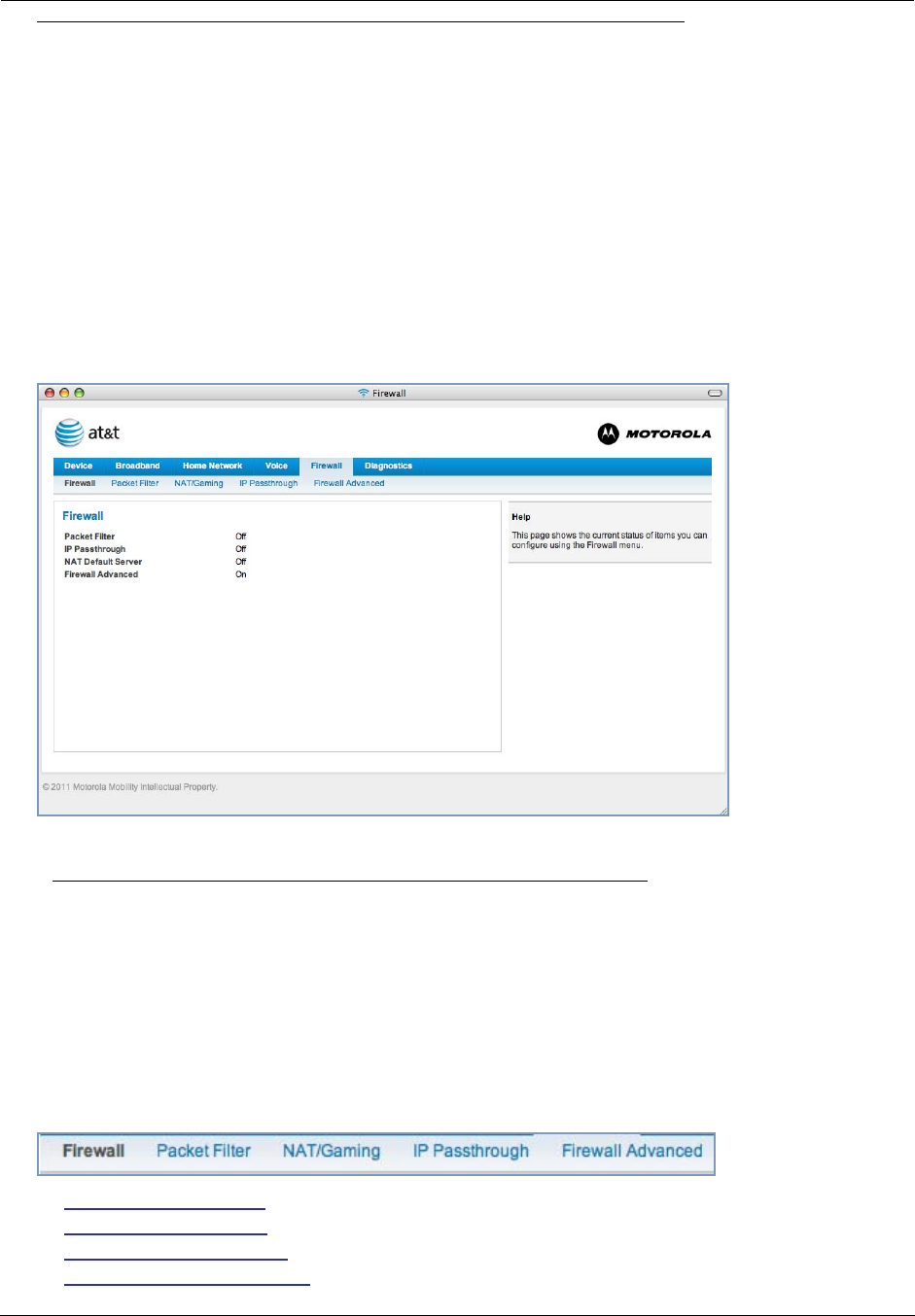
Administrator’s Handbook
62
Firewall
When you click the Firewall tab, the Firewall Status page appears. The Firewall page displays the status of your
system firewall elements.
All computer operating systems are vulnerable to attack from outside sources, typically at the operating system or
Internet Protocol (IP) layers. Stateful Inspection firewalls intercept and analyze incoming data packets to deter-
mine whether they should be admitted to your private LAN, based on multiple criteria, or blocked. Stateful inspec-
tion improves security by tracking data packets over a period of time, examining incoming and outgoing packets.
Outgoing packets that request specific types of incoming packets are tracked; only those incoming packets consti-
tuting a proper response are allowed through the firewall.
Stateful inspection is a security feature that prevents unsolicited inbound access when NAT is disabled. You can
configure UDP and TCP “no-activity” periods that will also apply to NAT time-outs if stateful inspection is enabled
on the interface. Stateful Inspection parameters are active on a WAN interface only if enabled on your system.
Stateful inspection can be enabled on a WAN interface whether NAT is enabled or not.
The center section displays the following:
The links at the top of the Firewall page access a series of pages to allow you to configure security features of
your device. The following sections give brief descriptions of these pages.
◆“Packet Filter” on page 63
◆“NAT/Gaming” on page 69
◆“IP Passthrough” on page 75
◆“Firewall Advanced” on page 78
Packet Filter May be On or Off
IP Passthrough May be On or Off
NAT Default Server May be On or Off
Firewall Advanced May be On or Off
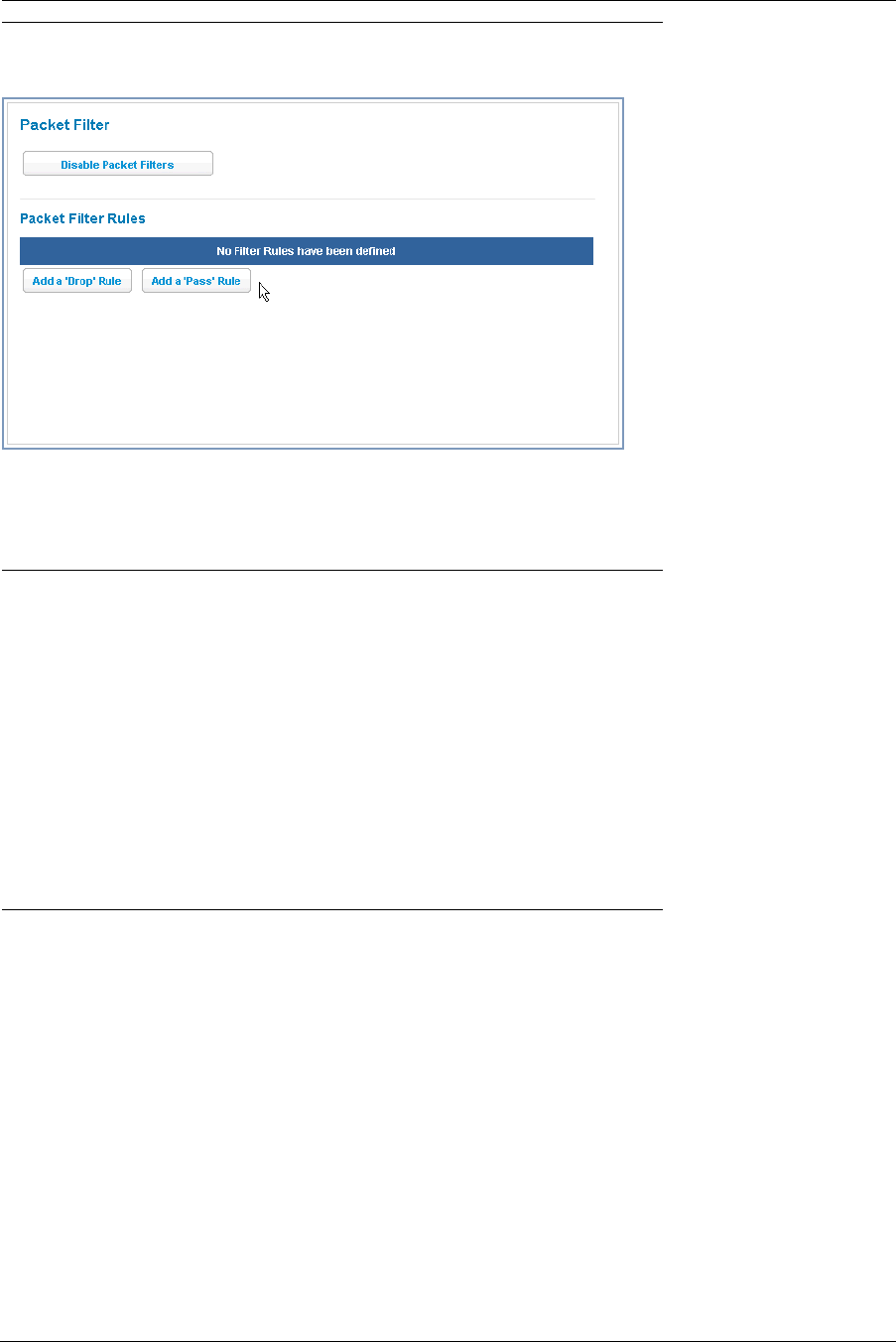
63
Link: Packet Filter
When you click the Packet Filter link the Packet Filter screen appears.
Security should be a high priority for anyone administering a network connected to the Internet. Using packet fil-
ters to control network communications can greatly improve your network’s security. The Packet Filter engine
allows creation of a maximum of eight Filtersets. Each Filterset can have up to eight rules configured.
☛ WARNING:
Before attempting to configure filters and filtersets, please read and understand this entire section
thoroughly. The Motorola Gateway incorporating NAT has advanced security features built in.
Improperly adding filters and filtersets increases the possibility of loss of communication with the
Gateway and the Internet. Never attempt to configure filters unless you are local to the Gateway.
Although using filtersets can enhance network security, there are disadvantages:
• Filters are complex. Combining them in filtersets introduces subtle interactions, increasing the like-
lihood of implementation errors.
• Enabling a large number of filters can have a negative impact on performance. Processing of pack-
ets will take longer if they have to go through many checkpoints in addition to NAT.
• Too much reliance on packet filters can cause too little reliance on other security methods. Filter-
sets are not a substitute for password protection, effective safeguarding of passwords, and general
awareness of how your network may be vulnerable.
Motorola’s packet filters are designed to provide security for the Internet connections made to and from your net-
work. You can customize the Gateway’s filtersets for a variety of packet filtering applications. Typically, you use fil-
ters to selectively admit or refuse TCP/IP connections from certain remote networks and specific hosts. You will
also use filters to screen particular types of connections. This is commonly called firewalling your network.
Before creating filtersets, you should read the next few sections to learn more about how these powerful security
tools work.

Administrator’s Handbook
64
Parts of a filter
A filter consists of criteria based on packet attributes. A typical filter can match a packet on any one of the follow-
ing attributes:
◆The source IP address (where the packet was sent from)
◆The destination IP address (where the packet is going)
◆The type of higher-layer Internet protocol the packet is carrying, such as TCP or UDP
Other filter attributes
There are three other attributes to each filter:
◆The filter’s order (i.e., priority) in the filterset
◆Whether the filter is currently active
◆Whether the filter is set to forward packets or to block (discard) packets
Design guidelines
Careful thought must go into designing a new filterset. You should consider the following guidelines:
◆Be sure the filterset’s overall purpose is clear from the beginning. A vague purpose can lead to a faulty set, and
that can actually make your network less secure.
◆Be sure each individual filter’s purpose is clear.
◆Determine how filter priority will affect the set’s actions. Test the set (on paper) by determining how the filters
would respond to a number of different hypothetical packets.
◆Consider the combined effect of the filters. If every filter in a set fails to match on a particular packet, the
packet is:
• Forwarded if all the filters are configured to discard (not forward)
• Discarded if all the filters are configured to forward
• Discarded if the set contains a combination of forward and discard filters
An approach to using filters
The ultimate goal of network security is to prevent unauthorized access to the network without compromising
authorized access. Using filtersets is part of reaching that goal.
Each filterset you design will be based on one of the following approaches:
◆That which is not expressly prohibited is permitted.
◆That which is not expressly permitted is prohibited.
It is strongly recommended that you take the latter, and safer, approach to all of your filterset designs.
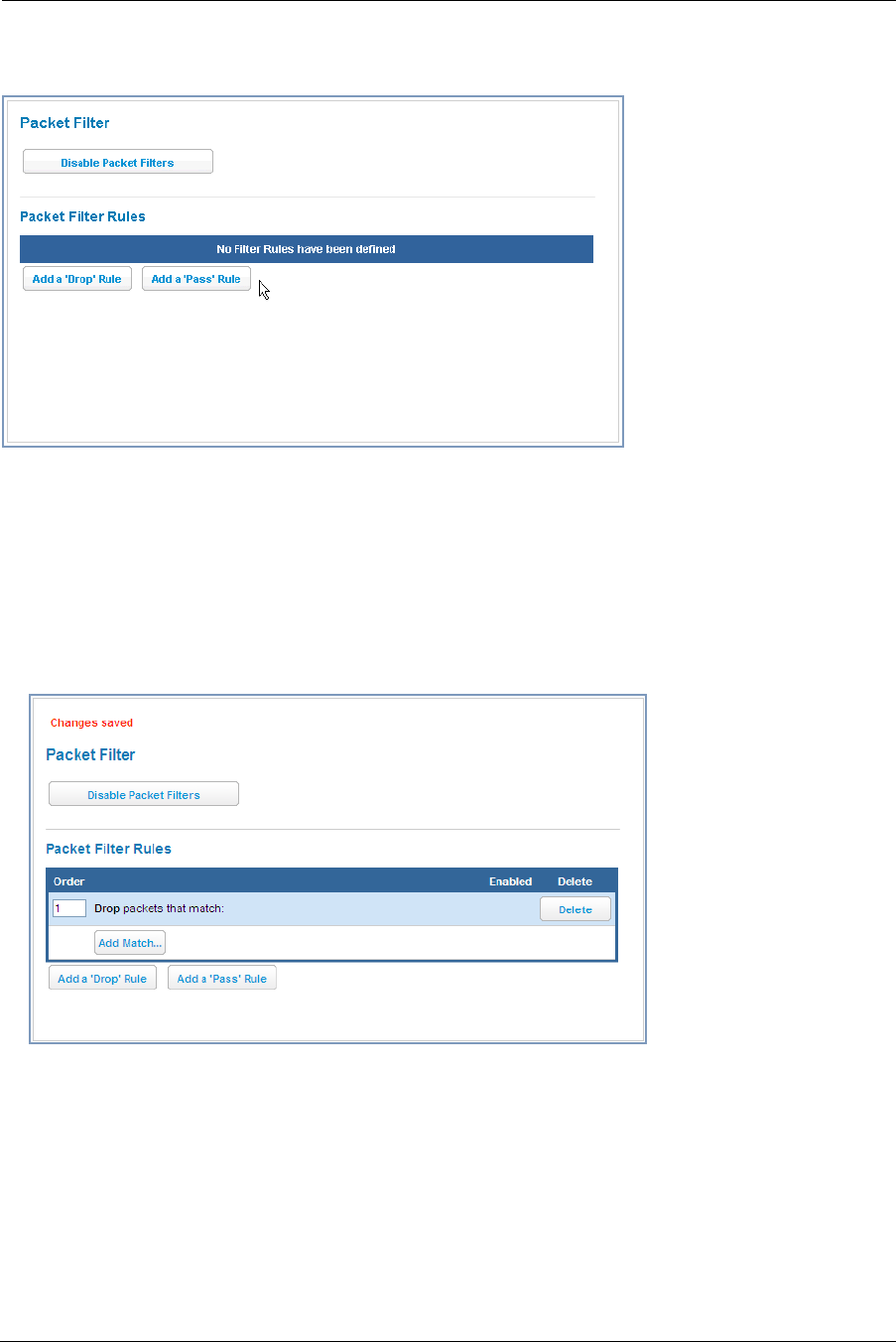
65
Working with Packet Filters
To work with filters, begin by accessing the Packet Filter page.
Packet Filter
◆Enable/Disable Packet Filters – Click this button to globally turn your filters on or off.
Packet Filter Rules
Buttons: Click either Add a ‘Drop’ Rule or Add a ‘Pass’ Rule button.
◆Action:
• drop: If you select drop, the specified packets will be blocked.
• pass: If you select pass, the specified packets will be forwarded.
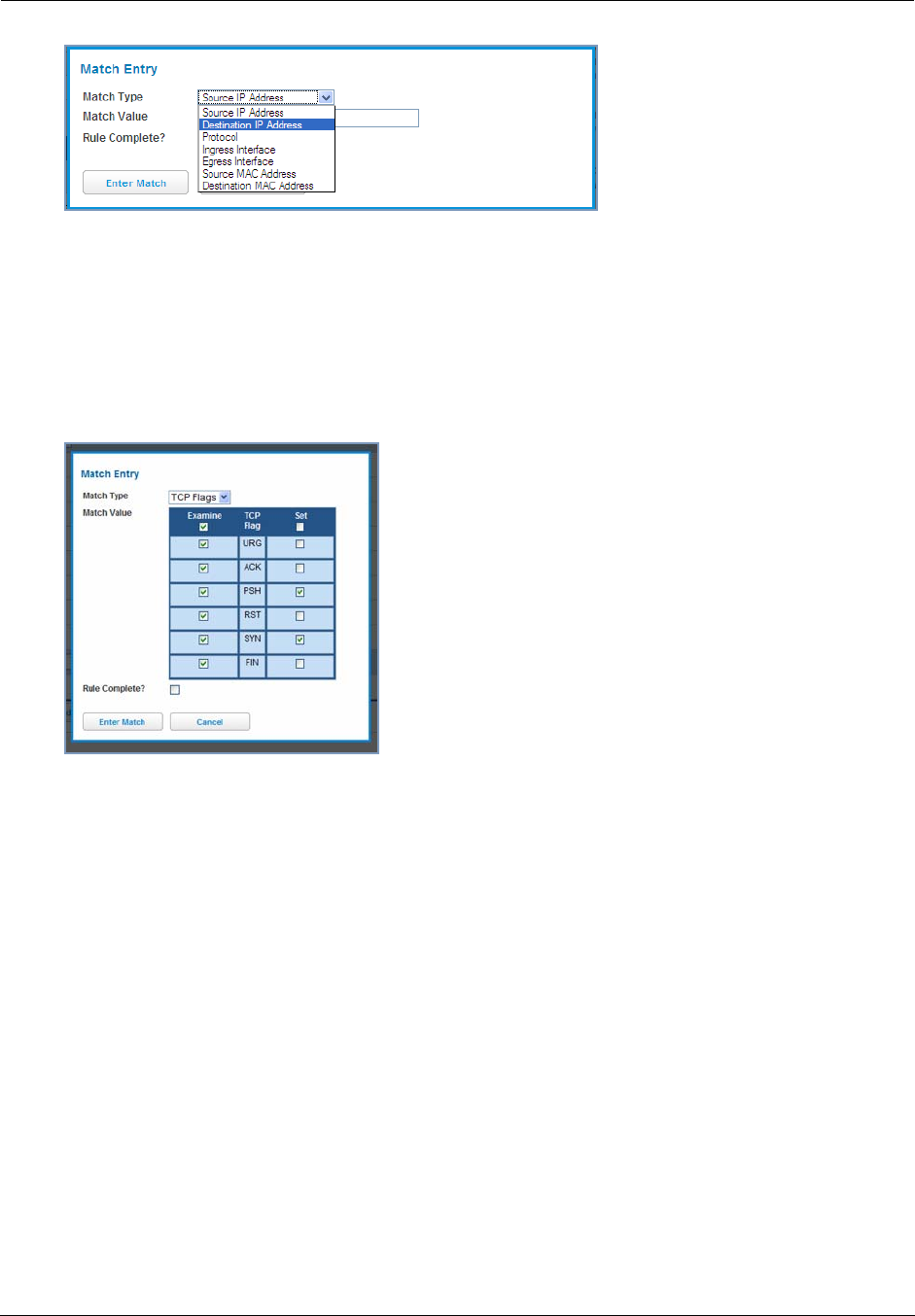
Administrator’s Handbook
66
◆Enter the Source IP Address or Destination IP Address this filter will match on.
As you create new Matches, the pulldown items change. There can only be one match from each Match Type
for a given rule. Match Types like Source Port, Destination Port, and TCP Flags are only available if other
matches (for example, Protocol =TCP) have previously been created.
◆Select Protocol, if necessary, from the pull-down menu: ICMP, TCP, UDP, or None to specify any another IP
transport protocol.
If you chose by number, enter the Protocol by number here.
If you chose by name, enter the Protocol by name here.
Enter the Source Port this filter will match on.
Enter the Destination Port this filter will match on.
If you selected ICMP, enter the ICMP Type here.
When you are finished configuring the filter, click the Enter Match button.
The filter is automatically saved.
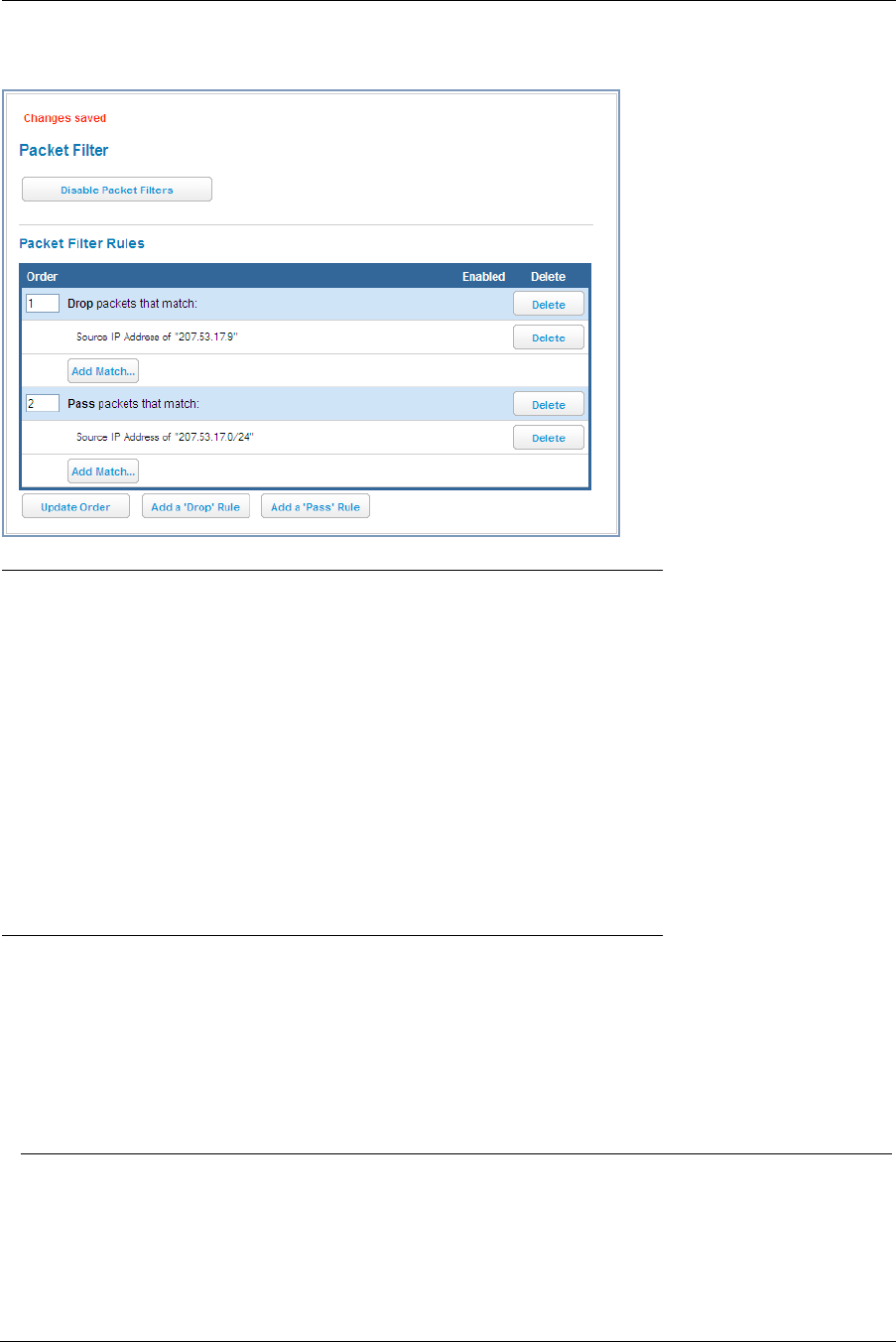
67
Packet Filter Rules List
Your entries are displayed as a table.
☛ NOTE:
Default Forwarding Filter
If you create one or more filters that have a matching action of forward, then action on a packet
matching none of the filters is to block any traffic.
Therefore, if the behavior you want is to force the routing of a certain type of packet and pass all oth-
ers through the normal routing mechanism, you must configure one filter to match the first type of
packet and apply Force Routing. A subsequent filter is required to match and forward all other pack-
ets.
Management IP traffic
If the Force Routing filter is applied to source IP addresses, it may inadvertently block communica-
tion with the router itself. You can avoid this by preceding the Force Routing filter with a filter that
matches the destination IP address of the Gateway itself.
Example:
Assume a configured Custom Service/Hosted Application for an internal web server whose Global Port Range is
8080-8080. Also assume that we want to allow only one external subnet access to this internal server,
207.53.17.0/24. And finally, assume that we want to disallow one IP address on that subnet, 207.53.17.9, from
access to that same server (perhaps they were abusing the system in some way). The rules we need are:
Input
Rules:
Rule
Order
Action Source IP Destination IP Protocol Source
Port
Destination
Port
1 Drop 207.53.17.9 - TCP 8080
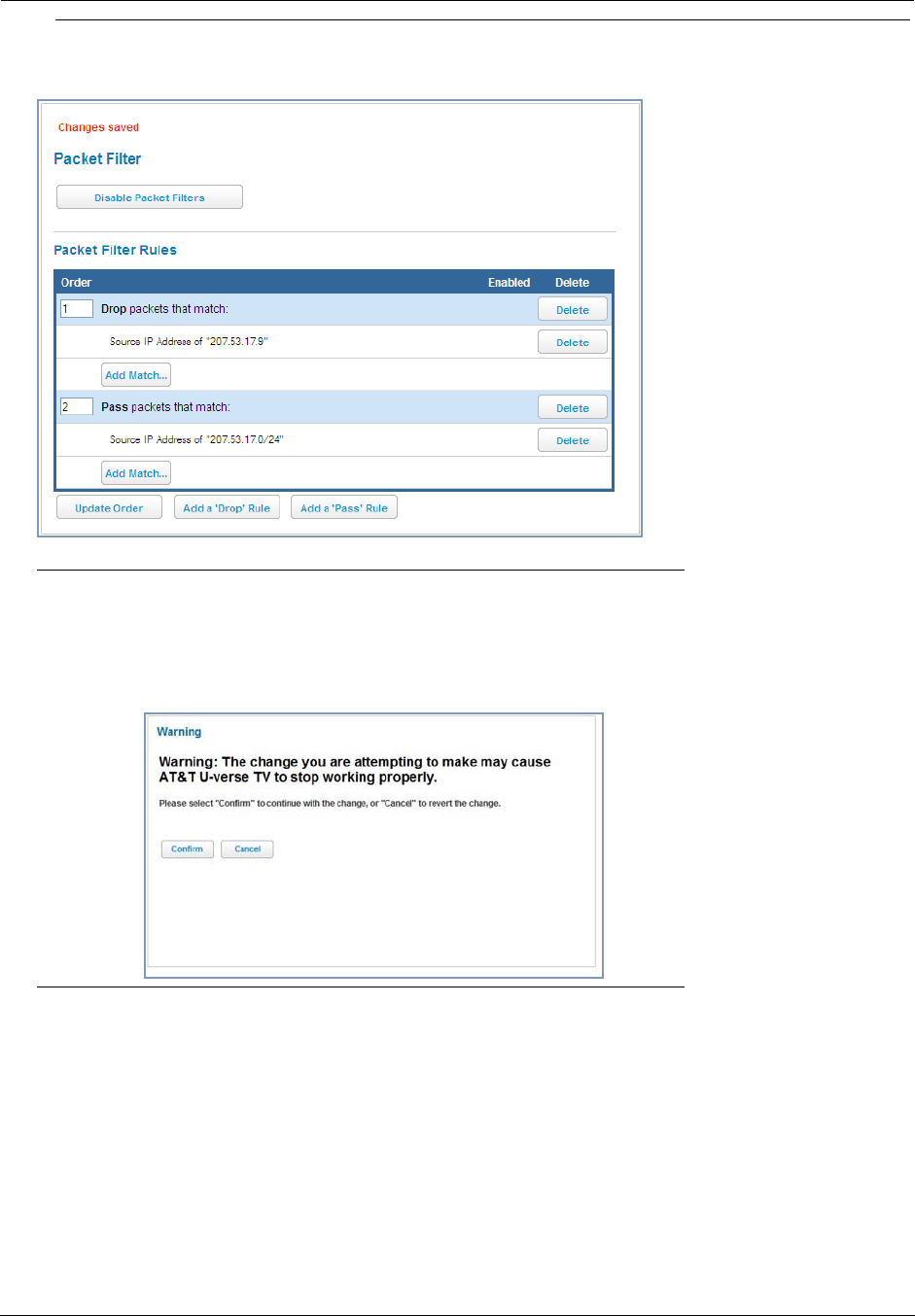
Administrator’s Handbook
68
☛ Port Warnings:
If the packet filter or port forwarding rule involves TCP port 80 or 3389; or UDP port 47806, 43962,
69, 123, or 53; or If you attempt to add or change a match such that this occurs AND if running in
VDSL/Ethernet mode, the following warning will appear.
2 Pass 207.53.17.0/24 - TCP 8080
3 Drop - - TCP 8080
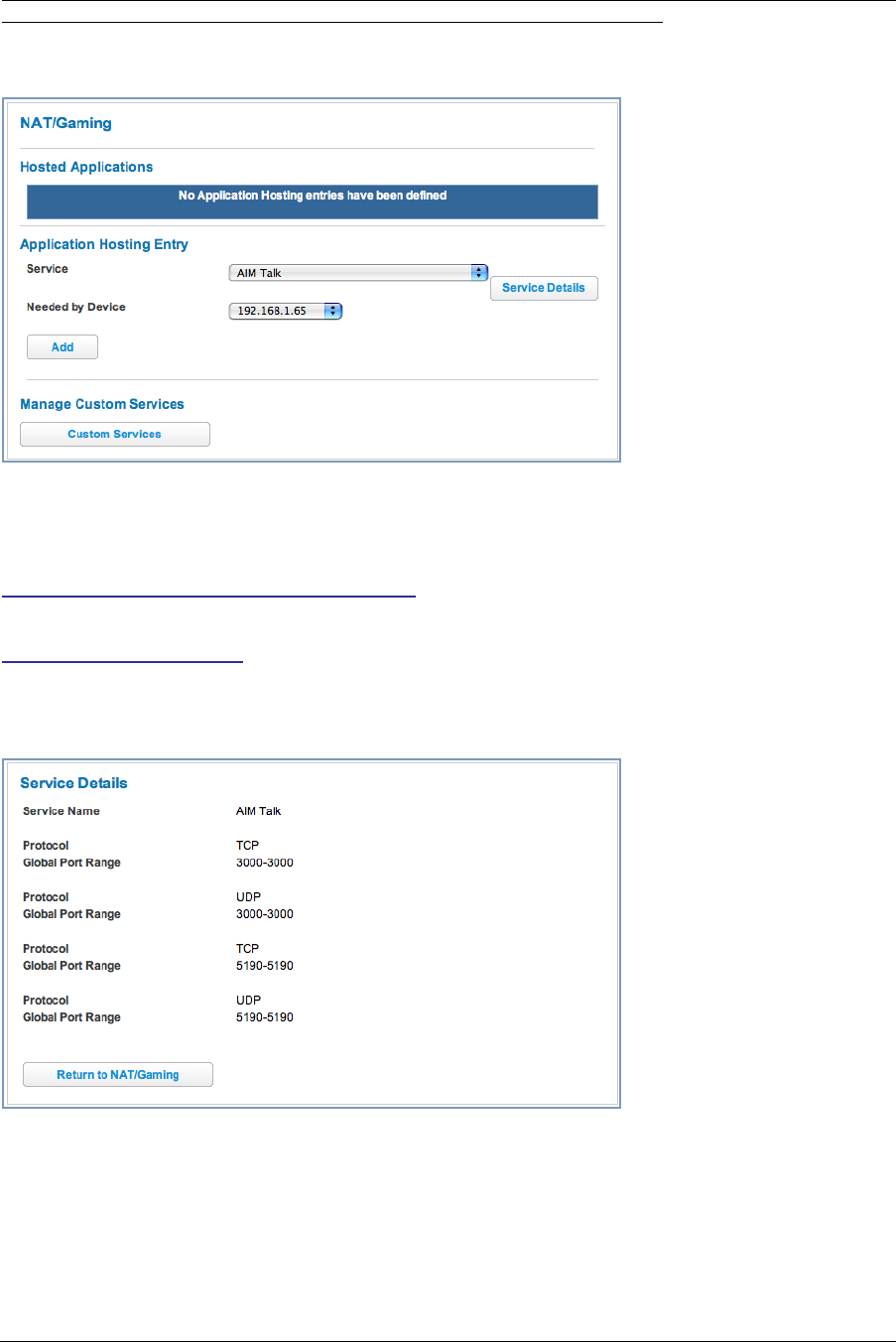
69
Link: NAT/Gaming
When you click the NAT/Gaming link, the NAT/Gaming page appears.
NAT/Gaming allows you to host internet applications when NAT is enabled. You can host different games and
software on different PCs.
From the Service pull-down menu, you can select any of a large number of predefined games and software. (See
“List of Supported Games and Software” on page 73.)
In addition to choosing from these predefined services you can also select a user defined custom service. (See
“Custom Services” on page 71.)
For each supported game or service, you can view the protocols and port ranges used by the game or service by
clicking the Service Details button. For example:
Select a hosting device from the Needed by Device pull-down menu.
1. Once you choose a software service or game, click Add.
2. Select a PC to host the software from the Select Host Device pull-down menu and
click Save.
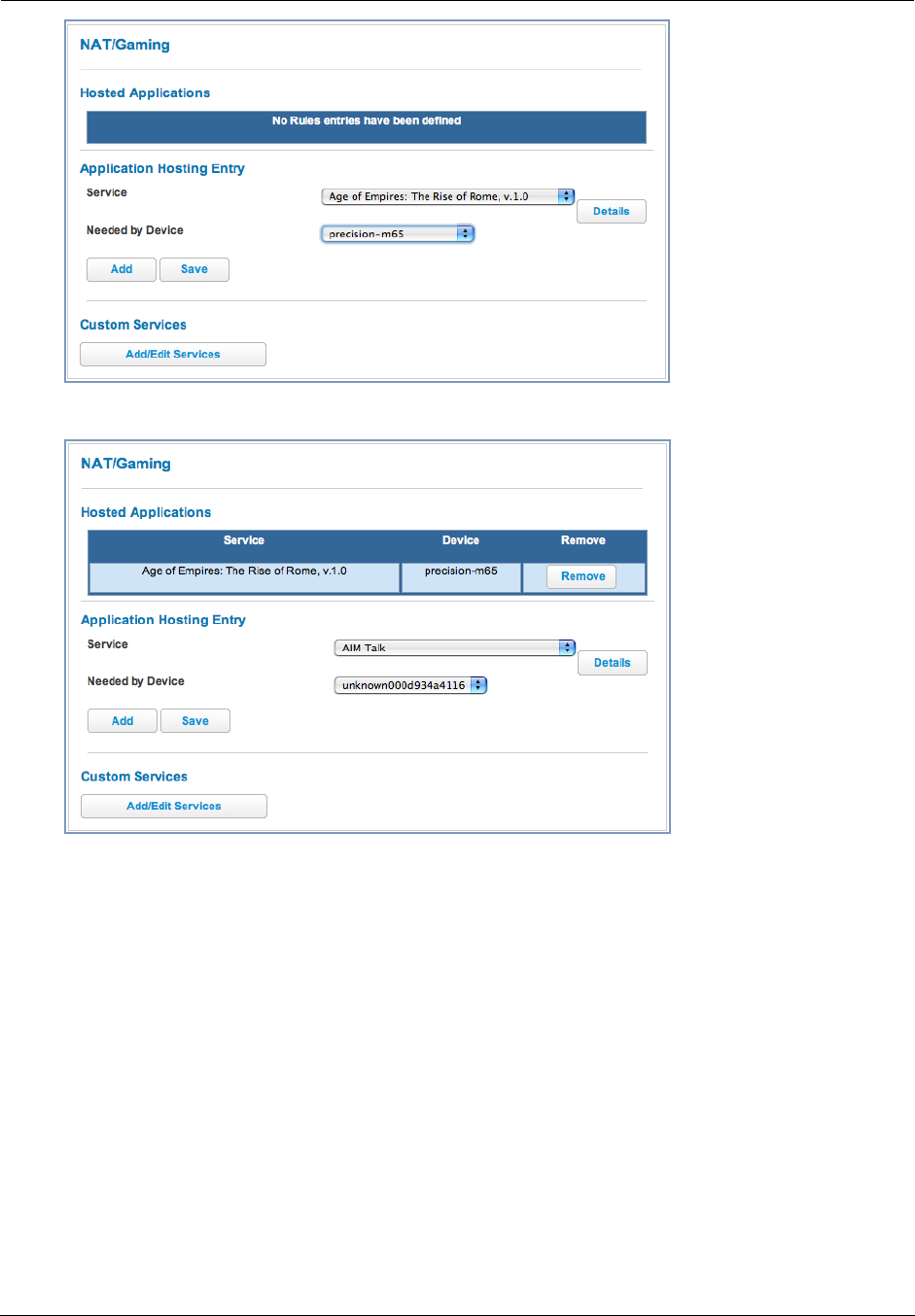
Administrator’s Handbook
70
Each time you enable a software service or game your entry will be added to the list of Service names dis-
played on the NAT Configuration page.
To remove a game or software from the hosted list, choose the game or software you want to remove and click the
Remove button.
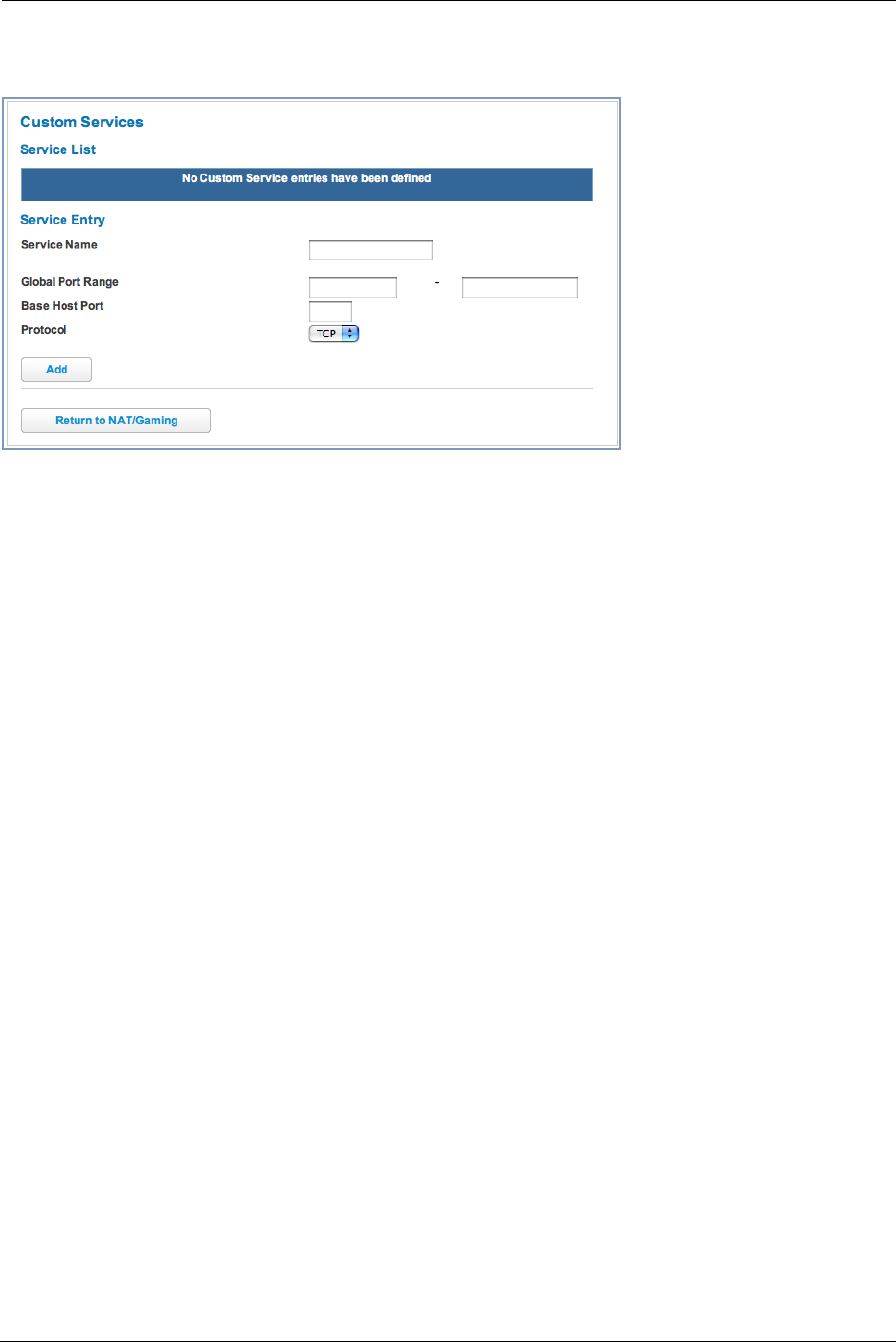
71
Custom Services
To configure a Custom Service, click the Add/Edit Services button. The Custom Services page appears.
Enter the following information:
◆Service Name: A unique identifier for the Custom Service.
◆Global Port Range: Range of ports on which incoming traffic will be received.
◆Base Host Port: The port number at the start of the port range your Gateway should use when forwarding traf-
fic of the specified type(s) to the internal IP address.
◆Protocol: Protocol type of Internet traffic, TCP or UDP.
Once you define a Custom Service it becomes available in the Application Hosting Entry Service menu as one
of the services to select.
Click the Add button.
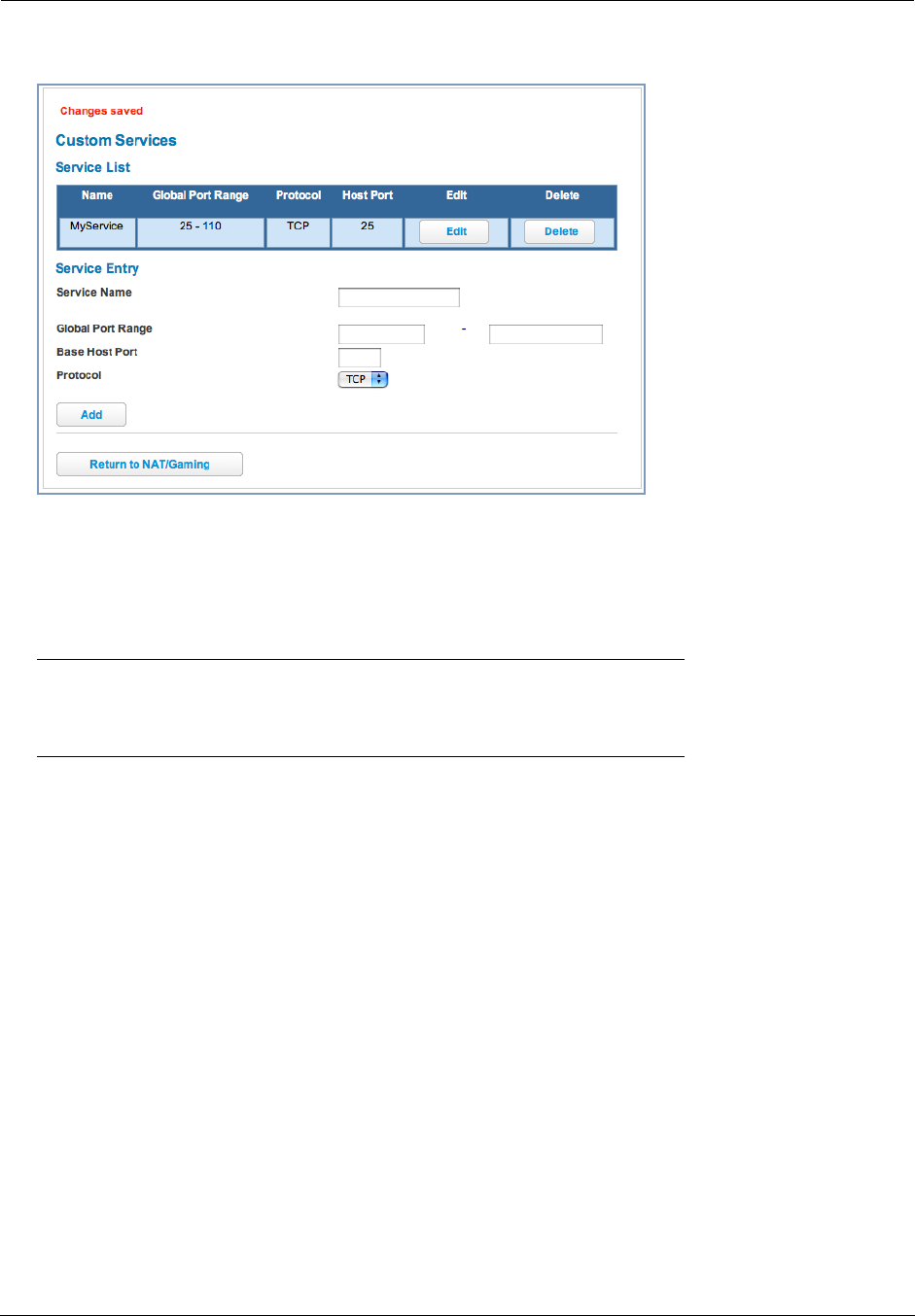
Administrator’s Handbook
72
Each time you enable a custom service your entry will be added to the list of Service names displayed on the
Custom Services page.
Changes are saved immediately.
To remove this Service, click the Delete button.
To edit this Service, click the Edit button.
☛ Note:
You cannot edit a Custom Service if the Service is active; it must be inactive before it can be edited.

73
List of Supported Games and Software
AIM Talk Act of War - Direct Action Age of Empires II
Age of Empires, v.1.0 Age of Empires: The Rise of
Rome, v.1.0
Age of Mythology
Age of Wonders America's Army Apache
Asheron's Call Azureus Baldur's Gate I and II
Battlefield 1942 Battlefield Communicator Battlefield Vietnam
BitTornado BitTorrent Black and White
Blazing Angels Online Brothers in Arms - Earned in
Blood
Brothers in Arms Online
Buddy Phone CART Precision Racing, v 1.0 Calista IP Phone
Call of Duty Citrix Metaframe/ICA Client Close Combat III: The Russian
Front, v 1.0
Close Combat for Windows 1.0 Close Combat: A Bridge Too Far, v
2.0
Combat Flight Sim 2: WWII Pacific
Thr, v 1.0
Combat Flight Sim: WWII Europe
Series, v 1.0
Counter Strike DNS Server
Dark Reign Delta Force (Client and Server) Delta Force 2
Delta Force Black Hawk Down Diablo II Server Dialpad
DirecTV STB 1 DirecTV STB 2 DirecTV STB 3
Doom 3 Dues Ex Dune 2000
Empire Earth Empire Earth 2 F-16, Mig 29
F-22, Lightning 3 FTP Far Cry
Fighter Ace II GNUtella Grand Theft Auto 2 Multiplayer
H.323 compliant (Netmeeting,
CUSeeME)
HTTP HTTPS
Half Life Half Life 2 Steam Half Life 2 Steam Server
Half Life Steam Half Life Steam Server Halo
Hellbender for Windows, v 1.0 Heretic II Hexen II
Hotline Server ICQ 2001b ICQ Old
IMAP Client IMAP Client v.3 IPSec IKE
Internet Phone Jedi Knight II: Jedi Outcast Kali
KazaA Lime Wire Links LS 2000
Lord of the Rings Online MSN Game Zone MSN Game Zone DX
MSN Messenger Mech Warrior 3 MechWarrior 4: Vengeance
Medal of Honor Allied Assault Microsoft Flight Simulator 2000 Microsoft Flight Simulator 98

Administrator’s Handbook
74
Microsoft Golf 1998 Edition, v
1.0
Microsoft Golf 1999 Edition Microsoft Golf 2001 Edition
Midtown Madness, v 1.0 Monster Truck Madness 2, v 2.0 Monster Truck Madness, v 1.0
Motocross Madness 2, v 2.0 Motocross Madness, v 1.0 NNTP
Need for Speed 3, Hot Pursuit Need for Speed, Porsche Net2Phone
Operation FlashPoint Outlaws POP-3
PPTP PlayStation Network Quake 2
Quake 3 Quake 4 Rainbow Six
RealAudio Return to Castle Wolfenstein Roger Wilco
Rogue Spear SMTP SNMP
SSH server ShoutCast Server SlingBox
Soldier of Fortune StarCraft StarLancer, v 1.0
Starfleet Command TFTP TeamSpeak
Telnet Tiberian Sun: Command and Con-
quer
Timbuktu
Total Annihilation Ultima Online Unreal Tournament Server
Urban Assault, v 1.0 VNC, Virtual Network Computing Warlords Battlecry
Warrock Westwood Online, Command and
Conquer
Win2000 Terminal Server
Wolfenstein Enemy Territory World of Warcraft X-Lite
XBox 360 Media Center XBox Live 360 Yahoo Messenger Chat
Yahoo Messenger Phone ZNES eDonkey
eMule eMule Plus iTunes
mIRC Auth-IdentD mIRC Chat mIRC DCC - IRC DCC
pcAnywhere (incoming)
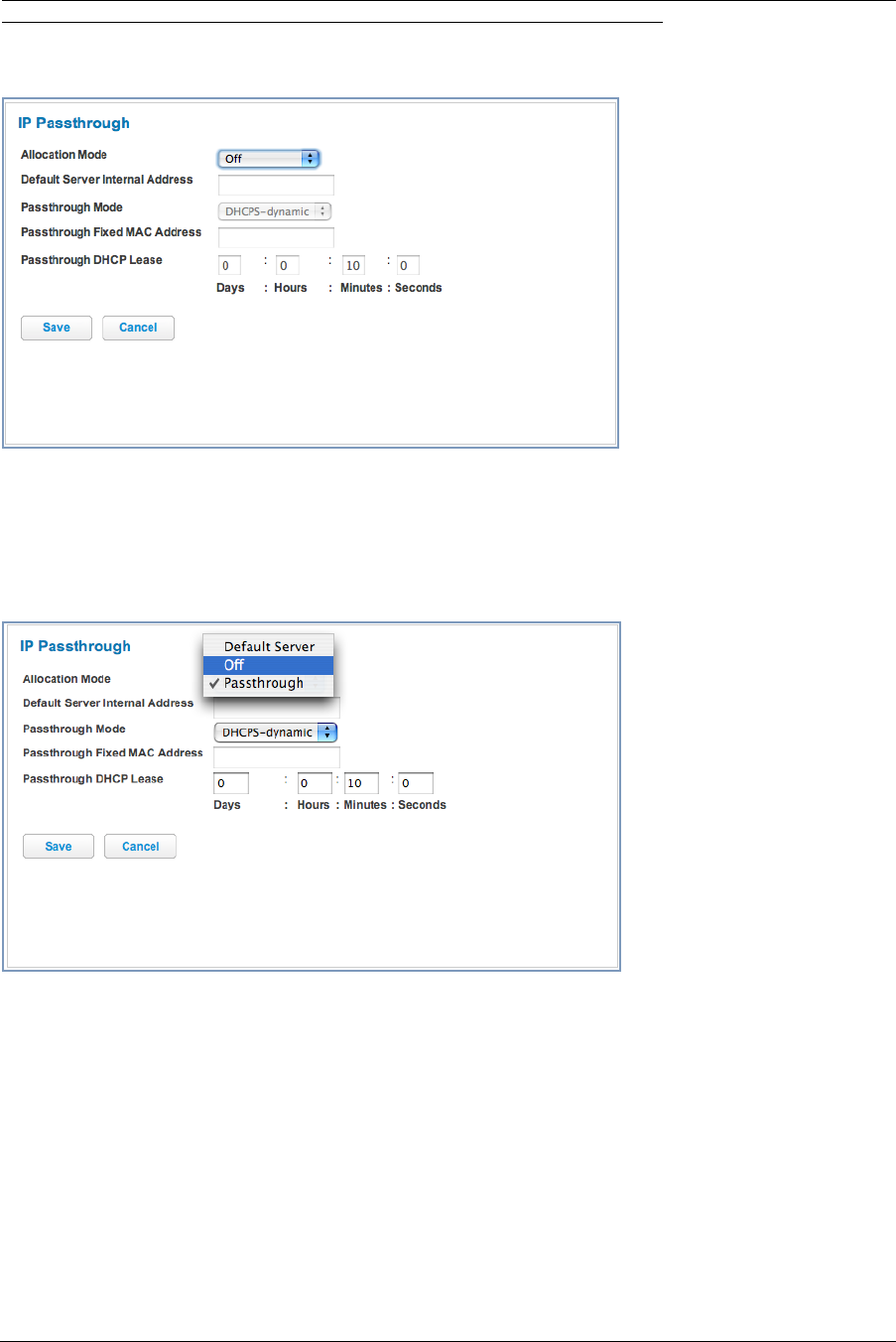
75
Link: IP Passthrough
When you click the IP Passthrough link, the IP Passthrough page appears.
IP Passthrough
The IP Passthrough feature allows a single PC on the LAN to have the Motorola Gateway’s public address
assigned to it. It also provides PAT (NAPT) via the same public IP address for all other hosts on the private LAN
subnet.
Using IP Passthrough, the public WAN IP is used to provide IP address translation for private LAN computers. The
public WAN IP is assigned and reused on a LAN computer.
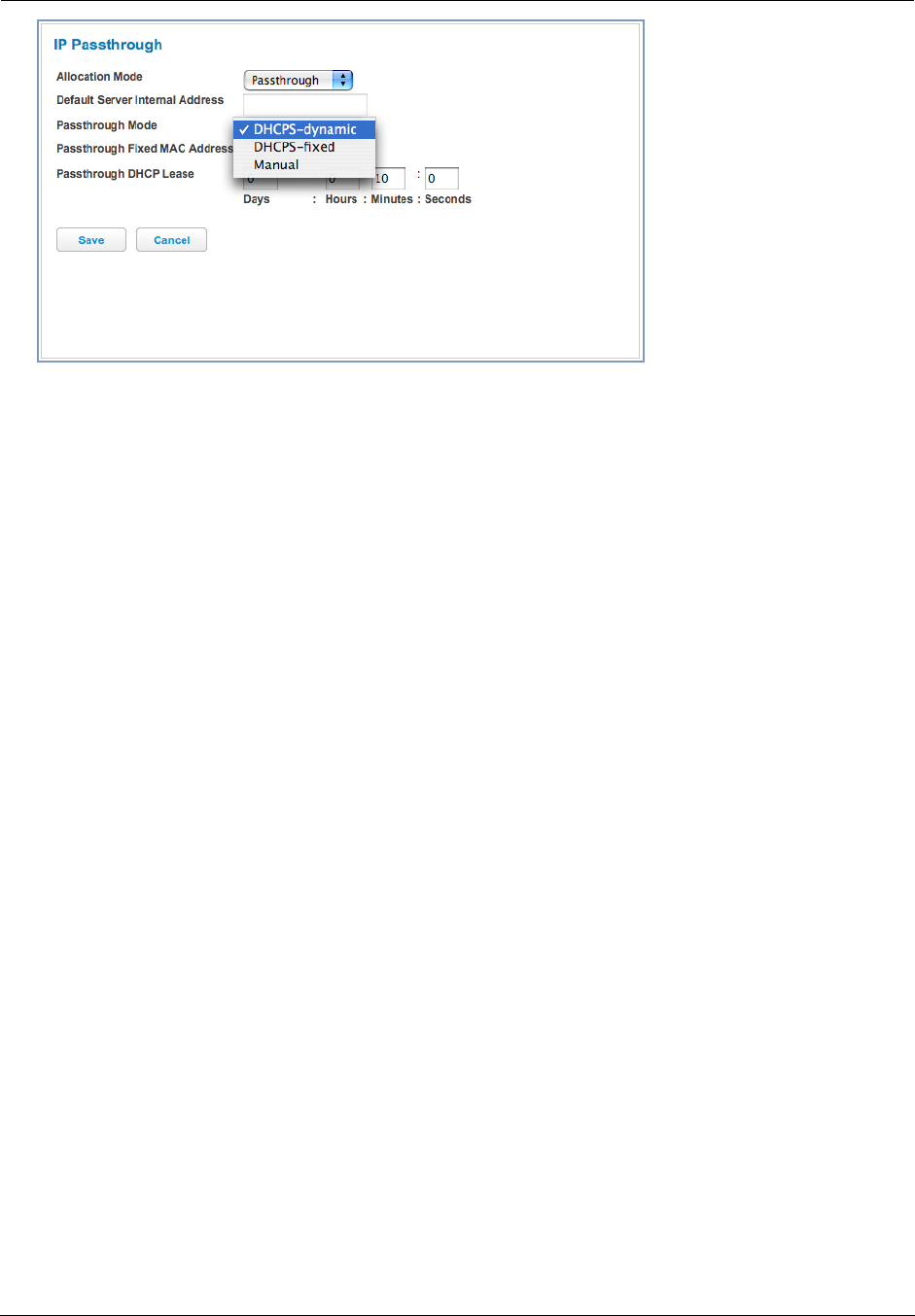
Administrator’s Handbook
76
DHCP address serving can automatically serve the WAN IP address to a LAN computer.
When DHCP is used for addressing the designated passthrough PC, the acquired or configured WAN address is
passed to DHCP, which will dynamically configure a single-servable-address subnet, and reserve the address for
the configured PC’s MAC address. This dynamic subnet configuration is based on the local and remote WAN
address and subnet mask.
◆The two DHCP modes assign the WAN IP information needed to the client automatically.
• You can select the MAC address of the PC you want to be the IP Passthrough client with fixed mode,
or,
• with “first-come-first-served” – dynamic – the first client to renew its address will be assigned the WAN IP.
◆Manual mode is like statically configuring your PC. With Manual mode, you configure the TCP/IP Properties
of the LAN client PC you want to be the IP Passthrough client. You then manually enter the WAN IP address,
Gateway Address, etc. that matches the WAN IP address information of your Motorola Gateway. This mode
works the same as the DHCP modes. Unsolicited WAN traffic will get passed to this client. The client is still
able to access the Motorola Gateway and other LAN clients on the 192.168.1.x network, etc.
◆The Passthrough DHCP Lease – By default, the passthrough host's DHCP leases will be shortened to two
minutes. This allows for timely updates of the host's IP address, which will be a private IP address before the
WAN connection is established. After the WAN connection is established and has an address, the passthrough
host can renew its DHCP address binding to acquire the WAN IP address. You may alter this setting.
◆Click Save. Changes take effect immediately.
A restriction
Since both the Gateway and the passthrough host will use the same IP address, new sessions that conflict with
existing sessions will be rejected by the Gateway. For example, suppose you are a teleworker using an IPSec tun-
nel from the Router and from the passthrough host. Both tunnels go to the same remote endpoint, such as the
VPN access concentrator at your employer’s office. In this case, the first one to start the IPSec traffic will be
allowed; the second one – since, from the WAN, it's indistinguishable – will fail.
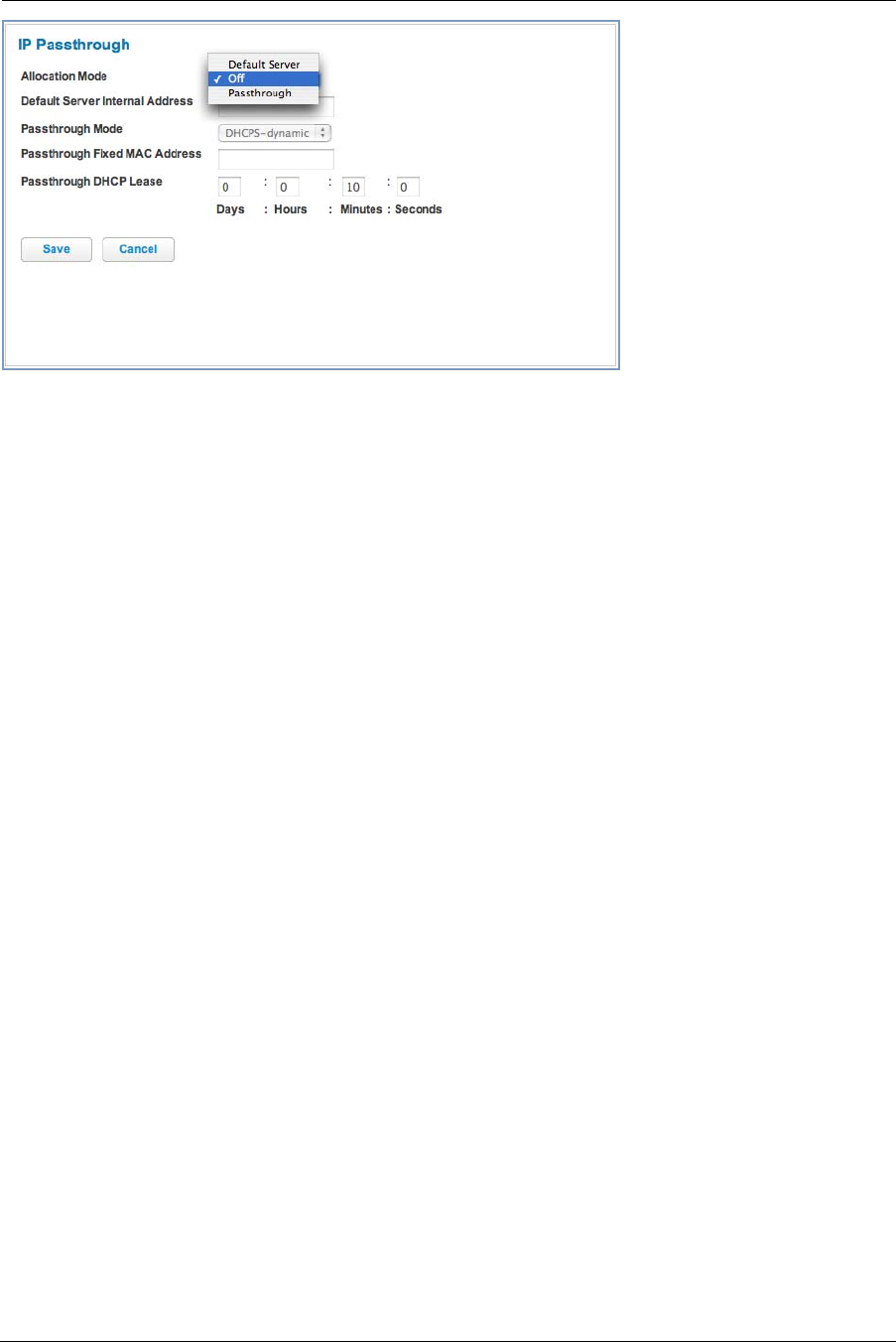
77
NAT Default Server
This feature allows you to:
◆Direct your Gateway to forward all externally initiated IP traffic (TCP and UDP protocols only) to a default host
on the LAN, specified by your entry in the Internal Address field.
◆ Enable it for certain situations:
– Where you cannot anticipate what port number or packet protocol an in-bound application might use. For
example, some network games select arbitrary port numbers when a connection is opened.
– When you want all unsolicited traffic to go to a specific LAN host.
This feature allows you to direct unsolicited or non-specific traffic to a designated LAN station. With NAT “On” in
the Gateway, these packets normally would be discarded.
For instance, this could be application traffic where you don’t know (in advance) the port or protocol that will be
used. Some game applications fit this profile.
◆Click Save. Changes take effect immediately.
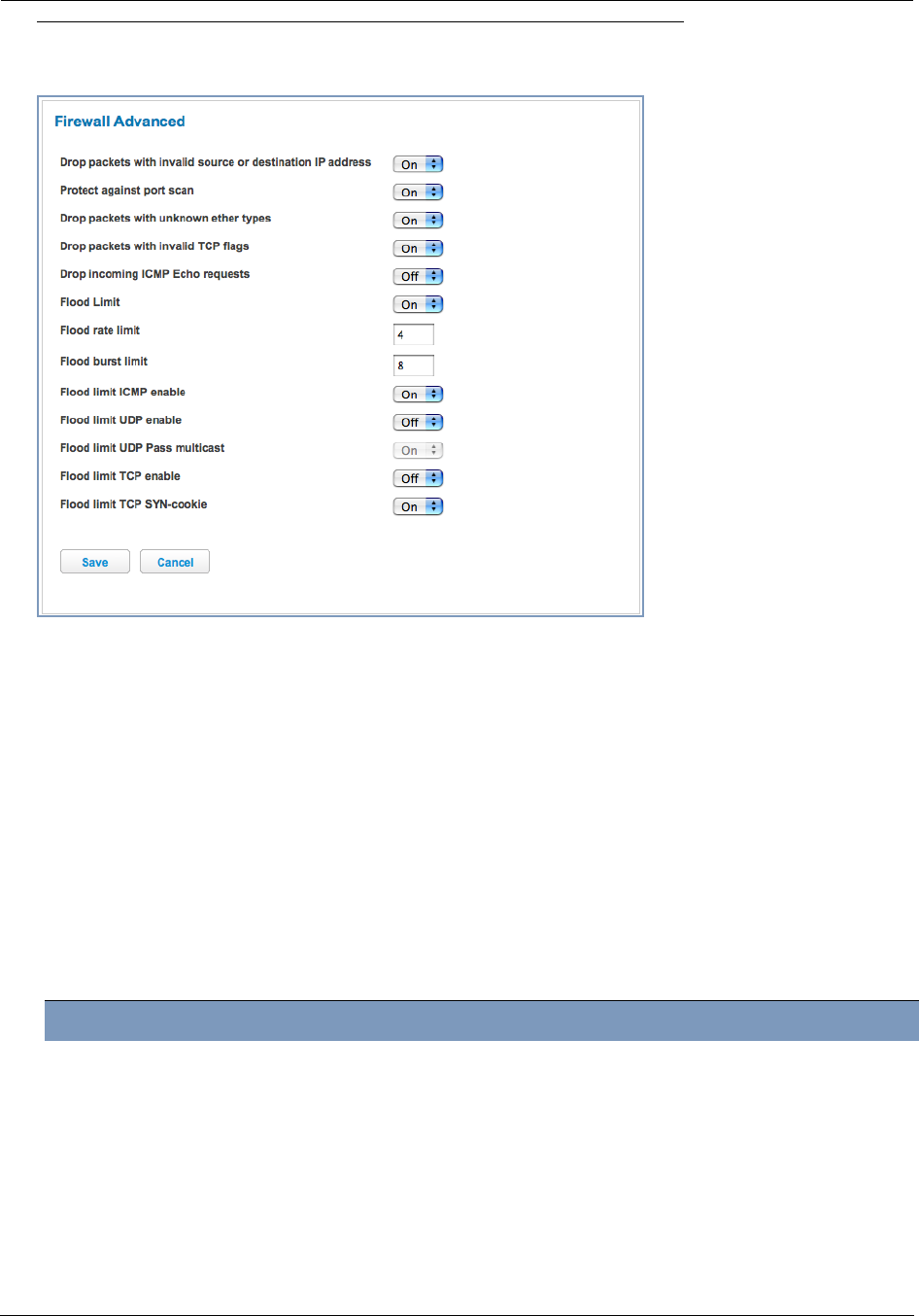
Administrator’s Handbook
78
Link: Firewall Advanced
When you click the Firewall Advanced link the Firewall Advanced screen appears.
All computer operating systems are vulnerable to attack from outside sources, typically at the operating system or
Internet Protocol (IP) layers. Stateful Inspection firewalls intercept and analyze incoming data packets to deter-
mine whether they should be admitted to your private LAN, based on multiple criteria, or blocked. Stateful inspec-
tion improves security by tracking data packets over a period of time, examining incoming and outgoing packets.
Outgoing packets that request specific types of incoming packets are tracked; only those incoming packets consti-
tuting a proper response are allowed through the firewall.
Stateful inspection is a security feature that prevents unsolicited inbound access when NAT is disabled. You can
configure UDP and TCP “no-activity” periods that will also apply to NAT time-outs if stateful inspection is enabled
on the interface. Stateful Inspection parameters are active on a WAN interface only if enabled on your Gateway.
Stateful inspection can be enabled on a WAN interface whether NAT is enabled or not.
DoS Protection – Denial-0f-Service attacks are common on the Internet, and can render an individual PC or a
whole network practically unusable by consuming all its resources. Your Gateway includes default settings to
block the most common types of DoS attacks. For special requirements or circumstances, a variety of additional
blocking characteristics is offered. See the following table.
Menu item Function
Drop packets with invalid source or
destination IP address
Whether packets with invalid source or destination IP address(es)
are to be dropped
Protect against port scan Whether to detect and drop port scans.
Drop packets with unknown ether
types
Whether packets with unknown ether types are to be dropped
Drop packets with invalid TCP flags Whether packets with invalid TCP flag settings (NULL, FIN, Xmas,
etc.) should be dropped
Drop incoming ICMP Echo
requests
Whether all ICMP echo requests are to be dropped; On or Off.

79
If you make any changes here, click the Save button.
Flood Limit Whether packet flooding should be detected and offending packets
be dropped; On or Off.
Flood rate limit Specifies the number limit of packets per second before dropping the
remainder.
Flood burst limit Specifies the number limit of packets in a single burst before dropping
the remainder.
Flood limit ICMP enable Whether ICMP traffic packet flooding should be detected and offend-
ing packets be dropped; On or Off.
Flood limit UDP enable Whether UDP traffic packet flooding should be detected and offend-
ing packets be dropped; On or Off.
Flood limit UDP Pass multicast Allows exclusion of UDP multicast traffic. On by default.
Flood limit TCP enable Allows exclusion of TCP traffic. Off by default.
Flood limit TCP SYN-cookie Allows TCP SYN cookies flooding to be excluded.
(Additional)
Neighbor Discovery Attack protec-
tion
Prevents downstream traffic from an upstream device that sends
excessive traffic but receives no replies; On or Off.
Reflexive ACL When IPv6 is enabled, Reflexive Access Control Lists can deny
inbound IPv6 traffic unless this traffic results from returning outgoing
packets (except as configured through firewall rules).
Menu item Function
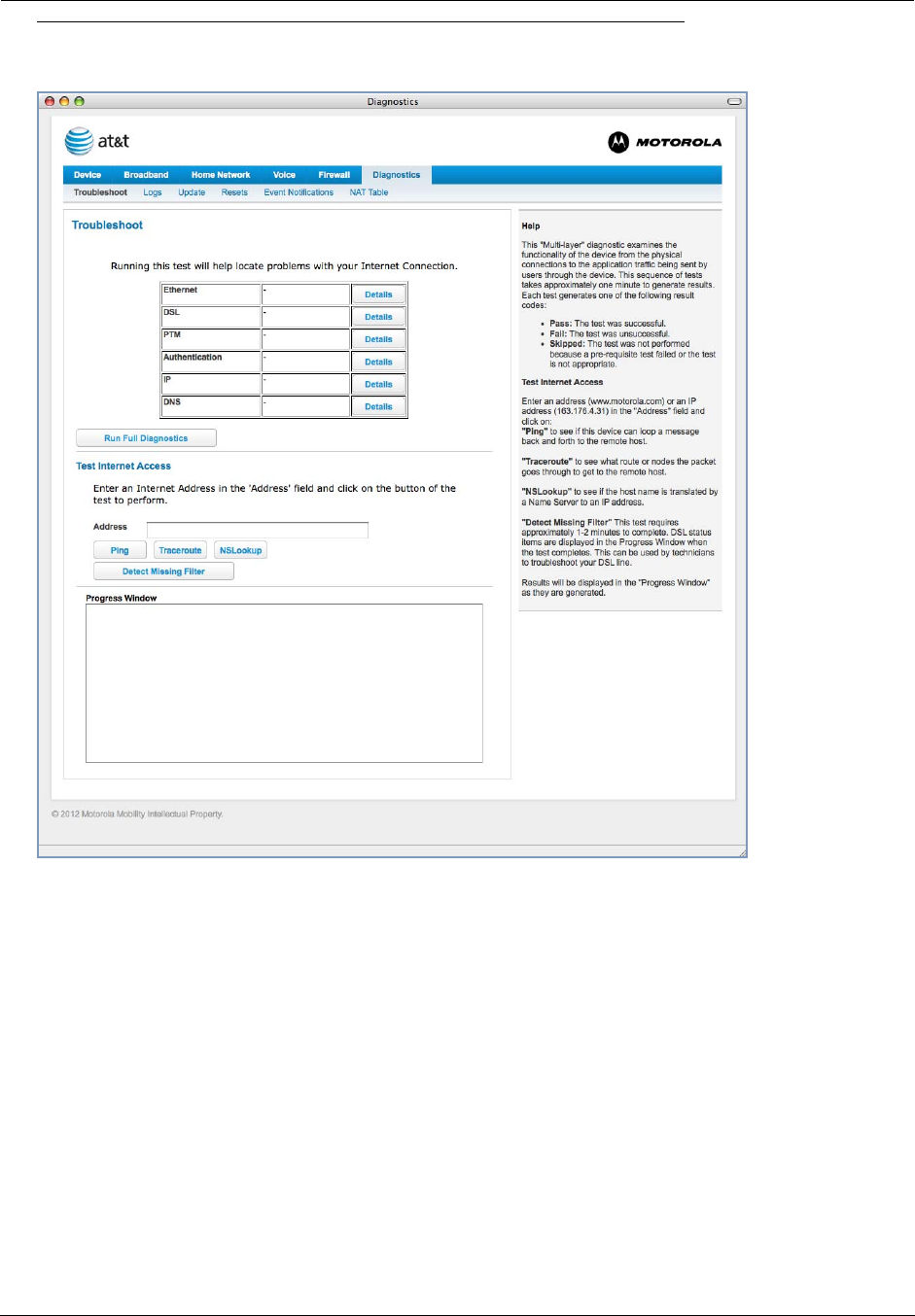
Administrator’s Handbook
80
Diagnostics
When you click the Diagnostics tab, the Troubleshoot page appears.
This automated multi-layer test examines the functionality of the Router from the physical connections to the data
traffic being sent by users through the Router.
You can run all the tests in order by clicking the Run Full Diagnostics button.
The device will automatically test a number of components to determine any problems. You can see detailed
results of the tests by clicking the Details buttons for each item.
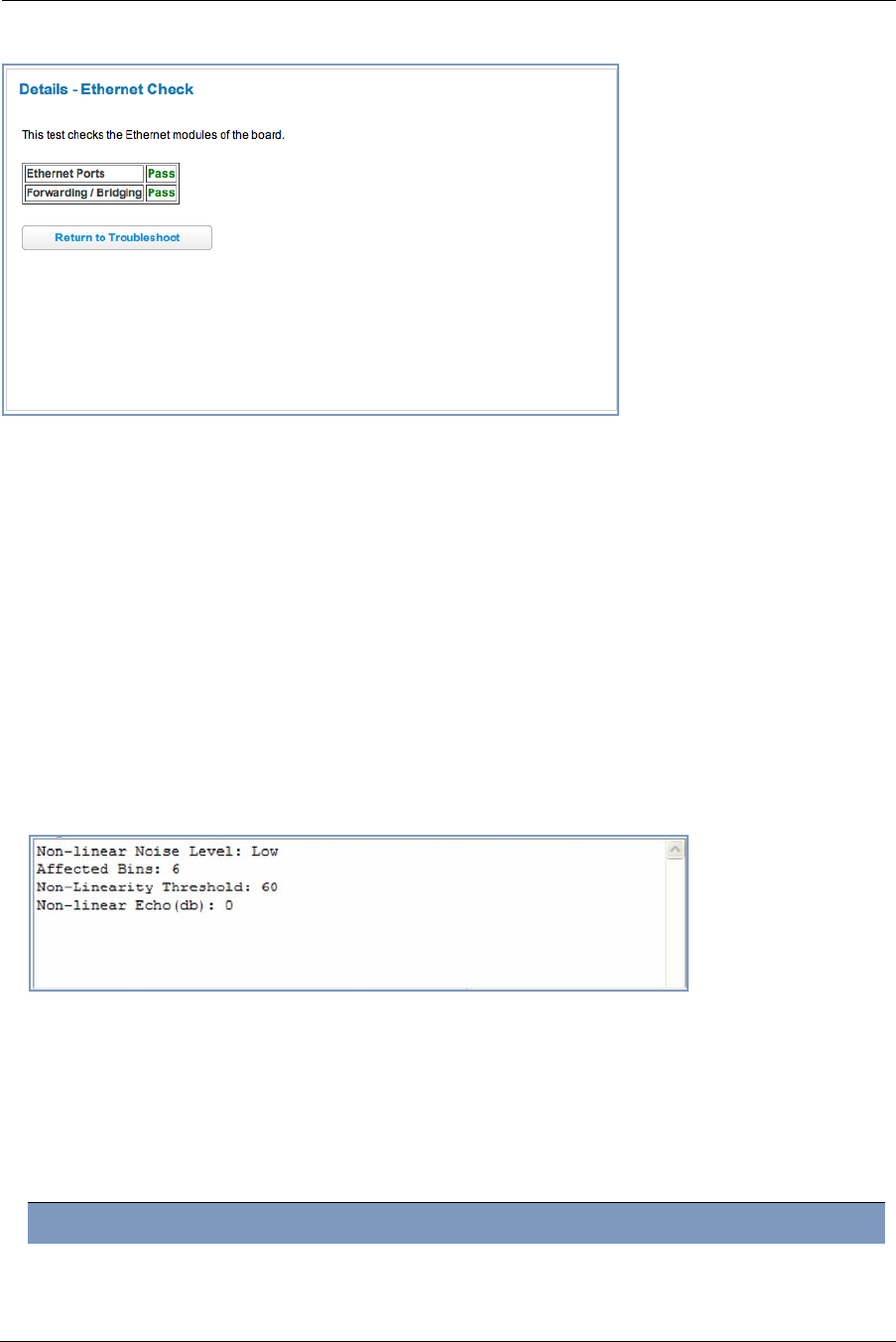
81
Here is an example of the Ethernet Details screen.
Test Internet Access
These tests send a PING from the modem to either the LAN or WAN to verify connectivity. A PING could be either
an IP address (163.176.4.32) or Domain Name (www.motorola.com). You enter a web address URL or an IP
address in the respective field.
Click the Ping, Trace, NSLookup, or Detect Missing Filter button.
Results will be displayed in the Progress Window as they are generated.
◆Ping - tests the “reachability” of a particular network destination by sending an ICMP echo request and waiting
for a reply.
◆Traceroute - displays the path to a destination by showing the number of hops and the router addresses of
these hops.
◆NSLookup - converts a domain name to its IP address and vice versa.
◆Detect Missing Filter - if you click the Detect Missing Filter button, a warning message appears at the top
since the detection takes up to 2 minutes. When completed the Progress area might look like following.
To use the Ping capability, type a destination address (domain name or IP address) in the text box and click the
Ping, Trace, or Lookup button. The results are displayed in the Progress Window.
This sequence of tests takes approximately one minute to generate results. Please wait for the test to run to com-
pletion.
Each test generates one of the following result codes:
Result Meaning
* PASS: The test was successful.
* FAIL: The test was unsuccessful.

Administrator’s Handbook
82
Below are some specific tests:
* SKIPPED: The test was skipped because a test on which it depended failed.
* PENDING: The test timed out without producing a result. Try running the test again.
* WARNING: The test was unsuccessful. The Service Provider equipment your Modem connects to
may not support this test.
Action If PING fails, possible causes are:
From the Check Connection page:
Ping the internet default gateway IP address DSL is down, DSL settings are incorrect; Gate-
way’s IP address or subnet mask are wrong; gate-
way router is down.
Ping an internet site by IP address Site is down.
Ping an internet site by name Servers are down; site is down.
From a LAN PC:
Ping the Modem’s LAN IP address IP address and subnet mask of PC are not on the
same scheme as the Modem; cabling or other con-
nectivity issue.
Ping an internet site by IP address PC's subnet mask may be incorrect, site is down.
Ping an internet site by name DNS is not properly configured on the PC, site is
down.
Result Meaning
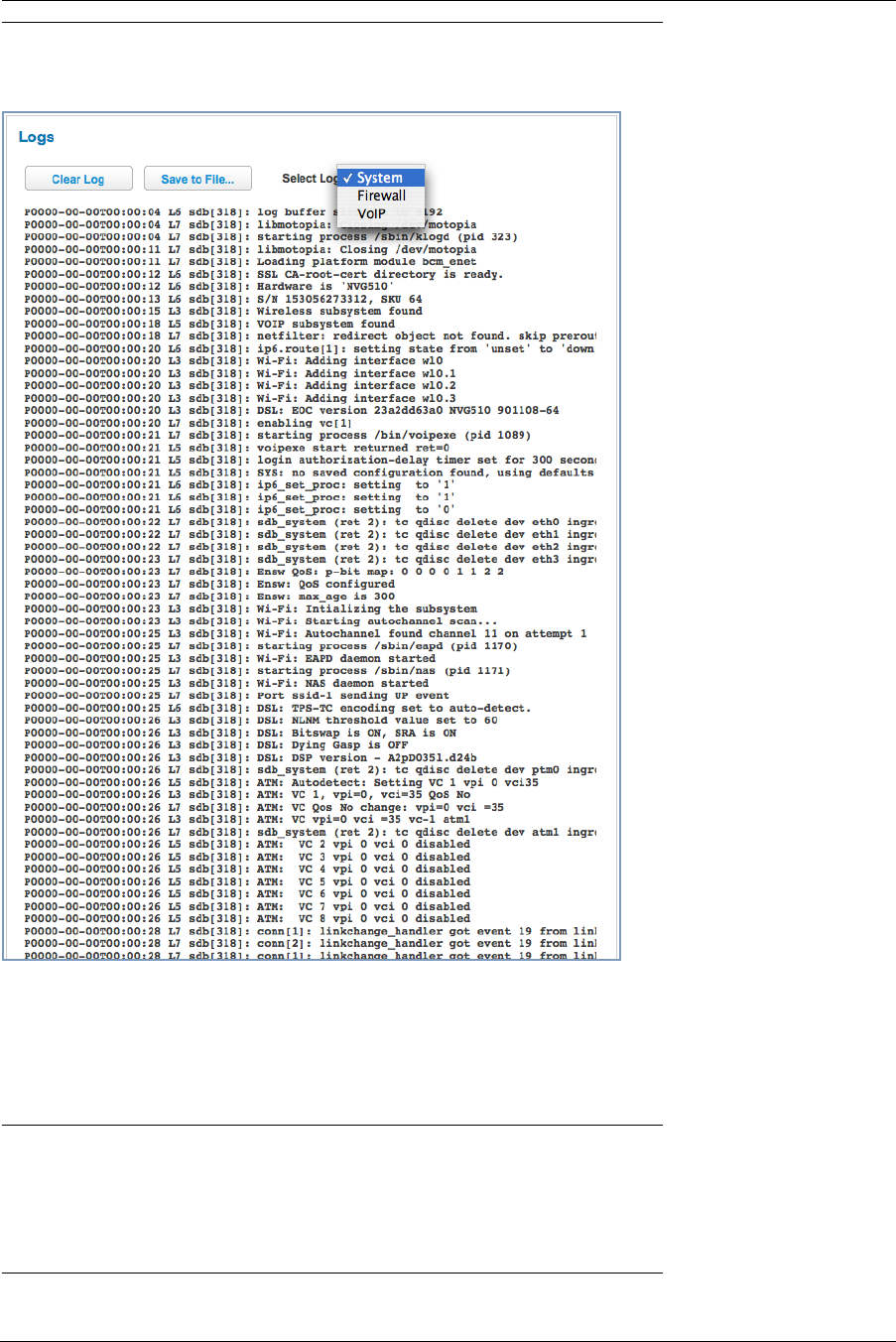
83
Link: Logs
When you click Logs, the Logs page appears.
The current status of the device is displayed for all logs: System, Firewall, or VoIP. Choose the log you want to
display from the pull-down menu.
◆You can clear all log entries by clicking the Clear Log button.
◆You can save logs to a text (.TXT) file by clicking the Save to File button. This will download the file to your
browser’s default download location on your hard drive. The file can be opened with your favorite text editor.
☛ Note:
Some browsers, such as Internet Explorer for Windows XP, require that you specify the Motorola®
device’s URL as a “Trusted site” in “Internet Options: Security”. This is necessary to allow the
“download” of the log text file to the PC.
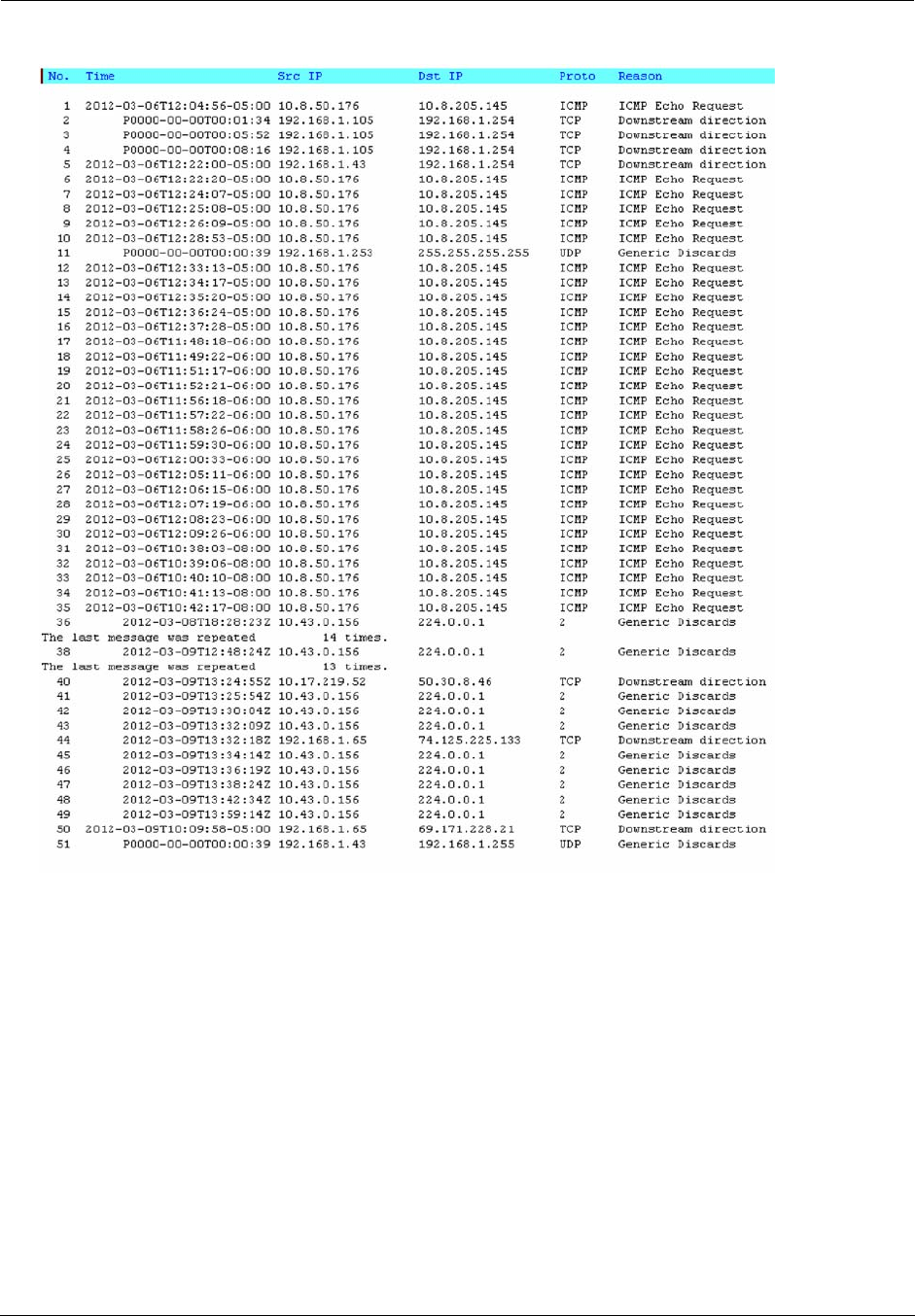
Administrator’s Handbook
84
The following is an example log portion saved as a .TXT file:
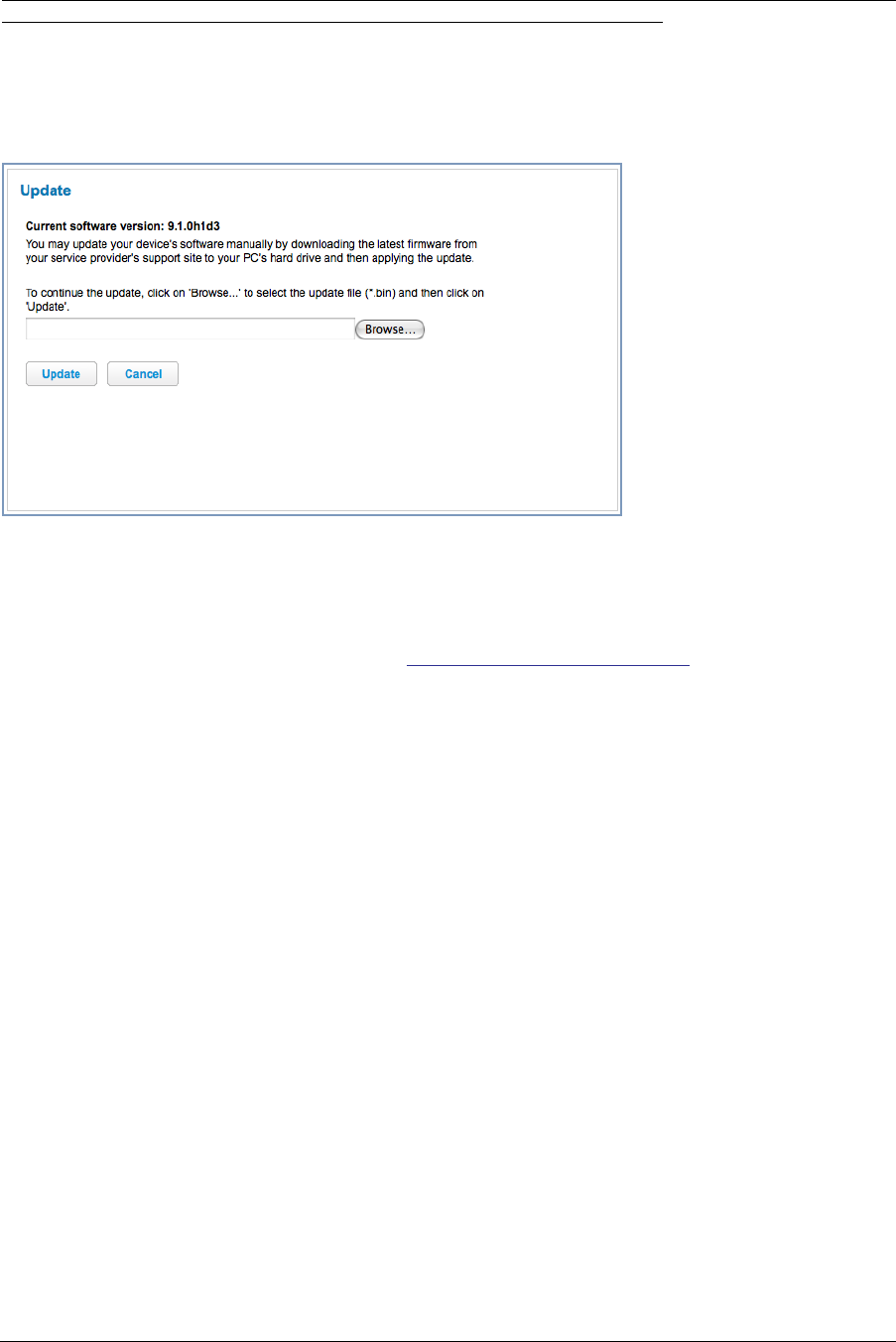
85
Link: Update
When you click Update, the Update page appears.
Operating System Software is what makes your Gateway run and occasionally it needs to be updated. Your Cur-
rent software version is displayed at the top of the page.
To update your software from a file on your PC, you must first download the software from your Service Provider's
Support Site to your PC's hard drive.
◆Browse your computer for the operating system file you downloaded and select the file.
◆Click the Update button.
The LEDs will operate normally as described in “Status Indicator Lights” on page 90.
◆The installation may take a few minutes and the web page will indicate a 3-part countdown before returning
you to the Home page; wait for it to complete. During the software installation, you will lose Internet and phone
service. The LEDs will function as follows:
During this phase, the LEDs will function as follows:
During this phase, the Power LED willl flash Orange/Amber during firmware upgrade (flash writing to mem-
ory) and all other LEDs will be off.
◆The Gateway will restart automatically.
As the device reboots, the POWER ON LED behavior will happen.
◆Your new operating system will then be running.
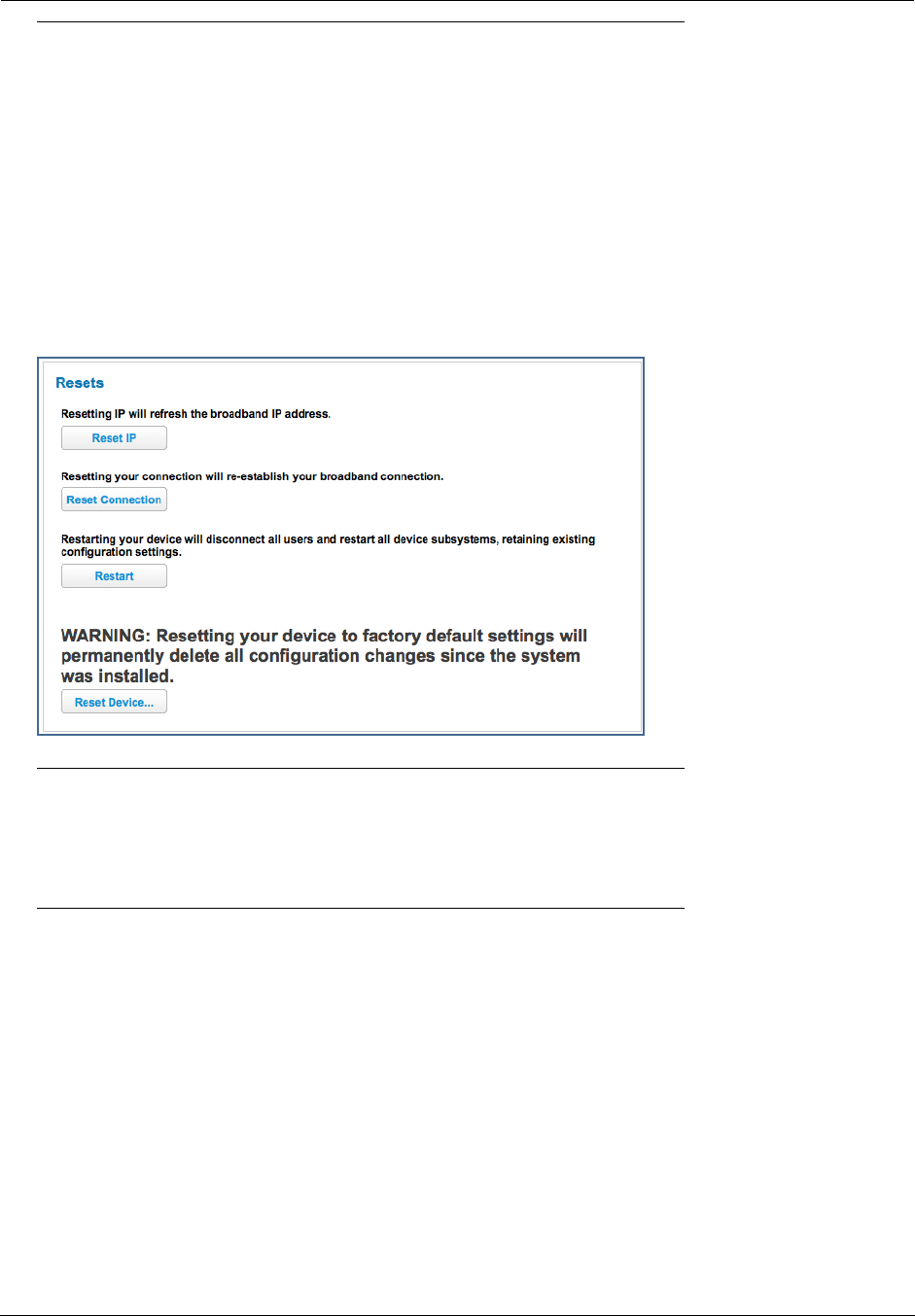
Administrator’s Handbook
86
Link: Resets
When you click Resets, the Resets page appears.
In some cases, you may need to clear all the configuration settings and start over again to program the Motorola®
Gateway. You can perform a factory reset to do this.
It might also be useful to reset your connection to the Internet without deleting all of your configuration settings.
◆Click the Reset IP to refresh your Internet WAN IP address. LAN-side users will be briefly disconnected from
the Internet, but will otherwise be unaffected.
◆Click the Reset Connection button to disconnect and reconnect all of your connections, including your VoIP
phones.
◆Click the Reset Device button to reset the Gateway back to its original factory default settings.
◆Click the Restart button to reboott the device. Previous configuration settings are still retained.
☛ NOTE:
Exercise caution before performing a Factory Reset. This will erase any configuration changes that
you may have made and allow you to reprogram your Gateway.
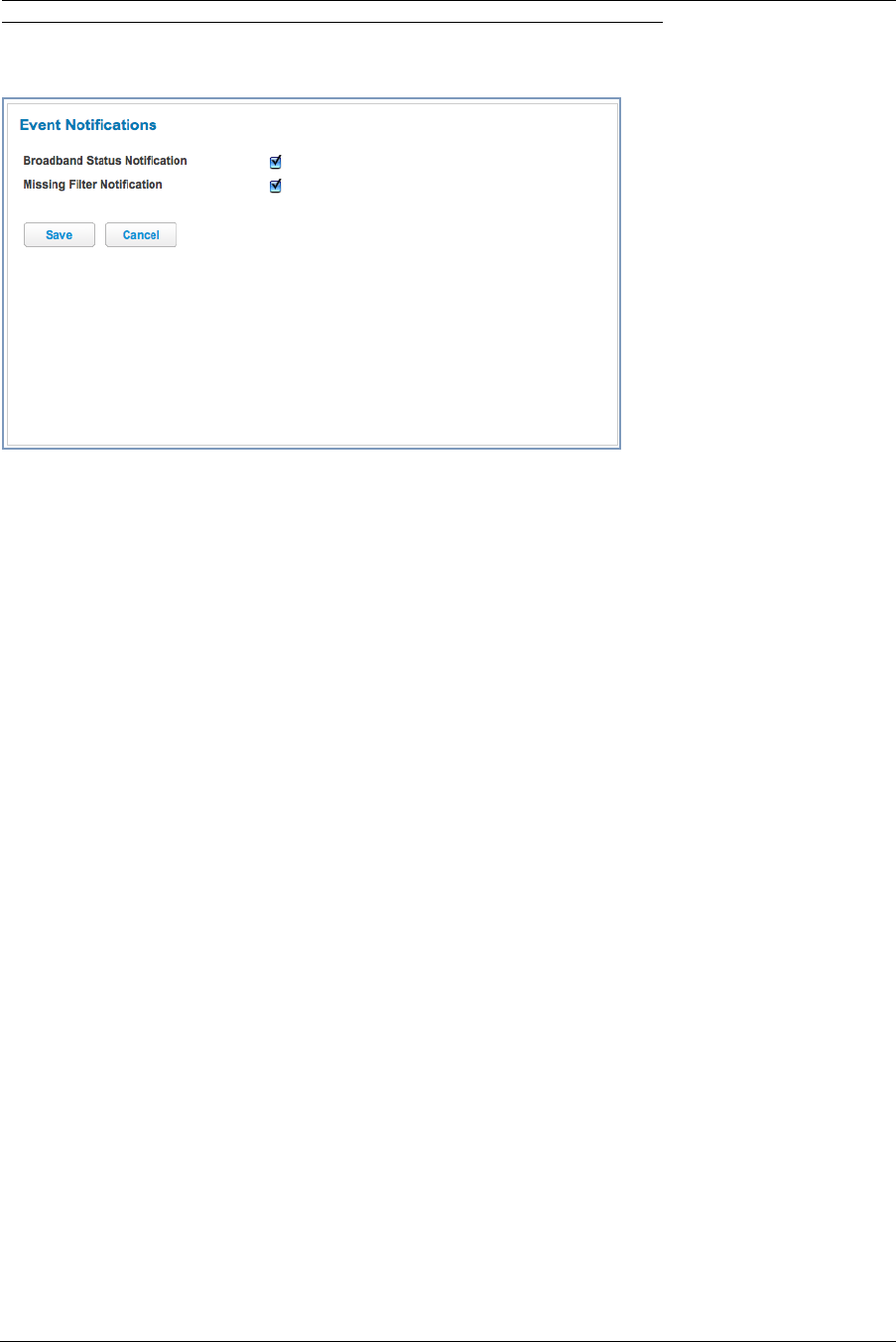
87
Link: Event Notifications
When you click Event Notifications, the Event Notifications page appears.
◆If you check the Broadband Status Notification checkbox, the device will alert users on your network if the
connection to the Internet should fail. In that event, troubleshooting suggestions will display.
◆If you check the Missing Filter Notification checkbox, the device will alert users on your network if hardware
line filters are either missing or improperly installed. In that event, troubleshooting suggestions will display.
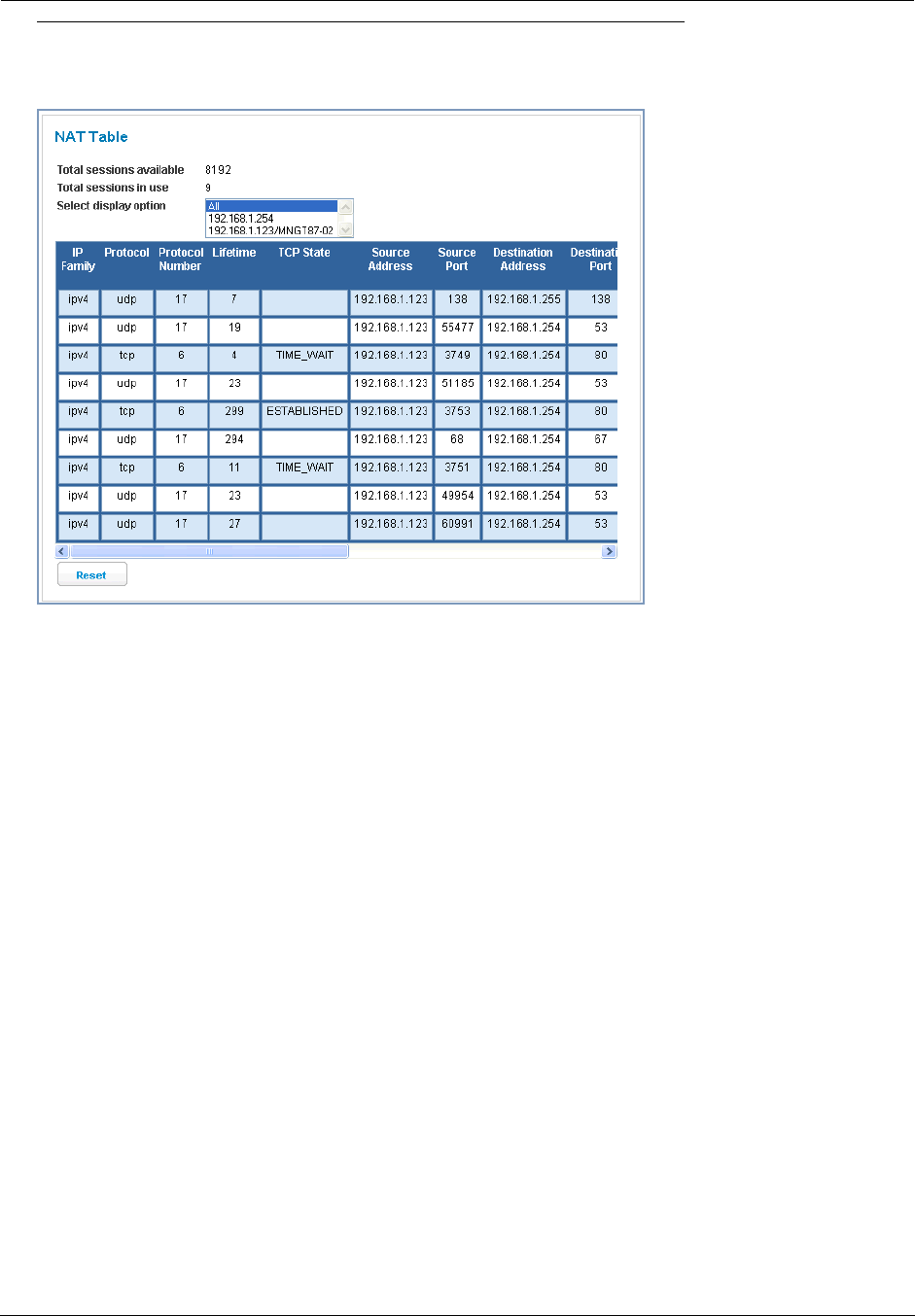
Administrator’s Handbook
88
Link: NAT Table
When you click the NAT Table link, the NAT Table page appears.
The NAT Table page displays the network address translation sessions in use by the Gateway. You can use the
pull-down menu to limit the displayed sessions to selected IP addresses.
To refresh all the sessions displayed, click the Reset button.

89
CHAPTER 3 Basic Troubleshooting
This section gives some simple suggestions for troubleshooting problems with your Gateway’s initial configura-
tion.
Before troubleshooting, make sure you have
◆read the User Manual;
◆plugged in all the necessary cables; and
◆set your PC’s TCP/IP controls to obtain an IP address automatically.
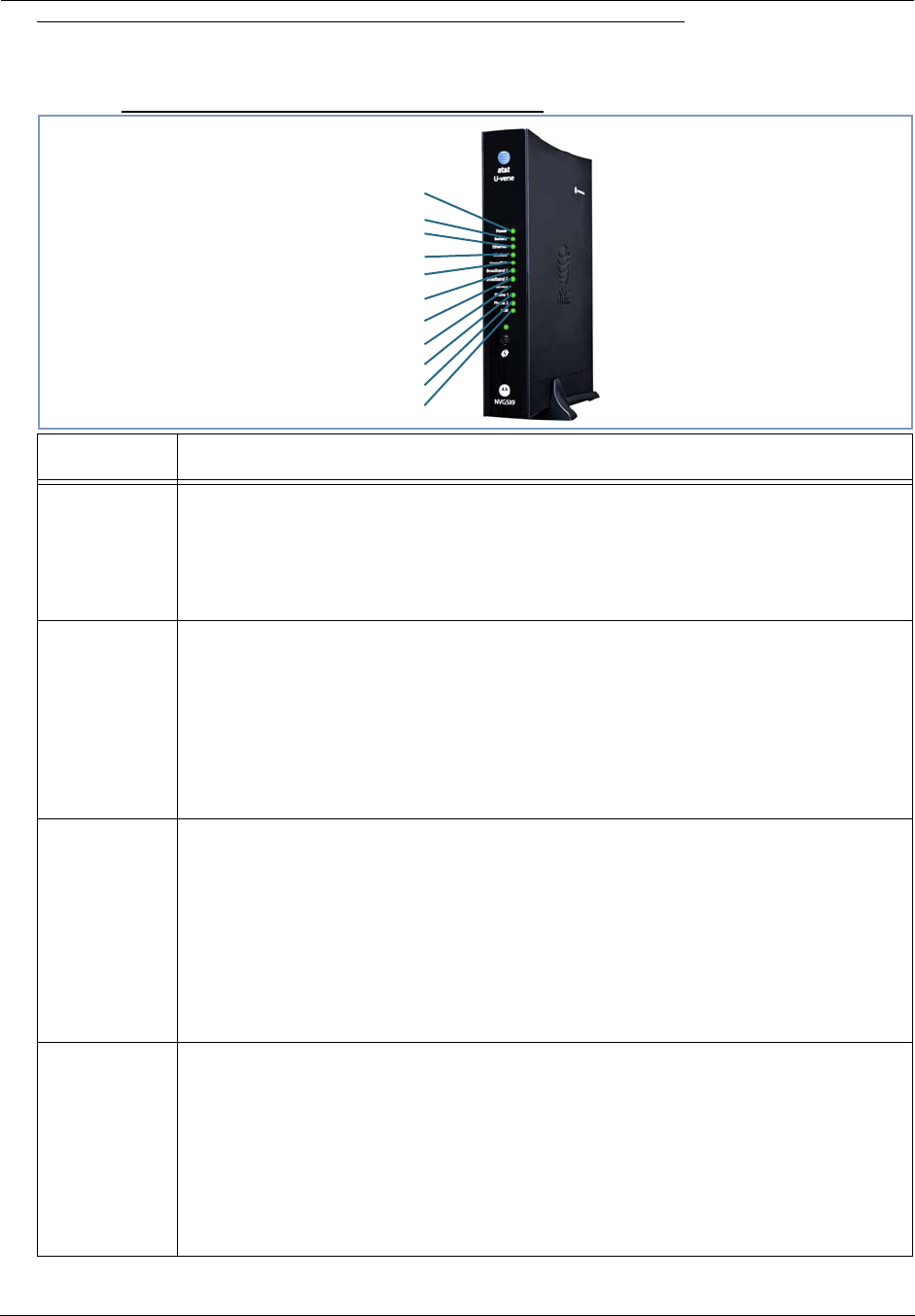
Administrator’s Handbook
90
Status Indicator Lights
The first step in troubleshooting is to check the status indicator lights (LEDs) in the order outlined below.
Motorola® Gateway NVG589 status indicator lights
LED Action
Power*
Solid Green = The device is powered.
Flashing Green = A Power-On Self-Test (POST) is in progress
Flashing Red = A POST failure (not bootable) or device malfunction occurred.
Orange/Amber = during firmware upgrade (see below)
Off = The unit has no AC power.
*During
Firmware
Upgrade
During the software installation, you will lose internet and phone service. The LEDs will func-
tion as follows:
1. As firmware is being loaded into flash, the LEDs will operate normally as described.
2. The installation will take a few minutes –
During this phase, the Power LED willl flash Orange/Amber during firmware upgrade
(flash writing to memory) and all other LEDs will be off.
3. The Gateway will restart automatically.
As the device reboots, the POWER ON LED behavior will happen.
During
Boot
process
• Power LED = GREEN/FLASH
• All other LED = OFF
If the device does not boot, and fails its self test or fails to perform initial load of the boot-
loader:
• Power LED = RED/FLASH
• ALL other LED = OFF
If the device boots and then detects a failure:
Power LED = GREEN/FLASH starting POST and then all LEDs will FLASH RED, including
Power LED.
Battery
Solid Green = Battery in place but not being used.
Flashing Green = Battery charging.
Solid Red = Battery backup mechanism has a fault.
Flashing Red = Battery needs to be replaced.
Solid Amber = Battery in use.
Flashing Amber = Low battery.
Off = No battery or battery has no charge.
Cycle between all colors = Battery conducting self-test.
Side View
Power
Battery
Ethernet
Wireless
HomePNA
USB
Broadband 1
Broadband 2
Service
Phone 1
Phone 2

91
Ethernet
Solid Green = Powered device connected to the associated port (includes devices with
wake-on-LAN capability where a slight voltage is supplied to the Ethernet connection).
Flickering Green = Activity seen from devices associated with the port. The flickering of the
light is synchronized to actual data traffic.
Off = The device is not powered, no cable or no powered devices connected to the associ-
ated ports.
Wireless
Solid Green = Wi-Fi is powered.
Flickering Green = Activity seen from devices connected via Wi-Fi. The flickering of the
light is synchronized to actual data traffic.
Off = The device is not powered or no powered devices connected to the associated ports.
HomePNA
Solid Green = Powered device connected to the associated port (includes devices with
wake-on-LAN capability where a slight voltage is supplied to the Ethernet connection).
Flickering Green = Activity seen from devices associated with the port. The flickering of the
light is synchronized to actual data traffic.
Off = The device is not powered, no cable or no powered devices connected to the associ-
ated ports.
Broadband
1**, 2
Solid Green = Good broadband connection (i.e., good DSL Sync or Gigabit Ethernet ).
Flashing Green = Attempting broadband connection (i.e., DSL attempting sync).
Flashing Green & Red = If the broadband connection fails to be established for more than
three consecutive minutes the LED switches to Flashing Green when attempting or waiting
to establish a broadband connection alternating with a five second steady Red. This pattern
continues until the broadband connection is successfully established.
Flashing Red = No DSL signal on the line. This is only used when there is no signal, not dur-
ing times of temporary ‘no tone’ during the training sequence.
Off = The device is not powered.
** Broadband 1 LED is also the Gigabit ethernet WAN LED when that is in play (and DSL is
not)
Service
Solid Green = IP connected (The device has a WAN IP address from DHCP or 802.1x
authentication and the broadband connection is
up).
Flashing Green = Attempting PPP connection. Attempting IEEE 802.1X authentication or
attempting to obtain DHCP information.
Red = Device attempted to become IP connected and failed (no DHCP response, 802.1x
authentication failed, no IP address from IPCP, etc.). The Red state times out after two min-
utes and the Service indicator light returns to the Off state.
Off = The device is not powered or the broadband connection is not present.
Phone 1, 2
Solid Green = The associated VoIP line has been registered with a SIP proxy server.
Flashing Green = Indicates a telephone is off-hook on the associated VoIP line.
Off = VoIP not in use, line not registered or Gateway power off.
USB
Solid Green = Powered device connected to the associated port (includes devices with
wake-on-LAN capability where a slight voltage is supplied to the Ethernet connection).
Flickering Green = Activity seen from devices associated with the port. The flickering of the
light is synchronized to actual data traffic.
Off = The device is not powered, no cable or no powered devices connected to the associ-
ated ports.
LED Action
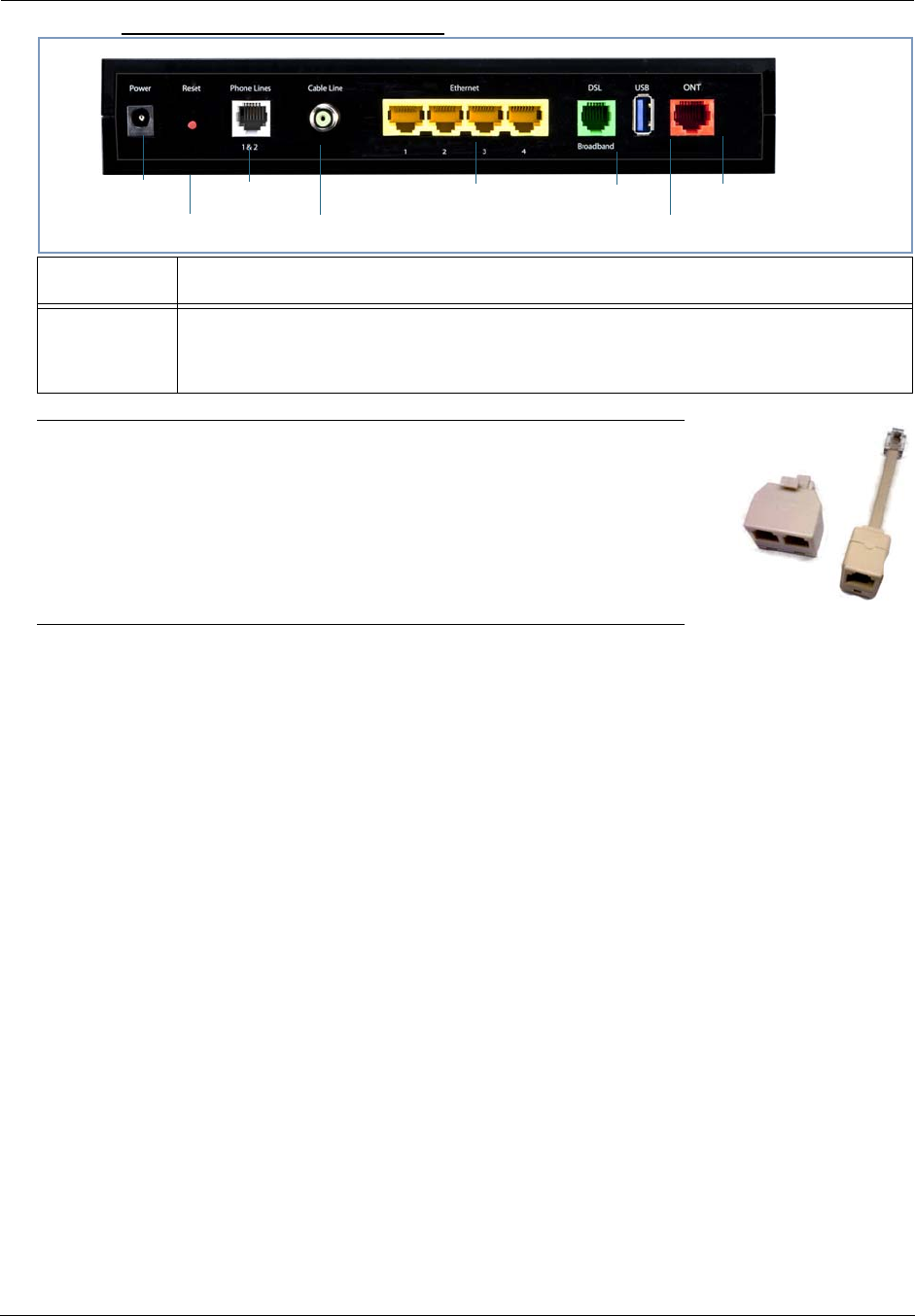
Administrator’s Handbook
92
Motorola® Gateway NVG589 Rear View
☛ NOTE:
The NVG589 supports two VoIP lines over one RJ11 VoIP port. In order to
connect two phone lines the supplied inner/outer pair splitter adapters
must be attached to the RJ11 VoIP port in order to terminate both lines.
This is a special-purpose splitter. You must only use the inner/outer pair
splitter adapters supplied by AT&T.
LED Action
Ethernet
1,2 3,4
Orange/Amber when a Gigabit Ethernet device is connected to each port.
Green when 10/100 Ethernet device is connected.
Flash for Ethernet traffic passing.
Gigabit Ethernet (WAN)
USB
DSL (WAN)Ethernet (LAN)
F-Connector (HPNA)
RJ14 (FXS)
Reset button
Power Jack

93
LED Function Summary Matrix
Power
Solid Green =
The device is
powered.
Flashing
Green = A
Power-On Self-
Test (POST) is
in progress
Flashing Red
= A POST fail-
ure (not boota-
ble) or device
malfunction
occurred.
* When the
device encoun-
ters a POST
failure, all indi-
cator lights on
the front of the
device continu-
ously flash.
Off = The unit
has no AC
power.
Ethernet
Solid Green =
Powered
device con-
nected to the
associated port
(includes
devices with
wake-on-LAN
capability
where a slight
voltage is sup-
plied to the
Ethernet con-
nection).
Flashing
Green = Activ-
ity seen from
devices associ-
ated with the
port. The flick-
ering of the light
is synchro-
nized to actual
data traffic.
Off = The
device is not
powered, no
cable or no
powered
devices con-
nected to the
associated
ports.
Wireless
Solid Green =
Wi-Fi is pow-
ered.
Flashing
Green = Activ-
ity seen from
devices con-
nected via Wi-
Fi. The flicker-
ing of the light
is synchro-
nized to actual
data traffic.
Off = The
device is not
powered or no
powered
devices con-
nected to the
associated
ports.
Phone 1, 2
Solid Green =
The associated
VoIP line has
been regis-
tered with a SIP
proxy server.
Flashing
Green = Indi-
cates a tele-
phone is off-
hook on the
associated
VoIP line.
Off = VoIP not
in use, line not
registered or
Gateway power
off.
WPS
Flashing
Green = Indi-
cates when
WPS is broad-
casting.
Off = not in
use, not broad-
casting.

Administrator’s Handbook
94
Broadband
Solid Green =
Good broad-
band connec-
tion (i.e., good
DSL Sync).
Flashing
Green =
Attempting
broadband con-
nection (i.e.,
DSL attempt-
ing sync).
Flashing
Green & Red =
If the broad-
band connec-
tion fails to be
established for
more than three
consecutive
minutes the
LED switches
to Flashing
Green when
attempting or
waiting to
establish a
broadband con-
nection alter-
nating with a
five second
steady Red.
This pattern
continues until
the broadband
connection is
successfully
established.
Flashing Red
= No DSL sig-
nal on the line.
This is only
used when
there is no sig-
nal, not during
times of tempo-
rary ‘no tone’
during the train-
ing sequence.
Off = The
device is not
powered.
Service
Solid Green =
IP connected
(The device has
a WAN IP
address from
DHCP or
802.1x authen-
tication and the
broadband con-
nection is up).
Flashing
Green =
Attempting PPP
connection.
Attempting
IEEE 802.1X
authentication
or attempting to
obtain DHCP
information.
Red = Device
attempted to
become IP con-
nected and
failed (no
DHCP
response,
802.1x authen-
tication failed,
no IP address
from IPCP,
etc.). The Red
state times out
after two min-
utes and the
Service indica-
tor light returns
to the Off state.
Off = The
device is not
powered or the
broadband con-
nection is not
present.

95
If a status indicator light does not look correct, look for these possible problems:
If LED is
not Lit Possible problems
Power
◆Make sure the power adapter is plugged into the DSL Modem properly.
◆Try a known good wall outlet.
◆If a power strip is used, make sure it is switched on.
Broadband
◆Make sure that any telephone has a microfilter installed.
◆Make sure that you are using the correct cable. The DSL cable is the thinner stan-
dard telephone cable and labeled “Data Cable.”
◆Make sure the DSL cable is plugged into the correct wall jack.
◆Make sure the DSL cable is plugged into the DSL port on the DSL Modem.
◆Make sure the DSL line has been activated at the central office DSLAM.
◆Make sure the DSL Modem is not plugged into a micro filter.
Ethernet
◆Make sure the you are using the yellow Ethernet cable, not the DSL cable. The
Ethernet cable is thicker than the standard telephone cable.
◆Make sure the Ethernet cable is securely plugged into the Ethernet jack on the PC.
◆Make sure the Ethernet cable is securely plugged into the Ethernet port on the DSL
Modem.
◆Make sure you have Ethernet drivers installed on the PC.
◆Make sure the PC’s TCP/IP Properties for the Ethernet Network Control Panel is set
to obtain an IP address via DHCP.
◆Make sure the PC has obtained an address in the 192.168.1.x range. (You may have
changed the subnet addressing.)
◆Make sure the PC is configured to access the Internet over a LAN.
◆Disable any installed network devices (Ethernet, HomePNA, wireless) that are not
being used to connect to the DSL Modem.
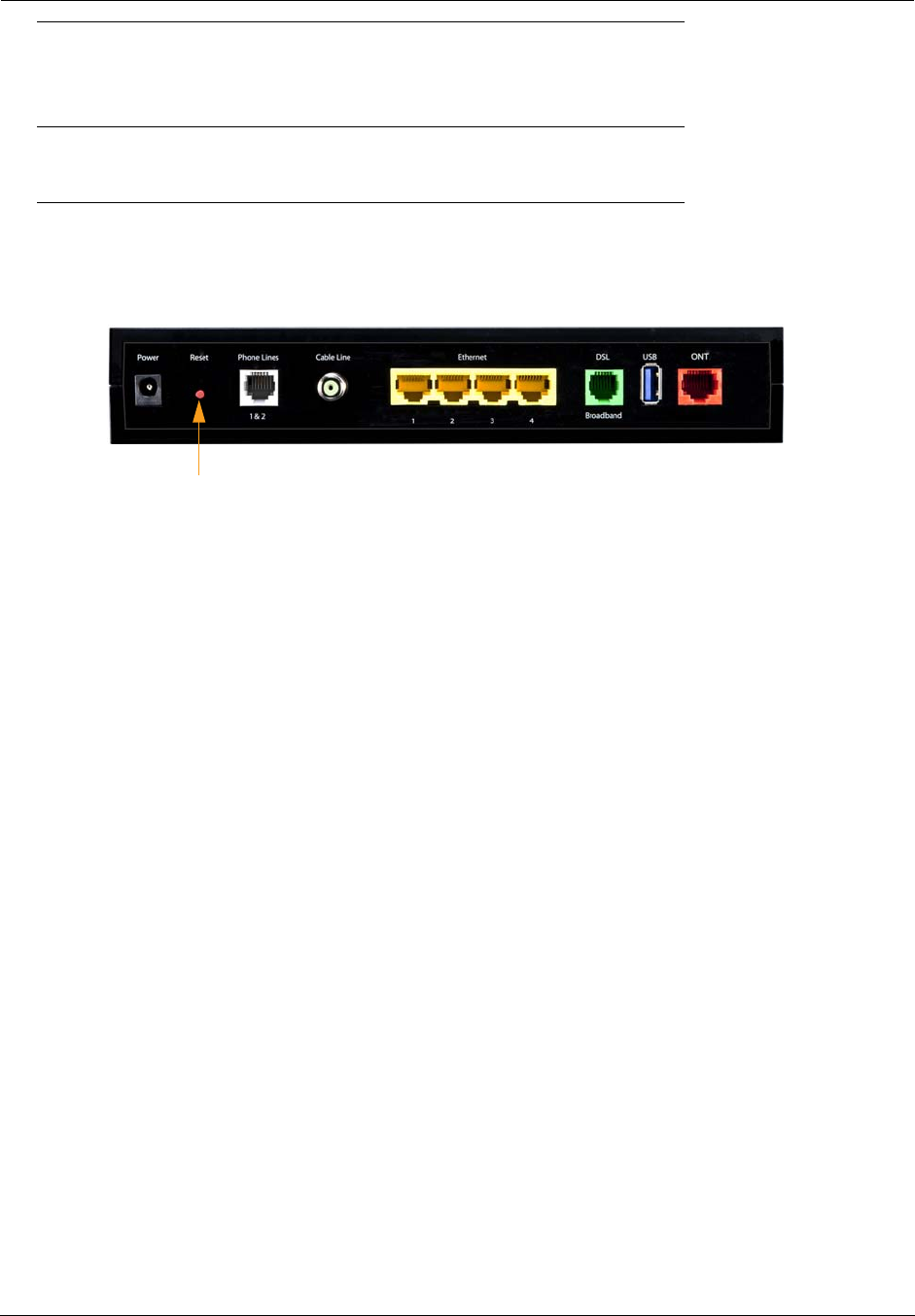
Administrator’s Handbook
96
Factory Reset Switch
Lose your Access Code? This section shows how to reset the Motorola® Gateway so that you can access the
configuration screens once again.
☛ NOTE: Keep in mind that all of your settings will need to be reconfigured.
If you don't have an Access Code, the only way to access the Motorola® Gateway is the following:
1. Referring to the diagram below, find the round Reset Switch opening.
2. Carefully insert the point of a pen or an unwound paperclip into the opening.
◆If you press the factory reset button for less than ten (10) seconds, the device will be rebooted.
The indicator lights on the device will respond immediately and start blinking red within one (1) second of the
reset button being pressed.
This will occur independent of the fact that the button is still being pressed or has been released. The indicator
lights will flash for a minimum of five seconds, even if the reset button is released prior to five seconds after it
has been depressed. If the reset button is held for more than 5 seconds, then it will continue to flash until
released or until 10 seconds (see below).
◆If you press the factory reset button for a longer period of time, the device will be reset to the factory default
shipped settings.
If the button is held for ten seconds, the Power indicator continues to flash, for an additional 5 seconds and
then the indicator lights will return to their normal operating mode, independent of whether or not the reset but-
ton is still depressed.
Factory Reset Switch: Push to clear all settings

97
Log Event Messages
Administration Related Log Messages
1. administrative access
attempted:
This log-message is generated whenever the user attempts to access
the router's management interface.
2. administrative access
authenticated and allowed:
This log-message is generated whenever the user attempts to access
the router's management interface and is successfully authenticated
and allowed access to the management interface.
3. administrative access
allowed:
If for some reason, a customer does not want password protection for
the management interface, this log-message is generated whenever
any user attempts to access the router's management interface and is
allowed access to the management interface.
4. administrative access
denied - invalid user name:
This log-message is generated whenever the user tries to access the
router's management interface and authentication fails due to incor-
rect user-name.
5. administrative access
denied - invalid password:
This log-message is generated whenever the user tries to access the
router's management interface and authentication fails due to incor-
rect password.
6. administrative access
denied - telnet access not
allowed:
This log-message is generated whenever the user tries to access the
router's Telnet management interface from a Public interface and is
not permitted since Remote Management is disabled.
7. administrative access
denied - web access not
allowed:
This log-message is generated whenever the user tries to access the
router's HTTP management interface from a Public interface and is
not permitted since Remote Management is disabled.
System Log Messages
1. Received NTP Date and
Time:
This log-message is generated whenever NTP receives Date and
time from the server.
2. EN: IP up: This log-message is generated whenever Ethernet WAN comes up.
3. WAN: Ethernet WAN1 acti-
vated at 100000 Kbps:
This log-message is generated when the Ethernet WAN Link is up.
4. Device Restarted: This log-message is generated when the router has been restarted.

Administrator’s Handbook
98
DSL Log Messages (most common):
1. WAN: Data link
activated at <Rate> Kbps (rx/
tx)
This log message is generated when the DSL link comes up.
2.WAN: Data link deactivated This log message is generated when the DSL link goes down.
3. RFC1483 up This log message is generated when RFC1483 link comes up.
4. RFC1483-<WAN-instance>:
IP down
This log message is generated when RFC1483 link goes down.
5. PPP: Channel <ID> up Dia-
lout Profile name: <Profile
Name>
This log message is generated when a PPP channel comes up.
6. PPP-<WAN Instance> down:
<Reason>
This log message is generated when a PPP channel goes down. The
reason for the channel going down is displayed as well.
Access-related Log Messages
1. permitted: This log-message is generated whenever a packet is allowed to
traverse router-interfaces or allowed to access the router itself.
2. attempt: This log-message is generated whenever a packet attempts to
traverse router-interfaces or attempts to access the router itself.
3. dropped - violation of secu-
rity policy:
This log-message is generated whenever a packet, traversing the
router or destined to the router itself, is dropped by the firewall
because it violates the expected conditions.
4. dropped - invalid checksum: This log-message is generated whenever a packet, traversing the
router or destined to the router itself, is dropped because of invalid IP
checksum.
5. dropped - invalid data
length:
This log-message is generated whenever a packet, traversing the
router or destined to the router itself, is dropped because the IP
length is greater than the received packet length or if the length is too
small for an IP packet.
6. dropped - fragmented
packet:
This log-message is generated whenever a packet, traversing the
router, is dropped because it is fragmented, stateful inspection is
turned ON on the packet's transmit or receive interface, and deny-
fragment option is enabled.
7. dropped - cannot fragment: This log-message is generated whenever a packet traversing the
router is dropped because the packet cannot be sent without frag-
mentation, but the do not fragment bit is set.
8. dropped - no route found: This log-message is generated whenever a packet, traversing the
router or destined to the router itself, is dropped because no route is
found to forward the packet.
9. dropped - invalid IP version: This log-message is generated whenever a packet, traversing the
router or destined to the router itself, is dropped because the IP ver-
sion is not 4.
10. dropped - possible land
attack:
This log-message is generated whenever a packet, traversing the
router or destined to the router itself, is dropped because the packet
is TCP/UDP packet and source IP Address and source port equals
the destination IP Address and destination port.

99
11. TCP SYN flood detected: This log-message is generated whenever a SYN packet destined to
the router's management interface is dropped because the number of
SYN-sent and SYN-receives exceeds one half the number of allow-
able connections in the router.
12. Telnet receive DoS attack -
packets dropped:
This log-message is generated whenever TCP packets destined to
the router's telnet management interface are dropped due to over-
whelming receive data.
13. dropped - reassembly time-
out:
This log-message is generated whenever packets, traversing the
router or destined to the router itself, are dropped because of reas-
sembly timeout.
14. dropped - illegal size: This log-message is generated whenever packets, traversing the
router or destined to the router itself, are dropped during reassembly
because of illegal packet size in a fragment.
Firewall Log Messages Detail (AT&T requirement #841)
Reason Enumeration ( C ) Log Text
Representation
Why the packet was
logged
NM_LOGDROP_CAT_DIR DIRECTION Direction (generic)
NM_LOGDROP_CAT_DIR_UP DIRECTION-UP Upstream direction
NM_LOGDROP_CAT_DIR_DOWN DIRECTION-DOWN Downstream direction
NM_LOGDROP_CAT_ETH ETH Ethernet Header (generic)
NM_LOGDROP_CAT_ETH_SRC_ADDR ETH-SRC Ethernet Source MAC Address
NM_LOGDROP_CAT_ETH_DST_ADDR ETH-DST Ethernet Destination MAC
Address
NM_LOGDROP_CAT_ETH_PROT ETH-PROTOCOL Ethernet Protocol
NM_LOGDROP_CAT_ETH_VLAN ETH-VLAN Ethernet VLAN ID (where appli-
cable)
NM_LOGDROP_CAT_IP IP IP Header (generic)
NM_LOGDROP_CAT_IP_SRC IP-SRC IP Source Address
NM_LOGDROP_CAT_IP_DST IP-DST IP Destination Address
NM_LOGDROP_CAT_IP_PROT IP-PROTOCOL IP Protocol
NM_LOGDROP_CAT_IP_SPOOF IP-SPOOF IP Address is spoofed (could not
have been sent by a device legit-
imately with the address in the
source address field)
NM_LOGDROP_CAT_IP_ILL IP-ILLEGAL IP Address is illegal (either src or
dest)
NM_LOGDROP_CAT_TCP TCP TCP Header (generic)
NM_LOGDROP_CAT_TCP_SRC_PORT TCP-SRC-PORT TCP Source Port
NM_LOGDROP_CAT_TCP_DST_PORT TCP-DST-PORT TCP Destination Port
NM_LOGDROP_CAT_TCP_FLAGS TCP-FLAGS TCP Flags field
NM_LOGDROP_CAT_UDP UDP UDP Header (generic)
NM_LOGDROP_CAT_UDP_SRC_PORT UDP-SRC-PORT UDP Source Port
NM_LOGDROP_CAT_UDP_DST_PORT UDP-DST-PORT UDP Destination Port
Access-related Log Messages

Administrator’s Handbook
100
NM_LOGDROP_CAT_ICMP ICMP ICMP Packet (generic)
NM_LOGDROP_CAT_ICMP_TYPE ICMP-TYPE ICMP Type Field
NM_LOGDROP_CAT_ICMP_CODE ICMP-CODE ICMP Code Field
NM_LOGDROP_CAT_ICMP6 ICMPv6 ICMPv6 (generic)
NM_LOGDROP_CAT_POLICY POLICY Policy (generic). This currently
includes filterset rules, restricted
hosts, IPv6 Profiles.
NM_LOGDROP_CAT_POLICY_INPUT POLICY-INPUT-GEN-
DISCARD
Packets destined for the CPE
that are generically discarded
(we specify the packets we DO
want; the rest are discarded.)
NM_LOGDROP_CAT_POLICY_WAN_M
GMT
POLICY-WAN-MGMT-
ACCESS
1) Trying to access CPE service
from WAN side using LAN-side
port
2) Trying to access CPE service
from LAN side using WAN-side
IP address
3) Trying to access CPE service
from WAN side using IPv6
NM_LOGDROP_CAT_POLICY_ICMP_E
CHO
POLICY-ICMP-ECHO ICMP Echo Request discarded
(more specific than
NM_LOGDROP_CAT_ICMP_TY
PE)
NM_LOGDROP_CAT_POLICY_UWC_R
ESTRICT
POLICY-UWC-RESTRICT Packets dropped because of
“Universal Wi-Fi Configuration”
restrictions (currently unused)
NM_LOGDROP_CAT_POLICY_RESTRI
CTED_HOST
POLICY-RESTRICTED-
HOST
Packets dropped because of
“Restricted Host” feature (either
content or time restrictions) (cur-
rently unused)
NM_LOGDROP_CAT_POLICY_WAN_D
NS_QUERY
POLICY-WAN-SIDE-DNS-
QUERY
DNS query packets received on
a WAN interface
NM_LOGDROP_CAT_POLICY_WAN_D
HCP_TOSRVR
POLICY-WAN-SIDE-
DHCP-TO-SRVR
DHCP DISCOVER/REQUEST
received on a WAN interface
NM_LOGDROP_CAT_POLICY_AH POLICY-IPV6-AH IPv6 Packets with AH Header (if
so configured)
NM_LOGDROP_CAT_POLICY_ESP POLICY-IPV6-ESP IPv6 Packets with ESP Header
(if so configured)
NM_LOGDROP_CAT_POLICY_DEP_HE
ADER
POLICY-DEPRECATED-
HEADER
IPv6 Packets with deprecated
header (currently this only
includes routing extension
header type 0)
NM_LOGDROP_CAT_POLICY_CAPT_P
ORTAL
POLICY-CAPTIVE-POR-
TAL
[IPv6] Packets dropped because
captive portal is enabled.
NM_LOGDROP_CAT_FLOW FLOW Packets rejected as a result of
analysis of multiple related pack-
ets (generic)
Firewall Log Messages Detail (AT&T requirement #841)
Reason Enumeration ( C ) Log Text
Representation
Why the packet was
logged

101
NM_LOGDROP_CAT_FLOW_FLOOD FLOOD Packets rejected because of
flood-limiting
NM_LOGDROP_CAT_FLOW_PORTSCA
N
PORTSCAN Packets rejected because of
Port-scan detection
NM_LOGDROP_CAT_FLOW_DOS_OTH
ER
OTHER-DoS Packets rejected because of
other DoS detection. Currently
this includes downstream flows
that don't generate upstream
responses - specifically address-
ing IPv6 Neighbor Discovery
DoS attacks.
Firewall Log Messages Detail (AT&T requirement #841)
Reason Enumeration ( C ) Log Text
Representation
Why the packet was
logged

Administrator’s Handbook
102

103
CHAPTER 4 Command Line Interface
The Motorola Gateway operating software includes a command line interface (CLI) that lets you access your
Motorola Gateway over a telnet connection. You can use the command line interface to enter and update the unit’s
configuration settings, monitor its performance, and restart it.
This chapter covers the following topics:
◆“Overview” on page 105
◆“Starting and Ending a CLI Session” on page 107
◆“Using the CLI Help Facility” on page 107
◆“About SHELL Commands” on page 108
◆“SHELL Commands” on page 109
◆“About CONFIG Commands” on page 118
◆“CONFIG Commands” on page 121
◆“Debug Commands” on page 171

Administrator’s Handbook
104
CONFIG Commands
“Connection commands” on page 121
“Filterset commands” on page 124
“Queue commands” on page 128
“IP Gateway commands” on page 130
“IPv6 Commands” on page 130
“IP DNS commands” on page 138
“IP IGMP commands” on page 139
“NTP commands” on page 141
“Application Layer Gateway (ALG) commands” on page 142
“Dynamic DNS Commands” on page 142
“Link commands” on page 143
“Management commands” on page 146
“Remote access commands” on page 148
“Physical interfaces commands” on page 150
“PPPoE relay commands” on page 156
“NAT Pinhole commands” on page 157
“Security Stateful Packet Inspection (SPI) commands” on page 157
“VoIP commands” on page 159
“System commands” on page 167

105
Overview
The CLI has two major command modes: SHELL and CONFIG. Summary tables that list the commands are pro-
vided below. Details of the entire command set follow in this section.
SHELL Commands
Command Status and/or Description
arp to send ARP request
clear to erase all stored configuration information
clear_certificate to remove an SSL certificate that has been installed
clear_log to erase all stored log info in flash memory
configure to configure unit's options
diagnose to run self-test
download to download config file
exit to quit this shell
help to get more: “help all” or “help help”
install to download and program an image into flash
log to add a message to the diagnostic log
loglevel to report or change diagnostic log level
netstat to show IP information
nslookup to send DNS query for host
ping to send ICMP Echo request
quit to quit this shell
reset to reset subsystems
restart to restart unit
show to show system information
start to start subsystem
status to show basic status of unit
telnet to telnet to a remote host
traceroute to send traceroute probes
upload to upload config file
view to show configuration information
who to show who is using the shell

Administrator’s Handbook
106
CONFIG Commands
Command Verbs Status and/or Description
delete Delete configuration list data
help Help command option
save Save configuration data
script Print configuration data
set Set configuration data
validate Validate configuration settings
view View configuration data
Keywords
conn Connection options
ip TCP/IP protocol options
dns Domain Name System options
igmp IGMP configuration options
ntp Network Time Protocol options
gateway Gateway options
link WAN link options
mgmt System management options
phy Physical interface options
dsl DSL configuration options
enet Ethernet options
pinhole Pinhole options
system Gateway’s system options
log System activity logging options
Command Utilities
top Go to top level of configuration mode
quit Exit from configuration mode; return to shell mode
exit Exit from configuration mode; return to shell mode

107
Starting and Ending a CLI Session
Open a telnet connection from a workstation on your network.
You initiate a telnet connection by issuing the following command from an IP host that supports telnet, for exam-
ple, a personal computer running a telnet application such as NCSA Telnet.
telnet <
ip_address
>
You must know the IP address of the Motorola Gateway before you can make a telnet connection to it. By default,
your Motorola Gateway uses 192.168.1.254 as the IP address for its LAN interface. You can use a Web browser
to configure the Motorola Gateway IP address.
Logging In
The command line interface log-in process emulates the log-in process for a UNIX host. To logon, enter the user-
name and your password.
Entering the administrator password lets you display and update all Motorola Gateway settings.
When you have logged in successfully, the command line interface lists the username and the security level asso-
ciated with the password you entered in the diagnostic log.
Ending a CLI Session
You end a command line interface session by typing quit from the SHELL node of the command line interface
hierarchy.
Using the CLI Help Facility
The help command lets you display on-line help for SHELL and CONFIG commands. To display a list of the com-
mands available to you from your current location within the command line interface hierarchy, enter help or
type a question mark (?).
To obtain help for a specific CLI command, type help <command>. You can truncate the
help
command to
h
or a question mark when you request help for a CLI command.

Administrator’s Handbook
108
About SHELL Commands
You begin in SHELL mode when you start a CLI session. SHELL mode lets you perform the following tasks with
your Motorola Gateway:
◆Monitor its performance
◆Display and reset Gateway statistics
◆Issue administrative commands to restart Motorola Gateway functions
SHELL Prompt
When you are in SHELL mode, the CLI prompt is the name of the Motorola Gateway followed by a right angle
bracket (>). For example, if you open a CLI connection to the Motorola Gateway named “Motorola-3000/
9437188,” you would see
Motorola-3000/9437188>
as your CLI prompt.
SHELL Command Shortcuts
You can truncate most commands in the CLI to their shortest unique string. For example, you can use the trun-
cated command
q
in place of the full
quit
command to exit the CLI. However, you would need to enter
rese
for
the
reset
command, since the first characters of
reset
are common to the
restart
command.
The only commands you cannot truncate are
restart
and
clear
. To prevent accidental interruption of communi-
cations, you must enter the
restart
and
clear
commands in their entirety.
You can use the Up and Down arrow keys to scroll backward and forward through recent commands you have
entered. Alternatively, you can use the
!!
command to repeat the last command you entered.

109
SHELL Commands
Common Commands
arp nnn.nnn.nnn.nnn
Sends an Address Resolution Protocol (ARP) request to match the
nnn.nnn.nnn.nnn
IP address to an
Ethernet hardware address.
clear [ yes ]
Clears the configuration settings in a Motorola Gateway. You are prompted to confirm the clear command by
entering yes.
clear_certificate
Removes an SSL certificate that has been installed.
configure
Puts the command line interface into Configure mode, which lets you configure your Motorola Gateway with Con-
fig commands. Config commands are described starting on page 121.
download [ server_address ] [ filename ] [ confirm ]
This command installs a file of configuration parameters into the Motorola Gateway from a TFTP (Trivial File
Transfer Protocol) server. The TFTP server must be accessible on your Ethernet network.
You can include one or more of the following arguments with the download command. If you omit arguments, the
console prompts you for this information.
◆The
server_address
argument identifies the IP address of the TFTP server from which you want to copy
the Motorola Gateway configuration file.
◆The
filename
argument identifies the path and name of the configuration file on the TFTP server.
◆If you include the optional confirm keyword, the download begins as soon as all information is entered.
You can also download an SSL certificate file from a trusted Certification Authority (CA), on platforms that support
SSL, as follows:
download [-cert] [server_address ] [filename] [confirm]
install [ server_address ] [ filename ] [ confirm ]
Downloads a new version of the Motorola Gateway operating software from a TFTP (Trivial File Transfer Protocol)
server, validates the software image, and programs the image into the Motorola Gateway memory. After you install
new operating software, you must restart the Motorola Gateway.
The
server_address
argument identifies the IP address of the TFTP server on which your Motorola Gateway
operating software is stored. The
filename
argument identifies the path and name of the operating software file
on the TFTP server.
If you include the optional keyword
confirm
, you will not be prompted to confirm whether or not you want to per-
form the operation.

Administrator’s Handbook
110
log message_string
Adds the message in the
message_string
argument to the Motorola Gateway diagnostic log.
loglevel [ level ]
Displays or modifies the types of log messages you want the Motorola Gateway to record. If you enter the
loglevel command without the optional
level
argument, the command line interface displays the current
log level setting.
You can enter the loglevel command with the
level
argument to specify the types of diagnostic messages
you want to record. All messages with a level number equal to or greater than the level you specify are recorded.
For example, if you specify loglevel 3, the diagnostic log will retain high-level informational messages (level 3),
warnings (level 4), and failure messages (level 5).
Use the following values for the
level
argument:
◆1 or low – Low-level informational messages or greater; includes trivial status messages.
◆2 or medium – Medium-level informational messages or greater; includes status messages that can help
monitor network traffic.
◆3 or high – High-level informational messages or greater; includes status messages that may be significant
but do not constitute errors.
◆4 or warning – Warnings or greater; includes recoverable error conditions and useful operator informa-
tion.
◆5 or failure – Failures; includes messages describing error conditions that may not be recoverable.
netstat -i
Displays the IP interfaces for your Motorola Gateway.
netstat -r
Displays the IP routes stored in your Motorola Gateway.
nslookup [ hostname | ip_address ]
Performs a domain name system lookup for a specified host.
◆The
hostname
argument is the name of the host for which you want DNS information; for example,
nslookup klaatu
.
◆The
ip_address
argument is the IP address, in dotted decimal notation, of the device for which you want
DNS information.
ping [-s size] [-c count ] [ hostname | ip_address ]
Causes the Motorola Gateway to issue a series of ICMP Echo requests for the device with the specified name or
IP address.
◆The
hostname
argument is the name of the device you want to ping; for example,
ping ftp.motorola.com
.
◆The
ip_address
argument is the IP address, in dotted decimal notation, of the device you want to locate. If
a host using the specified name or IP address is active, it returns one or more ICMP Echo replies, confirming
that it is accessible from your network.
◆The
-s
size
argument lets you specify the size of the ICMP packet.
◆The
-c
count
argument lets you specify the number of ICMP packets generated for the ping request. Values
greater than 250 are truncated to 250.

111
You can use the ping command to determine whether a hostname or IP address is already in use on your net-
work. You cannot use the ping command to ping the Motorola Gateway’s own IP address.
quit
Exits the Motorola Gateway command line interface.
reset arp
Clears the Address Resolution Protocol (ARP) cache on your unit.
reset crash
Clears crash-dump information, which identifies the contents of the Motorola Gateway registers at the point of sys-
tem malfunction.
reset dhcp server
Clears the DHCP lease table in the Motorola Gateway.
reset enet [ all ]
Resets Ethernet statistics to zero. Resets individual LAN switch port statistics as well as wireless and WAN Ether-
net statistics (where applicable).
reset firewall-log
Rewinds the firewall log to the first entry.
reset ipmap
Clears the IPMap table (NAT).
reset log
Rewinds the diagnostic log display to the top of the existing Motorola Gateway diagnostic log. The reset log
command does not clear the diagnostic log. The next show log command will display information from the
beginning of the log file.
reset wan
This function resets WAN interface statistics.
reset wepkeys
This function allows you to force your wireless WEP key settings back to the default values, if there are default val-
ues. For example, on some models, the WEP keys are based on the serial number. This allows you to get back
those default settings if you have changed them without the need to reset the entire configuration of the unit.
restart [ seconds ]
Restarts your Motorola Gateway. If you include the optional
seconds
argument, your Motorola Gateway will
restart when the specified number of seconds have elapsed. You must enter the complete restart command
to initiate a restart.

Administrator’s Handbook
112
show all-info
Displays all settings currently configured in the Motorola Gateway.
show bridge interfaces
Displays bridge interfaces maintained by the Motorola Gateway.
show bridge table
Displays the bridging table maintained by the Motorola Gateway.
show config
Dumps the Motorola Gateway’s configuration script just as the script command does in config mode.
show crash
Displays the most recent crash information, if any, for your Motorola Gateway.
show daylight-savings
Displays the auto-daylight savings time settings information.
show dhcp agent
Displays DHCP relay-agent leases.
show dhcp server leases
Displays the DHCP leases stored in RAM by your Motorola Gateway.
show dhcp client
Displays the DHCP clients stored in RAM by your Motorola Gateway.
show diffserv
Displays the Differentiated Services and QoS values configured in the Motorola Gateway.
show dsl [ all ]
Displays DSL port statistics, such as upstream and downstream connection rates and noise levels.
show dslf device-association
Displays LAN devices that conform with the TR111 Gateway requirement. It displays - IP Address, Manufacture
OUI and Serial number.
show enet [ all ]
Displays Ethernet interface statistics maintained by the Motorola Gateway. Supports display of individual LAN
switch port statistics as well as WAN Ethernet statistics (where applicable).

113
Example:
Ethernet driver full statistics - 10/100 Ethernet
Port Status: Link up
Type: 100BASET Duplex: Full
General:
Transmit OK : 434
Receive OK : 267
Tx Errors : 0
Rx Errors : 0
Receiver:
Incompl Packet Errors : 0
No RBD's For Packet : 0
Carrier Sense Lost : 0
Deferred Replen : 0
Transmitter:
TX Retries : 0
Single Collisions : 0
No Buf For Packet : 0
Upper Layers:
Rx No Handler : 0
Rx No Message : 0
Rx Octets : 30773
Rx Unicast Pkts : 267
Rx Multicast Pkts : 0
Tx Discards : 0
Tx Octets : 31692
10/100 Ethernet phy.enet.port
Port Status: Link up
Duplex: Full-duplex active
Speed: 100BASE-T
Transmit OK : 434
Transmit unicastpkts : NA
Receive OK : 267
Receive unicastpkts : 267
show group-mgmt
Displays the IGMP Snooping Table. See “IP IGMP commands” on page 139 for detailed explanation.
show ip arp
Displays the Ethernet address resolution table stored in your Motorola Gateway.
show ip igmp
Displays the contents of the IGMP Group Address table and the IGMP Report table maintained by your Motorola
Gateway.

Administrator’s Handbook
114
show ip interfaces
Displays the IP interfaces for your Motorola Gateway.
show ip firewall
Displays firewall statistics.
show ip lan-discovery
Displays the LAN Host Discovery Table of hosts on the wired or wireless LAN, and whether or not they are cur-
rently online.
show ip routes
Displays the IP routes stored in your Motorola Gateway.
show ipmap
Displays IPMap table (NAT).
6rd-check 6rd_ip_v6_conn_name
Sends out 6rd loopback packets to the 6rd BG. Verifies 6rd connectivity to the 6rd BG
show ipv6 interfaces
Display IPv6 interfaces.
show ipv6 routes
Display IPv6 route table.
show ipv6 neighbors
Display IPv6 neighbor table.
show ipv6 dhcp server leases
Display DHCPv6 server lease table.
show ipv6 statistics
Display IPv6 statistics information.
show log
Displays blocks of information from the Motorola Gateway diagnostic log. To see the entire log, you can repeat the
show log command or you can enter show log all.
show firewall-log
Displays blocks of information from the Motorola Gateway firewall log.

115
show memory [ all ]
Displays memory usage information for your Motorola Gateway. If you include the optional
all
argument, your
Motorola Gateway will display a more detailed set of memory statistics.
show ptm
Displays statistics information for each PTM session.
show post-results
Displays POST results.
show pppoe
Displays status information for each PPPoE socket, such as the socket state, service names, and host ID values.
show rootcert [ all | supplicant | openssl ]
Dumps the Subject line for the list of all the trusted root certificates for the supplicant, which is currently a superset
of the OpenSSL trusted root certificates.
This syntax is for the 802.1x-supplicant-supported builds only. The openssl trust list is used in all TLS/SSL situa-
tions except the 802.1X supplicant.
The default, if you don't append a qualifier, is all. all will show both 802.1x supplicant and openssl trust list root
certs; supplicant will show the supplicant trust list root certs; openssl will show openssl trust list root certs
show rtsp
Displays RTSP ALG session activity data.
show status
Displays the current status of a Motorola Gateway, the device's hardware and software revision levels, a summary
of errors encountered, and the length of time the Motorola Gateway has been running since it was last restarted.
Identical to the status command.
show summary
Displays a summary of WAN, LAN, and Gateway information.
show vlan
Displays detail of VLAN status and statistics.
show wireless [ all ]
Shows wireless status and statistics.
show wireless clients [ MAC_address ]
Displays details on connected clients, or more details on a particular client if the MAC address is added as an
argument.

Administrator’s Handbook
116
show voip
Displays VoIP call statistics.
show voiplog
Displays VoIP event logs.
telnet [ hostname | ip_address ] [ port ]
Lets you open a telnet connection to the specified host through your Motorola Gateway.
◆The
hostname
argument is the name of the device to which you want to connect; for example,
telnet
ftp.Motorola.com
.
◆The
ip_address
argument is the IP address, in dotted decimal notation, of the device to which you want to
connect.
◆The
port
argument is the number of t he port over which you want to open a telnet session.
traceroute ( ip_address | hostname )
Traces the routing path to an IP destination.
upload [ server_address ] [ filename ] [ confirm ]
Copies the current configuration settings of the Gateway to a TFTP (Trivial File Transfer Protocol) server. The
TFTP server must be accessible on your Ethernet network. The
server_address
argument identifies the IP
address of the TFTP server on which you want to store the Motorola Gateway settings. The
filename
argu-
ment identifies the path and name of the configuration file on the TFTP server. If you include the optional con-
firm keyword, you will not be prompted to confirm whether or not you want to perform the operation.
view config
Dumps the Motorola Gateway’s configuration just as the view command does in config mode.
who
Displays the names of the current shell and PPP users.
WAN Commands
atmping vccn [ segment | end-to-end ]
Lets you check the ATM connection reachability and network connectivity. This command sends five Operations,
Administration, and Maintenance (OAM) loopback calls to the specified vpi/vci destination. There is a five second
total timeout interval.
Use the segment argument to ping a neighbor switch.
Use the end-to-end argument to ping a remote end node.
reset dhcp client release [ vcc-id ]
Releases the DHCP lease the Motorola Gateway is currently using to acquire the IP settings for the specified DSL
port. The
vcc-id
identifier is an “index” letter in the range B-I, and does not directly map to the VCC in use.
Enter the reset dhcp client release command without the variable to see the letter assigned to
each virtual circuit.

117
reset dhcp client renew [ vcc-id ]
Renews the DHCP lease the Motorola Gateway is currently using to acquire the IP settings for the specified DSL
port. The
vcc-id
identifier is an “index” letter in the range B-I, and does not directly map to the VCC in use.
Enter the reset dhcp client release without the variable to see the letter assigned to each virtual
circuit.
reset dsl
Resets any open DSL connection.
reset ppp vccn
Resets the point-to-point connection over the specified virtual circuit. This command only applies to virtual circuits
that use PPP framing.
show atm [all]
Displays ATM statistics for the Motorola Gateway. The optional all argument displays a more detailed set of ATM
statistics.
show ppp [{ stats | lcp | ipcp }]
Displays information about open PPP links. You can display a subset of the PPP statistics by including an optional
stats, lcp, or ipcp argument for the show ppp command.
start ppp vccn
Opens a PPP link on the specified virtual circuit.

Administrator’s Handbook
118
About CONFIG Commands
You reach the configuration mode of the command line interface by typing
configure
(or any truncation of
con-
figure
, such as
con
or
config
) at the CLI SHELL prompt.
CONFIG Mode Prompt
When you are in CONFIG mode, the CLI prompt consists of the name of the Motorola Gateway followed by your
current node in the hierarchy and two right angle brackets (>>). For example, when you enter CONFIG mode (by
typing
config
at the SHELL prompt), the Motorola-3000/9437188 (top)>> prompt reminds you
that you are at the top of the CONFIG hierarchy. If you move to the ip node in the CONFIG hierarchy (by typing
ip at the CONFIG prompt), the prompt changes to Motorola-3000/9437188 (ip)>> to identify your
current location.
Some CLI commands are not available until certain conditions are met. For example, you must enable IP for an
interface before you can enter IP settings for that interface.
Navigating the CONFIG Hierarchy
◆Moving from CONFIG to SHELL — You can navigate from anywhere in the CONFIG hierarchy back to the
SHELL level by entering quit at the CONFIG prompt and pressing Return.
Motorola-3000/9437188 (top)>> quit
Motorola-3000/9437188 >
◆Moving from
top
to a subnode — You can navigate from the top node to a subnode by entering the node
name (or the significant letters of the node name) at the CONFIG prompt and pressing RETURN. For example,
you move to the IP subnode by entering ip and pressing RETURN.
Motorola-3000/9437188 (top)>> ip
Motorola-3000/9437188 (ip)>>
As a shortcut, you can enter the significant letters of the node name in place of the full node name at the CONFIG
prompt. The significant characters of a node name are the letters that uniquely identify the node. For example,
since no other CONFIG node starts with b, you could enter one letter (“b”) to move to the bridge node.
◆Jumping down several nodes at once — You can jump down several levels in the CONFIG hierarchy by
entering the complete path to a node.
◆Moving up one node — You can move up through the CONFIG hierarchy one node at a time by entering the
up command.
◆Jumping to the top node — You can jump to the top level from anywhere in the CONFIG hierarchy by enter-
ing the top command.
◆Moving from one subnode to another — You can move from one subnode to another by entering a partial
path that identifies how far back to climb.
◆Moving from any subnode to any other subnode — You can move from any subnode to any other subnode
by entering a partial path that starts with a top-level CONFIG command.
◆Scrolling backward and forward through recent commands — You can use the Up and Down arrow keys
to scroll backward and forward through recent commands you have entered. When the command you want
appears, press Enter to execute it.
Entering Commands in CONFIG Mode
CONFIG commands consist of keywords and arguments. Keywords in a CONFIG command specify the action
you want to take or the entity on which you want to act. Arguments in a CONFIG command specify the values
appropriate to your site. For example, the CONFIG command

119
set ip ethernet A ip_address
consists of two keywords (
ip
, and
ethernet
A
) and one argument (
ip_address
). When you use the com-
mand to configure your Gateway, you would replace the argument with a value appropriate to your site.
For example:
set ip ethernet A 192.31.222.57
Guidelines: CONFIG Commands
The following table provides guidelines for entering and formatting CONFIG commands.
If a command is ambiguous or miskeyed, the CLI prompts you to enter additional information. For example, you
must specify which virtual circuit you are configuring when you are setting up a Motorola Gateway.
Displaying Current Gateway Settings
You can use the
view
command to display the current CONFIG settings for your Motorola Gateway. If you enter
the
view
command at the top level of the CONFIG hierarchy, the CLI displays the settings for all enabled func-
tions. If you enter the
view
command at an intermediate node, you see settings for that node and its subnodes.
Step Mode: A CLI Configuration Technique
The Motorola Gateway command line interface includes a step mode to automate the process of entering configu-
ration settings. When you use the CONFIG step mode, the command line interface prompts you for all required
and optional information. You can then enter the configuration values appropriate for your site without having to
enter complete CLI commands.
When you are in step mode, the command line interface prompts you to enter required and optional settings. If a
setting has a default value or a current setting, the command line interface displays the default value for the com-
mand in parentheses. If a command has a limited number of acceptable values, those values are presented in
brackets, with each value separated by a vertical line. For example, the following CLI step command indicates that
the default value is off and that valid entries are limited to on and off.
Command
component Rules for entering CONFIG commands
Command verbs CONFIG commands must start with a command verb (set, view, delete).
You can truncate CONFIG verbs to three characters (set, vie, del).
CONFIG verbs are case-insensitive. You can enter “SET,” “Set,” or “set.”
Keywords Keywords are case-insensitive. You can enter “Ethernet,” “ETHERNET,” or “ethernet” as a
keyword without changing its meaning.
Keywords can be abbreviated to the length that they are differentiated from other key-
words.
Argument Text Text strings can be as many as 64 characters long, unless otherwise specified. In some
cases they may be as long as 255 bytes.
Special characters are represented using backslash notation.
Text strings may be enclosed in double (“) or single (‘) quote marks. If the text string
includes an embedded space, it must be enclosed in quotes.
Special characters are represented using backslash notation.
Numbers Enter numbers as integers, or in hexadecimal, where so noted.
IP addresses Enter IP addresses in dotted decimal notation (0 to 255).

Administrator’s Handbook
120
option (off) [on | off]: on
You can accept the default value for a field by pressing the Return key. To use a different value, enter it and press
Return.
You can enter the CONFIG step mode by entering
set
from the top node of the CONFIG hierarchy. You can enter
step mode for a particular service by entering
set
service_name
. In stepping set mode (press Control-X
<Return/Enter> to exit. For example:
Motorola-3000/9437188 (top)>> set system
...
system
name (“Motorola-3000/9437188”): Mycroft
Diagnostic Level (High): medium
Stepping mode ended.
Validating Your Configuration
You can use the validate CONFIG command to make sure that your configuration settings have been
entered correctly. If you use the validate command, the Motorola Gateway verifies that all required settings
for all services are present and that settings are consistent.
Motorola-3000/9437188 (top)>> validate
Error: Subnet mask is incorrect
Global Validation did not pass inspection!
You can use the validate command to verify your configuration settings at any time. Your Motorola Gateway
automatically validates your configuration any time you save a modified configuration.

121
CONFIG Commands
This section describes the keywords and arguments for the various CONFIG commands.
Connection commands
conns are used to create connections, for example, a WAN or LAN conn. There may be more than one of each
depending on your model. names correspond to the system object IDs (OIDs) but you can name them yourself.
set conn name name link-oid value
Sets the connection named name to point to an associated link specified by the link-oid value.
set conn name name type [ static | dhcpc | ppp ]
Specifies whether the type of the connection named name is static, dhcpc, or ppp.
set conn name name side [ lan | wan ]
Specifies whether this conn is LAN- or WAN-side. A conn can be either lan or wan.
set conn name name lan-type [ private | public | public-delegated ]
Specifies whether this conn’s LAN is private, public, or public-delegated. The default is private, the usual type of
local network.
set conn name name dhcp-server-enable [ on | off ]
Turns the DHCP server for this connection on or off. The DHCP server can be enabled per connection. The
default is on.
set conn name name mcast-forwarding [ off | on ]
Turns IP IGMP multicast forwarding for this connection off or on. The default is off.
set conn name name rip-send [ off | v1 | v2 | v1-compat | v2-md5 ]
Specifies whether the device should use Routing Information Protocol (RIP) broadcasts to advertise its routing
tables to other Gateways. RIP Version 2 (RIP-2) is an extension of the original Routing Information Protocol (RIP-
1) that expands the amount of useful information in the RIP packets. While RIP-1 and RIP-2 share the same basic
algorithms, RIP-2 supports several additional features, including inclusion of subnet masks in RIP packets and
implementation of multicasting instead of broadcasting (which reduces the load on hosts which do not support
routing protocols. RIP-2 with MD5 authentication is an extension of RIP-2 that increases security by requiring an
authentication key when routes are advertised. Depending on your network needs, you can configure your device
to support RIP-1, RIP-2, or RIP-2MD5.
If you specify v2-MD5, you must also specify a rip-send-key. Keys are ASCII strings with a maximum of 31 charac-
ters, and must match the other Gateway(s) keys for proper operation of MD5 support. The default is off.
set conn name name rip-receive [ off | v1 | v2 | v1-compat | v2-md5 ]
Specifies whether the device should use Routing Information Protocol (RIP) broadcasts to update its routing
tables with information received from other Gateways on the other side of the connection. If you specify v2-md5,
you must also specify a rip-receive-key. Keys are ASCII strings with a maximum of 31 characters, and must match
the other Gateway(s) keys for proper operation of MD5 support. The default is off.

Administrator’s Handbook
122
set conn name name icmp-echo-drop [ off | on ]
If set to on, drops echo-requests received on the particular interface. The default is off.
set conn name name icmp-err-suppress [ off | on ]
An additional option to suppress ICMP error messages on WAN IP interfaces. The default is off.
set conn name name static ipaddr ipaddr
Specifies a static IP address when the connection type has been set to static. The default is 192.168.1.254.
☛ Note:
You must also set the gateway address OR turn it off, otherwise the settings cannot be saved. See
“IP Gateway commands” on page 130.
Example:
NOS/128600225634272/conf
Config Mode v1.3
NOS/128600225634272 (top)>> conn
NOS/128600225634272 (conn)>> set
conn
(conn) node list ...
"LAN"
"WAN"
Select (name) node to modify from list,
or enter new (name) to create.
conn name (?):
name "LAN"
link-oid ("LAN") [ LAN | WAN | PPPoE | ]:
type (static) [ static | dhcpc | ppp ]:
side (lan) [ lan | wan ]:
lan-type (private) [ private | public | public-delegated ]:
mcast-forwarding (off) [ off | on ]:
rip-send (off) [ off | v1 | v2 | v1-compat | v2-md5 ]:
rip-receive (off) [ off | v1 | v2 | v1-compat | v2-md5 ]:
fs-egress ("") [ Security | QosUpstream | WanEgress | ]:
fs-ingress ("") [ Security | QosUpstream | WanEgress | ]:
static
ipaddr ("192.168.1.254"):
netmask ("255.255.255.0"):
dhcp-server-enable (on) [ off | on ]:
dhcp-server
start-addr ("192.168.1.64"):
end-addr ("192.168.1.253"):
lease-time (01:00:00:00):
subnet-order (1) [ 1 - 8 ]:
gen-option
(gen-option) node list ...
Select (name) node to modify from list,
or enter new (name) to create.

123
gen-option name (?):
option-group
(option-group) node list ...
Select (name) node to modify from list,
or enter new (name) to create.
option-group name (?):
filterset
(filterset) node list ...
Select (name) node to modify from list,
or enter new (name) to create.
filterset name (?):
name "WAN"
link-oid ("WAN") [ LAN | WAN | PPPoE | ]:
type (dhcpc) [ static | dhcpc | ppp ]: static
side (wan) [ lan | wan ]:
mcast-forwarding (off) [ off | on ]:
nat-enable (on) [ off | on ]:
rip-receive (off) [ off | v1 | v2 | v1-compat | v2-md5 ]:
icmp-echo-drop (on) [ off | on ]:
icmp-err-suppress (off) [ off | on ]:
fs-egress ("WanEgress") [ Security | QosUpstream | WanEgress | ]:
fs-ingress ("") [ Security | QosUpstream | WanEgress | ]:
static
ipaddr (""): 10.3.53.100
netmask ("255.255.255.0"):
NOS/128600225634272 (conn)>> set ip gateway address 10.3.53.1
NOS/128600225634272 (conn)>> save
If you do not want the gateway use this command to turn it off:
set ip gateway enable off
set conn name name static netmask netmask
Specifies a static netmask when the connection type has been set to static. The default is 255.255.255.0.
set conn name name dhcp-server start-addr ipaddr
If dhcp-server-enable is set to on, specifies the first address in the DHCP address range. The Motorola Gateway
can reserve a sequence of up to 253 IP addresses within a subnet, beginning with the specified address for
dynamic assignment. The default is 192.168.1.64
set conn name name dhcp-server end-addr ipaddr
If dhcp-server-enable is set to on, specifies the last address in the DHCP address range. The default is
192.168.1.253
set conn name name dhcp-server lease-time seconds
If dhcp-server-enable is set to on, specifies the default length for DHCP leases issued by the Motorola Gateway.
Lease time is in seconds. Default is 3600.

Administrator’s Handbook
124
set conn name name dhcp-server subnet-order [1... 8]
If dhcp-server-enable is set to on, specifies the order in which to address the first of 8 possible subnets. Ordi-
narily, this is the first one, the default 1.
set conn name name nat-enable [ on | off ]
Specifies whether you want the Motorola Gateway to use network address translation (NAT) when communicating
with remote Gateways. NAT lets you conceal details of your network from remote Gateways. It also permits all
LAN devices to share a single IP address. By default, address NAT is turned on.
set conn name name dhcp-client discover-time seconds
The DHCP client parameters appear when the connection type has been set to dhcpc. discover-time is in sec-
onds; the default is 30.
set conn name name dhcp-client dns-enable [ on | off ]
This allows you to enable or disable the default behavior of acting as a DNS proxy. The default is on.
set conn name name dhcp-client dns-override [ off | on ]
This allows you to enable or disable overriding default DNS behavior. The default is off.
set conn name name dhcp-client vendor-class string
The vendor-class default information varies by model and components. This is information that identifies the unit.
set conn name name fs-egress filterset_name
Attaches a user filterset to a conn which is applied to transmitted packets. See “Filterset commands” on
page 124.
set conn name name fs-ingress filterset_name
Attaches a user filterset to a conn which is applied to received packets. See “Filterset commands” on page 124.
Filterset commands
Filtersets provide packet filtering and QoS configuration. Packets are identified by characteristics that allow QoS
and forwarding decisions to be made. These characteristics can be at the MAC layer, IP layer, TCP | UDP | ICMP
layer(s), or (in applicable circumstances) 802.1q/p (VLAN-tagging) layer.
Your Gateway is capable of adding and stripping 802.1Q tags to and from frames before transmission on its LAN
interfaces. See also “Link commands” on page 143 for more information.
A maximum of 8 filtersets are supported. Each filterset can have up to 8 rules configured. A maximum 8 egress
queues are supported. Each queue can have up to 8 entries.
A filterset rule identifies packet attributes to match with its match parameters. It acts on these packets using its
default action parameters.

125
set filterset name filterset_name rule number order number
Determines order of execution of filterset rules (1 before 2, etc). If order is unspecified, the value of order is set to
1 more than the last order in the filterset. If order is set to an already existing order value, order values of other
rules are incremented automatically.
set filterset name filterset_name rule number match-eth-proto number
Matches ethernet protocol field to the supplied value.
set filterset name filterset_name rule number match-eth-length number
Matches ethernet length field to the supplied value.
set filterset name filterset_name rule number match-eth-p-bits number
Matches VLAN priority bits.
set filterset name filterset_name rule number match-eth-vid number
Matches VLAN id number.
set filterset name filterset_name rule number
match-eth-src-mac-addr mac_address
Matches supplied source MAC address field.
set filterset name filterset_name rule number
match-eth-dst-mac-addr mac_address
Matches supplied destination MAC address field.
set filterset name filterset_name rule number
match-src-ip-addr ip_address_range
Matches supplied value with packet's source ip address field.
set filterset name filterset_name rule number match-dst-ip-addr ip_address_range
Matches supplied value with packet's destination ip address field.
set filterset name filterset_name rule number match-protocol protocol_string
Matches supplied value with packet's protocol field.
set filterset name filterset_name rule number
match-tos [ number | descriptive_value ]
Matches tos field from numeric value 0-255; or one of the following descriptive values:
Minimize-Delay (0x10)
Maximize-Throughput (0x08)
Maximize-Reliability (0x04)
Minimize-Cost (0x02)
Normal-Service (0x00)

Administrator’s Handbook
126
set filterset name filterset_name rule number
match-dscp [ number | diffserv_class_string ]
Matches diffserv class with supplied numerical value, which can be in decimal(ex: 32) or in Hex(ex: 0x20);
Or match the supplied diffserv class. This value may be any of the BE, EF, AFxx or CSx classes. A full list is:
{ "CS0", 0x00 }
{ "CS1", 0x08 }
{ "CS2", 0x10 }
{ "CS3", 0x18 }
{ "CS4", 0x20 }
{ "CS5", 0x28 }
{ "CS6", 0x30 }
{ "CS7", 0x38 }
{ "BE", 0x00 }
{ "AF11", 0x0a }
{ "AF12", 0x0c }
{ "AF13", 0x0e }
{ "AF21", 0x12 }
{ "AF22", 0x14 }
{ "AF23", 0x16 }
{ "AF31", 0x1a }
{ "AF32", 0x1c }
{ "AF33", 0x1e }
{ "AF41", 0x22 }
{ "AF42", 0x24 }
{ "AF43", 0x26 }
{ "EF", 0x2e }
set filterset name filterset_name rule number match-src-port number [ number ]
Matches TCP|UDP source port field or port range.
set filterset name filterset_name rule number match-dst-port number [ number ]
Matches TCP|UDP destination port field or port range.
set filterset name filterset_name rule number match-tcp-flags tcp_flag_string
Matches TCP flags in a packet. The flag string is comma-delimited.
set filterset name filterset_name rule number match-packet-length number
[ number ]
Matches packet length against value or range.
set filterset name filterset_name rule number
action forward [ pass | drop | reject ]
Executes the named filterset’s default action: pass, drop, or reject.
set filterset name filterset_name rule number
match-qos-marker-enable [ off | on ]
Turns the function of tagging the packet according to the queue marker name on or off. Default is off.

127
set filterset name filterset_name rule number
action set-qos-marker qos_marker_string
Tags the packet according to the queue marker name. See “Queue commands” on page 128.
set filterset name filterset_name rule number action set-tos number
Sets the packet tos field to the supplied value.
set filterset name filterset_name rule number
action set-dscp [ number | diffserv_class_string ]
Sets the dscp field to the supplied value.
set filterset name filterset_name rule number action set-eth-p-bits number
Sets vlan priority bits to the supplied value.
set filterset filterset_name rule number action do-filterset name
Executes the supplied filterset.
Default actions
If a packet passes through all of a filter's rules without a match, then the filterset's default-actions come into play.
These behave the same way that rule actions behave.
set filterset name filterset_name default-action set-qos-marker qos_marker_string
Tags the packet according to the queue marker name.
set filterset name filterset_name default-action set-tos number
Sets the packet tos field to the supplied value.
set filterset name filterset_name default-action set-dscp [ number |
diffserv_class_string ]
Sets the dscp field to the supplied value.
set filterset name filterset_name default-action set-eth-p-bits number
Sets vlan priority bits to the supplied value.
set filterset name filterset_name default-action do-filterset name
Executes the supplied filterset.
set filterset name filterset_name default-action forward [ pass | drop | reject ]
Executes the named filterset’s default action: pass, drop, or reject.

Administrator’s Handbook
128
Queue commands
Queue configuration typically requires a classification component to set a QoS marker to a packet and a queueing
component to schedule the marked packets to the link. This is accomplished using filtersets (“Filterset com-
mands” on page 124).
The basic queue's size and “length” are controls for how many packets and total bytes can be enqueued before
it is considered to be full. Once it is full, any attempts to enqueue another packet will result in a “tail-drop.”
Both constraints are simultaneously used, such that it is full when either packet count OR byte count exceeds the
limit. This allows flexibility in obtaining a balance, where a large number of small packets, but only a small number
of large packets can be enqueued.
If there are no tail-drops – that is, the queue is not blocked from sending and doesn't over-fill and dump packets –
then these queue size/bytes parameters do not affect anything. Their only function is to adjust the threshold at
which the queue is considered full, which dictates when tail drops will occur. So if there are no tail-drops, then
increasing the queue length will have no effect. Increasing the queue length has no effect unless there are tail-
drops.
The maximum size/bytes of a queue balances how much burstiness can be buffered versus having a queue that is
simply too long.
Burstiness smoothing requires queueing up the buffers. For example, if the upstream line rate is 1mbps, but the
traffic source sends 100mbps bursts for 10ms every second (which coincidentally averages 1mbps) then the
router will have to buffer enough (about a full second worth of traffic) so that the burst of traffic doesn't get tail-
dropped when it arrives and is enqueued at the same time in the same burst.
On the other hand, it is undesirable to buffer too much data in the queue(s) since the packets may be stale by the
time they are sent. It may be desirable to drop the traffic sufficiently that there are queuing disciplines such as
Random Early Discard (red) that don't drop from the tail of the queue. Instead, red drops packets towards the
front of the queue, so that the congestion is noticed more quickly in order for the sender to scale back bandwidth
usage to avoid drops.
the following types of queue “building blocks” are supported:
◆basic queue
◆ingress queue
◆priority queue
◆wfq (weighted fair queue)
Basic queues have three different packet dropping options
◆byte|packet fifo (bpfifo)
◆random early discard (red)
◆stochastic fairness queuing (sfq)
set queue name queue_name type [ basic | ingress | priority | wfq ]
Sets the type of queue.
set queue name queue_name options [ off | red | sfq ]
Sets the queue packet dropping options.
set queue name queue_name size [ 1... 64 ]
Sets the maximum number of packets that can be enqueued.

129
set queue name queue_name bytes [ 2048... 131072 ]
Sets the maximum total number of bytes that can be enqueued.
set queue name queue_name perturb [ 0... 100 ]
Sets the interval in seconds for queue algorithm perturbation when queue option is sfq.
set queue name queue_name police-rate [ 0... 100000000 ]
Sets the rate in milliseconds that is used for policing traffic when the queue type is ingress.
set queue name queue_name police-burst [ 0... 100000000 ]
Sets the burst rate in milliseconds that is used for policing traffic when the queue type is ingress.
set queue name queue_name bw-sharing [ on | off ]
Enables or disables bandwidth sharing, when the queue type is either priority or wfq.
set queue name queue_name bps-mode [ bps | relative ]
Sets the mode of the weighted fair queue. bps indicates that weights are defined as “bits-per-second”. relative
indicates that weights are defined as a proportion of the sum of the weights of all inputs to the wfq.
set queue name queue_name entry number input queue_name
Sets the input to a priority or weighted fair queue.
set queue name queue_name entry number marker queue_marker
Sets the marker with which packets must be marked to be directed to this queue entry's input queue when the
type is priority or wfq.
set queue name queue_name entry number priority [ 0... 255 ]
Sets the priority level of this queue. A lower value indicates a higher priority. All entries of equal priority will be sub-
ject to a round robin algorithm.
◆for (strict) priority queue, the higher priority gets link resource first.
◆for wfq queue, each entry gets reserved bandwidth according to its weight. If different priority is given, any
excess bandwidth is offered to higher priority entry first; otherwise any excess bandwidth is distributed to the
weights ratio.
set queue name queue_name entry number weight [ 0... 100 ]
Sets the weight level of this weighted fair queue. Weight units are dependent on bps-mode setting.
◆If bps-mode is set to bps, then setting the weight to 0 will allocate the remaining available bandwidth to the
queue entry.
◆If no priority specified, excess bandwidth will be distributed proportionately to the weight ratio.
set queue name queue_name entry number peak [ 0... 100,000,000 ]
Sets the peak level of this weighted fair queue. The peak parameter is a number of 0 through 100,000,000 in bits/
second. It must be at least 50,000 for best effect. It is the peak data rate allowed on the queue entry, and usually

Administrator’s Handbook
130
supports bandwidth sharing, that is, if other queues are not busy and there is spare bandwidth, then a busy queue
is allowed to go up to the peak rate.
set queue name queue_name default-entry queue_name
Indicates the input queue which is used if there is no match between the packet queue marker and the configured
markers in any of the queue's inputs when the queue type is priority or wfq.
IP Gateway commands
set ip gateway enable [ on | off ]
Specifies the conn of the gateway. Normally, this would be the WAN connection. Specifies whether the Motor-
ola Gateway should send packets to a default Gateway if it does not know how to reach the destination
host.
set ip gateway conn-oid value
Sets the default Gateway to point to an associated link specified by the conn-oid value.
set ip gateway address ip_address
Specifies the IP address of a host on a local or remote network in standard dotted-quad format.
IPv6 Commands
set ip6 enable [ on | off ]
Enables/disables IPv6 globally. The default is off. When enabled, the following default configuration is created:
set ip6 enable on
set ip6 conn name "WANv6" enable on
set ip6 conn name "WANv6" type rd
set ip6 conn name "WANv6" mtu 1472
set ip6 conn name "WANv6" side wan
set ip6 conn name "WANv6" mcast-forwarding off
set ip6 conn name "WANv6" icmp-echo-drop on
set ip6 conn name "WANv6" traffic-class-clear on
set ip6 conn name "WANv6" 6rd-tunnel type cpe
set ip6 conn name "WANv6" 6rd-tunnel ipv4-conn "WAN"
set ip6 conn name "WANv6" 6rd-tunnel use-dhcp-values off
set ip6 conn name "WANv6" 6rd-tunnel prefix "::"
set ip6 conn name "WANv6" 6rd-tunnel prefix-length 1
set ip6 conn name "WANv6" 6rd-tunnel ipv4-common-bits 0
set ip6 conn name "WANv6" 6rd-tunnel relay-ipv4-addr "0.0.0.0"
set ip6 conn name "WANv6" 6rd-tunnel ipv4-tx-tos-mode off
set ip6 conn name "WANv6" 6rd-tunnel force-tx-to-br on
set ip6 conn name "WANv6" 6rd-tunnel anti-spoof-enable on
set ip6 conn name "WANv6" 6rd-tunnel tx-df-bit-set on
set ip6 conn name "LANv6" enable off
set ip6 gateway enable on
set ip6 gateway conn "WANv6"
set ip6 gateway address "::"
set ip6 dhcp-server enable on

131
set ip6 dhcp-server information-only off
set ip6 dhcp-server preference 255
set ip6 dhcp-server authoritative on
set ip6 dhcp-server rapid-commit on
set ip6 dhcp-server unicast off
set ip6 dhcp-server leasequery off
set ip6 dhcp-server pd-enable on
set ip6 dhcp-server default-lease-time 2592000
set ip6 dhcp-server preferred-lifetime 604800
set ip6 dhcp-server T1 302400
set ip6 dhcp-server T2 483840
set ip6 dhcp-server info-refresh-time 86400
set ip6 dns primary-address ""
set ip6 dns secondary-address ""
Default IPv6 security configuration values:
set security spi ip6 src-mcast-drop off
set security spi ip6 invalid-mcast-scope-drop on
set security spi ip6 forbidden-addr-drop on
set security spi ip6 deprecated-ext-hdr-drop on
set security spi ip6 src-addr-from-lan-unassigned-drop on
set security spi ip6 lan-assigned-src-addr-from-wan-drop on
set security spi ip6 ula-drop on
set security spi ip6 ignore-dns-from-wan on
set security spi ip6 ignore-dhcp-from-wan on
set security spi ip6 esp-hdr-drop on
set security spi ip6 ah-hdr-drop on
set security spi ip6 allow-inbound off
set security spi ip4 invalid-addr-drop on
set security spi ip4 private-addr-drop off
set security spi flood-limit enable off
set security ip6 firewall-level low
set security ip6 enable on
ip6 gateway conn
set ip6 gateway enable [ on | off ]
Enables or disables IPv6 default gateway.
set ip6 gateway conn value
Sets the default Gateway to point to an associated link specified by the conn-oid value. Normally, this would be
the WAN connection.
set ip6 gateway address ipv6_address
Specifies the IPv6 address of a host on a local or remote network in standard IPv6 format.
ip6 conn
set ip6 conn name name enable [ on | off ]
Enables/disables the IPv6 connection named
name
.

Administrator’s Handbook
132
set ip6 conn name name type [ static | autoconf | rd | dp | aiccu ]
Type of connection. See below for connection types.
set ip6 conn name name mtu octets
Specified MTU of connection.
set ip6 conn name name side [ lan | wan ]
Specified whether the connection is LAN side or WAN side.
set ip6 conn name name mcast-fwding [ off | on ]
Turns IPv6 multicast forwarding for this connection off or on. The default is off. (not yet implemented)
set ip6 conn name name old-prefix-purge-timer
The time in seconds for which old, invalid prefixes are advertised with a lifetime of zero. The intent is to “flush out”
global prefixes on attached IPv6 hosts which suddenly become invalid.
Static Connections
ip6 conn (type = static): Statically configured IPv6 connection.
set ip6 conn name name static link-oid link_name
Sets the connection named name to point to an associated link specified by the link-oid
link_name
.
set ip6 conn name name static ipaddr ipv6_address
Specifies a static IPv6 address.
set ip6 conn name name static prefix-length value
Specifies the prefix length of the connection's static IPv6 address. Default is 64.
6rd Connections
ip6 conn (type = rd, side = wan). This WAN connection type is a 6rd tunnel over an IPv4 conn in accordance
with RFC 5569.
set ip6 conn name name 6rd-tunnel type [ cpe | gateway ]
The 6rd connection can operate in “cpe” or “gateway” mode as configured by the type parameter. “cpe” mode is
used when operating as a CPE; “gateway” mode is used when operating as a “6rd relay” as per RFC 5569.
set ip6 conn name name 6rd-tunnel ipv4-conn-oid ipv4_name
Sets the 6rd connection named
name
to tunnel over an associated IPv4 connection named
ipv4_name
.

133
set ip6 conn name name 6rd-tunnel use-dhcp-values [ off | on ]
If this parameter is on, 6rd-provisioned parameters are obtained via the underlying DHCPv4 client associated with
IPv4 connection named ipv4-name. See “draft-ietf-softwire-ipv6-6rd-10” for DHCP format description.
ip6 conn (type = rd, 6rd-tunnel use-dhcp-values = off).
set ip6 conn name name 6rd-tunnel prefix IPv6_address
6rd domain prefix.
set ip6 conn name name 6rd-tunnel prefix-length value [ 1 - 63 ]
6rd domain prefix length.
set ip6 conn name name 6rd-tunnel ipv4-common-bits value [ 0 - 31 ]
The number of bits common to all IPv4 addresses within the 6rd domain. The top-most bits of the IPv4 address
will be “subtracted” from the 6rd address. If the whole 32-bit IPv4 address is contained in the 6rd IPv6 address,
this value is set to zero. Default is 0, meaning all 42 bits of the IPv4 address are embedded in the 6rd prefix.
set ip6 conn name name 6rd-tunnel relay-ipv4-addr IPv4_address
The IPv4 anycast address of the 6rd border gateway.
set ip6 conn name name 6rd-tunnel ipv4-tx-tos-mode [ off | use-ipv6 ]
off means the TOS field in the IPv4 header is set to zero for transmitted 6rd packets. use-ipv6 means the the TOS
field in the IPv4 header is set to the DS field of the 6rd-encapsulated IPv6 packet.
set ip6 conn name name 6rd-tunnel ipv4-tx-to-br [ off | on ]
off means each packet set to a destination IPv6 address within the originating 6rd domain is sent directly to the
6rd endpoint. on means that all packets are transmitted to the 6rd border gateway.
AICCU (SixXS tunnel broker) Connections
ip6 conn (type = aiccu, side = wan). This connection type enables an IPv6 connection to the IPv6 internet
over an IPv4/NAT/UDP tunnel to a tunnel endpoint administered by tunnel broker SIXXS (www.sixxs.net).
You set up an account with SIXXS, and subsequently get assigned a tunnel and a subnet (usually a /48 subnet).
set ip6 conn name name aiccu username username
SIXXS username.
set ip6 conn name name aiccu password password
SIXXS password.

Administrator’s Handbook
134
Delegated Prefix Connections
ip6 conn (type = dp, side = lan). A conn of type “delegated prefix” obtains its global prefix information from
one or more prefix from another IPv6 conn (typically a WAN conn), if available. In order for a “dp” connection to
become fully operational, its underlying link must be up AND the IPv6 connection which delegates the prefix must
have created one or more prefixes from which to draw the “dp” connection's global prefix.
set ip6 conn name name dp link-oid link_name
set ip6 conn name name dp conn-oid ipv6_conn_name
Sets the dp connection named name to obtain its prefix from IPv6 connection named
ipv6_conn_name
.
set ip6 conn name name dp subnet-length value [ 0 - 16 ]
The length of the subnet portion of the delegated prefix. Default is 0.
set ip6 conn name name dp subnet-id value [ 0 - 65535 ]
If a subnet length is specified, the value that would occupy the of the subnet portion of the conn's IPv6 prefix.
Default is 0.
set ip6 conn name name dp stay-up [ off | on ]
If the delegated prefix parameter stay-up is set to on, the global prefix assigned from the conn delegating the pre-
fix remains active in the event that the conn delegating the prefix goes down, and the prefix becomes invalid. This
enables local LAN-side hosts to continue to use the global prefix uninterrupted. If parameter stay-up is set to off,
the connection's delegated prefix becomes invalid when the connection named ipv6-conn-name delegating the
prefix goes down.
Router Advertisement and DHCPv6 Server
ip6 conn (side = lan). Router Advertisements and the DHCPv6 server are available on LAN-side conns as the
means to provide clients with stateful or stateless IPv6 prefixes and addresses, as well as addition client parame-
ters such as MTU size and IPv6-addressable DNS servers.
set ip6 conn name name radv enable [ off | on ]
on means radv is enabled for this conn.
set ip6 conn name name radv min-rtr-adv-interval seconds [ 3 - 1350 ]
The minimum time allowed between sending unsolicited multicast router advertisements from the link, in seconds.
set ip6 conn name name radv max-rtr-adv-interval seconds [ 4 - 1800 ]
The maximum time allowed between sending unsolicited multicast router advertisements from the interface, in
seconds.
set ip6 conn name name dhcp-server enable [ off | on ]
on means the DHCPv6 server is enabled for this conn.

135
set ip6 conn name name dhcp-server addr-count value [ 0 - 256 ]
The number of IPv6 addresses available to serve to DHCPv6 stateful clients. If the addr-count parameter is set to
zero, the DHCPv6 server operates in “stateless” mode.
set ip6 conn name name dhcp-server start-addr-offset value [ 0 - 65536 ]
If the addr-count parameter is greater than zero, the start address is an offset from the base address of the prefix
which is assigned to the LAN conn.
set ip6 conn name name dhcp-server lease-time seconds [ 180 - 8553600 ]
DHCPv6 lease time.
set ip6 conn name name dhcp-server dns-server optional IPv6 address
IPv6 address of advertised DNS server (optiona).
IPv6 DHCP Server
set ip6 dhcp-server enable [ on | off ]
Globally enables or disables DHCPv6 servers on all IPv6 LAN conns. The default is on.
set ip6 dhcp-server information-only [ off | on ]
When set to on DHCPv6 servers on all IPv6 LAN conns operate in stateless “information-only” mode. The default
is off.
set ip6 dhcp-server preference 255
Sets the preference option, as defined in RFC1315, sec. 22.8. The preference option in the server’s Advertise
message may assist a DHCPv6 client in selecting from more than one server on the LAN.
set ip6 dhcp-server authoritative [ on | off ]
If a client requests an IP address on a given network segment that the server knows is not valid for that segment,
and authoritative is set to on, the server will respond with a DHCPNAK message, causing the client to forget its
IP address and try to get a new one. If authoritative is set to off, the server will ignore the client’s request. The
default is on.
set ip6 dhcp-server rapid-commit [ on | off ]
Enables or disables the rapid commit option per rfc3315 sec 22.14. (http://tools.ietf.org/html/rfc3315#section-
22.14) The default is on.
set ip6 dhcp-server unicast [ off | on ]
Enables or disables server unicast option per rfc3315 sec 22.12. (http://tools.ietf.org/html/rfc3315#section-22.12)
The default is off.
set ip6 dhcp-server leasequery [ off | on ]
Enables or disables DHCPv6 Leasequery option per rfc5007. (http://tools.ietf.org/rfc/rfc5007.txt) The default is off.

Administrator’s Handbook
136
set ip6 dhcp-server pd-enable [ on | off }
Enables or disables prefix delegation globally on all DHCPv6 servers on all IPv6 LAN conns, overriding individual
DHCPv6 server settings. The default is on.
set ip6 dhcp-server default-lease-time seconds
Sets the global DHCPv6 lease time setting in seconds. The default is 2592000 (30 days).
set ip6 dhcp-server preferred-lifetime seconds
Sets the global DHCPv6 preferred lifetime of prefixes in seconds, per RFC 3633. (http://www.ietf.org/rfc/
rfc3633.txt) The default is 604800 (7 days).
set ip6 dhcp-server T1 seconds
set ip6 dhcp-server T2 seconds
Sets global DHCPv6 T1, T2 values, per RFC 3315 for local NA addresses:
and also per global DHCPv6 T1, T2 values, per RFC 3633 for PD prefixes:
set ip6 dhcp-server info-refresh-time seconds
In seconds, per rfc 4242: The information refresh time option specifies an upper bound for how long a client
should wait before refreshing information retrieved from DHCPv6 in stateless mode. (http://tools.ietf.org/html/
rfc4242) The default is 86400 (24 hours).
Static Routes
ip6 static-route.
set ip6 static-route name conn-oid ipv6_conn_name
Route is directed to IPv6 connection named
ipv6_conn_name
.
set ip6 static-route name nexthop IPv6_address
Next-hop IPv6 address for forwarding. Can be a global or link-local address.
T1 The time at which the client contacts the server from which the addresses in the IA_NA were
obtained to extend the lifetimes of the addresses assigned to the IA_NA; T1 is a time duration rel-
ative to the current time expressed in units of seconds. Defaults to 302400 (3.5 days).
T2 The time at which the client contacts any available server to extend the lifetimes of the addresses
assigned to the IA_NA; T2 is a time duration relative to the current time expressed in units of sec-
onds. Defaults to 483840 (5.6 days).
T1 The time at which the requesting router should contact the delegating router from which the pre-
fixes in the IA_PD were obtained to extend the lifetimes of the prefixes delegated to the IA_PD;
T1 is a time duration relative to the current time expressed in units of seconds.
T2 The time at which the requesting router should contact any available delegating router to extend
the lifetimes of the prefixes assigned to the IA_PD; T2 is a time duration relative to the current
time expressed in units of seconds.

137
set ip6 static-route name prefix IPv6_prefix
IPv6 prefix.
set ip6 static-route name prefix-length value [ 1 - 64 ]
IPv6 prefix-length.
set ip6 static-route name metric value [ 0 - 255 ]
metric assigned to route.

Administrator’s Handbook
138
IP DNS commands
set ip dns domain-name domain_name
Specifies the default domain name for your network. When an application needs to resolve a host name, it
appends the default domain name to the host name and asks the DNS server if it has an address for the “fully
qualified host name.”
set ip dns primary-address ip_address
Specifies the IP address of the primary DNS name server.
set ip dns secondary-address ip_address
Specifies the IP address of the secondary DNS name server. Enter 0.0.0.0 if your network does not have a sec-
ondary DNS name server.
set ip dns proxy-enable [ on | off ]
This allows you to disable the default behavior of acting as a DNS proxy. The default is on.

139
IP IGMP commands
Multicasting is a method for transmitting large amounts of information to many, but not all, computers over an
internet. One common use is to distribute real time voice, video, and data services to the set of computers which
have joined a distributed conference. Other uses include updating the address books of mobile computer users in
the field, or sending out company newsletters to a distribution list.
Since a router should not be used as a passive forwarding device, Motorola Gateways use a protocol for forward-
ing multicasting: Internet Group Management Protocol (IGMP).
Motorola Gateways support IGMP Version 1, Version 2, or Version 3.
IGMP “Snooping” is a feature of Ethernet layer 2 switches that “listens in” on the IGMP conversation between
computers and multicast routers. Through this process, it builds a database of where the multicast routers reside
by noting IGMP general queries used in the querier selection process and by listening to other router protocols.
From the host point of view, the snooping function listens at a port level for an IGMP report. The switch then pro-
cesses the IGMP report and starts forwarding the relevant multicast stream onto the host's port. When the switch
receives an IGMP leave message, it processes the leave message, and if appropriate stops the multicast stream
to that particular port. Basically, customer IGMP messages although processed by the switch are also sent to the
multicast routers.
In order for IGMP snooping to function with IGMP Version 3, it must always track the full source filter state of each
host on each group, as was previously done with Version 2 only when Fast Leave support was enabled.
IGMP Version 3 supports:
IGMP Source Filtering: the ability for group memberships to incorporate source address filtering. This allows
“Source-Specific Multicast” (SSM). By adding source filtering, a Gateway that proxies IGMP can more selectively
join the specific multicast group for which there are interested LAN multicast receivers.
These features require no user configuration on the Gateway.
You can set the following options:
◆IGMP Snooping – enables the Motorola Gateway to “listen in” to IGMP traffic. The Gateway discovers multi-
cast group membership for the purpose of restricting multicast transmissions to only those ports which have
requested them. This helps to reduce overall network traffic from streaming media and other bandwidth-inten-
sive IP multicast applications.
◆Robustness – a way of indicating how sensitive to lost packets the network is. IGMP can recover from robust-
ness minus 1 lost IGMP packet. The default value is 2.
◆Query Interval– the amount of time in seconds between IGMP General Query messages sent by the querier
gateway. The default query interval is 125 seconds.
◆Query Response Interval – the maximum amount of time in tenths of a second that the IGMP Gateway waits
to receive a response to a General Query message. The default query response interval is 10 seconds and
must be less than the query interval.
◆Unsolicited Report Interval – the amount of time in seconds between repetitions of a particular computer’s
initial report of membership in a group. The default unsolicited report interval is 10 seconds.
◆Querier Version – select a version of the IGMP Querier: version 1, version 2, or version 3. If you know you will
be communicating with other hosts that are limited to v1 or v2, for backward compatibility, select accordingly;
otherwise, allow the default v3.
☛ NOTE:
IGMP Querier version is relevant only if the Gateway is configured for IGMP forwarding. If any IGMP
v1 routers are present on the subnet, the querier must use IGMP v1. The use of IGMP v1 must be
administratively configured, since there is no reliable way of dynamically determining whether IGMP
v1 routers are present on a network. IGMP forwarding is enabled per IP Profile and WAN Connec-

Administrator’s Handbook
140
tion Profile.
◆Last Member Query Interval – the amount of time in tenths of a second that the IGMP gateway waits to
receive a response to a Group-Specific Query message. The last member query interval is also the amount of
time in seconds between successive Group-Specific Query messages. The default last member query interval
is 1 second (10 deci-seconds).
◆Last Member Query Count – the number of Group-Specific Query messages sent before the gateway
assumes that there are no members of the host group being queried on this interface. The default last member
query count is 2.
◆Fast Leave – set to off by default, fast leave enables a non-standard expedited leave mechanism. The querier
keeps track of which client is requesting which channel by IP address. When a leave message is received, the
querier can check its internal table to see if there are any more clients on this group. If there are none, it imme-
diately sends an IGMP leave message to the upstream querier.
◆Log Enable – If set to on, all IGMP messages on both the LAN and the WAN will be logged.
◆Wireless Multicast to Unicast conversion – Only available if IGMP Snooping is enabled. If set to on, the
Gateway replaces the multicast MAC-address with the physical MAC-address of the wireless client. If there is
more than one wireless client interested in the same multicast group, the Gateway will revert to multicasting
the stream immediately. When one or more wireless clients leave a group, and the Gateway determines that
only a single wireless client is interested in the stream, it will once again unicast the stream.
set ip igmp querier-version [ 1 | 2 | 3 ]
Sets the IGMP querier version: version 1, version 2, or version 3. If you know you will be communicating with
other hosts that are limited to v1, for backward compatibility, select 1; otherwise, allow the default 3.
set ip igmp robustness value
Sets IGMP robustness range: from 2 – 255. The default is 2.
set ip igmp query-interval value
Sets the query-interval range: from 10 seconds – 600 seconds, The default is 125 seconds.
set ip igmp query-response-interval value
Sets the query-response interval range: from 5 deci-seconds (tenths of a second) – 255 deci-seconds. The default
is 100 deci-seconds.
set ip igmp unsolicited-report-interval value
Sets the unsolicited report interval: the amount of time in seconds between repetitions of a particular computer’s
initial report of membership in a group. The default is 10 seconds.
set ip igmp fast-leave [ off | on ]
Sets fast leave on or off. Set to on by default, fast leave enables a non-standard expedited leave mechanism.
The querier keeps track of which client is requesting which channel by IP address. When a leave message is
received, the querier can check its internal table to see if there are any more clients on this group. If there are
none, it immediately sends an IGMP leave message to the upstream querier.
set ip igmp max-group-memberships value
Sets the maximum number of IGMP group memberships. Default is 20.
set ip igmp fwd-admin-groups [ off | on ]
Turns Admin group forwarding off or on. Default is off.

141
set ip igmp last-member-interval value
Sets the last member query interval: the amount of time in tenths of a second that the IGMP gateway waits to
receive a response to a Group-Specific Query message. The last member query interval is also the amount of
time in seconds between successive Group-Specific Query messages. The default is 1 second (10 deci-seconds).
set ip igmp last-member-count value
Sets the last member query count: the number of Group-Specific Query messages sent before the gateway
assumes that there are no members of the host group being queried on this interface. The default is 2.
set ip igmp default-fwd-allow [ on | off ]
Turns default forwarding on or off. The default is on.
set ip igmp snoop-entry-time seconds
The snoop-entry-time is the amount of time an entry will remain in the snooping table (in seconds) after being
added. An entry is added when a “JOIN” is seen from a multicast client. Any new joins (triggered by upstream que-
ries) will reset the timeout back to seconds. If no additional joins are seen, the entry will expire after seconds.
Default is 130.
set ip igmp snooping-unreg-mode [ block | flood ]
The snooping-unreg-mode can be set to block or flood. This indicates what should happen to unregistered mul-
ticast traffic – traffic that hasn't been subscribed to by any clients. If set to flood, the traffic will be sent to all LAN
ports. If set to block, the traffic will not be sent to any LAN ports; it will be dropped. Default is block.
NTP commands
set ip ntp enable [ on | off ]
Enables or disables acquiring the time of day from an NTP (Network Time Protocol) server.
set ip ntp server-address server_address
set ip ntp alt-server-address alt_server_address
Specify the NTP server(s) to use for time updates. The NTP server-address and alt-server-address can be
entered as DNS names as well as IP addresses.
set ip ntp update-period minutes
update-period specifies how often, in minutes, the Gateway should update the clock. Default is 1440.

Administrator’s Handbook
142
Application Layer Gateway (ALG) commands
These commands allow you to enable or disable the router’s support for a variety of Application Layer Gateways
(ALGs). An application layer gateway (ALG) is a NAT component that helps certain application sessions to pass
cleanly through NAT. Each ALG has a slightly different function based on the particular application’s protocol-spe-
cific requirements.
An internal client first establishes a connection with the ALG. The ALG determines if the connection should be
allowed or not and then establishes a connection with the destination computer. All communications go through
two connections – client to ALG and ALG to destination. The ALG monitors all traffic against its rules before decid-
ing whether or not to forward it. The ALG is the only address seen by the public Internet so the internal network is
concealed. In some situations, it may be desirable to disable some of the ALGs.
set ip alg esp-enable [ on | off ]
Turns the ESP (Encapsulated Security Payload) ALG for file transfers on or off. Default is on.
set ip alg esp-setup-timeout value
Specifies the timeout value for the ESP ALG setup. Default is 180.
set ip alg esp-stream-timeout value
Specifies the timeout value for the ESP ALG streaming. Default is 300.
set ip alg ftp-enable [ on | off ]
Turns the FTP (File Transfer Protocol) ALG for file transfers on or off. Default is on.
set ip alg h323-enable [ on | off ]
Turns the H323 ALG for audio, video, and data communications across IP-based networks on or off. Default is
on.
set ip alg pptp-enable [ on | off ]
Turns the PPTP (Point-to-Point Transfer Protocol) ALG for authentication on or off. Default is on.
set ip alg sip-enable [ on | off ]
Turns the SIP (Session Initiation Protocol) ALG for voice communication initiation on or off. Default is on.
set ip alg tftp-enable [ on | off ]
Turns the TFTP (Trivial File Transfer Protocol) ALG for simple file transfers and firmware updates on or off.
Default is on.
Dynamic DNS Commands
set ip dynamic-dns enable [ off | on ]
Enables or disables Dynamic DNS. Dynamic DNS support allows you to use the free services of www.dyndns.org.
Dynamic DNS automatically directs any public Internet request for your computer's name to your current dynami-
cally-assigned IP address. This allows you to get to the IP address assigned to your Gateway, even though your
actual IP address may change as a result of a PPPoE connection to the Internet.

143
set ip dynamic-dns service-type [ dyndns ]
set ip dynamic-dns username myusername
set ip dynamic-dns password mypassword
set ip dynamic-dns hostname myhostname
set ip dynamic-dns retries [ 1 - 64 ]
Enables or disables dynamic DNS services. The default is off. If you specify dyndns.org, you must supply your
hostname, username for the service, and password. Number of retries defaults to 5.
Default server settings
Set ip wan-allocation mode [ normal | defaultserver ]
Sets the WAN mode to direct your Gateway to forward all externally initiated IP traffic (TCP and UDP protocols
only) to a default host on the LAN, otherwise this feature is disabled. Default is normal.
Link commands
links represent physical connections. Currently, port-based VLAN support is provided at this level. Your Gateway
is capable of adding and stripping 802.1Q tags to and from frames before transmission on its LAN interfaces. See
also “Filterset commands” on page 124 and “Queue commands” on page 128 for more information.
set link name name type [ ethernet | ppp ]
Specifies whether the type of the link named name is ethernet or ppp.
set link name name mtu-override [ 0 - 1500 ]
Specifies whether the Maximum Transmission Unit value should be set to other than the standard 1500. A setting
of 0 (zero) turns off override.
set link name name igmp-snooping [ off | on ]
Turns igmp-snooping off or on on the link named name.
set link name name port-vlan ports
[ lan-1... 4 | hpna | ssid-1...4 | ptm | vc-1 | vc-2 ]
Specifies a port-based VLAN on the selected ports on the link named name.
set link name name port-vlan priority [ 0 - 7 ]
Specifies the 802.1p priority bit. If you set this to a value greater than 0, all packets of this VLAN with unmarked
priority bits (pbits) will be re-marked to this priority.
set link name name tagged-vlan name integer ports
[ lan-1... 4 | hpna | ssid-1...4 | ptm | vc-1 | vc-2 ]
Specifies a tagged VLAN on the selected port on the link named name. Default is ptm.
set link name name tagged-vlan name integer vid vlan_id
Specifies a VLAN ID (vid) on the selected link named name. Default is 0.

Administrator’s Handbook
144
set link name name tagged-vlan name integer priority [ 0 - 7 ]
Specifies the 802.1p priority bit. If you set this to a value greater than 0, all packets of this VLAN with unmarked
priority bits (pbits) will be re-marked to this priority.
set link name name supplicant type [ none | eap-tls ]
Specifies whether the EAP TLS supplicant is enabled on the link named name. Default is eap-tls.
set link name name supplicant priority [ 0 - 7 ]
Sets the supplicant priority on the link named name when supplicant type is eap-tls. Default is 0.
set link name name ppp sub-link link_name
Specifies a name
link_name
for this secondary link when one is required.
set link name name ppp auth-type [ on | off ]
Enables or disables PPP login authorization.
set link name name ppp username uname
Specifies a username
uname
for authentication on the specified link when ppp auth-type is set to on.
set link name name ppp password pwd
Specifies a password
pwd
for authentication on the specified link when ppp auth-type is set to on.
set link name name ppp magic-number [ on | off ]
Enables or disables LCP magic number negotiation.
set link name name ppp protocol-compression [ off | on ]
Specifies whether you want the Gateway to compress the PPP Protocol field when it transmits datagrams over the
PPP link.
set link name name ppp max-failures integer
Specifies the maximum number of Configure-NAK messages the PPP module can send without having sent a
Configure-ACK message. The
integer
argument can be any number between 1 and 20.
set link name name ppp max-configures integer
Specifies the maximum number of unacknowledged configuration requests that your Gateway will send. The
inte-
ger
argument can be any number between 1 and 20.
set link name name ppp max-terminates integer
Specifies the maximum number of unacknowledged termination requests that your Gateway will send before ter-
minating the PPP link. The
integer
argument can be any number between 1 and 10.

145
set link name name ppp restart-timer integer
Specifies the number of seconds the Gateway should wait before retransmitting a configuration or termination
request. The
integer
argument can be any number between 1 and 30.
set link name name ppp connection-type [ instant-on | always-on ]
Specifies whether a PPP connection is maintained by the Motorola® Gateway when it is unused for extended peri-
ods. If you specify
always-on
, the Gateway never shuts down the PPP link. If you specify
instant-on
, the Gate-
way shuts down the PPP link after the number of seconds specified in the time-out setting (below) if no traffic is
moving over the circuit.
set link name name ppp echo-request [ on | off ]
Specifies whether you want your Gateway to send LCP echo requests. You should turn off LCP echoing if you do
not want the Gateway to drop a PPP link to a nonresponsive peer.
set link name name ppp echo-failures integer
Specifies the maximum number of lost echoes the Gateway should tolerate before bringing down the PPP con-
nection. The
integer
argument can be any number from between 1 and 20.
set link name name ppp echo-interval integer
Specifies the number of seconds the Gateway should wait before sending another echo from an LCP echo
request. The
integer
argument can be any number from between 5 and 300 (seconds).
set link name name ppp mru integer
Specifies the Maximum Receive Unit (MRU) for the PPP interface. The
integer
argument can be any number
between 128 and 1492 for PPPoE; 1500 otherwise.
set link name name ppp peer-dns [ on | off ]
Controls whether the Gateway accepts nameserver addresses from the peer.
◆The default is on, which means the Gateway expects to get nameserver addresses when the PPP link comes
up. This especially applies when the primary WAN connection is PPP.
◆However, there are some unusual situations where the PPP connection is
not
the primary WAN, for example
when the connection is used only for management. In that situation it may be desirable to
not
pick up more
nameserver addresses. You can do that by setting the parameter to off.
☛ NOTE:
This is an expert-mode setting that will rarely be used. The setting should be left on, unless you are
an expert user who knows you do not want the Gateway to acquire any nameserver addresses from
this PPP connection.
set link name name pppoe service-name name
Specifies an ISP name or a class or quality of service. The Service Name tells the access concentrator which net-
work service the Motorola Gateway is trying to reach.

Administrator’s Handbook
146
set link name name pppoe ac-name name
Specifies this particular Access Concentrator unit from all others.. Some access provider networks may have mul-
tiple PPPoE servers, and having the Motorola Gateway indicate an AC Name specifies to which one the Motorola
Gateway is trying to connect.
Management commands
All management related items are grouped in this section.
set management account administrator username username
Specifies the username for the administrative user – the default is admin.
set management account user username username
Specifies the username for the non-administrative user – the default is user.
set management cwmp enable [ off | on ]
Turns cwmp (TR-069 CPE WAN Management Protocol) on or off. TR-069 allows a remote Auto-Config Server
(ACS) to provision and manage the Motorola Gateway. TR-069 protects sensitive data on the Gateway by not
advertising its presence, and by password protection.
set management cwmp acs-url acs_url:port_number
set management cwmp acs-username acs_username
set management cwmp acs-password acs_password
If TR-069 WAN side management services are enabled, specifies the auto-config server URL and port number. A
username and password must also be supplied, if TR-069 is enabled.
The auto-config server is specified by URL and port number. The format for the ACS URL is as follows:
http://
some_url.com
:
port_number
or
http://
123.45.678.910
:
port_number
On units that support SSL, the format for the ACS URL can also be:
https://
some_url.com
:
port_number
or
https://
123.45.678.910
:
port_number
TR-064
DSL Forum LAN Side CPE Configuration (TR-064) is an extension of UPnP. It defines more services to locally
manage the Motorola® Device. While UPnP allows open access to configure the Device's features, TR-064
requires a password to execute any command that changes the Device's configuration.
set management lanmgmt enable [ off | on ]
Turns TR-064 LAN side management services on or off. The default is off.

147
set management shell idle-timeout [ 1...120 ]
Specifies a timeout period of inactivity for telnet access to the Gateway, after which a user must re-login to the
Gateway. Default is 15 minutes for telnet.
set management shell ssh-port [ 1 - 65534 ]
Specifies the port number for secure shell (SSH) communication with the Motorola Gateway. Defaults to port 0
(off).
set management shell telnet-port [ 1 - 65534 ]
Specifies the port number for telnet (CLI) communication with the Motorola Gateway. Because port numbers in
the range 0-1024 are used by other protocols, you should use numbers in the range 1025-65534 when assigning
new port numbers to the Motorola Gateway telnet configuration interface. A setting of 0 (zero) will turn the server
off.
set management upnp enable [ off | on ]
Turns Universal Plug-and-Play (UPnP) on or off.
set management web http-port [ 1 - 65534 ]
Specifies the port number for HTTP (web) communication with the Motorola Gateway. Because port numbers in
the range 0-1024 are used by other protocols, you should use numbers in the range 1025-65534 when assigning
new port numbers to the Motorola Gateway web configuration interface. A setting of 0 (zero) will turn the server
off.
set management web https-port [ 1 - 65534 ]
Sets the secure web access port for secure management of the Motorola Gateway. Default is port 443.
set management web https-cert-cn string
Specifies a certificate from a trusted certificate authority to identify the secure web access.
set management web idle-timeout [ 1...120 ]
Specifies a timeout period of inactivity for HTTP access to the Gateway, after which a user must re-login to the
Gateway. Default is 5 minutes for HTTP.
☛ NOTE:
You cannot specify a port setting of 0 (zero) for both the web and telnet ports at the same time. This
would prevent you from accessing the Gateway.
set management web isp-help-desk phone_number_string
Specifies the ISP Help Desk phone number as it appears in the web UI. For AT&T, the default is: 1-800-288-2020.

Administrator’s Handbook
148
Remote access commands
set management remote-access http-port [ 1 - 65534 ]
Sets the web access port for remote access management of the Gateway. Default is port 51003.
set management remote-access http-idle-timeout [ 1...120 ]
Specifies a timeout period of inactivity for remote HTTP access to the Gateway, after which a user must re-login to
the Gateway. Default is 20 minutes for HTTP.
set management remote-access http-total-timeout [ 1...120 ]
Specifies a total timeout period of inactivity for remote HTTP access to the Gateway, after which a user must re-
login to the Gateway. Default is 20 minutes for HTTP.
set management remote-access http-max-clients number
Specifies the maximum number of client sessions for remote web access management. Defaults to 1 (one).
set management remote-access https-port [ 1 - 65534 ]
Sets the secure web access port for remote access management of the Gateway. Default is port 51443.
set management remote-access https-idle-timeout [ 1...120 ]
Specifies a timeout period of inactivity for secure remote HTTPS access to the Gateway, after which a user must
re-login to the Gateway. Default is 20 minutes for HTTPS.
set management remote-access https-total-timeout [ 1...120 ]
Specifies a total timeout period of inactivity for secure remote HTTPS access to the Gateway, after which a user
must re-login to the Gateway. Default is 20 minutes for HTTPS.
set management remote-access https-max-clients number
Specifies the maximum number of client sessions for secure remote web access management. Defaults to 1
(one).
set management remote-access telnet-port [ 1 - 65534 ]
Specifies the port number for remote access telnet (CLI) communication with the Motorola Gateway. Because port
numbers in the range 0-1024 are used by other protocols, you should use numbers in the range 1025-65534 when
assigning new port numbers to the Motorola Gateway telnet configuration interface. A setting of 0 (zero) will turn
the server off. Defaults to port 0.
set management remote-access telnet-idle-timeout [ 1...120 ]
Specifies a timeout period of inactivity for remote telnet access to the Gateway, after which a user must re-login to
the Gateway. Default is 5 minutes for telnet.
set management remote-access telnet-total-timeout [ 1...120 ]
Specifies a total timeout period of inactivity for remote telnet access to the Gateway, after which a user must re-
login to the Gateway. Default is 20 minutes for telnet.

149
set management remote-access telnet-max-clients number
Specifies the maximum number of client sessions for remote telnet access management. Defaults to 4.
set management remote-access ssh-port [ 1 - 65534 ]
Specifies the port number for secure shell (SSH) communication with the Motorola Gateway. Defaults to port 22.
set management remote-access ssh-idle-timeout [ 1...120 ]
Specifies a timeout period of inactivity for remote secure shell (SSH) access to the Gateway, after which a user
must re-login to the Gateway. Default is 5 minutes for SSH.
set management remote-access ssh-total-timeout [ 1...120 ]
Specifies a total timeout period of inactivity for remote secure shell (SSH) access to the Gateway, after which a
user must re-login to the Gateway. Default is 20 minutes for SSH.
set management remote-access ssh-max-clients number
Specifies the maximum number of client sessions for remote secure shell (SSH) access management. Defaults to
4.
set management lan-redirect enable [ off | on ]
If set to on, if a WAN failure condition is detected, the LAN client's browser is redirected to a web page of failure
and help text information. The redirect will only occur once, as the web UI maintains a state variable to determine
whether the redirect has occurred; to continually redirect would block the user from reconfiguring the router.
set management lan-redirect missing-filter-notify [ on | off ]
If set to on, if a missing filter on the line is detected, the LAN client's browser is redirected to a web page of failure
and help text information. The redirect will only occur once, as the web UI maintains a state variable to determine
whether the redirect has occurred; to continually redirect would block the user from reconfiguring the router.
set management lan-access wan-cpe-mgmt-block [ off | web | all ]
Blocks management of the device from the LAN via the web or all interface(s).
TR-064
DSL Forum LAN Side CPE Configuration (TR-064) is an extension of UPnP. It defines more services to locally
manage the Motorola® Gateway. While UPnP allows open access to configure the Gateway's features, TR-064
requires a password to execute any command that changes the Gateway's configuration.
set management lanmgmt enable [ off | on ]
Turns TR-064 LAN side management services on or off. The default is off.

Administrator’s Handbook
150
Physical interfaces commands
DSL interfaces
set physical dsl enable [ off | on ]
Turns the physical DSL interface off or on. Default is on.
set physical dsl dsl-mode [ auto | single | bonded ]
Sets the mode for the DSL connection, whether a single line or bonded. If the default auto is set, the device will
try both single and bonded, attempting to detect and lock on the mode in use.
set physical dsl loopback [ off | on ]
Turns the DSL loopback mode off or on. Default is off.
set physical dsl annexm [ off | on ]
Turns optional DSL Annex M off or on. Default is off. If enabled, data rates can be as high as 12 or 24 Mbit/s
downstream and 3 Mbit/s upstream depending on the distance from the DSLAM to the customer's premises.
set physical dsl modulation auto [ off | on ]
Turns automatic DSL modulation off or on. Default is off.
set physical dsl modulation vdsl2 [ off | on ]
Turns vdsl2 DSL modulation off or on. Default is on.
set physical dsl modulation adsl2 [ off | on ]
Turns adsl2 DSL modulation off or on. Default is on.
set physical dsl modulation adsl2+ [ off | on ]
Turns adsl2+ DSL modulation off or on. Default is on.
set physical dsl modulation annex-l [ off | on ]
Turns annex-l DSL modulation off or on. Default is off.
set physical dsl modulation annex-m [ off | on ]
Turns annex-m DSL modulation off or on. Default is off.
set physical dsl profile-8a [ on | off ]
Enables or disables VDSL2 profile 8a governing upstream and downstream bandwidth. Default is on.
set physical dsl profile-8b [ on | off ]
Enables or disables VDSL2 profile 8b governing upstream and downstream bandwidth. Default is on.

151
set physical dsl profile-8c [ on | off ]
Enables or disables VDSL2 profile 8c governing upstream and downstream bandwidth. Default is on.
set physical dsl profile-8d [ on | off ]
Enables or disables VDSL2 profile 8d governing upstream and downstream bandwidth. Default is on.
set physical dsl profile-12a [ on | off ]
Enables or disables VDSL2 profile 12a governing upstream and downstream bandwidth. Default is on.
set physical dsl profile-12b [ on | off ]
Enables or disables VDSL2 profile 12b governing upstream and downstream bandwidth. Default is on.
set physical dsl profile-17a [ on | off ]
Enables or disables VDSL2 profile 17a governing upstream and downstream bandwidth. Default is on.
set physical dsl profile-30a [ on | off ]
Enables or disables VDSL2 profile 30a governing upstream and downstream bandwidth. Default is off.
set physical dsl bit-swap [ on | off ]
Turns DSL bit-swapping on or off. Bit-swapping is resilient to loss of hand-shake commands. Default is on.
set physical dsl trellis [ on | off ]
Turns trellis error correction encoding on or off. Default is on.
set physical dsl vectoring-enable [ off | on ]
Enables or disables VDSL2 vectoring. Vectoring enables VDSL2 to achieve its highest potential data rates,
exceeding 100 Mbps. Default is off.
set physical dsl vectoring-timeout-ms milliseconds
If vectoring-enable is set to on, specifies a timeout interval in milliseconds. Default is 5000.
set physical dsl nlnm-threshold [ 0 - 480 ]
Specifies the New Low Noise Model (NLNM) value between 0 and 480. Default is 60.
set physical dsl transport [ atm | ptm | auto | off ]
Sets the DSL transport mode: Asynchronous (atm), Packet (ptm), Automatic (auto), or none (off). Default is ptm.
set physical dsl atm vcc 1 enable [ off | on ]
Turns atm on or off on vcc 1. Default is on.

Administrator’s Handbook
152
set physical dsl atm vcc 1 aal-type [ aal5 | aal0pkt | aal0cell ]
Sets the ATM Adaptation Layer type (aal-type): AAL5, AAL0-packet, or AAL0-cell. Default is aal5.
set physical dsl atm vcc 1 datapath [ phy0fast | phy0interleaved ]
Sets the ATM datapath, Fast Path or Interleaved. Default is phy0fast.
set physical dsl atm vcc 1 encap-type [ llcsnap-eth | llcsnap-rtip | llcencaps-ppp
| vcmux-eth | vcmux-ipoa | vcmux-pppoa ]
Specifies the data link encapsulation type. Default is llcsnap-eth.
set physical dsl atm vcc 1 vpi [ 0 - 255 ]
Sets the Virtual Path Identifier (vpi) for the circuit. Default is 0.
set physical dsl atm vcc 1 vci [ 32 - 65535 ]
Sets the Virtual Channel Identifier (vci) for the circuit. Default is 35.
set physical dsl atm vcc 2 enable [ off | on ]
Turns atm on or off on vcc 2. Default is on.
set physical dsl atm vcc 2 aal-type [ aal5 | aal0pkt | aal0cell ]
Sets the ATM Adaptation Layer type (aal-type): AAL5, AAL0-packet, or AAL0-cell. Default is aal5.
set physical dsl atm vcc 2 datapath [ phy0fast | phy0interleaved ]
Sets the ATM datapath, Fast Path or Interleaved. Default is phy0fast.
set physical dsl atm vcc 2 encap-type [ llcsnap-eth | llcsnap-rtip | llcencaps-ppp
| vcmux-eth | vcmux-ipoa | vcmux-pppoa ]
Specifies the data link encapsulation type. Default is llcsnap-eth.
set physical dsl atm vcc 2 vpi [ 0 - 255 ]
Sets the Virtual Path Identifier (vpi) for the circuit. Default is 8.
set physical dsl atm vcc 2 vci [ 32 - 65535 ]
Sets the Virtual Channel Identifier (vci) for the circuit. Default is 35.
set physical dsl atm vcc vcc_num tx-queue queue_name
Attaches the egress queue template to the atm vc when the queue type is egress.
set physical dsl atm vcc vcc_num rx-queue queue_name
Attaches the ingress queue to the atm vc when the queue type is ingress.

153
set physical dsl ptm datapath [ phy0fast | phy0interleaved ]
Sets the ATM datapath, Fast Path or Interleaved. Default is phy0fast.
set physical dsl ptm priority [ low | high ]
Sets the Packet Transfer Mode (ptm) priority. Default is low.
set physical dsl ptm tx-queue queue_name
Attaches the egress queue template to the ptm interface when the queue type is egress.
set physical dsl ptm rx-queue queue_name
Attaches the ingress queue to the ptm interface when the queue type is ingress.
set physical dsl atm vcc 1 auto-vpi-vci [ on | off ]
Turns Automatic VPI/VCI Detection on or off. If you leave the default on, the device will try a series of VPI/VCI
pairs that are commonly used by service providers. When one pair succeeds, the device will use this one for
future connections.
set physical dsl atm vcc 1 vpi-vci-list vpi_vci_pairs
Specifies the series of VPI/VCI pairs that the device will use to attempt a connection. The default set ("0/35 8/35 0/
43 0/51 0/59 8/43 8/51 8/59") may changed.
set physical dsl atm vcc 1 qos enable [ off | on ]
Turns QoS off or on on the virtual circuit. Default is off.
set physical dsl power-save enable [ off | on ]
Turns power saving mode off or on. Default is off.
Ethernet interfaces
set physical enet [ 1 - 4 ] mac-addr-override mac_addr
You can override your Gateway’s Ethernet MAC address with any necessary setting. Some ISPs require your
account to be identified by the MAC address, among other things. Enter your 12-character Ethernet MAC override
address as instructed by your service provider, for example: 12 34 AB CD 19 64
set physical enet [ 1 - 4 ] port media [ auto | 100-fd | 100-hd | 10-fd | 10-hd ]
Sets the Ethernet port’s media flow control: Automatic, 100 Mbps Full-Duplex, 100 Mbps Half-Duplex, 10 Mbps
Full-Duplex, or 10 Mbps Half-Duplex. Default is auto.
set physical enet [ 1 - 4 ] port mdix [ auto | on | off ]
Sets the Ethernet port’s crossover detection. Default is off.
set physical enet [ 1 - 4 ] tx-queue queue_name
Attaches the egress queue template to the ethernet interface when the queue type is egress.

Administrator’s Handbook
154
set physical enet [ 1 - 4 ] rx-queue queue_name
Attaches the ingress queue to the ethernet interface when the queue type is ingress.
set physical enet [ 1 - 4 ] port power-save enable ""
Turns power saving mode off or on.
set physical ensw max-age seconds
Sets the maximum delay on the Ethernet switch in seconds. Default is 300 (5 minutes).
set physical ensw qos-mode [ off | p-bit ]
Sets QoS up on Ethernet switch, classified by priority-bit mapping. Default is off. When p-bit is selected, packets
will be mapped from their priority (even if untagged) to one of four queues per-port in the Ethernet switch.
See “Quality of Service (QoS) Examples” on page 207 for more information.
☛ Note
This only applies to packets sent from the host CPU to a switch port; it does not apply to port-to-port
traffic.
set physical ensw p-bit-map pbit-to-4queue-map
Sets the mapping from the 8 priority-bits to the four queues in the Ethernet switch. The lowest priority queue is “1”,
and the highest priority queue is “4”.
Example: Mapping is “1 1 2 2 3 3 4 4", where priority bit values 0 and 1 would map to queue 1, and values 2 and
3 would map to queue 2, etc.
Wireless interfaces
set physical wireless enable [ on | off ]
Enables or disables the wireless capability for supported Wi-Fi Gateways. Default is on.
set physical wireless standard [ bg | b-only | g-only | bgn | n-only | an | a-only ]
Sets and locks the Gateway into the wireless transmission mode you want: bg, b-only, g-only, bgn, n-only, an, or
a-only. For compatibility with clients using 802.11b (up to 11 Mbps transmission), 802.11g (up to 20+ Mbps),
802.11a (up to 54 Mbit/s using the 5 GHz band), or 802.11n (from 54 Mbit/s to 600 Mbit/s with the use of four spa-
tial streams at a channel width of 40 MHz), select B/G/N. To limit your wireless LAN to one mode or the other,
select G-only, N-only, A-only, or B-only, or some combination that applies to your setup. Default is bgn.
set physical wireless auto-channel [ off | on ]
Turns auto-channel detection on or off.
set physical wireless bandwidth [ narrow | wide ]
Specifies whether the Wi-Fi channel is narrow or wide band. Default is narrow in compliance with FCC require-
ments.

155
set physical wireless default-channel [ 1... 11 ]
(1 through 11, for North America) on which the network will broadcast. This is a frequency range within the 2.4Ghz
band. Channel selection depends on government regulated radio frequencies that vary from region to region. The
widest range available is from 1 to 14. Europe, France, Spain and Japan differ. Channel selection can have a sig-
nificant impact on performance, depending on other wireless activity close to this Router. Channel selection is not
necessary at the client computers; the clients will scan the available channels seeking access points using the
same SSID as the client. Defaults to 6.
set physical wireless power [ 1 - 100 ]
Sets some value lower than 100 percent transmit power if your Gateway is located close to other Wi-Fi Gateways
and causes interference. Defaults to 100 (percent).
set physical wireless mul2uni [ off | on ]
Turns wireless “many-to-one” packet scheduling off or on. Default is off.
set physical wireless ssid 1 enable [ on | off ]
Enables or disables the first (default) Wi-Fi SSID.
set physical wireless ssid 1 name name
Specifies a name for the first Wi-Fi SSID. Defaults to a unique value per router of the form “ATTxxx”.
set physical wireless ssid 1 access-type [ none | allow | deny ]
Specifies the type of address list for defining MAC address filtering. If set to allow, only hosts with the specified
addresses will be permitted to join the WLAN of the specified SSID. If set to deny, any hosts except those with the
specified addresses will be permitted to join the specified SSID. Default is none.
set physical wireless ssid 1 access-list mac_address
Specifies the MAC address of devices controlled by MAC address filtering.
set physical wireless ssid 1 hidden [ off | on ]
Enables or disables “closed system mode” for the specified SSID. If set to on, the specified SSID will not appear
on client scans. Clients must log into the SSID with the exact SSID name and credentials specified for that SSID.
set physical wireless ssid 1 isolate [ off | on ]
If set to on, blocks wireless clients from communicating with other wireless clients on the LAN side of the Gate-
way. Defaults to off.
set physical wireless ssid 1 security [ none | wep | wpa ]
Sets the wireless privacy type: none, wep, or wpa-psk. Default is none.
set physical wireless ssid 2 enable [ off | on ]
Enables or disables the second available SSID.

Administrator’s Handbook
156
set physical wireless ssid 3 enable [ off | on ]
Enables or disables the third available SSID.
set physical wireless ssid 4 enable [ off | on ]
Enables or disables the fourth available SSID.
set physical wireless wps [ on | off ]
Enables or disables Wi-Fi Protected Setup (WPS) for simplified security configuration with Wi-Fi clients that sup-
port it.
set physical wireless wmm enable [ off | on ]
Enables or disables Wi-Fi Multimedia settings for multimedia queueing characteristics.
set physical wireless wmm power-save [ off | on ]
Turns power saving mode off or on for wireless multimedia when wmm enable is on. Default is on.
set physical wireless power-save enable [ off | on ]
Turns power saving mode off or on for all wireless services. Default is off.
PPPoE relay commands
set pppoe-relay enable [ on | off ]
Allows the Gateway to forward PPPoE packets. Default is on.
set pppoe-relay max-sessions [ 0... 4 ]
Specifies the maximum number of PPPoE relay sessions. Default is 4.

157
NAT Pinhole commands
NAT pinholes let you pass specific types of network traffic through the NAT interfaces on the Motorola Gateway.
NAT pinholes allow you to route selected types of network traffic, such as FTP requests or HTTP (Web) connec-
tions, to a specific host behind the Motorola Gateway transparently.
To set up NAT pinholes, you identify the type(s) of traffic you want to redirect by port number, and you specify the
internal host to which each specified type of traffic should be directed.
The following list identifies protocol type and port number for common TCP/IP protocols:
◆FTP (TCP 21)
◆telnet (TCP 23)
◆SMTP (TCP 25),
◆TFTP (UDP 69)
set pinhole name name protocol [ tcp | udp ]
Specifies the identifier for the entry in the Gateway's pinhole table. You can name pinhole table entries sequen-
tially (1, 2, 3), by port number (21, 80, 23), by protocol, or by some other naming scheme. Specifies the type of
protocol being redirected.
set pinhole name name ext-port-range [ 0 - 49151 ]
Specifies the first and last port number in the range being translated.
set pinhole name name int-addr ipaddr
Specifies the IP address of the internal host to which traffic of the specified type should be transferred.
set pinhole name name int-start-port [ 0 - 65535 ]
Specifies the port number your Motorola Gateway should use when forwarding traffic of the specified type. Under
most circumstances, you would use the same number for the external and internal port.
Security Stateful Packet Inspection (SPI) commands
set security firewall-level [ low | high | off ]
All computer operating systems are vulnerable to attack from outside sources, typically at the operating system or
Internet Protocol (IP) layers. Stateful Inspection firewalls intercept and analyze incoming data packets to deter-
mine whether they should be admitted to your private LAN, based on multiple criteria, or blocked. Stateful inspec-
tion improves security by tracking data packets over a period of time, examining incoming and outgoing packets.
Outgoing packets that request specific types of incoming packets are tracked; only those incoming packets consti-
tuting a proper response are allowed through the firewall.
The high setting is recommended, but for special circumstances, a low level of firewall protection is available. You
can also turn all firewall protection off. Defaults to low.
set security spi ip4 invalid-addr-drop [ on | off ]
Enables or disables whether Broadband packets with invalid source or destination addresses should be dropped.
Default is on.
set security spi ip4 private-addr-drop [ on | off ]
Enables or disables whether Broadband packets with private source or destination addresses should be dropped.
Default is off.

Administrator’s Handbook
158
set security spi unknown-ethertypes-drop [ on | off ]
Enables or disables whether packets with unknown ether types are to be dropped. Default is on.
set security spi portscan-protect [ on | off ]
Enables or disables whether to detect and drop port scans. Default is on.
set security spi invalid-tcp-flags-drop [ on | off ]
Enables or disables whether packets with invalid TCP flag settings (NULL, FIN, Xmas, etc.) are to be dropped.
Default is on.
set security spi ip4 invalid-addr-drop [ on | off ]
Broad sets of addresses exist that should not be used as one or both of source or destination addresses. These
include the following:
The default is on.
set security spi ip4 private-addr-drop [ off | on ]
Drops packets sourced or destined for private IPv4 addresses. The default is off.
set security spi flood-limit enable [ on | off ]
Enables or disables whether packet flooding should be detected and offending packets be dropped. Default is on.
set security spi flood-limit limit pps_value
Sets a maximum Packets Per Second (PPS) value for packet flood criterion. Defaults to 4.
set security spi flood-limit burst-limit max_value
Sets a maximum value in a packet-burst for packet flood criterion. Defaults to 8.
set security spi flood-limit icmp enable [ on | off ]
Enables or disables whether ICMP packet flooding should be detected and offending packets be dropped.
Defaults to on.
IP address/mask Source or destination
10.0.0.0/8 source
192.168.0.0.0/16 source
169.254.0.0/16 source
172.16.0.0/12 source
224.0.0.0/4 Source / destination
224.0.0.0/5 Source / destination
0.0.0.0/8 Source / destination
255.255.255.255 destination

159
set security spi flood-limit udp enable [ off | on ]
Enables or disables whether UDP packet flooding should be detected and offending packets be dropped. Defaults
to off.
set security spi flood-limit tcp enable [ off | on ]
Enables or disables whether TCP packet flooding should be detected and offending packets be dropped. Defaults
to off.
set security spi flood-limit tcp syn-cookie [ on | off ]
Allows TCP SYN cookies flooding to be excluded. Defaults to on.
Reflexive ACL
set security spi ip6 allow-inbound [ on | off ]
Turns reflexive ACL on or off for IPv6.
Reflexive Access Control Lists (ACL) provide that layer 4 Session information is used to make decisions about
what packets to route. Reflexive ACL reduces exposure to spoofing and denial-of-service attacks, because
desired inbound packet flows are usually in response to outbound traffic.
Motorola 9.x DSL Gateways use the relevant session information about whether the packet flow was initiated from
the LAN side (upstream) or WAN side (downstream). If the parameter security.spi.ip6.allow-inbound is set to off,
then sessions which are initiated from the WAN side are disallowed. Upstream sessions are never precluded
because of reflexive ACL. (Of course there may be other reasons that particular packets are dropped.)
For IPv4, NAT is generally enabled, so reflexive ACL is usually not an issue.
VoIP commands
(supported models only}
Voice-over-IP (VoIP) refers to the ability to make voice telephone calls over the Internet. This differs from tradi-
tional phone calls that use the Public Switched Telephone Network (PSTN). VoIP calls use an Internet protocol,
Session Initiation Protocol (SIP), to transmit sound over a network or the Internet in the form of data packets. Cer-
tain Motorola Gateway models have one or more voice ports for connecting telephone handsets. These models
support VoIP. If your Gateway is a VoIP model, you can configure the VoIP features.
set voip phone n sip-option [ off | on ]
Turns SIP on or off for the phone specified by
n
, usually 1 or 2, depending on your Gateway’s number of physical
voice ports. Default is off.
set voip phone n sip-proxy-server [
server_name
|
ip_address
]
Specifies the SIP proxy server for the specified phone by fully qualified server name or IP address.
set voip phone n sip-proxy-server-port [ 1 - 65535 ]
Specifies the SIP proxy server port number for the specified phone. Default is 5060.
set voip phone n sip-proxy-server-transport [ udp | tcp ]
Specifies the SIP proxy server transport protocol for the specified phone. Default is UDP.

Administrator’s Handbook
160
set voip phone n sip-registrar-server [
server_name
|
ip_address
]
Specifies the SIP registration server for the specified phone by fully qualified server name or IP address.
set voip phone n sip-registrar-server-port [ 1 - 65535 ]
Specifies the SIP registration server port number for the specified phone. Default is 5060.
set voip phone n sip-registrar-server-transport [ udp | tcp ]
Specifies the SIP registration server transport protocol for the specified phone. Default is UDP.
set voip phone n sip-expires-time [ 5 - 65535 ]
Specifies the SIP registration server time-out duration from 0 – 65535 seconds for the specified phone. Default is
3600 (1 hour).
set voip phone n sip-outproxy-server [
server_name
|
ip_address
]
Specifies the SIP outbound proxy server for the specified phone by fully qualified server name or IP address.
set voip phone n sip-outproxy-server-port [ 1 - 65535 ]
Specifies the SIP outbound proxy server port for the specified phone. Default is 5060.
set voip phone n sip-user-display-name name
Specifies the user name that is displayed on the web UI Home page, or other caller-id displays for the specified
phone.
set voip phone n sip-user-name username
Specifies the user name that authenticates the user to SIP for the specified phone.
set voip phone n sip-user-password password
Specifies the password that authenticates the user to SIP for the specified phone.
set voip phone n auth-id string
Specifies the authorization ID that authenticates the user to SIP for the specified phone. Most SIP Servers expect
this to be the username itself but some may use auth-id.
set voip phone n sip-user-port [ 1 - 65535 ]
Specifies the SIP user port for the specified phone, Default is 5060.
set voip phone n codec G711U priority [ 1 | 2 | 3 | 4 | 5 | 6 | 7 | none ]
Assigns a priority to the
ulaw
codec, the common analog voice encoding method used in North America.
set voip phone n codec G711A priority [ 1 | 2 | 3 | 4 | 5 | 6 | 7 | none ]
Assigns a priority to the
alaw
codec, the common analog voice encoding method used outside North America.

161
set voip phone n codec G729 priority [ 1 | 2 | 3 | 4 | 5 | 6 | 7 | none ]
Assigns a priority to the
G729 annex A
codec, the common analog voice compression implementation used in
North America.
set voip phone n codec G726_16 priority [ 1 | 2 | 3 | 4 | 5 | 6 | 7 | none ]
Assigns a priority to the
G726-16
codec, a common audio media type implementation at 16 kbit/s.
set voip phone n codec G726_24 priority [ 1 | 2 | 3 | 4 | 5 | 6 | 7 | none ]
Assigns a priority to the
G726-24
codec, a common audio media type implementation at 24 kbit/s.
set voip phone n codec G726_32 priority [ 1 | 2 | 3 | 4 | 5 | 6 | 7 | none ]
Assigns a priority to the
G726-32
codec, a common audio media type implementation at 32 kbit/s.
set voip phone n codec G726_40 priority [ 1 | 2 | 3 | 4 | 5 | 6 | 7 | none ]
Assigns a priority to the
G726-40
codec, a common audio media type implementation at 40 kbit/s.
Advanced settings
set voip phone n sip-advanced-setting sip-dtmf-mode [ inband | rfc2833 | info ]
sip-dtmf-mode – sets the Dual Tone Multi-Frequency Mode:
◆inband: sends the DTMF digits as a normal inband tone.
◆rfc2833: (default) sends the DTMF digits as an event as part of the RTP packet header
information.
◆info: sends the DTMF digits in the SIP INFO message.
set voip phone n sip-advanced-setting sip-hk-flash-mode [ cpe | info ]
Sets the behavior of the flash hook mode for the specified phone line. Default is info.
set voip phone n sip-advanced-setting sip-session-refresher
[ local | remote | auto ]
Sets the method for refreshing the SIP session. Default is auto.
set voip phone n sip-advanced-setting sip-dynamic-payload [ 96 - 110 ]
Specifies a default dynamic payload value for a named telephony event. Default is 101.
set voip phone n sip-advanced-setting sip-digit-map string
Specifies rules used to recognize a number dialed by the user and to ensure this number matches the
dial plan defined by the ITSP.
set voip phone n sip-advanced-setting sip-compact-header [ off | on ]
Forces all headers in the message to use compact format when set to on. Sends the SIP messages with Compact
Headers, reducing the size of the SIP messages.

Administrator’s Handbook
162
set voip phone n sip-advanced-setting sip-q-value [ 0 - 10 ]
This is used to prioritize the SIP account based on the value.
set voip phone n sip-advanced-setting sip-qos-tos-value [ 0 - 255 ]
Specifies the SIP Diff-Serv Type of Service (ToS) values for Quality of Service (QoS) assignment. Default is 136.
set voip phone n sip-advanced-setting sip-qos-p-bit-value [ 0 - 7 ]
Sets a QoS P-bit value for the SIP session. Default is 6.
set voip phone n sip-advanced-setting sip-qos-marker-value value
Sets a QoS marker on the SIP session packets on the specified phone line.
set voip phone n sip-advanced-setting rtp-qos-tos-value [ 0 - 255 ]
Specifies the RTP Diff-Serv Type of Service (ToS) values for Quality of Service (QoS) assignment. Default is 184.
set voip phone n sip-advanced-setting rtp-qos-p-bit-value [ 0 - 7 ]
Sets a QoS P-bit value for the RTP session. Default is 6..
set voip phone n sip-advanced-setting rtp-qos-marker-value value
Sets a QoS marker on the RTP session packets on the specified phone line.
set voip phone n sip-advanced-setting fax-redundancy-level [ 0 - 1 ]
Specifies the level of fax redundancy for t38 fax data rate management.
set voip phone n sip-advanced-setting sip-init-de-register [ off | on ]
Turns SIP de-registration on or off. Default is off.
set voip phone n sip-advanced-setting sip-known-ip-list string
Specifies a known IP address list of SIP servers for the SIP session.
Advanced telephony settings
The telephony features include advanced settings for fine tuning phone behavior. The following codecs and asso-
ciated
value
defaults are supported:
Codec G711U Codec G711A Codec G729 Codec G726_16
packetization-time 20 20 20 20
jitter-max-reorder-delay 50 50 50 50
jitter-max-accept-late-seq-
num
200 200 200 200
jitter-initial-delay 80 80 80 80
jitter-exe-frame-del-mode off off off off
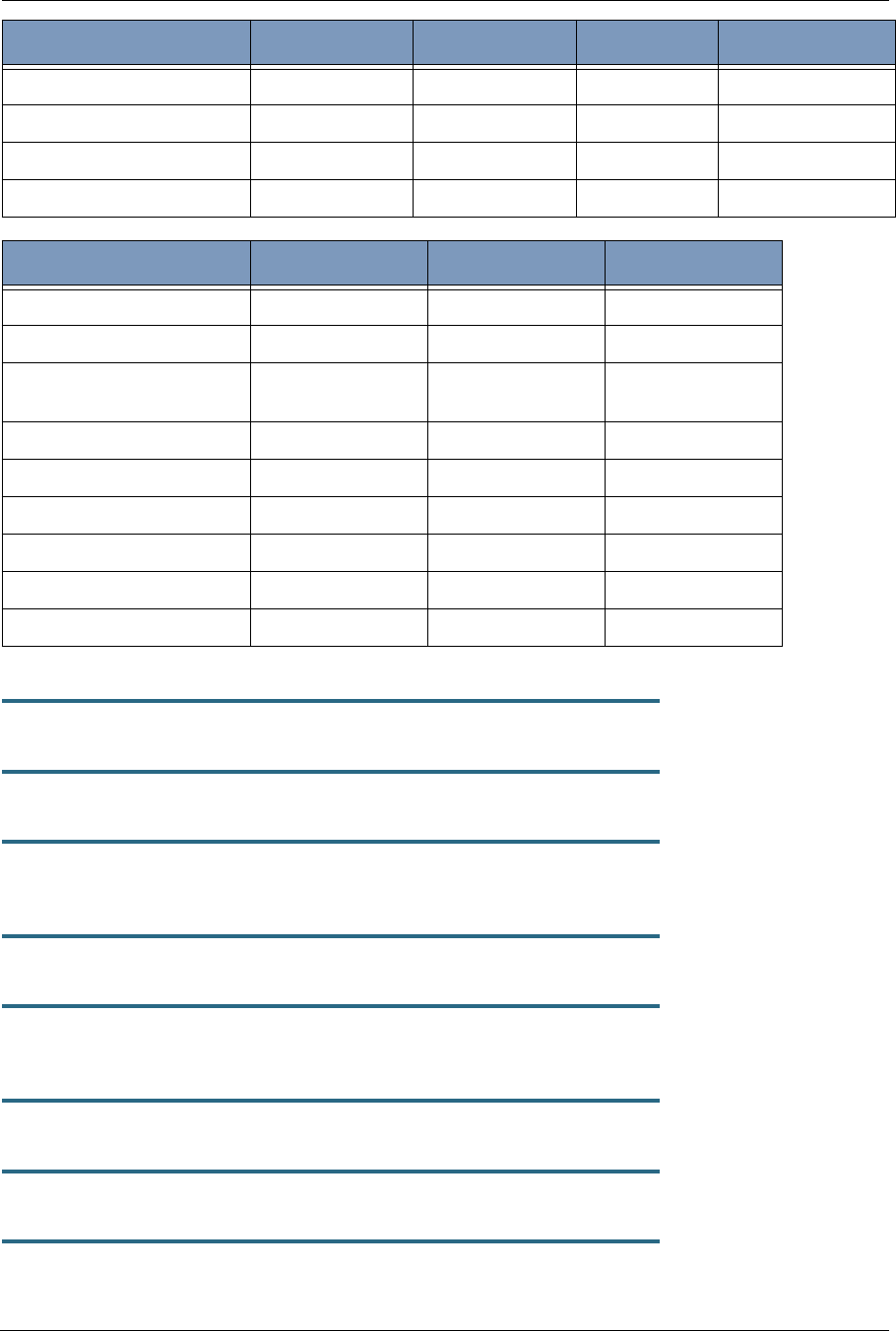
163
Syntax is as follows:
set voip advanced-telephony-setting codec codec packetization-time value
set voip advanced-telephony-setting codec codec jitter-max-reorder-delay value
set voip advanced-telephony-setting codec codec
jitter-max-accept-late-seq-num value
set voip advanced-telephony-setting codec codec jitter-initial-delay value
set voip advanced-telephony-setting codec codec jitter-exe-frame-del-mode
[ off | on ]
set voip advanced-telephony-setting codec codec jitter-max-transit-delay value
set voip advanced-telephony-setting codec codec jitter-peak-transit-delay value
set voip advanced-telephony-setting codec codec jitter-delay-buff-inc value
jitter-max-transit-delay 250 250 250 250
jitter-peak-transit-delay 475 475 475 475
jitter-delay-buff-inc 10 10 10 10
jitter-transit-delay-threshold 10000 10000 10000 10000
Codec G726_24 Codec G726_32 Codec G726_40
packetization-time 20 20 20
jitter-max-reorder-delay 50 50 50
jitter-max-accept-late-seq-
num
200 200 200
jitter-initial-delay 80 80 80
jitter-exe-frame-del-mode off off off
jitter-max-transit-delay 250 250 250
jitter-peak-transit-delay 475 475 475
jitter-delay-buff-inc 10 10 10
jitter-transit-delay-threshold 10000 10000 10000
Codec G711U Codec G711A Codec G729 Codec G726_16

Administrator’s Handbook
164
set voip advanced-telephony-setting codec codec
jitter-transit-delay-threshold value
set voip advanced-telephony-setting fxs-port-setting-for-fxo
[ none | fxs1 | fxs2 | both | emgncy ]
Sets a port to be used for the FXS (Foreign eXchange Subscriber interface) port to the FXO (Foreign eXchange
Office interface -- the phone) port. Default is none,
set voip advanced-telephony-setting rtp-port-range-start value
set voip advanced-telephony-setting rtp-port-range-end value
Sets the start and end port values for the RTP port range. Although no ports are specified for the RTP protocol, the
RTP data is to be carried on an even UDP port number. The defaults in use for the Motorola Gateway are 8024
and 8036, respectively.
set voip advanced-telephony-setting rtcp-option [ off | on ]
Turns Real-Time Transport Control Protocol on or off. RTCP supports and controls RTP media streams, but does
not itself deliver media streams. Default is off.
set voip advanced-telephony-setting t38-option [ off | on ]
Turns T.38 fax capability on or off. Default is off.
set voip advanced-telephony-setting sip-session-timer-value seconds
Sets a timer in seconds for SIP sessions to periodically verify that an established session is still active. Default is
2280.
set voip advanced-telephony-setting sip-t1-timer-value milliseconds
Sets a SIP T1 timer value, an estimate of the round trip time, in milliseconds from 100 – 5000. Default is 500.
set voip advanced-telephony-setting sip-dynamic-line-selection [ off | on ]
Turns dynamic (next available) line selection off or on. Default is off.
set voip RegionSpecificSettings Region-Code region_code
Specifies the set of standards in use for the geographical region. Example: "USA_DEFAULT".
set voip RegionSpecificSettings fxs-hook-flash-min-time seconds
Specifies the minimum Foreign Exchange Station ( FXS) hookflash time in seconds. Default is 280.
set voip RegionSpecificSettings fxs-hook-flash-max-time seconds
Specifies the maximum Foreign Exchange Station ( FXS) hookflash time in seconds. Default is 1100.
set voip RegionSpecificSettings fxs-debounce-onoff-hook-delay seconds
Specifies the on/off-hook debounce time delay for removing the ripple signal, in seconds. Default is 100.

165
set voip RegionSpecificSettings fxs-debounce-offon-hook-delay seconds
Specifies the off/on-hook debounce time delay for removing the ripple signal, in seconds. Default is 300.
Call feature settings
set voip phone n call-feature call-forwarding-all-option [ off | on ]
call-forwarding-all-option – turns unconditional call forwarding on or off.
set voip phone n call-feature call-forwarding-on-busy-option [ off | on ]
call-forwarding-on-busy-option – turns call forwarding when line is busy on or off.. Default is off.
set voip phone n call-feature call-forwarding-on-no-answer-option [ off | on ]
call-forwarding-on-no-answer-option – turns call forwarding when there is no answer on or off.
set voip phone n call-feature call-waiting-option [ off | on ]
call-waiting-option – enables or disables call waiting.
set voip phone n call-feature call-conferencing-option [ off | on ]
call-conferencing-option – enables or disables 3-way call conferencing.
set voip phone n call-feature do-not-disturb-option [ off | on ]
do-not-disturb-option – enables or disables option to prevent the phone from ringing.
set voip phone n call-feature subscribe-mwi-option [ off | on ]
subscribe-mwi-option – if set to on, the Message Waiting Indicator is enabled when new voice mail is received.
set voip phone n call-feature anonymous-call-block-option [ off | on ]
anonymous-call-block-option – if set to on, blocks calls from unidentified sources, such as those with caller-ID
blocking.
set voip phone n call-feature call-transfer-option [ off | on ]
call-transfer-option – if set to on, permits call transfer to another phone.
DSP settings
set voip phone n dsp-settings echo-option [ echo-off | echo-on | echo-on-nlp |
echo-on-cng-nlp ]
echo-option – specifies under what conditions the system invokes or disables echo cancellation. Default is echo-
on-cng-nlp (Comfort Noise Generation with non-linear processor).
set voip phone n dsp-settings echo-start-attenuation [ 0 - 65535 ]
echo-start-attenuation – specifies the minimum attenuation level at which to invoke echo cancellation. Default is
8192.

Administrator’s Handbook
166
set voip phone n dsp-settings echo-max-attenuation [ 0 - 65535 ]
echo-max-attenuation – specifies the maximum attenuation level at which to invoke echo cancellation. Default is
16384.
set voip phone n dsp-settings echo-tail-length [ 0 - 65535 ]
echo-tail-length – specifies the duration of an echo tail required to invoke cancellation. Default is 0.
set voip phone n dsp-settings vad-option [ off | on ]
When vad-option is set to on – enables Voice Activity Detection/Comfort Noise Generation. When speech is not
present, the CNG algorithm generates a noise signal at the level sent from the transmit side.

167
System commands
set system name name
Specifies the name of your Motorola Gateway. Each Motorola Gateway is assigned a name as part of its factory
initialization. The default name for a Motorola Gateway consists of the word “Motorola-7000/XXX” where “XXX” is
the serial number of the device; for example, Motorola-7000/9437188. A system name can be 1 – 255 characters
long. Once you have assigned a name to your Motorola Gateway, you can enter that name in the Address text
field of your browser to open a connection to your Motorola Gateway.
☛ NOTE:
Some broadband cable-oriented Service Providers use the System Name as an important identifi-
cation and support parameter. If your Gateway is part of this type of network, do NOT alter the Sys-
tem Name unless specifically instructed by your Service Provider.
set system time-zone [ UTC | HST10 | AKST9AKDT | YST8 | PST8PDT |
MST7MDT | MST7 | CST6CDT | CST6 | EST5EDT | AST4ADT | NST3:30NDT ]
time-zone of 0 is Coordinated Universal Time (UTC); options are -12 through 12 (+/- 1 hour increments from UTC
time).
set system auto-daylight-savings [ on | off ]
Time zones honoring Daylight Saving Time may be automatically designated.
set system firewall-log enable [ on | off ]
Turns firewall logging on or off. The firewall log tracks attempted violations of the firewall rules. Default is on.
set system firewall-log persist [ on | off ]
When set to on, causes the log information to be kept in flash memory. Default is off.
set system firewall-log file-size [ 4096... 65536 ]
Specifies a size for the firewall logs. The most recent entries are posted to the beginning of the log. When the log
becomes full, the oldest entries are dropped. The default is 16384.
set system firewall-log file-count [ 2... 8 ]
Specifies the number of possible log files. The default is 4.
set system fastpath software-enable [ on | off ]
Enables or disables the fastpath accelerator processor. Fastpath works on only TCP and UDP. Default is on.
set system fastpath hardware-enable [ off | on ]
Enables or disables the fastpath accelerator processor. Default is off.
set system fastpath mcast-mode 3
Sets the mode for multicast on the fastpath accelerator processor.

Administrator’s Handbook
168
set system scheduler enable [ off | on ]
Turns the system scheduler feature on or off. The default is off.
set system scheduler enable-time hr:min
Specifies a time at which to turn the system on. Default is midnight (00:00). enable-time must be supplied in 24
hour military time, colon separated, for example “05:21”.
set system scheduler disable-time hr:min
Specifies a time at which to turn the system off. Default is 5 o’clock (05:00). disable-time must be supplied in 24
hour military time, colon separated, for example “21:44”.
set system calendar-update enable [ on | off ]
Turns the calendar update feature on or off. The device will periodically poll the update server for new operating
system software. The default is on.
set system calendar-update interval [ monthly | biweekly ]
Specifies how often the device should poll the update server, monthly or biweekly. The default is monthly.
set system calendar-update protocol [ http | https | tftp ]
Specifies the protocol for accessing the update server. The default is http.
set system calendar-update server server_address
Specifies the address of the update server by name or IP address. The default is "cpems.bellsouth.net".
set system calendar-update username string
Specifies the username for the update server. The default is "anonymous".
set system calendar-update password string
Specifies the password for the update server. The default is "guest".
set system calendar-update fwverfile filename
Specifies the firmware version filename to the update server. For the AT&T NVG589 the file is
"netopiaNVG589_64.txt".
set system calendar-update day day_of_month
Specifies the numerical day of the month for the update server to be polled, for example, "21".
set system calendar-update time hr:min_AMPM
Specifies the time of day for the update server to be polled, in the form HOUR:MINUTEAM/PM. Example:
"06:00AM"

169
set system supplicant enable [ on | off ]
Turns on the 802.1x supplicant functionality. You must set the corresponding "type" field in the WAN link to acti-
vate it:
NOS/142253966608 (top)>> set link name WAN supplicant
supplicant
type (none) [ none | eap-tls ]:
priority (0) [ 0 - 7 ]:
Default is on.
set system supplicant dest-broadcast [ off | on ]
Mostly useful for debugging. If this is set to on, the destination MAC address FF:FF:FF:FF:FF:FF is used when
the supplicant sends 802.lx packets. If this is off, the EAPOL-specific destination address of 01:80:C2:00:00:03 is
used. Default is off.
set system supplicant eap-tls-identity string
Sets the identity sent by the supplicant in response to an Identity request from an 802.1x authenticator.
set system supplicant server-cert-check [ on | off ]
If set to on, examines the certificate chain sent by an 802.1x authenticator for validation, and ensures that the root
cert of this chain is accepted by the CPE (i.e. in its trust list). Default is on.
set system voice-check enable [ off | on ]
When this is set to on, and a voice call is in progress when a software update is scheduled, the software update is
deferred for the voice-check interval until the call is completed, that is, the call state becomes “idle.” If set to off,
and a voice call is in progress when an update is scheduled, the call is torn down. The default is on.
set system voice-check interval [ 60 - 86400 ]
This specifies the interval in seconds for the device to wait before attempting a software update, when a software
update is scheduled but a voice call is in progress, when voice-check enable is set to on. The default is 300 (5
minutes).
set system voice-check max-time [ 300 - 604800 ]
This specifies the maximum time in seconds for the device to continue to attempt a scheduled software update if a
voice call is in progress and voice-check enable is set to on. The default is 3600 (1 hour).
set system log buffer-size [ 4096... 65536 ]
Specifies a size for the system log. The most recent entries are posted to the beginning of the log. When the log
becomes full, the oldest entries are dropped. The default is 16384.
set system log level [ low | medium | high | alerts | failures ]
Specifies the types of log messages you want the Motorola Gateway to record. All messages with a level equal to
or greater than the level you specify are recorded. For example, if you specify set system diagnostic-level
medium, the diagnostic log will retain medium-level informational messages, alerts, and failure messages.
Use the following guidelines:

Administrator’s Handbook
170
◆low - Low-level informational messages or greater; includes trivial status messages.
◆medium - Medium-level informational messages or greater; includes status messages that can help monitor
network traffic.
◆high - High-level informational messages or greater; includes status messages that may be significant but do
not constitute errors. The default.
◆alerts - Warnings or greater; includes recoverable error conditions and useful operator information.
◆failures - Failures; includes messages describing error conditions that may not be recoverable.

171
Debug Commands
When you are in SHELL mode, the DEBUG prompt is the name of the Motorola Gateway/DEBUG followed by a
right angle bracket (>). For example, if you open a CLI connection to the Motorola Gateway named “Motorola-
3000/9437188,” then type “debug” you would see
Motorola-3000/9437188/DEBUG>
as your prompt.
Debug level is available for field debugging purposes.There is no service and quality level guarantee from Motor-
ola. This level is intended for SEs or Telcos lab people, not for normal operation at home for end users.
Disclaimer & Warning Text
The following is displayed when entering Debug level from normal Config level.
“Warning: Accessing these commands may impact the normal operation of this device. Exit now if you
entered by mistake.”
Commands
console
Make this session the console.
mirror <src-port> <dst-port>
To mirror one port's traffic to another. Causes traffic transmitted or received on <src-port> to be mirrored on <dst-
port>. Ports must support Ethernet (IPoA and PPPoA ATM ports are not supported).
mirror off
Turns off port mirroring.
show fastpath
Displays entries in fastpath.
show cpu
Displays CPU Usage as a percentage and CPU Load Averages over 1, 5 and 15 minute periods.

Administrator’s Handbook
172

173
CHAPTER 5 Technical Specifications and Safety
Information
Description
Dimensions:
10 in H x 7.25 in L x 1.63 in W (25.4 cm H x 18.4 cm L x 4.1 cm W)
1.28 lbs (.58 kg) (without integrated battery)
1.77 lbs (.80 kg) (with integrated battery)
Communications interfaces: The Motorola® Gateways have a 4-port 10/100/1000Base-T Ethernet switch
for your LAN connections, an FXS port for VoIP connections, a HomePNA 3.1 coax por t, a USB 2.0 network port,
and a 400 mW wireless radio for Wi-Fi connections.
WAN interfaces: Bonded VDSL2/single line VDSL2/bonded ADSL2+/single line ADSL, RJ-14; One-port 10/
100/1000 Ethernet, RJ-45
Power Supply
■115VAC 36W/12VDC@3A (2phone,5REN, RINGING)
Environment
Operating temperature: 0 °C to 42 °C (32 °F to 107 °F); 8% to 95% (Non Condensing) Relative Humidity
Storage temperature: –20 °C to 85 °C (–4 °F to 185 °F)
Relative storage humidity: 20 to 80% noncondensing
Software and protocols
Software media: Software preloaded on internal flash memory; field upgrades done via download to internal
flash memory via CLI or web upload.
Routing: IPv4 , IPv6/6rd; DHCP server/relay; DNS Proxy, Dynamic DNS Support; Multiple subnet support
WAN support: PPPoA, DHCP, static IP address; ADSL, ADSL2/2+, ADSL2 Reach Extended protocol (ITU G.992.3
annex L)
Security: Stateful Packet Inspection Firewall; Virtual DMZ/IP pass-through; Denial of Service (DoS) protection;
VPN Pass-through (PPTP, L2TP, IPSec)
Wi-Fi Security. WEP (64-bit, 128-bit, 256-bit) encryption 802.1x, WPA, WPA-PSK, 802.11i/WPA2, WPA2-PSK
EAP-TLS, EAP-TTLS, EAP-SIM MAC Address filtering

Administrator’s Handbook
174
Management/configuration methods: HTTP (Web server), telnet command line inter face
Diagnostics: Ping, event logging, routing table displays, statistics counters, web-based management,
traceroute, nslookup, and diagnostic commands.
Agency approvals
North America
Safety Approvals:
■United States – UL 60950, Third Edition
■Canada – CSA: CAN/CSA-C22.2 No. 60950-00
EMC:
■United States – FCC Part 15 Class B
■Canada – ICES-003
Telecom:
■United States – 47 CFR Part 68
■Canada – CS-03
Integrated Battery:
■Hazardous Materials Regulations and Procedures CFR Title 49, Section 173,
■Subsection 185
■UL60950/CAN/CSA-C22.2 No. 60950—Recognized component (U.S. and Canada)
■UL 2054—Recognized component (U.S. and Canada)
■UN Manual of test and Criteria, sect. 38.3, CE, IEC62133
■California Code of Regulation Title 20

175
Manufacturer’s Declaration of Conformance
☛ Warnings:
This is a Class B product. In a domestic environment this product may cause radio interference, in
which case the user may be required to take adequate measures. Adequate measures include
increasing the physical distance between this product and other electrical devices.
Changes or modifications to this unit not expressly approved by the party responsible for compli-
ance could void the user’s authority to operate the equipment.
United States. This equipment has been tested and found to comply with the limits for a Class B digital device,
pursuant to Part 15 of the FCC Rules. These limits are designed to provide reasonable protection against harmful
interference in a residential installation. This equipment generates, uses, and can radiate radio frequency energy
and, if not installed and used in accordance with the instructions, may cause harmful interference to radio commu-
nications. However, there is no guarantee that interference will not occur in a particular installation. If this
equipment does cause harmful interference to radio or television reception, which can be determined by turning
the equipment off and on, the user is encouraged to try to correct the interference by one or more of the following
measures:
■Reorient or relocate the receiving antenna.
■Increase the separation between the equipment and receiver.
■Connect the equipment into an outlet on a circuit different from that to which the receiver is connected.
■Consult the dealer or an experienced radio TV technician for help.
This device complies with Part 15 of the FCC Rules. Operation is subject to the following two conditions:
1. This device may not cause harmful interference, and
2. this device must accept any interference received, including inter ference that may cause undesired operation.
Service requirements. In the event of equipment malfunction, if under warranty we will exchange a product
deemed defective. Under FCC rules, no customer is authorized to repair this equipment. This restriction applies
regardless of whether the equipment is in or out of warranty.
Technical Support for Hardware Products
1-877-466-8646
http://www.motorola.com/support
☛ Important
This product was tested for FCC compliance under conditions that included the use of shielded
cables and connectors between system components. Changes or modifications to this product not
authorized by the manufacturer could void your authority to operate the equipment.
Canada. This Class B digital apparatus meets all requirements of the Canadian Inter ference -Causing Equipment
Regulations.
Cet appareil numérique de la classe B respecte toutes les exigences du Réglement sur le matériel brouilleur du
Canada.
Declaration for Canadian users
NOTICE: The Canadian Industry Canada label identifies certified equipment. This certification means
that the equipment meets certain telecommunications network protective, operation, and safety
requirements. The Department does not guarantee the equipment will operate to the user’s
satisfaction.

Administrator’s Handbook
176
Before installing this equipment, users should ensure that it is permissible to be connected to the
facilities of the local telecommunications company. The equipment must also be installed using an
acceptable method of connection. In some cases, the company’s inside wiring associated with a
single line individual service may be extended by means of a certified connector assembly
(telephone extension cord). The customer should be aware that compliance with the above
conditions may not prevent degradation of service in some situations.
Repairs to the certified equipment should be made by an authorized Canadian maintenance facility
designated by the supplier. Any repairs or alterations made by the user to this equipment, or
equipment malfunctions, may give the telecommunications company cause to request the user to
disconnect the equipment.
Users should ensure for their own protection that the electrical ground connections of the power
utility, telephone lines, and internal metallic water pipe system, if present, are connected together.
This precaution may be particularly important in rural areas.
Caution
Users should not attempt to make such connections themselves, but should contact the appropriate electric
inspection authority, or electrician, as appropriate.
The Ringer Equivalence Number (REN) assigned to each terminal device provides an indication of the maximum
number of terminals allowed to be connected to a telephone interface. The termination on an interface may
consist of any combination of devices subject only to the requirement that the sum of the Ringer Equivalence
Numbers of all the devices does not exceed 5.

177
Important Safety Instructions
Caution
DO NOT USE BEFORE READING THE INSTRUCTIONS: Do not connect the Ethernet ports to a carrier or carriage
service provider’s telecommunications network or facility unless: a) you have the written consent of the network or
facility manager, or b) the connection is in accordance with a connection permit or connection rules.
Connection of the Ethernet ports may cause a hazard or damage to the telecommunication network or facility, or
persons, with consequential liability for substantial compensation.
Caution
■The direct plug-in power supply serves as the main power disconnect; locate the direct plug-in power supply
near the product for easy access.
■For use only with CSA Certified Class 2 power supply, rated 12VDC, 1.0A.
Telecommunication installation cautions
■Never install telephone wiring during a lightning storm.
■Never install telephone jacks in wet locations unless the jack is specifically designed for wet locations.
■Never touch uninsulated telephone wires or terminals unless the telephone line has been disconnected at the
network interface.
■Use caution when installing or modifying telephone lines.
■Avoid using a telephone (other than a cordless type) during an electrical storm. There may be a remote risk of
electric shock from lightning.
■Do not use the telephone to report a gas leak in the vicinity of the leak.

Administrator’s Handbook
178
47 CFR Part 68 Information
FCC Requirements
1. The Federal Communications Commission (FCC) has established Rules which permit this device to be directly
connected to the telephone network. Standardized jacks are used for these connections. This equipment
should not be used on party lines or coin phones.
2. If this device is malfunctioning, it may also be causing harm to the telephone network; this device should be
disconnected until the source of the problem can be determined and until repair has been made. If this is not
done, the telephone company may temporarily disconnect service.
3. The telephone company may make changes in its technical operations and procedures; if such changes affect
the compatibility or use of this device, the telephone company is required to give adequate notice of the
changes. You will be advised of your right to file a complaint with the FCC.
4. If the telephone company requests information on what equipment is connected to their lines, inform them of:
a. The telephone number to which this unit is connected.
b. The ringer equivalence number. [0.XB]
c. The USOC jack required. [RJ11C]
d. The FCC Registration Number. [XXXUSA-XXXXX-XX-E]
Items (b) and (d) are indicated on the label. The Ringer Equivalence Number (REN) is used to determine how
many devices can be connected to your telephone line. In most areas, the sum of the REN's of all devices on
any one line should not exceed five (5.0). If too many devices are attached, they may not ring properly.
FCC Statements
a) This equipment complies with Part 68 of the FCC rules and the requirements adopted by the ACTA. On the
bottom of this equipment is a label that contains, among other information, a product identifier in the format
US:AAAEQ##TXXXX. If requested, this number must be provided to the telephone company.
b) List all applicable certification jack Universal Service Order Codes (“USOC”) for the equipment: RJ11.
c) A plug and jack used to connect this equipment to the premises wiring and telephone network must comply with
the applicable FCC Part 68 rules and requirements adopted by the ACTA. A compliant telephone cord and modular
plug is provided with this product. It is designed to be connected to a compatible modular jack that is also
compliant. See installation instructions for details.
d) The REN is used to determine the number of devices that may be connected to a telephone line. Excessive RENs
on a telephone line may result in the devices not ringing in response to an incoming call. In most but not all areas,
the sum of RENs should not exceed five (5.0). To be certain of the number of devices that may be connected to a
line, as determined by the total RENs, contact the local telephone company. For products approved after July 23,
2002, the REN for this product is part of the product identifier that has the format US:AAAEQ##TXXXX. The digits
represented by ## are the REN without a decimal point (e.g., 03 is a REN of 0.3). For earlier products, the REN is
separately shown on the label.
e) If this equipment, the Motorola® Gateway, causes harm to the telephone network, the telephone company will
notify you in advance that temporary discontinuance of service may be required. But if advance notice isn’t
practical, the telephone company will notify the customer as soon as possible. Also, you will be advised of your
right to file a complaint with the FCC if you believe it is necessary.
f) The telephone company may make changes in its facilities, equipment, operations or procedures that could
affect the operation of the equipment. If this happens the telephone company will provide advance notice in order
for you to make necessary modifications to maintain uninterrupted service.
g) If trouble is experienced with this equipment, the Motorola® Gateway, for warranty information, please contact:
Technical Support for Hardware Products
1-877-466-8646
http://www.motorola.com/support
If the equipment is causing harm to the telephone network, the telephone company may request that you
disconnect the equipment until the problem is resolved.
h) This equipment not intended to be repaired by the end user. In case of any problems, please refer to the trouble-
shooting section of the Product User Manual before calling Motorola Technical Support.
i) Connection to party line service is subject to state tariffs. Contact the state public utility commission, public
service commission or corporation commission for information.

179
j) If your home has specially wired alarm equipment connected to the telephone line, ensure the installation of this
Motorola® Series Gateway does not disable your alarm equipment. If you have questions about what will disable
alarm equipment, consult your telephone company or qualified installer.
RF Exposure Statement:
NOTE: Installation of the wireless models must maintain at least 20 cm between the wireless Gateway and any
body part of the user to be in compliance with FCC RF exposure guidelines.
Electrical Safety Advisory
Telephone companies report that electrical surges, typically lightning transients, are very destructive to customer
terminal equipment connected to AC power sources. This has been identified as a major nationwide problem.
Therefore it is advised that this equipment be connected to AC power through the use of a surge arrestor or similar
protection device.

Administrator’s Handbook
180
Caring for the Environment by Recycling
Recycling your Motorola Equipment
Please do not dispose of this product with your
residential or commercial waste. Some countries
or regions, such as the European Union, have set
up systems to collect and recycle electrical and
electronic waste items. Contact your local authori-
ties for information about practices established for
your region.
If collection systems are not available, call Motor-
ola Customer Service for assistance.
Please visit www.motorola.com/recycle
<http://www.motorola.com/recycle> for instructions on recycling.
Genbrug af dit Motorola-udstyr
Dette produkt må ikke bortskaffes sammen med husholdningsaffald eller erh-
vervsaffald. Nogle lande eller områder, f.eks. EU, har oprettet systemer til ind-
samling og genbrug af elektriske og elektroniske affaldsprodukter. Kontakt de
lokale myndigheder for oplysninger om gældende fremgangsmåder i dit
område. Hvis der ikke findes tilgængelige indsamlingssystemer, kan du kon-
takte Motorola Kundeservice.
Recycling bei Geräten von Motorola
Bitte entsorgen Sie dieses Produkt nicht als gewöhnlichen Haus- oder
Büromüll. In einigen Ländern und Gebieten, z. B. in der Europäischen Union,
wurden Systeme für die Rücknahme und Wiederverwertung von Elek-
troschrott eingeführt. Erkundigen Sie sich bitte bei Ihrer Stadtoder Kreisver-
waltung nach der geltenden Entsorgungspraxis. Falls bei Ihnen noch kein
Abfuhroder Rücknahmesystem besteht, wenden Sie sich bitte an den Kun-
dendienst von Motorola.
Reciclaje de su equipo Motorola
No deseche este producto junto con sus residuos residenciales o comer-
ciales. Algunos países o regiones, tales como la Unión Europea, han orga-
nizado sistemas para recoger y reciclar desechos eléctricos y electrónicos.
Comuníquese con las autoridades locales para obtener información acerca
de las prácticas vigentes en su región. Si no existen sistemas de recolección
disponibles, solicite asistencia llamando el Servicio al Cliente de Motorola.
Recyclage de votre équipement Motorola
Veuillez ne pas jeter ce produit avec vos ordures ménagères ou vos rebuts
d'entreprise. Certains pays ou certaines régions comme l'Union Européenne
ont mis en place des systèmes de collecte et de recyclage des produits élec-
triques et électroniques mis au rebut. Veuillez contacter vos autorités locales
pour vous informer des pratiques instaurées dans votre region. Si aucun
système de collecte n'est disponible, veuillez appeler le Service clientèle de
Motorola qui vous apportera son assistance.
When you see this symbol on a
Motorola product, do not dispose
of the product with residential or
commercial waste.
B
es
k
y
tt
e
l
se a
f
m
ilj
øe
t
med genbrug
Når du ser dette symbol på et
Motorola-produkt, må produktet
ikke bortskaffes sammen med
husholdningsaffald eller erh-
vervsaffald.
U
mwe
lt
sc
h
u
t
z
d
urc
h
Recycling
Wenn Sie dieses Zeichen auf
einem Produkt von Motorola
sehen, entsorgen Sie das
Produkt bitte nicht als gewöhnli-
chen Hausoder Büromüll.
C
u
id
ar e
l
me
di
o
ambiente mediante el
reciclaje
Cuando vea este símbolo en un
producto Motorola, no lo
deseche junto con residuos resi-
denciales o comerciales.
R
ecyc
l
age pour
l
e
respect de
l'environnement
Lorsque vous voyez ce symbole
sur un produit Motorola, ne le
jetez pas avec vos ordures
ménagères ou vos rebuts
d'entreprise.
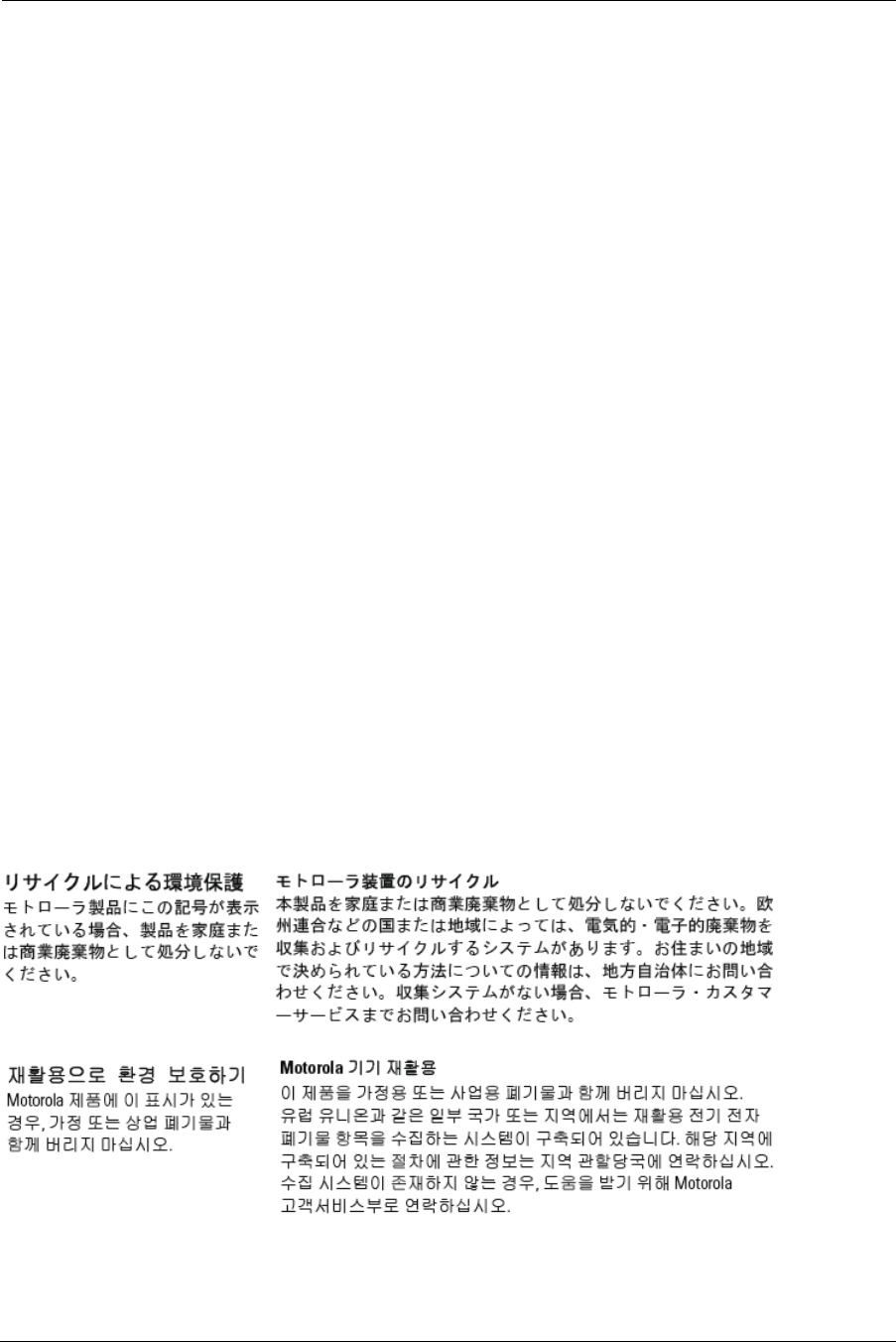
181
Uw Motorola-materiaal recycleren.
Gooi dit product niet bij het huishoudelijk afval het of bedrijfsafval. In sommige
landen of regio's zoals de Europese Unie, zijn er bepaalde systemen om elek-
trische of elektronische afvalproducten in te zamelen en te recycleren. Neem
contact op met de plaatselijke overheid voor informatie over de geldende
regels in uw regio. Indien er geen systemen bestaan, neemt u contact op met
de klantendienst van Motorola.
Recykling posiadanego sprzętu Motorola
Produktu nie należy wyrzucać do komunalnych pojemników na śmieci. W niek-
tórych krajach i regionach, np. w Unii Europejskiej, istnieją systemy zbierania i
recyklingu sprzętu elektrycznego i elektronicznego. Informacje o utylizacji tego
rodzaju odpadów należy uzyskać od władz lokalnych. Jeśli w danym regionie
nie istnieją systemy zbierania odpadów elektrycznych i elektronicznych, infor-
macje o utylizacji należy uzyskać od biura obsługi klienta firmy Motorola
(Motorola Customer Service).
Reciclagem do seu equipamento Motorola
Não descarte este produto junto com o lixo residencial ou comercial. Alguns
países ou regiões, tais como a União Européia, criaram sistemas para cole-
cionar e reciclar produtos eletroeletrônicos. Para obter informações sobre as
práticas estabelecidas para sua região, entre em contato com as autoridades
locais. Se não houver sistemas de coleta disponíveis, entre em contato com o
Serviço ao Cliente da Motorola para obter assistência.
Återvinning av din Motorola-utrustning
Kasta inte denna produkt tillsammans med det vanliga avfallet. Vissa länder
eller regioner, som t.ex. EU, har satt upp ett system för insamling och återvin-
ning av el- och elektronikavfall. Kontakta dina lokala myndigheter för informa-
tion om vilka regler som gäller i din region. Om det inte finns något
insamlingssystem ska du kontakta Motorolas kundtjänst för hjälp.
Mili
eu
b
ewus
t
recycleren
Als u dit symbool op een Motor-
ola-product ziet, gooi het dan
niet bij het huishoudelijk afval of
het bedrijfsafval.
Db
a
ł
o
ść
o
ś
ro
d
ow
i
s
k
o
- recykling
Produktów Motorola oznac-
zonych tym symbolem nie należy
wyrzucać do komunalnych pojem-
ników na śmieci.
C
u
id
an
d
o
d
o me
i
o
ambiente através da
reciclagem
Quando você ver este símbolo
em um produto Motorola, não
descarte o produto junto com lixo
residencial ou comercial.
V
ar r
ädd
om m
iljö
n
genom återvinning
När du ser den här symbolen på
en av Motorolas produkter ska
du inte kasta produkten tillsam-
mans med det vanliga avfallet.

Administrator’s Handbook
182
Please visit http://www.motorola.com/recycle for instructions on recycling.

183
Copyright Acknowledgments
Because Motorola has included certain software source code in this product, Motorola includes the following text
required by the respective copyright holders:
Open Source Software Information
For instructions on how to obtain a copy of any source code being made publicly available by Motorola related to
software used in this Motorola product you may send your request in writing to:
Motorola, Inc.
OSS Management
2450 Walsh Avenue
Santa Clara, CA 95051
USA
The Motorola website opensource.motorola.com also contains information regarding Motorolaís use of open
source. Motorola has created the opensource.motorola.com to serve as a portal for interaction with the software
community-at-large.
This document contains additional information regarding licenses, acknowledgments and required copyright
notices for open source packages used in this Motorola product.
aiccu 2007.01.15
The SixXS License - http://www.sixxs.net/
Copyright (C) SixXS <info@sixxs.net>
All rights reserved.
Redistribution and use in source and binary forms, with or without
modification, are permitted provided that the following conditions
are met:
1. Redistributions of source code must retain the above copyright
notice, this list of conditions and the following disclaimer.
2. Redistributions in binary form must reproduce the above copyright
notice, this list of conditions and the following disclaimer in the
documentation and/or other materials provided with the distribution.
3. Neither the name of SixXS nor the names of its contributors
may be used to endorse or promote products derived from this software
without specific prior permission.
THIS SOFTWARE IS PROVIDED BY SIXXS AND CONTRIBUTORS ``AS IS’’ AND
ANY EXPRESS OR IMPLIED WARRANTIES, INCLUDING, BUT NOT LIMITED TO, THE
IMPLIED WARRANTIES OF MERCHANTABILITY AND FITNESS FOR A PARTICULAR PURPOSE
ARE DISCLAIMED. IN NO EVENT SHALL SIXXS OR CONTRIBUTORS BE LIABLE
FOR ANY DIRECT, INDIRECT, INCIDENTAL, SPECIAL, EXEMPLARY, OR CONSEQUENTIAL
DAMAGES (INCLUDING, BUT NOT LIMITED TO, PROCUREMENT OF SUBSTITUTE GOODS
OR SERVICES; LOSS OF USE, DATA, OR PROFITS; OR BUSINESS INTERRUPTION)
HOWEVER CAUSED AND ON ANY THEORY OF LIABILITY, WHETHER IN CONTRACT, STRICT
LIABILITY, OR TORT (INCLUDING NEGLIGENCE OR OTHERWISE) ARISING IN ANY WAY
OUT OF THE USE OF THIS SOFTWARE, EVEN IF ADVISED OF THE POSSIBILITY OF
SUCH DAMAGE.
dhcp (dhcp-isc) 4.1.1-P1
Copyright © 2004-2011 by Internet Systems Consortium, Inc. (“ISC”)
Copyright © 1995-2003 by Internet Software Consortium
Permission to use, copy, modify, and/or distribute this software for any purpose with or without fee is hereby
granted, provided that the above copyright notice and this permission notice appear in all copies.
THE SOFTWARE IS PROVIDED “AS IS” AND ISC DISCLAIMS ALL WARRANTIES WITH REGARD TO THIS
SOFTWARE INCLUDING ALL IMPLIED WARRANTIES OF MERCHANTABILITY AND FITNESS. IN NO EVENT
SHALL ISC BE LIABLE FOR ANY SPECIAL, DIRECT, INDIRECT, OR CONSEQUENTIAL DAMAGES OR ANY
DAMAGES WHATSOEVER RESULTING FROM LOSS OF USE, DATA OR PROFITS, WHETHER IN AN
ACTION OF CONTRACT, NEGLIGENCE OR OTHER TORTIOUS ACTION, ARISING OUT OF OR IN
CONNECTION WITH THE USE OR PERFORMANCE OF THIS SOFTWARE.
DropBear 0.52
Copyright (c) 2002-2006 Matt Johnston Portions
copyright (c) 2004 Mihnea Stoenescu All rights reserved.
Permission is hereby granted, free of charge, to any person obtaining a copy of this software and associated
documentation files (the “Software”), to deal in the Software without restriction, including without limitation the
rights to use, copy, modify, merge, publish, distribute, sublicense, and/or sell copies of the Software, and to
permit persons to whom the Software is furnished to do so, subject to the following conditions:
The above copyright notice and this permission notice shall be included in all copies or substantial portions of the
Software.
THE SOFTWARE IS PROVIDED “AS IS”, WITHOUT WARRANTY OF ANY KIND, EXPRESS OR IMPLIED,
INCLUDING BUT NOT LIMITED TO THE WARRANTIES OF MERCHANTABILITY, FITNESS FOR A
PARTICULAR PURPOSE AND NONINFRINGEMENT. IN NO EVENT SHALL THE AUTHORS OR COPYRIGHT
HOLDERS BE LIABLE FOR ANY CLAIM, DAMAGES OR OTHER LIABILITY, WHETHER IN AN ACTION OF
CONTRACT, TORT OR OTHERWISE, ARISING FROM, OUT OF OR IN CONNECTION WITH THE
SOFTWARE OR THE USE OR OTHER DEALINGS IN THE SOFTWARE.
=====
LibTomCrypt and LibTomMath are written by Tom St Denis, and are Public Domain.

Administrator’s Handbook
184
=====
Copyright (c) 1995 Tatu Ylonen <ylo@cs.hut.fi>, Espoo, Finland All rights reserved
“As far as I am concerned, the code I have written for this software
can be used freely for any purpose. Any derived versions of this software must be clearly marked as such, and if
the derived work is incompatible with the protocol description in the RFC file, it must be called by a name other
than “ssh” or “Secure Shell”. “
=====
Copyright (c) 2000 Andre Lucas. All rights reserved.
Portions copyright (c) 1998 Todd C. Miller
Portions copyright (c) 1996 Jason Downs
Portions copyright (c) 1996 Theo de Raadt
Redistribution and use in source and binary forms, with or without
modification, are permitted provided that the following conditions
are met:
1. Redistributions of source code must retain the above copyright
notice, this list of conditions and the following disclaimer.
2. Redistributions in binary form must reproduce the above copyright
notice, this list of conditions and the following disclaimer in the
documentation and/or other materials provided with the distribution.
THIS SOFTWARE IS PROVIDED BY THE AUTHOR ``AS IS’’ AND ANY EXPRESS OR
IMPLIED WARRANTIES, INCLUDING, BUT NOT LIMITED TO, THE IMPLIED WARRANTIES
OF MERCHANTABILITY AND FITNESS FOR A PARTICULAR PURPOSE ARE DISCLAIMED.
IN NO EVENT SHALL THE AUTHOR BE LIABLE FOR ANY DIRECT, INDIRECT,
INCIDENTAL, SPECIAL, EXEMPLARY, OR CONSEQUENTIAL DAMAGES (INCLUDING, BUT
NOT LIMITED TO, PROCUREMENT OF SUBSTITUTE GOODS OR SERVICES; LOSS OF USE,
DATA, OR PROFITS; OR BUSINESS INTERRUPTION) HOWEVER CAUSED AND ON ANY
THEORY OF LIABILITY, WHETHER IN CONTRACT, STRICT LIABILITY, OR TORT
(INCLUDING NEGLIGENCE OR OTHERWISE) ARISING IN ANY WAY OUT OF THE USE OF
THIS SOFTWARE, EVEN IF ADVISED OF THE POSSIBILITY OF SUCH DAMAGE.
=====
copyright 1997-2003 Simon Tatham.
copyright Robert de Bath, Joris van Rantwijk, Delian Andreas Schultz, Jeroen Massar, Wez Furlong, Nicolas
Barry, Portions Delchev, Justin Bradford, and CORE SDI S.A.
Permission is hereby granted, free of charge, to any person obtaining a copy of this software and associated
documentation files (the “Software”), to deal in the Software without restriction, including without limitation the
rights to use, copy, modify, merge, publish, distribute, sublicense, and/or sell copies of the Software, and to
permit persons to whom the Software is furnished to do so, subject to the following conditions:
The above copyright notice and this permission notice shall be included in all copies or substantial portions of the
Software.
THE SOFTWARE IS PROVIDED “AS IS”, WITHOUT WARRANTY OF ANY KIND, EXPRESS OR IMPLIED,
INCLUDING BUT NOT LIMITED TO THE WARRANTIES OF MERCHANTABILITY, FITNESS FOR A
PARTICULAR PURPOSE AND NONINFRINGEMENT. IN NO EVENT SHALL THE COPYRIGHT HOLDERS BE
LIABLE FOR ANY CLAIM, DAMAGES OR OTHER LIABILITY, WHETHER IN AN ACTION OF CONTRACT,
TORT OR OTHERWISE, ARISING FROM, OUT OF OR IN CONNECTION WITH THE SOFTWARE OR THE
USE OR OTHER DEALINGS IN THE SOFTWARE.
Encryption
Aaron D. Gifford License
Copyright (c) 2000-2001, Aaron D. Gifford
All rights reserved.
Redistribution and use in source and binary forms, with or without
modification, are permitted provided that the following conditions
are met:
1. Redistributions of source code must retain the above copyright
notice, this list of conditions and the following disclaimer.
2. Redistributions in binary form must reproduce the above copyright
notice, this list of conditions and the following disclaimer in the
documentation and/or other materials provided with the distribution.
3. Neither the name of the copyright holder nor the names of contributors
may be used to endorse or promote products derived from this software
without specific prior written permission.
THIS SOFTWARE IS PROVIDED BY THE AUTHOR AND CONTRIBUTOR(S) ``AS IS’’ AND
ANY EXPRESS OR IMPLIED WARRANTIES, INCLUDING, BUT NOT LIMITED TO, THE
IMPLIED WARRANTIES OF MERCHANTABILITY AND FITNESS FOR A PARTICULAR PURPOSE
ARE DISCLAIMED. IN NO EVENT SHALL THE AUTHOR OR CONTRIBUTOR(S) BE LIABLE
FOR ANY DIRECT, INDIRECT, INCIDENTAL, SPECIAL, EXEMPLARY, OR CONSEQUENTIAL
DAMAGES (INCLUDING, BUT NOT LIMITED TO, PROCUREMENT OF SUBSTITUTE GOODS
OR SERVICES; LOSS OF USE, DATA, OR PROFITS; OR BUSINESS INTERRUPTION)
HOWEVER CAUSED AND ON ANY THEORY OF LIABILITY, WHETHER IN CONTRACT, STRICT
LIABILITY, OR TORT (INCLUDING NEGLIGENCE OR OTHERWISE) ARISING IN ANY WAY
OUT OF THE USE OF THIS SOFTWARE, EVEN IF ADVISED OF THE POSSIBILITY OF
SUCH DAMAGE.

185
RSA Data Security License
Copyright (C) 1990, RSA Data Security, Inc. All rights reserved.
License to copy and use this software is granted provided that
it is identified as the “RSA Data Security, Inc. MD5 Message-
Digest Algorithm” in all material mentioning or referencing this
software or this function.
License is also granted to make and use derivative works
provided that such works are identified as “derived from the RSA
Data Security, Inc. MD5 Message-Digest Algorithm” in all
material mentioning or referencing the derived work.
RSA Data Security, Inc. makes no representations concerning
either the merchantability of this software or the suitability
of this software for any particular purpose. It is provided “as
is” without express or implied warranty of any kind.
These notices must be retained in any copies of any part of this
documentation and/or software.
expat 1.95.7
Copyright (c) 1998, 1999, 2000 Thai Open Source Software Center Ltd
and Clark Cooper
Copyright (c) 2001, 2002 Expat maintainers.
Permission is hereby granted, free of charge, to any person obtaining
a copy of this software and associated documentation files (the
“Software”), to deal in the Software without restriction, including
without limitation the rights to use, copy, modify, merge, publish,
distribute, sublicense, and/or sell copies of the Software, and to
permit persons to whom the Software is furnished to do so, subject to
the following conditions:
The above copyright notice and this permission notice shall be included
in all copies or substantial portions of the Software.
THE SOFTWARE IS PROVIDED “AS IS”, WITHOUT WARRANTY OF ANY KIND,
EXPRESS OR IMPLIED, INCLUDING BUT NOT LIMITED TO THE WARRANTIES OF
MERCHANTABILITY, FITNESS FOR A PARTICULAR PURPOSE AND NONINFRINGEMENT.
IN NO EVENT SHALL THE AUTHORS OR COPYRIGHT HOLDERS BE LIABLE FOR ANY
CLAIM, DAMAGES OR OTHER LIABILITY, WHETHER IN AN ACTION OF CONTRACT,
TORT OR OTHERWISE, ARISING FROM, OUT OF OR IN CONNECTION WITH THE
SOFTWARE OR THE USE OR OTHER DEALINGS IN THE SOFTWARE.
GNU General Public License 2.0 (GPL)
This Motorola product contains the following open source software packages licensed under the terms of the
GPL 2.0 license:
* Linux 2.6.30
* Arptables 0.0.3-4
* bridge-utils 1.2
* busybox 1.18.3
* dnsmasq 2.45
* ez-ipupdate 3.0.11b7
* haserl 0.9.26
* inetd
* iproute2
* iptables 1.4.0
* ntpclient 2003_194
* pppd 2.4.4
* rp-pppoe 3.10
* samba 3.0.25a
* udev 136
* vconfig 1.6
* wget 1.10.2
* zebra 0.94
GNU GENERAL PUBLIC LICENSE
Version 2, June 1991
Copyright (C) 1989, 1991 Free Software Foundation, Inc.,
51 Franklin Street, Fifth Floor, Boston, MA 02110-1301 USA
Everyone is permitted to copy and distribute verbatim copies
of this license document, but changing it is not allowed.
Preamble
The licenses for most software are designed to take away your
freedom to share and change it. By contrast, the GNU General Public
License is intended to guarantee your freedom to share and change free
software--to make sure the software is free for all its users. This
General Public License applies to most of the Free Software
Foundation’s software and to any other program whose authors commit to
using it. (Some other Free Software Foundation software is covered by
the GNU Lesser General Public License instead.) You can apply it to
your programs, too.
When we speak of free software, we are referring to freedom, not
price. Our General Public Licenses are designed to make sure that you
have the freedom to distribute copies of free software (and charge for

Administrator’s Handbook
186
this service if you wish), that you receive source code or can get it
if you want it, that you can change the software or use pieces of it
in new free programs; and that you know you can do these things.
To protect your rights, we need to make restrictions that forbid
anyone to deny you these rights or to ask you to surrender the rights.
These restrictions translate to certain responsibilities for you if you
distribute copies of the software, or if you modify it.
For example, if you distribute copies of such a program, whether
gratis or for a fee, you must give the recipients all the rights that
you have. You must make sure that they, too, receive or can get the
source code. And you must show them these terms so they know their
rights.
We protect your rights with two steps: (1) copyright the software, and
(2) offer you this license which gives you legal permission to copy,
distribute and/or modify the software.
Also, for each author’s protection and ours, we want to make certain
that everyone understands that there is no warranty for this free
software. If the software is modified by someone else and passed on, we
want its recipients to know that what they have is not the original, so
that any problems introduced by others will not reflect on the original
authors’ reputations.
Finally, any free program is threatened constantly by software
patents. We wish to avoid the danger that redistributors of a free
program will individually obtain patent licenses, in effect making the
program proprietary. To prevent this, we have made it clear that any
patent must be licensed for everyone’s free use or not licensed at all.
The precise terms and conditions for copying, distribution and
modification follow.
GNU GENERAL PUBLIC LICENSE
TERMS AND CONDITIONS FOR COPYING, DISTRIBUTION AND MODIFICATION
0. This License applies to any program or other work which contains
a notice placed by the copyright holder saying it may be distributed
under the terms of this General Public License. The “Program”, below,
refers to any such program or work, and a “work based on the Program”
means either the Program or any derivative work under copyright law:
that is to say, a work containing the Program or a portion of it,
either verbatim or with modifications and/or translated into another
language. (Hereinafter, translation is included without limitation in
the term “modification”.) Each licensee is addressed as “you”.
Activities other than copying, distribution and modification are not
covered by this License; they are outside its scope. The act of
running the Program is not restricted, and the output from the Program
is covered only if its contents constitute a work based on the
Program (independent of having been made by running the Program).
Whether that is true depends on what the Program does.
1. You may copy and distribute verbatim copies of the Program’s
source code as you receive it, in any medium, provided that you
conspicuously and appropriately publish on each copy an appropriate
copyright notice and disclaimer of warranty; keep intact all the
notices that refer to this License and to the absence of any warranty;
and give any other recipients of the Program a copy of this License
along with the Program.
You may charge a fee for the physical act of transferring a copy, and
you may at your option offer warranty protection in exchange for a fee.
2. You may modify your copy or copies of the Program or any portion
of it, thus forming a work based on the Program, and copy and
distribute such modifications or work under the terms of Section 1
above, provided that you also meet all of these conditions:
a) You must cause the modified files to carry prominent notices
stating that you changed the files and the date of any change.
b) You must cause any work that you distribute or publish, that in
whole or in part contains or is derived from the Program or any
part thereof, to be licensed as a whole at no charge to all third
parties under the terms of this License.
c) If the modified program normally reads commands interactively
when run, you must cause it, when started running for such
interactive use in the most ordinary way, to print or display an

187
announcement including an appropriate copyright notice and a
notice that there is no warranty (or else, saying that you provide
a warranty) and that users may redistribute the program under
these conditions, and telling the user how to view a copy of this
License. (Exception: if the Program itself is interactive but
does not normally print such an announcement, your work based on
the Program is not required to print an announcement.)
These requirements apply to the modified work as a whole. If
identifiable sections of that work are not derived from the Program,
and can be reasonably considered independent and separate works in
themselves, then this License, and its terms, do not apply to those
sections when you distribute them as separate works. But when you
distribute the same sections as part of a whole which is a work based
on the Program, the distribution of the whole must be on the terms of
this License, whose permissions for other licensees extend to the
entire whole, and thus to each and every part regardless of who wrote it.
Thus, it is not the intent of this section to claim rights or contest
your rights to work written entirely by you; rather, the intent is to
exercise the right to control the distribution of derivative or
collective works based on the Program.
In addition, mere aggregation of another work not based on the Program
with the Program (or with a work based on the Program) on a volume of
a storage or distribution medium does not bring the other work under
the scope of this License.
3. You may copy and distribute the Program (or a work based on it,
under Section 2) in object code or executable form under the terms of
Sections 1 and 2 above provided that you also do one of the following:
a) Accompany it with the complete corresponding machine-readable
source code, which must be distributed under the terms of Sections
1 and 2 above on a medium customarily used for software interchange; or,
b) Accompany it with a written offer, valid for at least three
years, to give any third party, for a charge no more than your
cost of physically performing source distribution, a complete
machine-readable copy of the corresponding source code, to be
distributed under the terms of Sections 1 and 2 above on a medium
customarily used for software interchange; or,
c) Accompany it with the information you received as to the offer
to distribute corresponding source code. (This alternative is
allowed only for noncommercial distribution and only if you
received the program in object code or executable form with such
an offer, in accord with Subsection b above.)
The source code for a work means the preferred form of the work for
making modifications to it. For an executable work, complete source
code means all the source code for all modules it contains, plus any
associated interface definition files, plus the scripts used to
control compilation and installation of the executable. However, as a
special exception, the source code distributed need not include
anything that is normally distributed (in either source or binary
form) with the major components (compiler, kernel, and so on) of the
operating system on which the executable runs, unless that component
itself accompanies the executable.
If distribution of executable or object code is made by offering
access to copy from a designated place, then offering equivalent
access to copy the source code from the same place counts as
distribution of the source code, even though third parties are not
compelled to copy the source along with the object code.
4. You may not copy, modify, sublicense, or distribute the Program
except as expressly provided under this License. Any attempt
otherwise to copy, modify, sublicense or distribute the Program is
void, and will automatically terminate your rights under this License.
However, parties who have received copies, or rights, from you under
this License will not have their licenses terminated so long as such
parties remain in full compliance.
5. You are not required to accept this License, since you have not
signed it. However, nothing else grants you permission to modify or
distribute the Program or its derivative works. These actions are
prohibited by law if you do not accept this License. Therefore, by
modifying or distributing the Program (or any work based on the
Program), you indicate your acceptance of this License to do so, and
all its terms and conditions for copying, distributing or modifying
the Program or works based on it.

Administrator’s Handbook
188
6. Each time you redistribute the Program (or any work based on the
Program), the recipient automatically receives a license from the
original licensor to copy, distribute or modify the Program subject to
these terms and conditions. You may not impose any further
restrictions on the recipients’ exercise of the rights granted herein.
You are not responsible for enforcing compliance by third parties to
this License.
7. If, as a consequence of a court judgment or allegation of patent
infringement or for any other reason (not limited to patent issues),
conditions are imposed on you (whether by court order, agreement or
otherwise) that contradict the conditions of this License, they do not
excuse you from the conditions of this License. If you cannot
distribute so as to satisfy simultaneously your obligations under this
License and any other pertinent obligations, then as a consequence you
may not distribute the Program at all. For example, if a patent
license would not permit royalty-free redistribution of the Program by
all those who receive copies directly or indirectly through you, then
the only way you could satisfy both it and this License would be to
refrain entirely from distribution of the Program.
If any portion of this section is held invalid or unenforceable under
any particular circumstance, the balance of the section is intended to
apply and the section as a whole is intended to apply in other
circumstances.
It is not the purpose of this section to induce you to infringe any
patents or other property right claims or to contest validity of any
such claims; this section has the sole purpose of protecting the
integrity of the free software distribution system, which is
implemented by public license practices. Many people have made
generous contributions to the wide range of software distributed
through that system in reliance on consistent application of that
system; it is up to the author/donor to decide if he or she is willing
to distribute software through any other system and a licensee cannot
impose that choice.
This section is intended to make thoroughly clear what is believed to
be a consequence of the rest of this License.
8. If the distribution and/or use of the Program is restricted in
certain countries either by patents or by copyrighted interfaces, the
original copyright holder who places the Program under this License
may add an explicit geographical distribution limitation excluding
those countries, so that distribution is permitted only in or among
countries not thus excluded. In such case, this License incorporates
the limitation as if written in the body of this License.
9. The Free Software Foundation may publish revised and/or new versions
of the General Public License from time to time. Such new versions will
be similar in spirit to the present version, but may differ in detail to
address new problems or concerns.
Each version is given a distinguishing version number. If the Program
specifies a version number of this License which applies to it and “any
later version”, you have the option of following the terms and conditions
either of that version or of any later version published by the Free
Software Foundation. If the Program does not specify a version number of
this License, you may choose any version ever published by the Free Software
Foundation.
10. If you wish to incorporate parts of the Program into other free
programs whose distribution conditions are different, write to the author
to ask for permission. For software which is copyrighted by the Free
Software Foundation, write to the Free Software Foundation; we sometimes
make exceptions for this. Our decision will be guided by the two goals
of preserving the free status of all derivatives of our free software and
of promoting the sharing and reuse of software generally.
NO WARRANTY
11. BECAUSE THE PROGRAM IS LICENSED FREE OF CHARGE, THERE IS NO WARRANTY
FOR THE PROGRAM, TO THE EXTENT PERMITTED BY APPLICABLE LAW. EXCEPT WHEN
OTHERWISE STATED IN WRITING THE COPYRIGHT HOLDERS AND/OR OTHER PARTIES
PROVIDE THE PROGRAM “AS IS” WITHOUT WARRANTY OF ANY KIND, EITHER EXPRESSED
OR IMPLIED, INCLUDING, BUT NOT LIMITED TO, THE IMPLIED WARRANTIES OF
MERCHANTABILITY AND FITNESS FOR A PARTICULAR PURPOSE. THE ENTIRE RISK AS
TO THE QUALITY AND PERFORMANCE OF THE PROGRAM IS WITH YOU. SHOULD THE
PROGRAM PROVE DEFECTIVE, YOU ASSUME THE COST OF ALL NECESSARY SERVICING,
REPAIR OR CORRECTION.

189
12. IN NO EVENT UNLESS REQUIRED BY APPLICABLE LAW OR AGREED TO IN WRITING
WILL ANY COPYRIGHT HOLDER, OR ANY OTHER PARTY WHO MAY MODIFY AND/OR
REDISTRIBUTE THE PROGRAM AS PERMITTED ABOVE, BE LIABLE TO YOU FOR DAMAGES,
INCLUDING ANY GENERAL, SPECIAL, INCIDENTAL OR CONSEQUENTIAL DAMAGES ARISING
OUT OF THE USE OR INABILITY TO USE THE PROGRAM (INCLUDING BUT NOT LIMITED
TO LOSS OF DATA OR DATA BEING RENDERED INACCURATE OR LOSSES SUSTAINED BY
YOU OR THIRD PARTIES OR A FAILURE OF THE PROGRAM TO OPERATE WITH ANY OTHER
PROGRAMS), EVEN IF SUCH HOLDER OR OTHER PARTY HAS BEEN ADVISED OF THE
POSSIBILITY OF SUCH DAMAGES.
END OF TERMS AND CONDITIONS
GNU Lesser General Public License 2.1 (LGPL)
This Motorola product contains the following open source software packages licensed under the terms of the
LGPL 2.1 license:
* uClibc 0.9.29
Version 2.1, February 1999
Copyright (C) 1991, 1999 Free Software Foundation, Inc.
51 Franklin Street, Fifth Floor, Boston, MA 02110-1301 USA
Everyone is permitted to copy and distribute verbatim copies
of this license document, but changing it is not allowed.
[This is the first released version of the Lesser GPL. It also counts
as the successor of the GNU Library Public License, version 2, hence
the version number 2.1.]
Preamble
The licenses for most software are designed to take away your freedom to share and change it. By contrast, the
GNU General Public Licenses are intended to guarantee your freedom to share and change free software--to
make sure the software is free for all its users.
This license, the Lesser General Public License, applies to some specially designated software packages--
typically libraries--of the Free Software Foundation and other authors who decide to use it. You can use it too, but
we suggest you first think carefully about whether this license or the ordinary General Public License is the better
strategy to use in any particular case, based on the explanations below.
When we speak of free software, we are referring to freedom of use, not price. Our General Public Licenses are
designed to make sure that you have the freedom to distribute copies of free software (and charge for this
service if you wish); that you receive source code or can get it if you want it; that you can change the software
and use pieces of it in new free programs; and that you are informed that you can do these things.
To protect your rights, we need to make restrictions that forbid distributors to deny you these rights or to ask you
to surrender these rights. These restrictions translate to certain responsibilities for you if you distribute copies of
the library or if you modify it.
For example, if you distribute copies of the library, whether gratis or for a fee, you must give the recipients all the
rights that we gave you. You must make sure that they, too, receive or can get the source code. If you link other
code with the library, you must provide complete object files to the recipients, so that they can relink them with
the library after making changes to the library and recompiling it. And you must show them these terms so they
know their rights.
We protect your rights with a two-step method: (1) we copyright the library, and (2) we offer you this license,
which gives you legal permission to copy, distribute and/or modify the library.
To protect each distributor, we want to make it very clear that there is no warranty for the free library. Also, if the
library is modified by someone else and passed on, the recipients should know that what they have is not the
original version, so that the original author’s reputation will not be affected by problems that might be introduced
by others.
Finally, software patents pose a constant threat to the existence of any free program. We wish to make sure that
a company cannot effectively restrict the users of a free program by obtaining a restrictive license from a patent
holder. Therefore, we insist that any patent license obtained for a version of the library must be consistent with
the full freedom of use specified in this license.
Most GNU software, including some libraries, is covered by the ordinary GNU General Public License. This
license, the GNU Lesser General Public License, applies to certain designated libraries, and is quite different
from the ordinary General Public License. We use this license for certain libraries in order to permit linking those
libraries into non-free programs.
When a program is linked with a library, whether statically or using a shared library, the combination of the two is
legally speaking a combined work, a derivative of the original library. The ordinary General Public License
therefore permits such linking only if the entire combination fits its criteria of freedom. The Lesser General Public
License permits more lax criteria for linking other code with the library.
We call this license the “Lesser” General Public License because it does Less to protect the user’s freedom than
the ordinary General Public License. It also provides other free software developers Less of an advantage over
competing non-free programs. These disadvantages are the reason we use the ordinary General Public License
for many libraries. However, the Lesser license provides advantages in certain special circumstances.
For example, on rare occasions, there may be a special need to encourage the widest possible use of a certain
library, so that it becomes a de-facto standard. To achieve this, non-free programs must be allowed to use the
library. A more frequent case is that a free library does the same job as widely used non-free libraries. In this
case, there is little to gain by limiting the free library to free software only, so we use the Lesser General Public
License.
In other cases, permission to use a particular library in non-free programs enables a greater number of people to
use a large body of free software. For example, permission to use the GNU C Library in non-free programs
enables many more people to use the whole GNU operating system, as well as its variant, the GNU/Linux
operating system.
Although the Lesser General Public License is Less protective of the users’ freedom, it does ensure that the user
of a program that is linked with the Library has the freedom and the wherewithal to run that program using a
modified version of the Library.
The precise terms and conditions for copying, distribution and modification follow. Pay close attention to the
difference between a “work based on the library” and a “work that uses the library”. The former contains code
derived from the library, whereas the latter must be combined with the library in order to run.

Administrator’s Handbook
190
TERMS AND CONDITIONS FOR COPYING, DISTRIBUTION AND MODIFICATION
0. This License Agreement applies to any software library or other program which contains a notice placed by the
copyright holder or other authorized party saying it may be distributed under the terms of this Lesser General
Public License (also called “this License”). Each licensee is addressed as “you”.
A “library” means a collection of software functions and/or data prepared so as to be conveniently linked with
application programs (which use some of those functions and data) to form executables.
The “Library”, below, refers to any such software library or work which has been distributed under these terms. A
“work based on the Library” means either the Library or any derivative work under copyright law: that is to say, a
work containing the Library or a portion of it, either verbatim or with modifications and/or translated
straightforwardly into another language. (Hereinafter, translation is included without limitation in the term
“modification”.)
“Source code” for a work means the preferred form of the work for making modifications to it. For a library,
complete source code means all the source code for all modules it contains, plus any associated interface
definition files, plus the scripts used to control compilation and installation of the library.
Activities other than copying, distribution and modification are not covered by this License; they are outside its
scope. The act of running a program using the Library is not restricted, and output from such a program is
covered only if its contents constitute a work based on the Library (independent of the use of the Library in a tool
for writing it). Whether that is true depends on what the Library does and what the program that uses the Library
does.
1. You may copy and distribute verbatim copies of the Library’s complete source code as you receive it, in any
medium, provided that you conspicuously and appropriately publish on each copy an appropriate copyright
notice and disclaimer of warranty; keep intact all the notices that refer to this License and to the absence of any
warranty; and distribute a copy of this License along with the Library.
You may charge a fee for the physical act of transferring a copy, and you may at your option offer warranty
protection in exchange for a fee.
2. You may modify your copy or copies of the Library or any portion of it, thus forming a work based on the
Library, and copy and distribute such modifications or work under the terms of Section 1 above, provided that you
also meet all of these conditions:
* a) The modified work must itself be a software library.
* b) You must cause the files modified to carry prominent notices stating that you changed the files and the date
of any change.
* c) You must cause the whole of the work to be licensed at no charge to all third parties under the terms of this
License.
* d) If a facility in the modified Library refers to a function or a table of data to be supplied by an application
program that uses the facility, other than as an argument passed when the facility is invoked, then you must
make a good faith effort to ensure that, in the event an application does not supply such function or table, the
facility still operates, and performs whatever part of its purpose remains meaningful.
(For example, a function in a library to compute square roots has a purpose that is entirely well-defined
independent of the application. Therefore, Subsection 2d requires that any application-supplied function or table
used by this function must be optional: if the application does not supply it, the square root function must still
compute square roots.)
These requirements apply to the modified work as a whole. If identifiable sections of that work are not derived
from the Library, and can be reasonably considered independent and separate works in themselves, then this
License, and its terms, do not apply to those sections when you distribute them as separate works. But when you
distribute the same sections as part of a whole which is a work based on the Library, the distribution of the whole
must be on the terms of this License, whose permissions for other licensees extend to the entire whole, and thus
to each and every part regardless of who wrote it.
Thus, it is not the intent of this section to claim rights or contest your rights to work written entirely by you; rather,
the intent is to exercise the right to control the distribution of derivative or collective works based on the Library.
In addition, mere aggregation of another work not based on the Library with the Library (or with a work based on
the Library) on a volume of a storage or distribution medium does not bring the other work under the scope of this
License.
3. You may opt to apply the terms of the ordinary GNU General Public License instead of this License to a given
copy of the Library. To do this, you must alter all the notices that refer to this License, so that they refer to the
ordinary GNU General Public License, version 2, instead of to this License. (If a newer version than version 2 of
the ordinary GNU General Public License has appeared, then you can specify that version instead if you wish.)
Do not make any other change in these notices.
Once this change is made in a given copy, it is irreversible for that copy, so the ordinary GNU General Public
License applies to all subsequent copies and derivative works made from that copy.
This option is useful when you wish to copy part of the code of the Library into a program that is not a library.
4. You may copy and distribute the Library (or a portion or derivative of it, under Section 2) in object code or
executable form under the terms of Sections 1 and 2 above provided that you accompany it with the complete
corresponding machine-readable source code, which must be distributed under the terms of Sections 1 and 2
above on a medium customarily used for software interchange.
If distribution of object code is made by offering access to copy from a designated place, then offering equivalent
access to copy the source code from the same place satisfies the requirement to distribute the source code,
even though third parties are not compelled to copy the source along with the object code.
5. A program that contains no derivative of any portion of the Library, but is designed to work with the Library by
being compiled or linked with it, is called a “work that uses the Library”. Such a work, in isolation, is not a
derivative work of the Library, and therefore falls outside the scope of this License.
However, linking a “work that uses the Library” with the Library creates an executable that is a derivative of the
Library (because it contains portions of the Library), rather than a “work that uses the library”. The executable is
therefore covered by this License. Section 6 states terms for distribution of such executables.
When a “work that uses the Library” uses material from a header file that is part of the Library, the object code for
the work may be a derivative work of the Library even though the source code is not. Whether this is true is
especially significant if the work can be linked without the Library, or if the work is itself a library. The threshold for
this to be true is not precisely defined by law.
If such an object file uses only numerical parameters, data structure layouts and accessors, and small macros
and small inline functions (ten lines or less in length), then the use of the object file is unrestricted, regardless of
whether it is legally a derivative work. (Executables containing this object code plus portions of the Library will
still fall under Section 6.)
Otherwise, if the work is a derivative of the Library, you may distribute the object code for the work under the

191
terms of Section 6. Any executables containing that work also fall under Section 6, whether or not they are linked
directly with the Library itself.
6. As an exception to the Sections above, you may also combine or link a “work that uses the Library” with the
Library to produce a work containing portions of the Library, and distribute that work under terms of your choice,
provided that the terms permit modification of the work for the customer’s own use and reverse engineering for
debugging such modifications.
You must give prominent notice with each copy of the work that the Library is used in it and that the Library and
its use are covered by this License. You must supply a copy of this License. If the work during execution displays
copyright notices, you must include the copyright notice for the Library among them, as well as a reference
directing the user to the copy of this License. Also, you must do one of these things:
* a) Accompany the work with the complete corresponding machine-readable source code for the Library
including whatever changes were used in the work (which must be distributed under Sections 1 and 2 above);
and, if the work is an executable linked with the Library, with the complete machine-readable “work that uses the
Library”, as object code and/or source code, so that the user can modify the Library and then relink to produce a
modified executable containing the modified Library. (It is understood that the user who changes the contents of
definitions files in the Library will not necessarily be able to recompile the application to use the modified
definitions.)
* b) Use a suitable shared library mechanism for linking with the Library. A suitable mechanism is one that (1)
uses at run time a copy of the library already present on the user’s computer system, rather than copying library
functions into the executable, and (2) will operate properly with a modified version of the library, if the user installs
one, as long as the modified version is interface-compatible with the version that the work was made with.
* c) Accompany the work with a written offer, valid for at least three years, to give the same user the materials
specified in Subsection 6a, above, for a charge no more than the cost of performing this distribution.
* d) If distribution of the work is made by offering access to copy from a designated place, offer equivalent access
to copy the above specified materials from the same place.
* e) Verify that the user has already received a copy of these materials or that you have already sent this user a
copy.
For an executable, the required form of the “work that uses the Library” must include any data and utility
programs needed for reproducing the executable from it. However, as a special exception, the materials to be
distributed need not include anything that is normally distributed (in either source or binary form) with the major
components (compiler, kernel, and so on) of the operating system on which the executable runs, unless that
component itself accompanies the executable.
It may happen that this requirement contradicts the license restrictions of other proprietary libraries that do not
normally accompany the operating system. Such a contradiction means you cannot use both them and the
Library together in an executable that you distribute.
7. You may place library facilities that are a work based on the Library side-by-side in a single library together
with other library facilities not covered by this License, and distribute such a combined library, provided that the
separate distribution of the work based on the Library and of the other library facilities is otherwise permitted, and
provided that you do these two things:
* a) Accompany the combined library with a copy of the same work based on the Library, uncombined with any
other library facilities. This must be distributed under the terms of the Sections above.
* b) Give prominent notice with the combined library of the fact that part of it is a work based on the Library, and
explaining where to find the accompanying uncombined form of the same work.
8. You may not copy, modify, sublicense, link with, or distribute the Library except as expressly provided under
this License. Any attempt otherwise to copy, modify, sublicense, link with, or distribute the Library is void, and will
automatically terminate your rights under this License. However, parties who have received copies, or rights,
from you under this License will not have their licenses terminated so long as such parties remain in full
compliance.
9. You are not required to accept this License, since you have not signed it. However, nothing else grants you
permission to modify or distribute the Library or its derivative works. These actions are prohibited by law if you do
not accept this License. Therefore, by modifying or distributing the Library (or any work based on the Library),
you indicate your acceptance of this License to do so, and all its terms and conditions for copying, distributing or
modifying the Library or works based on it.
10. Each time you redistribute the Library (or any work based on the Library), the recipient automatically receives
a license from the original licensor to copy, distribute, link with or modify the Library subject to these terms and
conditions. You may not impose any further restrictions on the recipients’ exercise of the rights granted herein.
You are not responsible for enforcing compliance by third parties with this License.
11. If, as a consequence of a court judgment or allegation of patent infringement or for any other reason (not
limited to patent issues), conditions are imposed on you (whether by court order, agreement or otherwise) that
contradict the conditions of this License, they do not excuse you from the conditions of this License. If you cannot
distribute so as to satisfy simultaneously your obligations under this License and any other pertinent obligations,
then as a consequence you may not distribute the Library at all. For example, if a patent license would not permit
royalty-free redistribution of the Library by all those who receive copies directly or indirectly through you, then the
only way you could satisfy both it and this License would be to refrain entirely from distribution of the Library.
If any portion of this section is held invalid or unenforceable under any particular circumstance, the balance of the
section is intended to apply, and the section as a whole is intended to apply in other circumstances.
It is not the purpose of this section to induce you to infringe any patents or other property right claims or to
contest validity of any such claims; this section has the sole purpose of protecting the integrity of the free
software distribution system which is implemented by public license practices. Many people have made
generous contributions to the wide range of software distributed through that system in reliance on consistent
application of that system; it is up to the author/donor to decide if he or she is willing to distribute software
through any other system and a licensee cannot impose that choice.
This section is intended to make thoroughly clear what is believed to be a consequence of the rest of this
License.
12. If the distribution and/or use of the Library is restricted in certain countries either by patents or by copyrighted
interfaces, the original copyright holder who places the Library under this License may add an explicit
geographical distribution limitation excluding those countries, so that distribution is permitted only in or among
countries not thus excluded. In such case, this License incorporates the limitation as if written in the body of this
License.
13. The Free Software Foundation may publish revised and/or new versions of the Lesser General Public
License from time to time. Such new versions will be similar in spirit to the present version, but may differ in detail
to address new problems or concerns.

Administrator’s Handbook
192
Each version is given a distinguishing version number. If the Library specifies a version number of this License
which applies to it and “any later version”, you have the option of following the terms and conditions either of that
version or of any later version published by the Free Software Foundation. If the Library does not specify a
license version number, you may choose any version ever published by the Free Software Foundation.
14. If you wish to incorporate parts of the Library into other free programs whose distribution conditions are
incompatible with these, write to the author to ask for permission. For software which is copyrighted by the Free
Software Foundation, write to the Free Software Foundation; we sometimes make exceptions for this. Our
decision will be guided by the two goals of preserving the free status of all derivatives of our free software and of
promoting the sharing and reuse of software generally.
NO WARRANTY
15. BECAUSE THE LIBRARY IS LICENSED FREE OF CHARGE, THERE IS NO WARRANTY FOR THE
LIBRARY, TO THE EXTENT PERMITTED BY APPLICABLE LAW. EXCEPT WHEN OTHERWISE STATED IN
WRITING THE COPYRIGHT HOLDERS AND/OR OTHER PARTIES PROVIDE THE LIBRARY “AS IS”
WITHOUT WARRANTY OF ANY KIND, EITHER EXPRESSED OR IMPLIED, INCLUDING, BUT NOT LIMITED
TO, THE IMPLIED WARRANTIES OF MERCHANTABILITY AND FITNESS FOR A PARTICULAR PURPOSE.
THE ENTIRE RISK AS TO THE QUALITY AND PERFORMANCE OF THE LIBRARY IS WITH YOU. SHOULD
THE LIBRARY PROVE DEFECTIVE, YOU ASSUME THE COST OF ALL NECESSARY SERVICING, REPAIR
OR CORRECTION.
16. IN NO EVENT UNLESS REQUIRED BY APPLICABLE LAW OR AGREED TO IN WRITING WILL ANY
COPYRIGHT HOLDER, OR ANY OTHER PARTY WHO MAY MODIFY AND/OR REDISTRIBUTE THE LIBRARY
AS PERMITTED ABOVE, BE LIABLE TO YOU FOR DAMAGES, INCLUDING ANY GENERAL, SPECIAL,
INCIDENTAL OR CONSEQUENTIAL DAMAGES ARISING OUT OF THE USE OR INABILITY TO USE THE
LIBRARY (INCLUDING BUT NOT LIMITED TO LOSS OF DATA OR DATA BEING RENDERED INACCURATE
OR LOSSES SUSTAINED BY YOU OR THIRD PARTIES OR A FAILURE OF THE LIBRARY TO OPERATE
WITH ANY OTHER SOFTWARE), EVEN IF SUCH HOLDER OR OTHER PARTY HAS BEEN ADVISED OF THE
POSSIBILITY OF SUCH DAMAGES.
END OF TERMS AND CONDITIONS
libtecla 1.6.1
Martin C. Shepherd License
Copyright (c) 2000, 2001, 2002, 2003, 2004 by Martin C. Shepherd.
All rights reserved.
Permission is hereby granted, free of charge, to any person obtaining a
copy of this software and associated documentation files (the
“Software”), to deal in the Software without restriction, including
without limitation the rights to use, copy, modify, merge, publish,
distribute, and/or sell copies of the Software, and to permit persons
to whom the Software is furnished to do so, provided that the above
copyright notice(s) and this permission notice appear in all copies of
the Software and that both the above copyright notice(s) and this
permission notice appear in supporting documentation.
THE SOFTWARE IS PROVIDED “AS IS”, WITHOUT WARRANTY OF ANY KIND, EXPRESS
OR IMPLIED, INCLUDING BUT NOT LIMITED TO THE WARRANTIES OF
MERCHANTABILITY, FITNESS FOR A PARTICULAR PURPOSE AND NONINFRINGEMENT
OF THIRD PARTY RIGHTS. IN NO EVENT SHALL THE COPYRIGHT HOLDER OR
HOLDERS INCLUDED IN THIS NOTICE BE LIABLE FOR ANY CLAIM, OR ANY SPECIAL
INDIRECT OR CONSEQUENTIAL DAMAGES, OR ANY DAMAGES WHATSOEVER RESULTING
FROM LOSS OF USE, DATA OR PROFITS, WHETHER IN AN ACTION OF CONTRACT,
NEGLIGENCE OR OTHER TORTIOUS ACTION, ARISING OUT OF OR IN CONNECTION
WITH THE USE OR PERFORMANCE OF THIS SOFTWARE.
Except as contained in this notice, the name of a copyright holder
shall not be used in advertising or otherwise to promote the sale, use
or other dealings in this Software without prior written authorization
of the copyright holder.
lua 5.1
Lua is licensed under the terms of the MIT license reproduced below.
This means that Lua is free software and can be used for both academic
and commercial purposes at absolutely no cost.
For details and rationale, see http://www.lua.org/license.html .
Copyright (C) 1994-2008 Lua.org, PUC-Rio.
Permission is hereby granted, free of charge, to any person obtaining a copy
of this software and associated documentation files (the “Software”), to deal
in the Software without restriction, including without limitation the rights
to use, copy, modify, merge, publish, distribute, sublicense, and/or sell
copies of the Software, and to permit persons to whom the Software is
furnished to do so, subject to the following conditions:
The above copyright notice and this permission notice shall be included in
all copies or substantial portions of the Software.
THE SOFTWARE IS PROVIDED “AS IS”, WITHOUT WARRANTY OF ANY KIND, EXPRESS OR
IMPLIED, INCLUDING BUT NOT LIMITED TO THE WARRANTIES OF MERCHANTABILITY,
FITNESS FOR A PARTICULAR PURPOSE AND NONINFRINGEMENT. IN NO EVENT SHALL THE
AUTHORS OR COPYRIGHT HOLDERS BE LIABLE FOR ANY CLAIM, DAMAGES OR OTHER
LIABILITY, WHETHER IN AN ACTION OF CONTRACT, TORT OR OTHERWISE, ARISING FROM,
OUT OF OR IN CONNECTION WITH THE SOFTWARE OR THE USE OR OTHER DEALINGS IN
THE SOFTWARE.
===============================================================================
(end of COPYRIGHT)
miniupnp 20070228
Thomas BERNARD License
Copyright (c) 2006-2007, Thomas BERNARD

193
All rights reserved.
Redistribution and use in source and binary forms, with or without
modification, are permitted provided that the following conditions are met:
* Redistributions of source code must retain the above copyright notice,
this list of conditions and the following disclaimer.
* Redistributions in binary form must reproduce the above copyright notice,
this list of conditions and the following disclaimer in the documentation
and/or other materials provided with the distribution.
* The name of the author may not be used to endorse or promote products
derived from this software without specific prior written permission.
THIS SOFTWARE IS PROVIDED BY THE COPYRIGHT HOLDERS AND CONTRIBUTORS “AS IS”
AND ANY EXPRESS OR IMPLIED WARRANTIES, INCLUDING, BUT NOT LIMITED TO, THE
IMPLIED WARRANTIES OF MERCHANTABILITY AND FITNESS FOR A PARTICULAR PURPOSE
ARE DISCLAIMED. IN NO EVENT SHALL THE COPYRIGHT OWNER OR CONTRIBUTORS BE
LIABLE FOR ANY DIRECT, INDIRECT, INCIDENTAL, SPECIAL, EXEMPLARY, OR
CONSEQUENTIAL DAMAGES (INCLUDING, BUT NOT LIMITED TO, PROCUREMENT OF
SUBSTITUTE GOODS OR SERVICES; LOSS OF USE, DATA, OR PROFITS; OR BUSINESS
INTERRUPTION) HOWEVER CAUSED AND ON ANY THEORY OF LIABILITY, WHETHER IN
CONTRACT, STRICT LIABILITY, OR TORT (INCLUDING NEGLIGENCE OR OTHERWISE)
ARISING IN ANY WAY OUT OF THE USE OF THIS SOFTWARE, EVEN IF ADVISED OF THE
POSSIBILITY OF SUCH DAMAGE.
muhttp 1.1.3
Copyright (c) 2005 Robbert Haarman
Permission is hereby granted, free of charge, to any person obtaining a
copy of this software and associated documentation files (the
“Software”), to deal in the Software without restriction, including
without limitation the rights to use, copy, modify, merge, publish,
distribute, sublicense, and/or sell copies of the Software, and to
permit persons to whom the Software is furnished to do so, subject to
the following conditions:
The above copyright notice and this permission notice shall be included
in all copies or substantial portions of the Software.
THE SOFTWARE IS PROVIDED “AS IS”, WITHOUT WARRANTY OF ANY KIND, EXPRESS
OR IMPLIED, INCLUDING BUT NOT LIMITED TO THE WARRANTIES OF
MERCHANTABILITY, FITNESS FOR A PARTICULAR PURPOSE AND NONINFRINGEMENT.
IN NO EVENT SHALL THE AUTHORS OR COPYRIGHT HOLDERS BE LIABLE FOR ANY
CLAIM, DAMAGES OR OTHER LIABILITY, WHETHER IN AN ACTION OF CONTRACT,
TORT OR OTHERWISE, ARISING FROM, OUT OF OR IN CONNECTION WITH THE
SOFTWARE OR THE USE OR OTHER DEALINGS IN THE SOFTWARE.
OpenSSL 0.9.8k
OpenSSL SSLeay License
LICENSE ISSUES
The OpenSSL toolkit stays under a dual license, i.e. both the conditions of
the OpenSSL License and the original SSLeay license apply to the toolkit.
See below for the actual license texts. Actually both licenses are BSD-style
Open Source licenses. In case of any license issues related to OpenSSL
please contact openssl-core@openssl.org.
OpenSSL License
-----------------------
Copyright (c) 1998-2008 The OpenSSL Project. All rights reserved.
Redistribution and use in source and binary forms, with or without
modification, are permitted provided that the following conditions
are met:
1. Redistributions of source code must retain the above copyright
notice, this list of conditions and the following disclaimer.
2. Redistributions in binary form must reproduce the above copyright
notice, this list of conditions and the following disclaimer in
the documentation and/or other materials provided with the
distribution.
3. All advertising materials mentioning features or use of this
software must display the following acknowledgment:
“This product includes software developed by the OpenSSL Project
for use in the OpenSSL Toolkit. (http://www.openssl.org/)”
4. The names “OpenSSL Toolkit” and “OpenSSL Project” must not be used to
endorse or promote products derived from this software without
prior written permission. For written permission, please contact
openssl-core@openssl.org.
5. Products derived from this software may not be called “OpenSSL”
nor may “OpenSSL” appear in their names without prior written
permission of the OpenSSL Project.
6. Redistributions of any form whatsoever must retain the following
acknowledgment:
“This product includes software developed by the OpenSSL Project
for use in the OpenSSL Toolkit (http://www.openssl.org/)”
THIS SOFTWARE IS PROVIDED BY THE OpenSSL PROJECT ``AS IS’’ AND ANY
EXPRESSED OR IMPLIED WARRANTIES, INCLUDING, BUT NOT LIMITED TO, THE

Administrator’s Handbook
194
IMPLIED WARRANTIES OF MERCHANTABILITY AND FITNESS FOR A PARTICULAR
PURPOSE ARE DISCLAIMED. IN NO EVENT SHALL THE OpenSSL PROJECT OR
ITS CONTRIBUTORS BE LIABLE FOR ANY DIRECT, INDIRECT, INCIDENTAL,
SPECIAL, EXEMPLARY, OR CONSEQUENTIAL DAMAGES (INCLUDING, BUT
NOT LIMITED TO, PROCUREMENT OF SUBSTITUTE GOODS OR SERVICES;
LOSS OF USE, DATA, OR PROFITS; OR BUSINESS INTERRUPTION)
HOWEVER CAUSED AND ON ANY THEORY OF LIABILITY, WHETHER IN CONTRACT,
STRICT LIABILITY, OR TORT (INCLUDING NEGLIGENCE OR OTHERWISE)
ARISING IN ANY WAY OUT OF THE USE OF THIS SOFTWARE, EVEN IF ADVISED
OF THE POSSIBILITY OF SUCH DAMAGE.
This product includes cryptographic software written by Eric Young
(eay@cryptsoft.com). This product includes software written by Tim
Hudson (tjh@cryptsoft.com).
Original SSLeay License
-----------------------
Copyright (C) 1995-1998 Eric Young (eay@cryptsoft.com)
All rights reserved.
This package is an SSL implementation written
by Eric Young (eay@cryptsoft.com).
The implementation was written so as to conform with Netscapes SSL.
This library is free for commercial and non-commercial use as long as
the following conditions are aheared to. The following conditions
apply to all code found in this distribution, be it the RC4, RSA,
lhash, DES, etc., code; not just the SSL code. The SSL documentation
included with this distribution is covered by the same copyright terms
except that the holder is Tim Hudson (tjh@cryptsoft.com).
Copyright remains Eric Young’s, and as such any Copyright notices in
the code are not to be removed.
If this package is used in a product, Eric Young should be given attribution
as the author of the parts of the library used.
This can be in the form of a textual message at program startup or
in documentation (online or textual) provided with the package.
Redistribution and use in source and binary forms, with or without
modification, are permitted provided that the following conditions
are met:
1. Redistributions of source code must retain the copyright
notice, this list of conditions and the following disclaimer.
2. Redistributions in binary form must reproduce the above copyright
notice, this list of conditions and the following disclaimer in the
documentation and/or other materials provided with the distribution.
3. All advertising materials mentioning features or use of this software
must display the following acknowledgement:
“This product includes cryptographic software written by
Eric Young (eay@cryptsoft.com)”
The word ‘cryptographic’ can be left out if the rouines from the library
being used are not cryptographic related :-).
4. If you include any Windows specific code (or a derivative thereof) from
the apps directory (application code) you must include an acknowledgement:
“This product includes software written by Tim Hudson (tjh@cryptsoft.com)”
THIS SOFTWARE IS PROVIDED BY ERIC YOUNG ``AS IS’’ AND
ANY EXPRESS OR IMPLIED WARRANTIES, INCLUDING, BUT NOT LIMITED TO, THE
IMPLIED WARRANTIES OF MERCHANTABILITY AND FITNESS FOR A PARTICULAR PURPOSE
ARE DISCLAIMED. IN NO EVENT SHALL THE AUTHOR OR CONTRIBUTORS BE LIABLE
FOR ANY DIRECT, INDIRECT, INCIDENTAL, SPECIAL, EXEMPLARY, OR CONSEQUENTIAL
DAMAGES (INCLUDING, BUT NOT LIMITED TO, PROCUREMENT OF SUBSTITUTE GOODS
OR SERVICES; LOSS OF USE, DATA, OR PROFITS; OR BUSINESS INTERRUPTION)
HOWEVER CAUSED AND ON ANY THEORY OF LIABILITY, WHETHER IN CONTRACT, STRICT
LIABILITY, OR TORT (INCLUDING NEGLIGENCE OR OTHERWISE) ARISING IN ANY WAY
OUT OF THE USE OF THIS SOFTWARE, EVEN IF ADVISED OF THE POSSIBILITY OF
SUCH DAMAGE.
The licence and distribution terms for any publically available version or
derivative of this code cannot be changed. i.e. this code cannot simply be
copied and put under another distribution licence
[including the GNU Public Licence.]
pcre 5.0
PCRE is a library of functions to support regular expressions whose syntax
and semantics are as close as possible to those of the Perl 5 language.
Release 5 of PCRE is distributed under the terms of the “BSD” licence, as
specified below. The documentation for PCRE, supplied in the “doc”
directory, is distributed under the same terms as the software itself.
Written by: Philip Hazel <ph10@cam.ac.uk>
University of Cambridge Computing Service,
Cambridge, England. Phone: +44 1223 334714.
Copyright (c) 1997-2004 University of Cambridge
All rights reserved.
Redistribution and use in source and binary forms, with or without
modification, are permitted provided that the following conditions are met:
* Redistributions of source code must retain the above copyright notice,
this list of conditions and the following disclaimer.

195
* Redistributions in binary form must reproduce the above copyright
notice, this list of conditions and the following disclaimer in the
documentation and/or other materials provided with the distribution.
* Neither the name of the University of Cambridge nor the names of its
contributors may be used to endorse or promote products derived from
this software without specific prior written permission.
THIS SOFTWARE IS PROVIDED BY THE COPYRIGHT HOLDERS AND CONTRIBUTORS “AS IS”
AND ANY EXPRESS OR IMPLIED WARRANTIES, INCLUDING, BUT NOT LIMITED TO, THE
IMPLIED WARRANTIES OF MERCHANTABILITY AND FITNESS FOR A PARTICULAR PURPOSE
ARE DISCLAIMED. IN NO EVENT SHALL THE COPYRIGHT OWNER OR CONTRIBUTORS BE
LIABLE FOR ANY DIRECT, INDIRECT, INCIDENTAL, SPECIAL, EXEMPLARY, OR
CONSEQUENTIAL DAMAGES (INCLUDING, BUT NOT LIMITED TO, PROCUREMENT OF
SUBSTITUTE GOODS OR SERVICES; LOSS OF USE, DATA, OR PROFITS; OR BUSINESS
INTERRUPTION) HOWEVER CAUSED AND ON ANY THEORY OF LIABILITY, WHETHER IN
CONTRACT, STRICT LIABILITY, OR TORT (INCLUDING NEGLIGENCE OR OTHERWISE)
ARISING IN ANY WAY OUT OF THE USE OF THIS SOFTWARE, EVEN IF ADVISED OF THE
POSSIBILITY OF SUCH DAMAGE.
PPPD Composite Licenses
Copyright (c) 1984-2000 Carnegie Mellon University. All rights reserved.
Redistribution and use in source and binary forms, with or without
modification, are permitted provided that the following conditions
are met:
1. Redistributions of source code must retain the above copyright
notice, this list of conditions and the following disclaimer.
2. Redistributions in binary form must reproduce the above copyright
notice, this list of conditions and the following disclaimer in
the documentation and/or other materials provided with the
distribution.
3. The name “Carnegie Mellon University” must not be used to
endorse or promote products derived from this software without
prior written permission. For permission or any legal
details, please contact
Office of Technology Transfer
Carnegie Mellon University
5000 Forbes Avenue
Pittsburgh, PA 15213-3890
(412) 268-4387, fax: (412) 268-7395
tech-transfer@andrew.cmu.edu
4. Redistributions of any form whatsoever must retain the following
acknowledgment:
“This product includes software developed by Computing Services
at Carnegie Mellon University (http://www.cmu.edu/computing/).”
CARNEGIE MELLON UNIVERSITY DISCLAIMS ALL WARRANTIES WITH REGARD TO
THIS SOFTWARE, INCLUDING ALL IMPLIED WARRANTIES OF MERCHANTABILITY
AND FITNESS, IN NO EVENT SHALL CARNEGIE MELLON UNIVERSITY BE LIABLE
FOR ANY SPECIAL, INDIRECT OR CONSEQUENTIAL DAMAGES OR ANY DAMAGES
WHATSOEVER RESULTING FROM LOSS OF USE, DATA OR PROFITS, WHETHER IN
AN ACTION OF CONTRACT, NEGLIGENCE OR OTHER TORTIOUS ACTION, ARISING
OUT OF OR IN CONNECTION WITH THE USE OR PERFORMANCE OF THIS SOFTWARE.
------------------------------------------------------------------------------
Copyright (c) 1999-2004 Paul Mackerras. All rights reserved.
Redistribution and use in source and binary forms, with or without
modification, are permitted provided that the following conditions
are met:
1. Redistributions of source code must retain the above copyright
notice, this list of conditions and the following disclaimer.
2. The name(s) of the authors of this software must not be used to
endorse or promote products derived from this software without
prior written permission.
3. Redistributions of any form whatsoever must retain the following
acknowledgment:
“This product includes software developed by Paul Mackerras
<paulus@samba.org>”.
THE AUTHORS OF THIS SOFTWARE DISCLAIM ALL WARRANTIES WITH REGARD TO
THIS SOFTWARE, INCLUDING ALL IMPLIED WARRANTIES OF MERCHANTABILITY
AND FITNESS, IN NO EVENT SHALL THE AUTHORS BE LIABLE FOR ANY
SPECIAL, INDIRECT OR CONSEQUENTIAL DAMAGES OR ANY DAMAGES
WHATSOEVER RESULTING FROM LOSS OF USE, DATA OR PROFITS, WHETHER IN
AN ACTION OF CONTRACT, NEGLIGENCE OR OTHER TORTIOUS ACTION, ARISING

Administrator’s Handbook
196
OUT OF OR IN CONNECTION WITH THE USE OR PERFORMANCE OF THIS SOFTWARE.
------------------------------------------------------------------------------
Author: Arvin Schnell <arvin@suse.de> . (No copyright, but listed the author for attribution.)
------------------------------------------------------------------------------
Copyright (C) 2002 Roaring Penguin Software Inc.
This plugin may be distributed according to the terms of the GNU
General Public License, version 2 or (at your option) any later version.
Copyright (C) 2002 Roaring Penguin Software Inc.
Copyright (C) 1996, Matjaz Godec <gody@elgo.si>
Copyright (C) 1996, Lars Fenneberg <in5y050@public.uni-hamburg.de>
Copyright (C) 1997, Miguel A.L. Paraz <map@iphil.net>
Copyright (C) 1995,1996,1997,1998 Lars Fenneberg <lf@elemental.net>
Copyright (C) 2002 Roaring Penguin Software Inc.
MPPE support is by Ralf Hofmann, <ralf.hofmann@elvido.net>, with
modification from Frank Cusack, <frank@google.com>.
This plugin may be distributed according to the terms of the GNU
General Public License, version 2 or (at your option) any later version.
------------------------------------------------------------------------------
Author: Ben McKeegan ben@netservers.co.uk
Copyright (C) 2002 Netservers
This plugin may be distributed according to the terms of the GNU
General Public License, version 2 or (at your option) any later version.
See the respective source files to find out which copyrights apply.
------------------------------------------------------------------------------
Copyright (C) 2002 Roaring Penguin Software Inc.
Permission to use, copy, modify, and distribute this software for any
purpose and without fee is hereby granted, provided that this
copyright and permission notice appear on all copies and supporting
documentation, the name of Roaring Penguin Software Inc. not be used
in advertising or publicity pertaining to distribution of the program
without specific prior permission, and notice be given in supporting
documentation that copying and distribution is by permission of
Roaring Penguin Software Inc..
Roaring Penguin Software Inc. makes no representations about the
suitability of this software for any purpose. It is provided “as is”
without express or implied warranty.
------------------------------------------------------------------------------
Copyright (C) 1995,1996,1997,1998 Lars Fenneberg <lf@elemental.net>
Permission to use, copy, modify, and distribute this software for any
purpose and without fee is hereby granted, provided that this copyright and
permission notice appear on all copies and supporting documentation, the
name of Lars Fenneberg not be used in advertising or publicity pertaining to
distribution of the program without specific prior permission, and notice be
given in supporting documentation that copying and distribution is by
permission of Lars Fenneberg.
Lars Fenneberg makes no representations about the suitability of this
software for any purpose. It is provided “as is” without express or implied
warranty.
------------------------------------------------------------------------------
Copyright 1992 Livingston Enterprises, Inc.
Livingston Enterprises, Inc. 6920 Koll Center Parkway Pleasanton, CA 94566
Permission to use, copy, modify, and distribute this software for any
purpose and without fee is hereby granted, provided that this copyright
and permission notice appear on all copies and supporting documentation,
the name of Livingston Enterprises, Inc. not be used in advertising or
publicity pertaining to distribution of the program without specific
prior permission, and notice be given in supporting documentation that
copying and distribution is by permission of Livingston Enterprises, Inc.
Livingston Enterprises, Inc. makes no representations about the suitability
of this software for any purpose. It is provided “as is” without express
or implied warranty.
------------------------------------------------------------------------------

197
[C] The Regents of the University of Michigan and Merit Network, Inc. 1992,
1993, 1994, 1995 All Rights Reserved
Permission to use, copy, modify, and distribute this software and its
documentation for any purpose and without fee is hereby granted, provided
that the above copyright notice and this permission notice appear in all
copies of the software and derivative works or modified versions thereof,
and that both the copyright notice and this permission and disclaimer
notice appear in supporting documentation.
THIS SOFTWARE IS PROVIDED “AS IS” WITHOUT WARRANTY OF ANY KIND, EITHER
EXPRESS OR IMPLIED, INCLUDING WITHOUT LIMITATION WARRANTIES OF
MERCHANTABILITY AND FITNESS FOR A PARTICULAR PURPOSE. THE REGENTS OF THE
UNIVERSITY OF MICHIGAN AND MERIT NETWORK, INC. DO NOT WARRANT THAT THE
FUNCTIONS CONTAINED IN THE SOFTWARE WILL MEET LICENSEE’S REQUIREMENTS OR
THAT OPERATION WILL BE UNINTERRUPTED OR ERROR FREE. The Regents of the
University of Michigan and Merit Network, Inc. shall not be liable for any
special, indirect, incidental or consequential damages with respect to any
claim by Licensee or any third party arising from use of the software.
------------------------------------------------------------------------------
Copyright (C) 1990, 1991-2, RSA Data Security, Inc. Created 1991.
All rights reserved.
License to copy and use this software is granted provided that it
is identified as the “RSA Data Security, Inc. MD5 Message-Digest
Algorithm” in all material mentioning or referencing this software
or this function.
License is also granted to make and use derivative works provided
that such works are identified as “derived from the RSA Data
Security, Inc. MD5 Message-Digest Algorithm” in all material mentioning or referencing the derived work.
RSA Data Security, Inc. makes no representations concerning either
the merchantability of this software or the suitability of this
software for any particular purpose. It is provided “as is”
without express or implied warranty of any kind.
These notices must be retained in any copies of any part of this
documentation and/or software.
------------------------------------------------------------------------------
Copyright (c) 2000 by Sun Microsystems, Inc.
All rights reserved.
Permission to use, copy, modify, and distribute this software and its
documentation is hereby granted, provided that the above copyright
notice appears in all copies.
SUN MAKES NO REPRESENTATION OR WARRANTIES ABOUT THE SUITABILITY OF
THE SOFTWARE, EITHER EXPRESS OR IMPLIED, INCLUDING BUT NOT LIMITED
TO THE IMPLIED WARRANTIES OF MERCHANTABILITY, FITNESS FOR A
PARTICULAR PURPOSE, OR NON-INFRINGEMENT. SUN SHALL NOT BE LIABLE FOR
ANY DAMAGES SUFFERED BY LICENSEE AS A RESULT OF USING, MODIFYING OR
DISTRIBUTING THIS SOFTWARE OR ITS DERIVATIVES
------------------------------------------------------------------------------
Copyright (c) 1985, 1986 The Regents of the University of California.
All rights reserved.
This code is derived from software contributed to Berkeley by
James A. Woods, derived from original work by Spencer Thomas
and Joseph Orost.
Redistribution and use in source and binary forms, with or without
modification, are permitted provided that the following conditions
are met:
1. Redistributions of source code must retain the above copyright
notice, this list of conditions and the following disclaimer.
2. Redistributions in binary form must reproduce the above copyright
notice, this list of conditions and the following disclaimer in the
documentation and/or other materials provided with the distribution.
3. All advertising materials mentioning features or use of this software
must display the following acknowledgement:
This product includes software developed by the University of
California, Berkeley and its contributors.
4. Neither the name of the University nor the names of its contributors
may be used to endorse or promote products derived from this software
without specific prior written permission.
THIS SOFTWARE IS PROVIDED BY THE REGENTS AND CONTRIBUTORS ``AS IS’’ AND
ANY EXPRESS OR IMPLIED WARRANTIES, INCLUDING, BUT NOT LIMITED TO, THE

Administrator’s Handbook
198
IMPLIED WARRANTIES OF MERCHANTABILITY AND FITNESS FOR A PARTICULAR PURPOSE
ARE DISCLAIMED. IN NO EVENT SHALL THE REGENTS OR CONTRIBUTORS BE LIABLE
FOR ANY DIRECT, INDIRECT, INCIDENTAL, SPECIAL, EXEMPLARY, OR CONSEQUENTIAL
DAMAGES (INCLUDING, BUT NOT LIMITED TO, PROCUREMENT OF SUBSTITUTE GOODS
OR SERVICES; LOSS OF USE, DATA, OR PROFITS; OR BUSINESS INTERRUPTION)
HOWEVER CAUSED AND ON ANY THEORY OF LIABILITY, WHETHER IN CONTRACT, STRICT
LIABILITY, OR TORT (INCLUDING NEGLIGENCE OR OTHERWISE) ARISING IN ANY WAY
OUT OF THE USE OF THIS SOFTWARE, EVEN IF ADVISED OF THE POSSIBILITY OF
SUCH DAMAGE.
Copyright (c) 1989 Regents of the University of California.
All rights reserved.
Redistribution and use in source and binary forms are permitted
provided that the above copyright notice and this paragraph are
duplicated in all such forms and that any documentation,
advertising materials, and other materials related to such
distribution and use acknowledge that the software was developed
by the University of California, Berkeley. The name of the
University may not be used to endorse or promote products derived
from this software without specific prior written permission.
THIS SOFTWARE IS PROVIDED ``AS IS’’ AND WITHOUT ANY EXPRESS OR
IMPLIED WARRANTIES, INCLUDING, WITHOUT LIMITATION, THE IMPLIED
WARRANTIES OF MERCHANTIBILITY AND FITNESS FOR A PARTICULAR PURPOSE.
Van Jacobson (van@helios.ee.lbl.gov), Dec 31, 1989:
- Initial distribution.
Modified June 1993 by Paul Mackerras, paulus@cs.anu.edu.au,
so that the entire packet being decompressed doesn’t have
to be in contiguous memory (just the compressed header).
--------------------------------------
Copyright 1995-2000 EPFL-LRC/ICA, and are licensed under the GNU Lesser
General Public License.
Written 1995-2000 by Werner Almesberger, EPFL-LRC/ICA */
Copyright 2000 Mitchell Blank Jr.
Based in part on work from Jens Axboe and Paul Mackerras.
Updated to ppp-2.4.1 by Bernhard Kaindl
Updated to ppp-2.4.2 by David Woodhouse 2004.
- disconnect method added
- remove_options() abuse removed.
This program is free software; you can redistribute it and/or
modify it under the terms of the GNU General Public License
as published by the Free Software Foundation; either version
2 of the License, or (at your option) any later version.
------------------------------------------------------------------------------
Copyright (C) 1995 Jean-loup Gailly and Mark Adler
This software is provided ‘as-is’, without any express or implied
warranty. In no event will the authors be held liable for any damages
arising from the use of this software.
Permission is granted to anyone to use this software for any purpose,
including commercial applications, and to alter it and redistribute it
freely, subject to the following restrictions:
1. The origin of this software must not be misrepresented; you must not
claim that you wrote the original software. If you use this software
in a product, an acknowledgment in the product documentation would be
appreciated but is not required.
2. Altered source versions must be plainly marked as such, and must not be
misrepresented as being the original software.
3. This notice may not be removed or altered from any source distribution.
Jean-loup Gailly Mark Adler
gzip@prep.ai.mit.edu madler@alumni.caltech.edu
---------------------------------------
Copyright (C) 2003 Andrew Bartlet <abartlet@samba.org>
Copyright 1999 Paul Mackerras, Alan Curry.
Copyright (C) 2002 Roaring Penguin Software Inc.
Copyright (C) 1996, Matjaz Godec <gody@elgo.si>
Copyright (C) 1996, Lars Fenneberg <in5y050@public.uni-hamburg.de>
Copyright (C) 1997, Miguel A.L. Paraz <map@iphil.net>
Copyright (C) 1995,1996,1997,1998 Lars Fenneberg <lf@elemental.net>
Copyright (C) 2002 Roaring Penguin Software Inc.
Copyright (C) 2003, Sean E. Millichamp <sean at bruenor dot org>

199
This plugin may be distributed according to the terms of the GNU
General Public License, version 2 or (at your option) any later version.
------------------------------------------------------------
Copyright (C) 2000 by Roaring Penguin Software Inc.
This program may be distributed according to the terms of the GNU
General Public License, version 2 or (at your option) any later version.
------------------------------------------------------------
Copyright (C) 2000-2001 by Roaring Penguin Software Inc.
Copyright (C) 2004 Marco d’Itri <md@linux.it>
This program may be distributed according to the terms of the GNU
General Public License, version 2 or (at your option) any later version.
----------------------------------------------------------------
Copyright (c) 2001 by Sun Microsystems, Inc.
All rights reserved.
Non-exclusive rights to redistribute, modify, translate, and use
this software in source and binary forms, in whole or in part, is
hereby granted, provided that the above copyright notice is
duplicated in any source form, and that neither the name of the
copyright holder nor the author is used to endorse or promote
products derived from this software.
THIS SOFTWARE IS PROVIDED ``AS IS’’ AND WITHOUT ANY EXPRESS OR
IMPLIED WARRANTIES, INCLUDING, WITHOUT LIMITATION, THE IMPLIED
WARRANTIES OF MERCHANTIBILITY AND FITNESS FOR A PARTICULAR PURPOSE.
Original version by James Carlson
---------------------------------------------------------------------------
Copyright (c) 2002 Google, Inc.
All rights reserved.
Redistribution and use in source and binary forms, with or without
modification, are permitted provided that the following conditions
are met:
1. Redistributions of source code must retain the above copyright
notice, this list of conditions and the following disclaimer.
2. Redistributions in binary form must reproduce the above copyright
notice, this list of conditions and the following disclaimer in
the documentation and/or other materials provided with the
distribution.
3. The name(s) of the authors of this software must not be used to
endorse or promote products derived from this software without prior written permission.
THE AUTHORS OF THIS SOFTWARE DISCLAIM ALL WARRANTIES WITH REGARD TO
THIS SOFTWARE, INCLUDING ALL IMPLIED WARRANTIES OF MERCHANTABILITY
AND FITNESS, IN NO EVENT SHALL THE AUTHORS BE LIABLE FOR ANY
SPECIAL, INDIRECT OR CONSEQUENTIAL DAMAGES OR ANY DAMAGES
WHATSOEVER RESULTING FROM LOSS OF USE, DATA OR PROFITS, WHETHER IN
AN ACTION OF CONTRACT, NEGLIGENCE OR OTHER TORTIOUS ACTION, ARISING
OUT OF OR IN CONNECTION WITH THE USE OR PERFORMANCE OF THIS SOFTWARE.
---------------------------------------------------------------------------
Copyright (c) 1999 Tommi Komulainen. All rights reserved.
Redistribution and use in source and binary forms, with or without
modification, are permitted provided that the following conditions
are met:
1. Redistributions of source code must retain the above copyright
notice, this list of conditions and the following disclaimer.
2. Redistributions in binary form must reproduce the above copyright
notice, this list of conditions and the following disclaimer in
the documentation and/or other materials provided with the
distribution.
3. The name(s) of the authors of this software must not be used to
endorse or promote products derived from this software without
prior written permission.

Administrator’s Handbook
200
4. Redistributions of any form whatsoever must retain the following
acknowledgment:
“This product includes software developed by Tommi Komulainen
<Tommi.Komulainen@iki.fi>”.
THE AUTHORS OF THIS SOFTWARE DISCLAIM ALL WARRANTIES WITH REGARD TO
THIS SOFTWARE, INCLUDING ALL IMPLIED WARRANTIES OF MERCHANTABILITY
AND FITNESS, IN NO EVENT SHALL THE AUTHORS BE LIABLE FOR ANY
SPECIAL, INDIRECT OR CONSEQUENTIAL DAMAGES OR ANY DAMAGES
WHATSOEVER RESULTING FROM LOSS OF USE, DATA OR PROFITS, WHETHER IN
AN ACTION OF CONTRACT, NEGLIGENCE OR OTHER TORTIOUS ACTION, ARISING
OUT OF OR IN CONNECTION WITH THE USE OR PERFORMANCE OF THIS SOFTWARE.
Original version, based on RFC2023 :
Copyright (c) 1995, 1996, 1997 Francis.Dupont@inria.fr, INRIA Rocquencourt,
Alain.Durand@imag.fr, IMAG,
Jean-Luc.Richier@imag.fr, IMAG-LSR.
Copyright (c) 1998, 1999 Francis.Dupont@inria.fr, GIE DYADE,
Alain.Durand@imag.fr, IMAG,
Jean-Luc.Richier@imag.fr, IMAG-LSR.
Ce travail a ÈtÈ fait au sein du GIE DYADE (Groupement d’IntÈrÍt
…conomique ayant pour membres BULL S.A. et l’INRIA).
Ce logiciel informatique est disponible aux conditions
usuelles dans la recherche, c’est-‡-dire qu’il peut
Ítre utilisÈ, copiÈ, modifiÈ, distribuÈ ‡ l’unique
condition que ce texte soit conservÈ afin que
l’origine de ce logiciel soit reconnue.
Le nom de l’Institut National de Recherche en Informatique
et en Automatique (INRIA), de l’IMAG, ou d’une personne morale
ou physique ayant participÈ ‡ l’Èlaboration de ce logiciel ne peut
Ítre utilisÈ sans son accord prÈalable explicite.
Ce logiciel est fourni tel quel sans aucune garantie,
support ou responsabilitÈ d’aucune sorte.
Ce logiciel est dÈrivÈ de sources d’origine
“University of California at Berkeley” et
“Digital Equipment Corporation” couvertes par des copyrights.
L’Institut d’Informatique et de MathÈmatiques AppliquÈes de Grenoble (IMAG)
est une fÈdÈration d’unitÈs mixtes de recherche du CNRS, de l’Institut National
Polytechnique de Grenoble et de l’UniversitÈ Joseph Fourier regroupant
sept laboratoires dont le laboratoire Logiciels, SystËmes, RÈseaux (LSR).
This work has been done in the context of GIE DYADE (joint R & D venture
between BULL S.A. and INRIA).
This software is available with usual “research” terms
with the aim of retain credits of the software.
Permission to use, copy, modify and distribute this software for any
purpose and without fee is hereby granted, provided that the above
copyright notice and this permission notice appear in all copies,
and the name of INRIA, IMAG, or any contributor not be used in advertising
or publicity pertaining to this material without the prior explicit
permission. The software is provided “as is” without any
warranties, support or liabilities of any kind.
This software is derived from source code from
“University of California at Berkeley” and “Digital Equipment Corporation” protected by copyrights.
Grenoble’s Institute of Computer Science and Applied Mathematics (IMAG)
is a federation of seven research units funded by the CNRS, National
Polytechnic Institute of Grenoble and University Joseph Fourier.
The research unit in Software, Systems, Networks (LSR) is member of IMAG.
------------------------------------------------------------------------------
Copyright (c) 1995 Eric Rosenquist. All rights reserved.
Redistribution and use in source and binary forms, with or without
modification, are permitted provided that the following conditions
are met:
1. Redistributions of source code must retain the above copyright
notice, this list of conditions and the following disclaimer.
2. Redistributions in binary form must reproduce the above copyright
notice, this list of conditions and the following disclaimer in
the documentation and/or other materials provided with the
distribution.
3. The name(s) of the authors of this software must not be used to
endorse or promote products derived from this software without
prior written permission.
THE AUTHORS OF THIS SOFTWARE DISCLAIM ALL WARRANTIES WITH REGARD TO
THIS SOFTWARE, INCLUDING ALL IMPLIED WARRANTIES OF MERCHANTABILITY
AND FITNESS, IN NO EVENT SHALL THE AUTHORS BE LIABLE FOR ANY

201
SPECIAL, INDIRECT OR CONSEQUENTIAL DAMAGES OR ANY DAMAGES
WHATSOEVER RESULTING FROM LOSS OF USE, DATA OR PROFITS, WHETHER IN
AN ACTION OF CONTRACT, NEGLIGENCE OR OTHER TORTIOUS ACTION, ARISING
OUT OF OR IN CONNECTION WITH THE USE OR PERFORMANCE OF THIS SOFTWARE.
-----------------------------------------------------------------------
Copyright (C) Andrew Tridgell 1999-2004
Copyright (C) Anton Blanchard 2001
Copyright (C) Paul `Rusty’ Russell 2000
Copyright (C) Jeremy Allison 2000-2003
** NOTE! The following LGPL license applies to the tdb
** library. This does NOT imply that all of Samba is released
** under the LGPL
This library is free software; you can redistribute it and/or
modify it under the terms of the GNU Lesser General Public
License as published by the Free Software Foundation; either
version 2 of the License, or (at your option) any later version.
This library is distributed in the hope that it will be useful,
but WITHOUT ANY WARRANTY; without even the implied warranty of
MERCHANTABILITY or FITNESS FOR A PARTICULAR PURPOSE. See the GNU
Lesser General Public License for more details.
You should have received a copy of the GNU Lesser General Public
License along with this library; if not, write to the Free Software
Foundation, Inc., 59 Temple Place, Suite 330, Boston, MA 02111-1307 USA
radvd 1.5
radvd license
The author(s) grant permission for redistribution and use in source and
binary forms, with or without modification, of the software and documentation
provided that the following conditions are met:
0. If you receive a version of the software that is specifically labelled
as not being for redistribution (check the version message and/or README),
you are not permitted to redistribute that version of the software in any
way or form.
1. All terms of all other applicable copyrights and licenses must be
followed.
2. Redistributions of source code must retain the authors’ copyright
notice(s), this list of conditions, and the following disclaimer.
3. Redistributions in binary form must reproduce the authors’ copyright
notice(s), this list of conditions, and the following disclaimer in the
documentation and/or other materials provided with the distribution.
4. All advertising materials mentioning features or use of this software
must display the following acknowledgement with the name(s) of the
authors as specified in the copyright notice(s) substituted where
indicated:
This product includes software developed by the authors which are
mentioned at the start of the source files and other contributors.
5. Neither the name(s) of the author(s) nor the names of its contributors
may be used to endorse or promote products derived from this software
without specific prior written permission.
THIS SOFTWARE IS PROVIDED BY ITS AUTHORS AND CONTRIBUTORS ``AS IS’’ AND ANY
EXPRESS OR IMPLIED WARRANTIES, INCLUDING, BUT NOT LIMITED TO, THE IMPLIED
WARRANTIES OF MERCHANTABILITY AND FITNESS FOR A PARTICULAR PURPOSE ARE
DISCLAIMED. IN NO EVENT SHALL THE AUTHORS OR CONTRIBUTORS BE LIABLE FOR ANY
DIRECT, INDIRECT, INCIDENTAL, SPECIAL, EXEMPLARY, OR CONSEQUENTIAL DAMAGES
(INCLUDING, BUT NOT LIMITED TO, PROCUREMENT OF SUBSTITUTE GOODS OR SERVICES;
LOSS OF USE, DATA, OR PROFITS; OR BUSINESS INTERRUPTION) HOWEVER CAUSED AND ON
ANY THEORY OF LIABILITY, WHETHER IN CONTRACT, STRICT LIABILITY, OR TORT
(INCLUDING NEGLIGENCE OR OTHERWISE) ARISING IN ANY WAY OUT OF THE USE OF THIS
SOFTWARE, EVEN IF ADVISED OF THE POSSIBILITY OF SUCH DAMAGE.
sglib 1.0.3
(C) by Marian Vittek, Bratislava, http://www.xref-tech.com/sglib, 2003-5
License Conditions: You can use a verbatim copy (including this
copyright notice) of sglib freely in any project, commercial or not.
You can also use derivative forms freely under terms of Open Source
Software license or under terms of GNU Public License. If you need
to use a derivative form in a commercial project, or you need sglib
under any other license conditions, contact the author.
zlib 1.2.3
Copyright (C) 1995-2005 Jean-loup Gailly and Mark Adler
This software is provided ‘as-is’, without any express or implied
warranty. In no event will the authors be held liable for any damages
arising from the use of this software.
Permission is granted to anyone to use this software for any purpose,
including commercial applications, and to alter it and redistribute it
freely, subject to the following restrictions:
1. The origin of this software must not be misrepresented; you must not

Administrator’s Handbook
202
claim that you wrote the original software. If you use this software
in a product, an acknowledgment in the product documentation would be
appreciated but is not required.
2. Altered source versions must be plainly marked as such, and must not be
misrepresented as being the original software.
3. This notice may not be removed or altered from any source distribution.

203
Appendix A Motorola® Gateway Captive Portal
Implementation
This section contains information about the Motorola Gateway Captive Portal Support.
Overview
Motorola follows the 2Wire RPC specification for implementation of Captive Portal.
The Captive Portal feature redirects all TCP traffic destined to port 80 and redirects it to a Captive Por-
tal URL. A White-IP address list can be configured to avoid the captive portal redirect. All HTTP traffic
destined to the IP addresses within this white IP address list will not be redirected to the Captive Por-
tal. Any Changes to the Captive Portal parameters will take place immediately and do not require a
reboot.
■ PortalURL can be a maximum of 512 characters long.
■ A maximum of 500 White IP Addresses are supported WhiteIPAddresses list takes a comma-sepa-
rated string, which can be Individual IP addresses or a range of IP addresses. For a range of IP
Addresses, subnet mask is required.
■ The following formats of IP address are accepted:
• Individual IP address - 144.130.120.62 or 144.130.120.62/32
• Range of 64 IP addresses - 144.130.120.64/26
■ White IP Address list gets rewritten on any changes.
■ Clearing the Captive Portal URL disables Captive Portal. Turning OFF the enable parameter can
also disable captive Portal functionality.
■ Captive Portal is disabled by default and enabled via TR-069
■ White List can be a combination of FQDN (Fully Qualified Domain Names) and white IP Address/
cidr.
■ FQDNs will be resolved to IP addresses on BOOT and whenever a new list is pushed.
■ For NVG589, Captive Portal implementation only redirects port 80 traffic.Traffic to port 443 is
allowed.
■ DNS Traffic will not be blocked

Administrator’s Handbook
204
Captive Portal RPC
RPC supported per 2Wire requirements that will set Captive Portal Parameters.
<xs:schema xmlns:xs="http://www.w3.org/2001/XMLSchema"
xmlns:soapenv="http://schemas.xmlsoap.org/soap/envelope/"
xmlns:soapenc="http://schemas.xmlsoap.org/soap/encoding/"
xmlns:tns="urn:dslforum-org:cwmp-1-0"
targetNamespace="urn:dslforum-org:cwmp-1-0"
elementFormDefault="unqualified"
attributeFormDefault="unqualified">
<xs:import namespace="http://schemas.xmlsoap.org/soap/envelope/"
schemaLocation="soapenv.xsd"/>
<xs:import namespace="http://schemas.xmlsoap.org/soap/encoding/"
schemaLocation="soapenc.xsd"/>
<xs:complexType name="CaptivePortalParamStruct">
<xs:sequence>
<xs:element name="Enable" type="soapenc:boolean">
<xs:annotation>
<xs:documentation>If true, the Captive Portal is enabled.<
xs:documentation>
<xs:documentation>If false, the Captive Portal is
disabled.</xs:documentation>
</xs:annotation>
</xs:element>
<xs:element name="RedirectURL">
<xs:annotation>
<xs:documentation>the URL to be redirected to.<
xs:documentation>
</xs:annotation>
<xs:simpleType>
<xs:restriction base="xs:string">
<xs:maxLength value="512"/>
</xs:restriction>
</xs:simpleType>
</xs:element>
<xs:element name="WhiteList" type="tns:WhiteList">
<xs:annotation>
<xs:documentation>a list of sites and IP address to be
escaped by the Captive Portal.</xs:documentation>
</xs:annotation>
</xs:element>
</xs:sequence>
</xs:complexType>
X_00D09E_GetCaptivePortalParams RPC:
<!-- X_00D09E_GetCaptivePortalParams -->
<xs:element name="X_00D09E_GetCaptivePortalParams">
<xs:annotation>
<xs:documentation>X_00D09E_GetCaptivePortalParams message is
to get the Captive Portal parameters on a CPE.</xs:documentation>

205
</xs:annotation>
<xs:complexType/>
</xs:element>
<!-- X_00D09E_GetCaptivePortalParamsResponse -->
<xs:element name="X_00D09E_GetCaptivePortalParamsResponse">
<xs:annotation>
<xs:documentation>X_00D09E_GetCaptivePortalParamsResponse
response message for X_00D09E_GetCaptivePortalParams request.<
xs:documentation>
</xs:annotation>
<xs:complexType>
<xs:sequence>
<xs:element name="CaptivePortalParamStruct"
type="tns:CaptivePortalParamStruct"/>
</xs:sequence>
</xs:complexType>
</xs:element>
X_00D09E_SetCaptivePortalParams RPC:
<!-- X_00D09E_SetCaptivePortalParams -->
<xs:element name="X_00D09E_SetCaptivePortalParams">
<xs:annotation>
<xs:documentation>X_00D09E_SetCaptivePortalParams message to
set the Captive Portal parameters on a CPE.</xs:documentation>
</xs:annotation>
<xs:complexType>
<xs:sequence>
<xs:element name="CaptivePortalParamStruct"
type="tns:CaptivePortalParamStruct"/>
</xs:sequence>
</xs:complexType>
</xs:element>
<!-- X_00D09E_SetCaptivePortalParamsResponse -->
<xs:element name="X_00D09E_SetCaptivePortalParamsResponse">
<xs:annotation>
<xs:documentation>X_00D09E_SetCaptivePortalParamsResponse
response message is a response for X_00D09E_SetCaptivePortalParams
request.</xs:documentation>
</xs:annotation>
<xs:complexType/>
</xs:element>

Administrator’s Handbook
206
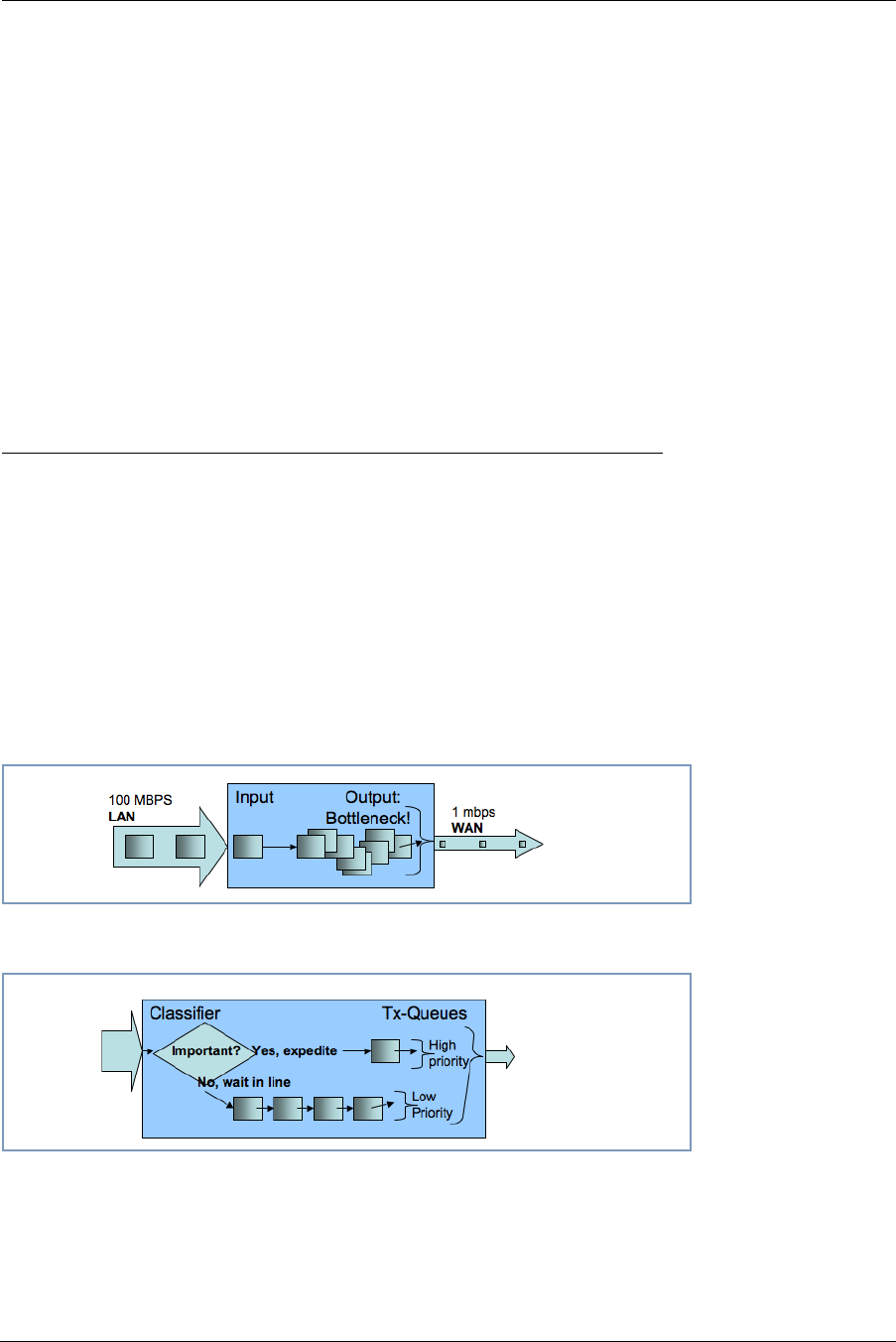
207
Appendix B Quality of Service (QoS) Examples
This section contains information about the Motorola Gateway QoS implementation.
Overview
When packets arrive on a high speed interface and are forwarded to a low speed interface, there is
contention for bandwidth. This is the use case for QoS: to make effective use of bandwidth.
The basic steps for Quality of Service are to match and identify packets as belonging to a class of traf-
fic, and to give each class of traffic a certain behavior such as priority queuing or bandwidth shaping
across critical networking bottlenecks.
Packets forwarded through the system are classified using sets of filter rules to match various criteria,
for example p-bit, DSCP, IP address, port, etc. The matching rule can set the classification, which is
the name of the queue that is to be used.
Figure 1. Illustration of upstream congestion, all traffic is consistently delayed.
Figure 2. Illustration of classification and transmit queue in a simple high/low priority scheme. Low priority may transmit
only when high priority is completely empty.
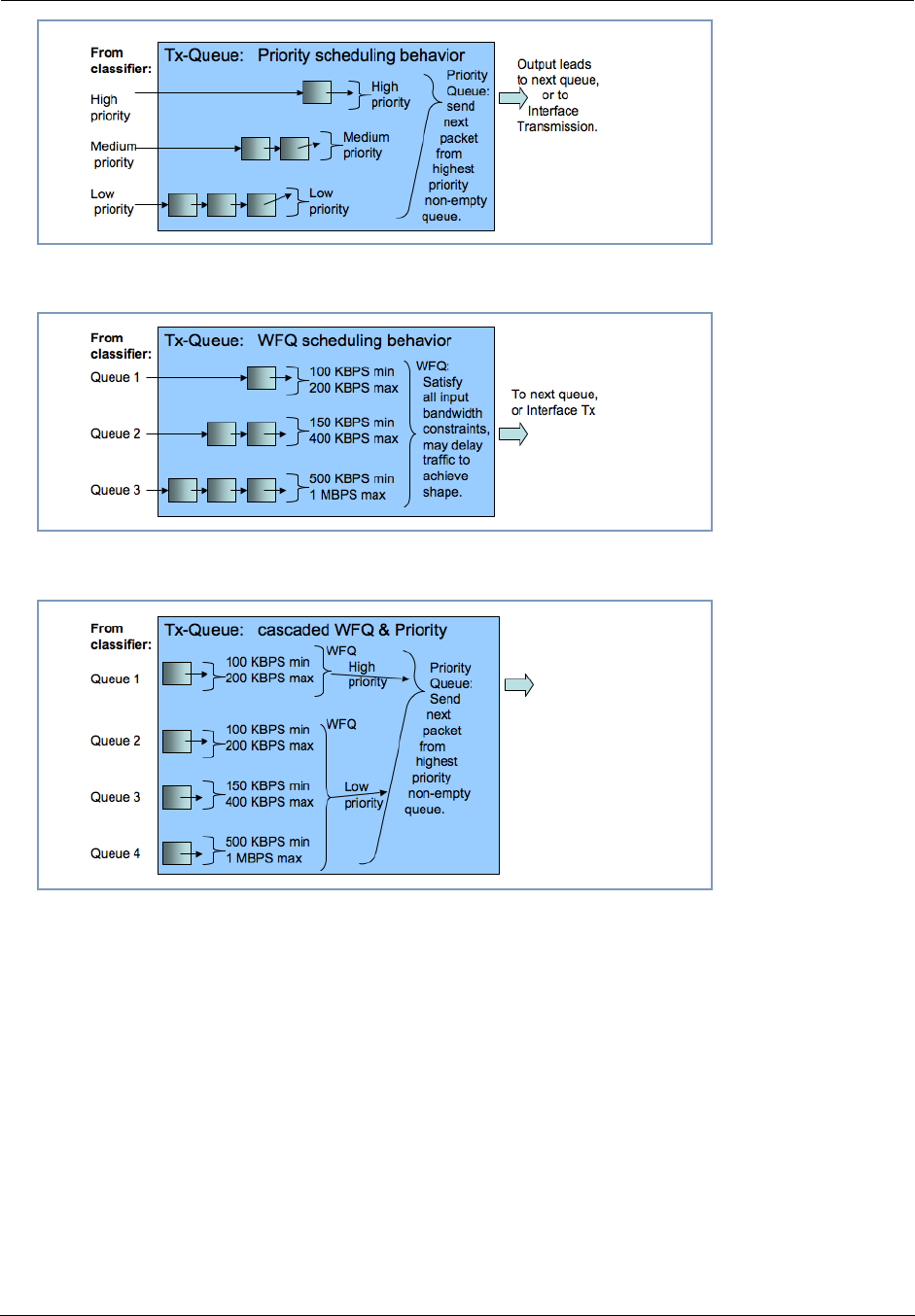
Administrator’s Handbook
208
Figure 3. Illustration of priority scheduling
Figure 4. Illustration of weighted fair queue scheduling
Figure 5. Illustration of a hybrid queue that is both priority and WFQ, to both constrain bandwidth usage and expedite
one of the queues.
After the packet has been classified, it can be put in the proper queue. Queues are assigned to inter-
faces and can be constructed of several queue components to deliver the desired behavior. The com-
ponents of an interface queue are these building blocks:
■ basic queues: a 1 input 1 output packet list with a length of 64 packets by default. Packets will tail-
drop when the enqueued to a full basic queue.
■ priority queue: 2 or more input, 1 output. Schedules the packets from the various inputs strictly
according to input's priority.
■ weighted fair queue: 1 or more input, 1 output. Schedules the packets according to bandwidth con-
straints
Packets are enqueued to basic queues, and only to basic queues. Basic queues are output to priority
queues and weighted fair queues, which act as “plumbing” elements that alter the dequeuing order
and rate, respectively. Priority queues and weighted fair queues can contain one another.
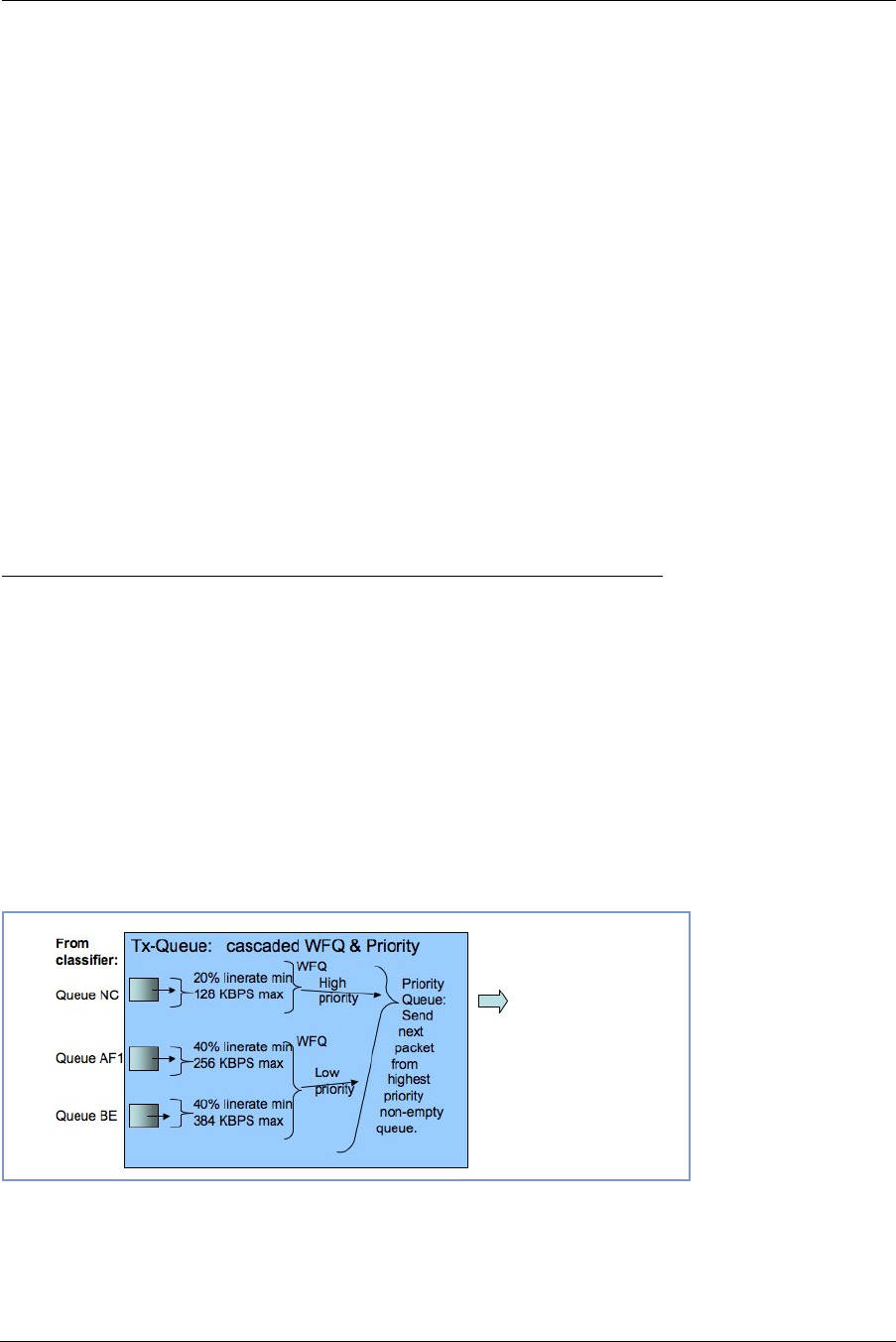
209
Weighted fair queues are used to constrain bandwidth. For example, consider a weighted fair queue
with three basic queues as inputs, EF, AF and BE:
WFQ
Input 1: EF
Input 2: AF
Input 3: BE
Each input entry is configured with a weight value, which is the rate at which to limit the traffic. This
weight can be either absolute (bps) or a relative percentage of the interface's data-rate. This allows
dedicating a split amount of bandwidth to each queue. A special value for the weight parameter is zero,
which will use the remainder of unclaimed bandwidth.
There is an option to enable bandwidth sharing, so that unused bandwidth in idle queues can be
shared to other queues. When the traffic resumes in the previously idle queue, the previously shared-
out bandwidth is taken back.
When bandwidth sharing is enabled, a secondary rate configuration appears on each input entry, the
peak parameter. This is a hard limit on the amount of bandwidth that the particular input entry can use.
This rate will not be exceeded, even if there is an excess pool of idle bandwidth that could otherwise
be shared.
Upstream QoS: Priority and shaping
The Gateway uses the DSL sync rate to determine traffic shaping requirements for WAN traffic. In this
case there are 6 basic queues, and a hierarchy of both priority queue and weighted fair queue with
bandwidth sharing and dual rate shaping. First the packets are classified via the filterset, to set the
QoS-marker with the name of the desired basic queues. The queues are shown here, with packets
traveling from left to right. Each basic queue feeds into a WFQ entry, and is shaped between the mini-
mum bandwidth defined by “weight”, and the maximum rate defined by “peak”. If there is sufficient
bandwidth, the WFQ entry shapes at the peak rate. If there is no spare bandwidth available for shar-
ing, then the queue is shaped at the “weight” rate. The weight” rate is defined either as a bps value, or
as a percentage of line-rate that is determined once the upstream WAN data-rate is acquired. This
“weight” value behaves as a Committed Information Rate (CIR), and the “peak” value behaves as a
Peak Information Rate (PIR.)
Figure 6. Illustration of default queues used for AT&T

Administrator’s Handbook
210
Packet Rx > Filterset Rules:
Match Rule 1? Set QoS marker = EF
Match Rule 2? Set QoS marker = AF1
Match Rule 3? Set QoS marker = BE
EF CIR/PIR -> wfq_hi -> PQ1 \
AF4 CIR/PIR \ > PQ output to interface Tx
AF3 CIR/PIR \ /
AF2 CIR/PIR > wfq_lo > PQ2 /
AF1 CIR/PIR /
BE CIR/PIR /
Downstream QoS: Ethernet Switch
The simplest way of handling downstream QoS (from WAN to LAN) is to use the per-port queues that
are present in the Ethernet switch. This achieves the greatest efficiency since the queues are handled
in the switch hardware, and should be used when a strict priority queue with 4 priorities is sufficient.
The traffic is classified by priority-bit value. This can be the value retained from WAN ingress (assum-
ing WAN is tagged,) or it can be a value that is set via a filter rule, which allows for advanced classifica-
tion criteria to be used. Even though the LAN interface might not be tagged, there is still an internal
priority field which is used to convey this information to the switch.
Downstream QoS: Egress queues
The secondary method of downstream QoS is to assign egress queues to the LAN port configuration.
This is less efficient, however it allows more advanced queue scheduling algorithms to be used. Pack-
ets are classified by QoS markers set by filter rules.
☛
This method is typically not recommended for deployment configuration as
this mechanism can consume a large amount of CPU processing band-
width.

211
Index
Symbols
!! command 108
A
Access Code 35
Address resolution table 113
Administrator password 107
Arguments, CLI 118
ARP
Command 109, 116
B
basic queues 208
Broadband Network Redirect 25
Broadband Status 37
Broadband Status Notification 87
C
Call Statistics 58
Captive Portal 203
CLI 103
!! command 108
Arguments 118
Command shortcuts 108
Command truncation 118
Configuration mode 118
Keywords 118
Navigating 118
Prompt 108, 118
Restart command 108
SHELL mode 108
View command 119
Command
ARP 109, 116
Ping 110
Telnet 116
Command line interface (see CLI)
CONFIG
Command List 106
Configuration mode 118
Connection commands 121
Custom Service 71
D
Default Server 77
designing a new filter set 64
Detect Missing Filter 81
Device Access Code 27
Device List 32
DHCP lease table 111
Diagnostic log 111, 114
Diagnostics 80
Documentation conventions 8
Downstream QoS 210
E
Ethernet statistics 111
Event Notifications 87
F
filter
parts 64
parts of 64
filter sets
disadvantages 63
using 65
filters
using 64, 65
firewall 114
Firewall Advanced 78
Firewall Status 62
H
Help 31
Home Network 41
HPNA 54
HPNA Configure 45
I
ICMP Echo 110
IGMP 139
IGMP Snooping 139
IGMP Stats 40
IP DNS commands 138
IP Gateway commands 130
IP IGMP commands 139
IP interfaces 114
IP Passthrough 75
IP routes 114
IPMap table 114

Administrator’s Handbook
212
K
Keywords, CLI 118
L
LAN Ethernet Statistics 43
LAN Host Discovery Table 114
LEDs 13
Link commands 143
links bar 32
Log 114
Logging in 107
Logs 83
M
MAC Filtering 50
Management commands 146
Memory 115
Missing Filter Notification 87
N
NAT Pinhole commands 157
NAT Table 88
NAT/Gaming 69
NSLookup 81
NTP commands 141
P
Packet Filters 63
Password
Administrator 107
User 107
Physical interfaces commands 150
Ping 81
Ping command 110
Port Warnings 68
PPP 117
priority queue 208
Prompt, CLI 108, 118
Q
QoS 207
Quality of Service 207
R
Redirect page 26, 149
Reset Connection 86
Reset Device 86
Reset IP 86
Resets 86
Restart 86, 111
Restart command 108
Restart Modem 36
S
Safety Instructions 12
Security
filters 63
Session Initiation Protocol 159
SHELL
Command Shortcuts 108
Commands 108
Prompt 108
SHELL level 118
SHELL mode 108
show config 112
Show ppp 117
SIP 159
Step mode 119
Subnets & DHCP 52
Supported Games and Software 73
System commands 167
System Information 34
T
tab bar 31
Telnet 107
Telnet command 116
Test Web Access 81
TFTP server 109
Traceroute 81
Trivial File Transfer Protocol 109
Troubleshoot 80
Truncation 118
U
Update 85
Upstream QoS 209
User name 107
User password 107
V
View command 119
view config 116
Voice 56
Voice-over-IP 159
VoIP 159
W
weighted fair queue 208

Administrator’s Handbook
214

215
Motorola® Mobility DSL Gateways
Motorola Mobility LLC
600 North U.S. Highway 45
Libertyville, Illinois 60048 USA
Telephone: +1 847 523 5000
July 13, 2012

Administrator’s Handbook
216

